Slave to the Game
Online Gaming Community
USSR NAVY
by Division of US Naval Intelligence, 1943
Part 1
Russian North Fleet Destroyer GORDY Class, circa 1942
EASTERN EUROPEAN DIVISION
DIVISION OF NAVAL INTELLIGENCE
30 NOVEMBER 1943
N.N.I. 96—1943
ISSUED BY THE INTELLIGENCE DIVISION
OFFICE OF CHIEF OF NAVAL OPERATIONS
NAVY DEPARTMENT
INTELLIGENCE REPORT
This serial contains all pertinent information concerning the Navy of the U.S.S.R available in the Division of Naval Intelligence. It covers the organization of the Soviet Navy, naval policy, personnel, tactics and operations, naval ordnance, an estimate of the strength and disposition of the various fleets and descriptions of the units which comprise them, descriptions of all known naval bases and yards, of the naval air force and of coast defense.
This serial supersedes OM-6-F-5 serials 41-42 and 45-42, all copies of which should be destroyed.
Information contained herein is necessarily incomplete and unconfirmed, as the Soviet Government hasxr^rely given detailed information concerning its Navy or permitted accrediteaTU.S. naval representatives to visit naval bases or units.
CHAPTER I. ORGANIZATION
A. Organization in General
On December 30, 1937, the People's Commissariat of the Navy was organized; prior to that time the Navy was a mere sub-section of the Red Army, forming a part of the Peopled Commissariat for Defense, together with the Red Army and Air Force.
The People's Commissariat of the Navy trains navy personnel, administers the naval fleet, and naval bases, and land establishments ! of the nation; it is responsible for the training and administration | of naval aviation, coast defense^ coast guard, and marine corps. The navy is responsible for all coastal and port defenses, including antiaircraft defense. It shares with the People's Commissariats of Munitions^ and of the Shipbuilding Industry the responsibility for the construction of warships and naval bases. It is responsible for the distribution of naval supplies, although the procurement and production of these supplies is under the People's Commissariat of Munitions, which function in these matters under local naval inspectors. Naval war plans are the responsibility of the Soviet Naval Staff.
Little is known of the present-day organization of the Soviet Navy. The chart oh the following page shows its organization as of 1 December, 1940; however, since the outbreak of the Russo-German War in June, 1941, many changes must necessarily have taken place.
The People's Commissar for the Navy, Admiral N.G.Kuznetsov, is the Supreme Commander of the Naval Forces of theTU.S.S.R. under the 1936 Constitution. He is aided by the Deputy People's Commissar, Admiral L. M. Galler, and by the Chief of the Naval Staff, Admiral I. S. Isakov. Under the Chief of the Naval Staff, come the Commanders-in-Chief of the 4 fleets; The Baltic Fleet, Admiral V. F. Tributs; The Black Sea Fleet, Vice Admiral Vladimirski; The Pacific Fleet, Admiral I. S. Yumashev; and The Northern Fleet, Vice Admiral A. A. Golovko, as well as the Commander of the Caspian Flotilla and of the flotillas of various inland waterways, notably the Amur and Volga Rivers. The actual command, however, lies in Joseph Stalin, absolute dictator and supreme commander of all Soviet military forces.
Prior to the outbreak of the Kusso-German War, Soviet naval policy was dictated by the Politburo; decisions of this bureau were put into effect by the Supreme Naval Council. This council probably is no longer in existence, but it formerly consisted of 11 members. It decided on questions regarding the disposition of the fleets, naval construction, naval aviation,, coast defense, coast guard, marine corps, and naval policies. Its membership included M. Zhdanov, Communist Party executive of Leningrad, the Commissar of the Navy, 4 Vice-Commissars, of whom 2 were political appointees, the Chief of the Naval Staff, and the 4 Chiefs of Naval Administration, i.e., armament, supplies, aviation, political. There was a subsidiary naval council attached to each fleet; they controlled all fleet activities within the district. In general, these subsidiary councils were composed of the 2 highest ranking naval political officers and the party secretary or executive of the district.
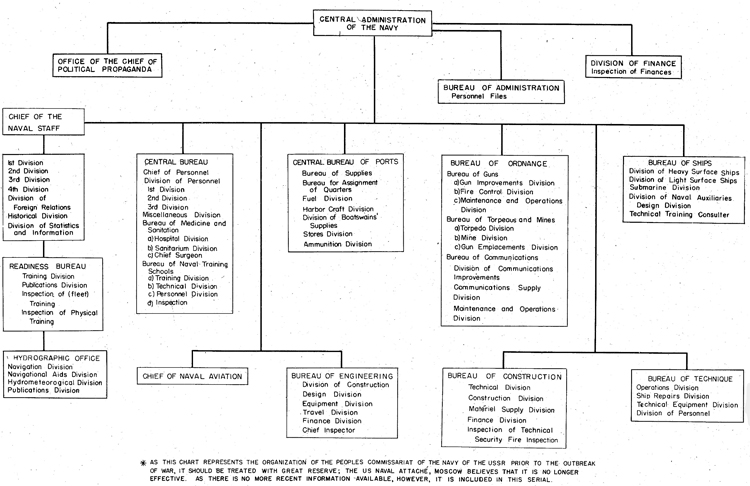
CHART OF THE ORGANIZATION OF THE NAVY COMMISSARIAT OF THE U.S.S.R. AS OF I JANUARY 1940
B. Political Intervention
At the end of the Russian Civil War in 1922, the Soviet Government found that the outstanding majority of its naval officers had bee:i inherited from the Imperial Regime, All officers who did not immediately fall in line with the new government were, of course, ettier exiled or executed. There were, however, a fairly large number of naval officers who were retained; they formed the nucleus for ihe young Soviet Navy, On the other hand, the party officials in . $bssow were not entirely certain of the political feelings of these menl and therefore set up what is now known as the "Politico" system. Under this system, each officer having command, whether of an entire fleet or a motor torpedo boat, was assigned at least one political officer, a member of the Communist Party, who looked after the political education of the men under his command, as well as making certain that the commanding officer .would commit no act which would hurt the Soviet Government. As time went on, these "Politicos" assumed more and more power, so that at the time of the Russo-Finnish Wax, no decision, either of political or operational importance, could fe made by the commanding officer without the approval of his senior politico5 in fact, the political officer was equal in rank to the commander, if not superior to him. In September, 1941, there were no less than 9 political officers assigned to the 8,000-ton heavy cruiser VOROSHILOV. This system, which existed for the sole purpose of compelling officers to adhere to the rules set down by the Cppmmunist Party, made for great inefficiency at sea.
i In order to meet, in part, the shortage of officers produced by heavy casualties and expansion, and to promote efficiency, discipline, and comradely cooperation among officers, the commissar system was, ostsnsibly, at least, abolished, both in the army and navy in 1943. Political commissars, formerly constituting as high as 1/5 of officer personnel, have been enrolled as regular naval officers, in which capacity they will, no doubt, continue to exert strong party influence upon military personnel, although without the power to countersign the orders of the commander.
CHAPTER II. SOVIET NAVAL POLICY AND POST WAR CONSTRUCTION
A. Basic Policy
The geographic position of the USSR compels a naval policy which is necessarily different from those of other nations. Instead of having one principal fleet which can be shifted from place to place as necessity dictates, the USSR must have five separate fleets i.e. Baltic, Black Sea, Pacific, Northern, and Caspian.
The Soviet authorities have done what they could to combine these fleets as much as possible. In the late thirties, the Stalin Canal was completed-connecting, to a certain degree, the Baltic and Northern Fleets. Unfortunately, however, this canal is not sufficiently large to permit the passage of capital ships, or even of cruisers, but 3,000 ton destroyers and under could be shifted between the Baltic Sea and the Arctic Ocean with comparative ease, prior to the outbreak of the Russo-German War.
Because of the opening of the Northern Sea Route, naval units, for the short period of two or three months a year, can be transferred from the Pacific Fleet to the Arctic and Baltic Fleets and visa versa; this is not entirely satisfactory, however, and exposes ships to the perils of ice and bad weather, as well as taking a minimum of 1-1/2 -2 months.
Many attempts have been made to connect the Black Sea with the Caspian Sea. Prior to the outbreak of the war, construction on a canal between the Volga and Don Rivers was underway, but this would not have been of much naval value because of the shoals in the area of the mouth of the Volga. Even with constant dredging of a 25-mile strip, the depth of the river at this point is only 10 feet.
The possibility of digging out the dried-up Manych Canal, which crosses the Caucasus Peninsula, and allowing the water of the Sea of Azov to flow into it has been considered. The drawback of this plan is due to the fact that water in the Black Sea below a depth of 200 meters contains poisonous gases which would ruin the fisheries, first in the Sea of Azov, and later in the northern Caspian Sea.
Naturally, there is absolutely no possibility of connecting the Black and Caspian Seas with the Baltic—Arctic—Pacific group.
The necessity of maintaining strong fleets in each of her seas was amply illustrated during the Russo-Japanese War of 1904-05, when it was seen that by the time the Imperial Fleet (Baltic) reached the Far East, it was of limited operational value, due to insufficient logistic support.
Consequently, in 1907 the first large-scale building program started. It was followed by the Naval Law of 1912, which provided for the following strength of the Baltic Fleet by 1930: (No information is at hand on programs for the other fleets, but it is presumed that they were to be of similar magnitude) 24 battleships, 12 battle cruisers, 24-light cruisers, 108 destroyers, 36 submarines.
At the outbreak of the World War in 1914, this program was well on its way. Seven dreadnought battleships were commissioned by
1917 and one more was still building; four battle cruisers were still building, eight pre-dreadnought battleships were in commission in addition to four obsolete battleships. Six armored cruisers and eight protected cruisers ?rere built by 1914, and ten light cruisers were still under construction in 1917; also, two-pre-dreadnought battleships and one protected cruiser were returned to Russia by Japan after the war was well under way. In 1914, the Imperial Fleet also consisted of about 120 destroyers and 20 more building as well as about 40 submarines and 30 more building.
Due to the World War, the Russian Civil War, Allied intervention and post-war scrapping, the Russian Fleet in 1922 consisted of four dreadnoughts, one of which was never restored, one armored cruiser, which disappeared about 1925-26, and eight uncompleted light cruisers only 3 or 4 of which were eventually commissioned (1927-1930), as well as about twenty destroyers and twenty submarines.
During the reorganization of the Hussion Navy by the Bolsheviks, two schools of thought existed regarding the strategical basis upon which changes should be made. A large number of former Czarist naval officers then still serving, supported the theory of "command of the seas", basing their ideas of new construction and-technical evolution of the future development of a powerful Soviet riavy on the lines of the western capitalist powers.
A second school of thought, headed by Trotsky, claimed that the naval theories of imperial days were wrong and bore no relation to Russia's geographic and economic conditions, and that a "defensive fleet" only should be built. This was brought about by an attempt to give a reason for the realization that the Russian shipyards were in such a state that not even the smallest building program, much less the construction of a battle fleet, could be launched for many years to come.
In formulating this policy, there was no profound naval thinking involved as the fundamental reason for the existence of a navy, to gain or dispute command-of the sea, was completely disregarded. No "defensive navy" ever has or ever, will fulfill this function. Therefore, it became apparent at the very offset that this policy was dictated by political expedi icy coupled with economic necessity* and that it would be discarded as soon as the reconstruction of industry pelmitted.
Consequently, prior to 1937 the USSR concentrated on the building of submarines and small surface craft. Submarines are used extensively for patrol and home defense purposes by the Russians and are not considered as purely offensive weapons. In 1937, the only new units which had been added to the Soviet Fleet since the World War were: 1 2900-ton destroyer leader, about 30 torpedo boats 600-800 tons each, and 60 or 70 submarines.
B. Reversal of Soviet Naval Policy (1936 to 1939)
The first indication of a change in naval policy came during the latter part of 1936 when Fleet Flagman of the First Rank (Admiral of the Fleet) Orloff, Chief of the Naval Forces, announced "a new building program which would include ships of all classes and of the most up-to-date design.1! The Third Five-Year .Plan, which began in 1937,provided for a large increase in the size of the navy.
It is hard to say whether this change of policy was brought about by careful thinking and a conviction of the necessity for employing it, or whether it was the result of a desire for achievement on the part of the Dictatorship of the Proletariat and demonstration bo the world that the U.S.S.R. can produce a fleet equal if not superior to that of a first-class naval power.
Probably Admiral Orloff was too slow to see the change in the minds of the ruling clique; in addition, Soviet shipbuilding yards were not equipped to meet any such increase in the demands made upon them. Therefore, in 1937,the purge of the Navy took place. It was the most far-reaching purge ever instituted, and when it was over, every high-ranking officer with the exception of Admiral Galler had been "liquidated". This included three Supreme Commanders of the Naval forces, the Commanders-in-Chief of three fleets and their chiefs of staff, the commanding officer of the flagship "Marat", the superintendent of the Naval Academy, and many others. The photograph shows the Naval High Command of 1936: all of these men with the exception of Admiral Galler were eventually executed or disappeared. This purge probably, because of its far-reaching results, and because it followed so closely on the heels of the purge of the Red Army, was not officially announced until August, 1938.

Left to right: (sitting) Fleet Flagman of the first rank (Admiral of the Fleet) M.V. Victorov; Fleet Flagman of the first rank (Admiral of the Fleet) V. M. Orlov, Chief of the Naval Forces of the Workers' and Peasants' Red Army; Fleet Flagman of the first rank (Admiral of the Fleet) I. K. Kozhanov; (standing). Fleet Flagman of the second rank (Admiral) K. I. Dushenov; Fleet Flagman of the second rank (Admiral) L. M. Galler
The first steps taken to build up the Soviet Navy were to reconstruct existing shipbuilding yards and to build new ones. Progress along these lines were found to be far from satisfactory, and so in July, 193&, M. I. Kalinin, President of .the U.S.S.R., made a speech at the Ordzhonikidze Shipbuilding Yard at Leningrad, and blamed this state of affairs not only on "the work of traitors" but also on the inefficiency of the workers themselves.
In order to give high-ranking naval officers more freedom of action, the first Commissariat of the Navy was organized in December, 1937; prior to that time, the navy was administered as a part of the Commissariat of Defense, along with the army and air forces.
In an attempt to help along this building program, Vice Admiral Isakoff, Vice Commissar of the Navyj was sent to the United States in January, 1939, as chief of a naval mission for the purpose of placing an order for the construction of one or two capital ships in this country: due to various reasons, this mission failed.
In March, 1939, at the XVIII Communist Party Congress, three new men appeared, who have since played a large role in the formation of naval policy: the first of these was Rear Admiral N. G. Kuznetsoff, then Commander-in-chief of the Pacific Fleet, who shortly afterward became People's Commissar of the Navy at the age of 37, which position he still holds to the present day. The second was P. Tevosyan, Peopled Commissar of the Shipbuilding Industry, and third was Captain I. D. Papanin, Chief of the Northern Sea Route Administration. The first two stated that the building program according to the dictates of the third Five-Year Plan was well on its way and would be met, if not exceeded. Captain Papanin declared that because of the success attained in opening the Northern Sea Route and because of the Stalin Canal, the,Baltic, Northern, and Pacific Fleets could now be considered as one.
Because of the outbreak of the war in June, 1941 ship construction did not follow according to plan; however, at the time of the German attack, there were either built or building: 2 or 3 44,000-ton battleships building, 5 8,000-ton cruisers built, and 5 more building, as well as a lrage number of smaller craft.
C. Post War Construction
(I) Submarines. The first submarines built were those of the "D" (Dekabrist) Class; the first of these were commissioned in 1927. They have an overall length of about 240 feet and a beam of 24 feet. Their normal surface displacement is 920 tons, submerged 1150 tons. They were designed to have a surface full speed of 15 knots and submerged speed of 8 knots. They have 6-21" torpedo tubes forward and 2 aft and carry a total of only 10 torpedoes.
These were not a very popular type of submarine, so they gave way to the "Ln (Linenaya Lodka) class. These are similar to the "D" class except that they are slightly larger (1300 tons normal surface displacement, 1500 submerged 266 feet long overall) and that they were fitted for minelaying, carrying 20 contact moored mines. Their torpedo tubes were placed similar to those of the "D" class, but they carried twice as many torpedoes. As these two types of submarines were not considered to be entirely satisfactory, construction on them was stopped on the "D" class in 1934 and on the "L" class in 1937.
In 1934, the first 'SCHCH" (SCHCHUKA) class submarine was completed. It turned out to be highly satisfactory as a type of medium-sized boat and was still, at the outbreak of the war in June, 1941, being constructed with but few variations; it is possible that boats of this type are still being built. They have a normal surface displacement of 660 tons, submerged 820 tons, and an overall length of 200-225 feet; they have a full surface speed of 14 knots and are designed to have a full submerged speed of 8 1/2 knots; on the surface, they have a cruising radius of 5000 miles at 10 knots and submerged an 80-mile cruising radius at 5 knots. They have a total of
6 torpedo tubes, 4 forward and 2 aft, and carry a total of 10 torpedoes. It has been reported that some of these boats are fitted for
minelaying, but there is no confirmation of this fact. The main difficulty appears to be that only 2 of the forward torpedo tubes can be fired simultaneously; perhaps this has been altered on newer models. These boats are generally popular, are easy to handle even in a rough sea, but are apt to be a "little lively" on the surface.
Obviously seeing the need for a smaller type of submarine, which, could patrol the Russian coasts near the shore, construction " was started on the "M" (Malutka) class at about the same time that the "Schch" class were being built; the first of these boats were commissioned in 1935. They have a standard surface displacement of 185-204 tons and a submerged displacement of up to 256 tons; they are about 140 feet long and have a beam of 10-11 feet. They have 2 18" or 21" torpedo tubes and carry 2 torpedoes. These boats present a rather strange silhouette, with a disproportionately large conning tower taking up about l/5 of the entire visible length of the hull.
During this period, the Russians v/ere also constructing larger submarines. In 1935, the first "P" (PRAVDA) class boat was completed; these boats, because of their being not entirely satisfactory, were replaced by the "K" (improved Pravda) class in 1938. Little is known about these classes, but from their external appearances, their design shows Italian influence. It is believed that: they have a standard surface displacement of 1500 tons, submerged 1800 tons; they are about 280 feet long and have a beam of about 22 feet. They have a full surface speed of 18 knots and have a cruising radiiats of 7000 miles at 9 knots; submerged they have a full speed of 8-1/2 knots and a cruising radius of 125 miles at 5 knots. They have a total of 8 torpedo tubes, but the number of torpedoes carried is not known; they may be fitted for minelaying. These are the largest submarines yet designed and constructed under the Soviet Regime. The chief difference between the "P" and "K" classes appears to be in the shape of the conning tower; there are possibly other variations in dimensions and armament. The tonnage of the "K" class may be slightly more than that of the "P" class. They are said to be qxiite successful boats, capable of rapid diving.
The latest type of submarine to be constructed under the Soviet Regime is the "S" x(Stalinets) class; they may have, been intended to take the place of the "D" class. They have a normal surface displacement of 750 tons, submerged' 1000 tons. They have a full surface speed of 22 knots, and have a cruising radius of 9000 miles at 11-1/2 knots; submerged they have a maximum radius of 108 miles at 9 knots. They have U torpedo tubes forward and 2 aft and carry a total of 12 torpedoes; these boats are not equipped for minelaying. They have simple, easily understood operational characteristics and are fully capable of keeping the sea and are well fitted out. The bridge and conning tower are very small and the decks very free from obstruction; the overall silhouette is considered excellent.
(II) Surface Craft. The first construction on -surface craft of any Importance undertaken by the U..S.S.R. was on the, SHTORM class torpedo boats; the first of these craft was completed in 1932. They have a normal displacement of 800 tons and an overall length of 251 feet; their, beam is 2J+ feet. They have a designed full speed of 25 knots, and had a mean speed on trials of 21 knots. They carry 2 J+u guns and 3 3" high altitude guns with a maximum range of 27,900 yards; they have 3 18B broadside torpedo tubes in a single turret. They carry 50 mines and 4 D.C.T. These boats are excessively armed for their size; they are reported as being poorly constructed and roll heavily, owing to excessive top hampers.
The Leningrad class destroyer leader represents the first
attempt of the U.S.S.R. in larger ship construction; the first unit
of this class was completed in 1935• They had a standard displace
ment of 2900 tons, a length of 400 feet, and their beam was 38 1/2
feet. They have 5 5.1 inch-guns and 2 3 inch anti-aircraft guns and
2 1.4-6 anti-aircraft guns. Their construction is said to have been
supervised and influenced by French technical experts and are quite
unsatisfactory; they are reported to be poor seaboats, very wet for
ward. Despite this fact, however, additional units are still probably being built.
In 1936 an order was placed by the U.S.S.R. at the Odero-Terni-Orlando Yards, in Leghorn (Italy) fora destroyer leader. All subsequent types of Soviet destroyers reflect this design. The first destroyers built by the U.S.S.R. were the Gordi Glass, which were first laid down in 1937. They have a standard displacement of 1600 tons, a length of 375 feet, and a beam of 33 l/2 feet. Their armament is similar to that placed on the Leningrad Class. More recently, probably not before 1938, an improved type of these destroyers was laid down. They are slightly larger, and have a standard displacement of about 1800 tons. Their main difference in silhouette is that they have two separate raking, squat, flat-sided stacks instead of one. They are indicative of the latest turn in Soviet destroyer construction.
In 1935, construction was first begun on cruisers, namely,
the KIROV class... 5 units of this class have already been completed
and constructionon 5 more was started before the outbreak of the
war, but it is doubtful whether any progress can be made on them at
the present time. These ships have a standard displacement of about
8,000 tons and a length of 613 l/2 f eet. : Their beam is 58 feet.
They have 9 7.1 inch guns in triple turrets, 6 3*9 inch guns and 4
1.4.6 inch anti-aircraft guns. They normally carry 3 aircraft which
are launched by: means of a catapult. Depth charges; are released by
means of 2 depth charge rails.. They have a designed full speed of
34- knots. The design and technical advisor of the construction of
these, units is said to have been furnished by ANSALDO. They are
lightly built, but well laid out.
Although considering the possibility, no action was taken on the possible construction of battleships until/fairly recently. After the ORLOV theory had more or less been accepted, plans were laid for the construction of large units. To this end in 1937 one battleship (and perhaps a second) was laid down at Leningrad, and in 1938 another one at Nikolaev. These units were to have a displacement of 44,190 tons, to be 794V, overall length, 119! in beam, and to have a mean draft of 29f10"5 they were to carry 9 16" guns, 12 5.9" guns and 12 3.9" guns. By the time that the Germans captured Nikolaev the battleship under construction there was about 40% completed. Since the outbreak of the war, further construction at Leningrad has been impossible.
Chapter III.
PERSONNEL
A. Efficiency
The general efficiency of the Soviet naval forces is rather below that of the navies of the western capitalist powers.
As a result of the "purge", the Navy suffers from a surfeit of youth and inexperience. The average age of Commanders-in-Chief of Fleets is 40), while commanding officers of the larger units are rarely more than 35, destroyers in many cases being commanded by lieutenants of only three or four years seniority. The officers, on the whole, are a poor lot; they are drawn from all grades of society and enter the Naval Schools with an indifferent education. They appear, however, to learn much by experience when they are afloat.
Ratings are generally extremely well set up, well-disciplined and exceptionally tough. Petty Officers exert considerable authority, and are given every ehcciaragement to improve their education.
Although the personal appearance of Red sailors is far below
the standard of other western navies, it is much cleaner and neater than
that of the soldiers of the Red Army.
Individual ship efficiency is generally good. Vessels are always well kept and, considering the inexperience of the officers, quite well handled1 Organization and staff work are generally on a very low level. Little is known of Fleet and Squadron efficiency, but it is probably very backward. Reports indicate that this is particularly" so with destroyer flotilla work, and submarine attacks on battle fleets. The whole Navy is maintained on a full commission basis, much sea iime is put in and everyone is kept'hard at work, often on useless tasks; The strain on the whole organization is very great, dockyards fail [to carry out refitting programs, and individual ships very often do not
complete their own annual practices. Tims, although there are a large number of unit s fully commissioned, it is unlikely that such a large proportion is suitable for active service as in case of other European Powers.
The submarine service, on the other hand, is not only strong numerically, but, in quality, has attained a fairly high standard. It is considered as the "Corps d'elite" of the Soviet Navy. Although, as stated above, it is unlikely that flotilla work is particularly efficient, there is no question that submarines individually are efficiently handled.
"To sum up, given good organization and experienced leaders, much could be made of the Soviet Navy, and a considerable improvement may be expected now that political control has once more been relegated to the background.
B . Psychology and Beliefs
The present Russians, especially those in positions of authority, are above all, Soviet Russians. This connotes that they are products of the Revolution. The extreme youth of Soviet naval officers means that they have all grown to manhood since the Revolution. None of them have any more than the faintest recollection of conditions under the Tsarist regime. Therefore, they attribute all the advancement and the technical development of their country to Soviet rule. It should be borne in mind that, while they have never experienced the food, the luxuries, and the broad education of western countries, they hardly know this because they have no past experience on which to compare their present standard of living. Among sailors, there is the stolidity of character that is attributable to peasant birth. Among the. officers who have seen western navies with all their technical developments and the civilization behind those developments, it is evident a kind of an inferiority complex has arisen from the feeling that perhaps their things are not as good as those of the outside world. This has resulted in a fundamental feeling of suspicion, which the Russians have toward foreigners. It is perhaps explicable by the fact that the Soviet Russians have to have something to cover up for this kind of inferiority feeling. Consequently, foreigners are very much distrusted by the Soviet Russians, because Soviet Russians have been taught that outside nations are all imperialist powers which have no real sympathy for the Soviet Union. This teaching adds fuel to the fire of suspicion which the Russians have towards foreigners.
It should be kept in mind that the rapid development of the Soviet Union to its present economic and political form was accompanied by drastic methods. Soviet citizens are supposed not at any time nor in any circumstance to forget the rigid rules for which punishment is severe and far reaching. A rule is in effect prohibiting the acceptance of foreign decorations by Soviet citizens in general, but it has been released on occasions as the recent rewarding of U. S. Navy Crosses and Distinguished Service Medals to outstanding officers and men of the Soviet Navy. It is obvious that the Soviet Russians will be reserved in what they say or do. It is a mistake to persuade them to weaken from their position, much as we are not in agreement with it, or to draw them into conversation on subjects which they are endeavoring to avoid. Political and religious matters should be avoided in discussion. In fact, the Soviet Russian is more likely to listen than to speak; he has a thirst for knowledge of his profession.
It should be kept in mind that in the early days of the Soviet Unionit was deemed essential by the Bolsheviks to secure the political safety of the state. Men were chosen for positions of responsibility pn the basis of their adherence to the official political program rather
than for their particular training or capabilities. The curriculum of
all educational establishments was drastically curtailed by the Bolsheviks and only subjects pertaining to the professions were included in such abbreviated courses as there existed. The lack of training as distinguished from education in the case of many was feverishly made good in order that these people could be used in building up the industry of the Soviet Union and preserve its existence from what the Soviets regarded as the hostile reactionary world.
As a result of this pattern^ the Soviet citizen is lacking in general knowledge and conscious understanding of the finer subjects, and gives the impression that he is coarse and not intellectual. This impression is one which all American and British pfficers experience in their contacts with Soviet officers. The fact that the average Soviet < naval officer does not present himself as possessing outward refinement, or what we associate with being educated in the ways of theworld, does not mean that the Soviet officer lacks interest in the finer things of life. Nevertheless, the material side of life inthe U.S.S*R. takes precedence and is reflected in the appearance and conduct of the Soviet Russian of today. Russian naval personnel are specialists in tlie "technical type", that is, their training resembles more a technical rather than an educational course. This is particularly evident in the curriculum of the Soviet Naval Academy, which emphasizes very practical subjects and offers no "cultural" courses, as distinguished from the curriculum of the U. S. Naval Academy which has both practical and cultural subjects in its curriculum.
There have been a few cases where U. S. naval officers have actually been on Soviet men of war for periods of several weeks as liaison officers. These U. S. naval officers have reported their observations of the problems of joint operations. The Soviet Russian seems to have a one-track mind which is slow to act and its coordination is delayed. This is explainable by the fact that he has learned only one mechanical or technical routine.
First hand experience with Soviet Russian naval officers by U. S. naval officers has shown that the Soviet Russians in general are heavy-handed and ^nept to tools. They have two speeds, "full speed and stop". Their generalized mechanical sense is much inferior to that of U. S. personnel. They are not deliberately careless about cleaning, oiling, painting, and protecting from corrosion, for example,the many precision instruments on board a modern warship. They simply do not know any better.
In general, their operations seem to be "hit or miss" affairs. They like very much to make elaborate prearranged plans which they never follow. This is due perhaps to the fact that the Bolshevik indoctrination is filled with making plans for the future. Their literature, in almost every field of knowledge, emphasizes plans.
It should be pointed out, however, that in spite of the many weaknesses and inefficiencies of the Soviet Navy in its operations, it should be kept in mind that the £igM3£gspirit of the officers has been found to be strong. Althouglrthere Ts'good discipline and morale prevailing among both officers and men, extreme measures are sometimes taken to Insure the execution of orders at critical times. It is possible that this happens more in the Army than in the Navy. It has been rumored that, in order to guarantee the holding of the front when demanded by the tactical situation, N.K.V.D. troops have been stationed at the rear. While the Commissar system has been abolished in the Navy as well as the Army, naval personnel are constantly aware of the "secret police" which is every alert to report on their actions.
Even in spite of this, the propaganda system has been very successful in indoctrinating ideas of patriotism and invincibility in the minds of military and naval personnel. It is becoming more apparent that the fighting personnel is so imbued with these beliefs, that they go into the most daring operations with almost a spirit of recklessness.
C. Morale. Discipline. Customs and Practises
One of the most striking features of the Soviet military organizationtoday is the current revival of old imperialistic traditions. In 1940, special Bolshevistic designations of rank were abolished, and ranks were made to conform with those of other navies; the main changes were in the designations of flag rank. Also, the titles of Engineer Lieutenant through Engineer Admirals as existed in the Imperial Nay^werereihtroduced. Military titles of Major General and Coionei General of Coast Defense were also introduced. The dirk for all bfficers other than commissars was reintroduced in 1940 and at the same time full dress uniforms similar to those of preRevolu-tionary days were authorized for Soviet flag officers.
In 1942, an old naval custom was resurrected by restoring , to the Navy the honor of naming "Ships of the Guards"; "Guards Regiments11 were recreated in the Army. Perhaps one of the most coveted marks of honor is the Guards badge, which is worn by all officers and men who belong to a Guards ship or regiment. This badge is in the form of a small silver clasp, in which is threaded the black and yellow ribbon of the former Imperial Order of St. George. The wearing of these Imperial colors for valor is, no doubt, especially appreciated, since in generations gone by, black and yellow ribbons were to be seen on the sword hilts of officers who have been decorated for valor in the
field.
On the whole, officer and enlisted personnel are fairly smartly turned out. In the early part of 1943, Army and Navy officers were authorized to wear, as insignia of their rank, shoulder marks strikingly similar to those worn under the Tsarist regime. Great fanfare was made by the press over the revival of epaulets and the improvement in discipline expected through this change. In this connection, the omission of the N.K.V.D. troops in the restoration of epaulets is perhaps significant of a desire to minimize their importance in the eyes of the Soviet public and of other nations. At the time, "Red Star", official Army newspaper sounded the aew note in military discipline: "The introduction of epauletes must help to improve discipline in the army. Neatness and cleanliness in clothing, discipline and politeness must become the everyday qualities of a Red Army man. Everything in the Red Army man must show the culture of the Red Army, the strength of their traditions. After the changeover to epauletes a man in military service is not allowed to appear in public places, theaters, movies, etc., in a wrinkled and dirty uniform, in felt boots, or unshaven. Excluding railway stations, army men are not allowed to carry anything but a small neatly wrapped package in the left hand. They are not allowed to appear in uniform in markets or bazaars, forbidden to stand on the steps of a tramcar or bus. In cars of city transport, a Red Army man is not allowed to sit down in the presence of a senior. Not only in the rear areas, but also at the front, the wearing of shoulder marks must improve the looks,? and the behavior of men in the army. Every man at the front must understand that his duty is to achieve, as much as possible, a clean and decent appearance even under war conditions."
On August 10, 1943, the Presidium of the Supreme Soviet of the U.S.S.R. issued an edict reestablishing an officers1 corps in the Russian Navy; at the same time, ratings were divided into two classes— enlisted men and petty officers. The same thing had been done for the Red Army less than a month before, so its coming was not entirely unexpected. Naval officers were divided into three classes: junior officers (junior lieutenant through captain lieutenant), senior officers (captains 3rd, 2nd, and 1st ranks), and high officers (Rear Admiral, Vice Admiral, Admiral, and Admiral of the Fleet). Of special interest in this decree is the fact that a class of flag officers, equal to that of general officers, was not established, although it would have been comparatively easy to have done so. Prior to the Russian Revolution, the social position of generals was always regarded higher than that of Admirals, and it appears as if this distinction has been continued under the Soviet regime.
Soviet Admirals are allowed a young officer on their-staffs, known as "the Adjutant", who combines the duty of secretary and Flag Lieutenant. At the present time, these personal adjutants are not distinguishable as being part of the personal staff of Admirals, since they do not wear anything resembling aiguillettes, but, no doubt, the white corded aiguillette of Tsarist days will be restored to them before the war ends.
On August 11, 1943, the day following the establishment of the Naval Officers Corps, an article appeared in "Red Fleet" official organ "of the Soviet Navy stating in part ",...... ..This act has a profound meaning and significance. The designation officer raises still higher the authority and dignity of our military leaders. It is a proof of their military maturity and ability. It emphasizes their membership in their glorious and honorable class of military professionals. ..."
Pre-Revolutionary concepts of discipline have gradually been re-established in the Soviet Navy. Rank and prerogative of rank are jealously upheld. At the Baku Naval Academy, for instance, discipline in all ranks and ratings was observed to be considerably less free and informal than in the U. S. Navy. There was no fraternization or social contact between officers and men, A general snap, dash, and accuijaey were noticed, rarely found in Soviet civilian officials and in the| general run of the Soviet population. All persons encountered sought free criticism of their methods and were eager for comparison of their system with the American.
Although rank is perhaps excessively worshipped in the Soviet
system, cases often occur in which an officer senior in rank may have
as his commanding officer one who is junior to him - a paradox ex-;
plained by the fact that innumerable officers were rushed through Naval
School and commissioned directly with the rank of G ommander and Lieutenant Commander, although poorly qualified to command a vessel. At
the same time, ex-enlisted men and Merchant Marine officers were given
berths as commanding officers of ships because of their superior experience but compelled to remain in a junior rank under the regulations
requiring three years' service in each rank. Others of high rank whose
experience has not fitted them for command are former political commissars.
Very few officers seem to have been promoted from the lower
deck. It is estimated that the proportion of officers who have risen
from the enlisted personnel is not more than five percent.
The high standards of appearance officially ordered are not always adhered to. Aboard a Soviet submarine in November, 1942, the officers and men were not neat in their persons or in their dress, the former often appearing at mess unshaven and with dirty hands. The messman wore a very dirty white jacket, although some discipline was indicated by his demeanor and by the manner in which seamen asked permission to pass officers when in close quarters. Uniforms were of poor quality and ill-fitting. The generally untidy condition of the vessel indicated either an unwillingness to order work done or a reluctance to detail men to do anything in addition to serving the vessel.
The commanding officer of one submarine took great pride in the smart appearance of his ship and crew, especially when they were about to reach port, but by way of contrast took no steps to exterminate the rats which infested his ship. Engines and all working parts, however, were kept spotlessly clean and in perfect condition.
Naval personnel on duty in the U. S. practiced extended drills, to briskly shouted commands. At meals, an officer junior in rank asked permission from the senior officer present before leaving the table* The old Tsarist custom of enlisted men shouting out greetings in unison,while in formation,persisted. Although a junior officer might address a senior officer as "Tovarish Gapitan" (Comrade Captain) he stood at faultless attention, and, when dismissed, saluted with a smart about-face, and marched out. The same behavior held between an enlisted man and officer except that officers are evidently not addressed by enlisted personnel as "Comrade Lieutenant?
Medical officers aboard ship are charged with responsibility for the menu and are expected to satisfy themselves that all food is of good quality, as well as to allocate food properly. The latter duty is not always handled with competence, as preferred foods are sometimes quickly exhausted and a meager, monotonous diet then extended for long periods. A low opinion of Soviet naval medical service has been heard expressed by other officers
D. Pay and Allowances
Officers in the Soviet Navy are paid according to the position which they occupy and not according to rank. Every commanding officer of a submarine, whatever his rank, receives 2,350 roubles a month(purchasing power about $188). The divisional mechanic or flotilla engineer gets the same pay. The assistant commanding officer and the chief mechanic receive 1,900 roubles each month, the navigator 1,600 roubles, and the junior mechanic 1,200 roubles.
The commanding officer of.the heavy cruiser Voroshilcav receives 2,000 roubles a month. A man during his first year of compulsory military service receives only 57 roubles a month (purchasing power of about $4.56) and 250 roubles a month on completion of five year term. The free supply of clothing and cigarettes is quite adequate. No marriage allowance is paid, but upon a rating's death, a pension is paid to all children under 18 years of age and to their mother. This pension ceases as soon as the children reach an age at which they can earn their own living.
As is to be expected, all branches of the Soviet af|aed forces enjoy more liberal rations than any other section of the population, but still greatly inferior to those allowed our own services. Every attempt, however, is made to avoid envious comparison on the part of Soviet personnel.
E. Strength
The numerical strength of the Soviet Navy at the present time is not known; however, at the time of the outbreak of the Russo-German War in June, 1941, it was estimated at 8,000 officers and 67,000 men and 45,000 - 50,000 trained reserves.
F. Procurement
During peacetime, all male citizens of the U.S.S.R., at the age of 19, are subject to compulsory military service in the armed forces; a portion of these are allocated to the Navy. Voluntary enlistment is also possible. A volunteer may be accepted at the age of 16; however, a special authorization for waiver of age is required. The term of compulsory service in the line and in naval engineering £s five years, in coast defense, four years, and in naval aviation, three years; this applies whether the rating is a volunteer or draftee. Health, training, and preference of draftees are considered in selection and placement into the various armed services. The healthiest go into the Navy and into the Air Force. Men with many dependents are usually discouraged from these services. An enlisted man may advance from one rating to another, similar to that in the U. S. Navy; promotions are granted on the basis of study and experience. Enlisted men, who have not had the basic ten years of school, are encouraged to take special wnight courses11, which, when completed, are equivalent to a "ten year school" education.
In order to become a commissioned officer, it is necessary for either a civilian or enlisted man to graduate from a naval school; the course for officers of the line is four years, for naval engineering, five years.
An enlisted man has certain advantages over a civilian when
entering a naval school; he may enter up to 27 years of age, whereas
the age limit for civilians is 20. While at school, he receives his
regular navy pay, which is considerably higher than that of a mid
shipman.
G. Training
I. In General.
The chief difference between the U. S. Naval Academy and the Soviet Naval School at Baku is ,that while the U. S. Naval Academy turns out officers well-grounded in all the aspects of naval science and ready to receive, during the next two years, the practical experience necessary to make them useful officers, the Soviet Naval School at Baku produces deck officers who will immediately be able to carry their own weight in one of the small ships, of which the U.S.S.R. Navy is largely composed. In order to^o this, they avoid much of the mass of general information and understanding of the many skills involved in maintaining a warship, which midshipmen of the U. S. Naval Academy receive. Great emphasis is placed on practical experience. Rear Admiral Ramishvili, Director of Naval Education, substantiated this fact when he stated in an article in "Red Fleet", organ of the Soviet Navy, that "The aim of the ftaval schools is to organize practical study in order that the Fleet can receive well-trained officers, 1 ready for action, who not only know and understand the theory, but can also use their knowledge in practise".
Although there are a large number of naval schools in the U.S.S.R., it is believed that the one at Baku is the only one which produces naval officers in the sense that the U. S- Naval Academy does. This institution is called Naval School, in that Academy,
in the U.S.S.R., denotes an institution of higher learning, such as the U. S. Naval War College or the Army Staff College.
'Little information is available on the present-day activities of other naval schools. Post-graduate schools, to which officers are sent two years after graduation from the Naval School, give special courses in engineering, ordnance, torpedoes, aerology, radio, etc. There is also a Staff Academy for the training of higher officers in strategy and tactics• In addition, Naval High Schools exist at least in Baku and Moscow, and perhaps in other cities, which are definitely official in character. Student a, who intend to go into the Navy, ordinarily choose high schools which include preliminary naval subjects in their curriculum.
Prior to the outbreak of the Russp-German War in June, 1941, it was believed that the following Naval Schools existed:
(1) Four Naval Schools open to all citizens between the
ages of 17 to 22; the School for the Baltic Fleet (probably the chief
one) was located at Leningrad, for the Black Sea Fleet at Sevastopol,
for the Pacific Fleet at Vladivostok, and for the Caspian Sea Fleet
at Baku.
(2) The Naval Academy (similar to the U. S. Naval War College) at Leningrad, was open to naval officers up to 35 years of age
and command, aviation command, hydrography, and engineering were
taught,
(3) The Supreme Naval Hydrographic School in Leningrad, for
all citizens between the ages of 17 and 22; course four years.
(4) The Naval School of Coast Defense in Sevastopol, for all
citizens between the ages of 17 and 22; course three years; number of
students - 600.
(5) The Naval School of Communications in Leningrad, for
all citizens between the ages of 17 and 22; course three years; number
of students - 600.
(6) The Supreme Naval Engineering School in Leningrad, for
all citizens between the ages of 17 and 22; course five years; number
of students - 600.
(7) The Supreme Naval Construction-Engineering School in
Leningrad, for all citizens between the ages of 17 and 22, course five
years.
(8) The Naval Faculty of the 1st Leningrad Medical Institute, for all citizens between the ages of 17 and 22; course five yrs.
(9) The Naval Medical School of the Commissariat of the
Navy in Kronstadt, for all citizens between the ages of i7 and 22;
course two years.
(10) The Naval Economic School of the Commissariat of the
Navy in Peterhof (near Leningrad), for all citizens between the ages
of 17 and 22; course two years.
(11) The Naval Air School in Nikolaev, for all citizens between the ages of 17 and 22; course two years; number of students -
200. Graduates get title of Voyentechnic of 2nd rank.
(12) The Naval Air School (Stalin) in Eisk, for all citizens between the ages of 17 and 22; course two years; number of students - 200, Graduates get title of Voyentechnic of 2nd rank.
(13) The Naval Technical Air School in Perm, for all citizens between the ages of 17 and 22; course two years; number of students - 200. Graduates get title of Voyentechnic of 2nd rank.
(14) The Training Flotilla for Submarine Sailing, either in
Leningrad or Kronstadt, is more likely an independent school but possibly is attached to the Supreme Naval School.
(15) The Navy Faculty of the Military Political Academy in
Moscow, for naval officers up to 35 years of age.
(16) The Naval Political School in Leningrad, for Party members only; entrance age from 18 to 25; course two years.
(17) The 1st (Baltic) Naval Political School, for naval personnel; course one year.
(18) The 2nd (Pacific) Naval Political School, for naval personnel; course one year.
(19) The 3rd (Black Sea) Naval Political School, for naval
personnel; course one year
(20) In addition to the afore mentioned schools, during the
fall of 1940, 7 new special secondary schools were opened for the primary training of young naval men. They closely resembled our High
School Naval ROTC units and, during the summer, students spent some
time in camps or aboard training ships. These schools were located
at Moscow, Leningrad, Vladivostok, Gorki, Kiev, Odessa, and Baku.
There are two types of schools in USSR—the "7-year school" and the "10-year school". The first is comparable to our primary school. The n10-year school" is a combination of our primary grammar, and high schools. Its graduates are eligible for entrance into institutions of higher learning, i.e., universities, the Naval School, etc.
To become a Naval officer, it is necessary to have a "10-year" education before entering a Naval school. For army officer
candidates, however, the requirements are not so high—only a "7-year" education is required.
Men eligible for Naval officer training must take a competitive examination. Candidates for entrance to the Naval School are selected from those passing the competitive examination with the highest grades. Enlisted men in the Navy are subject to the same competitive / examination in selection for officer-training as are civilians.
On graduating, the cadet is commissioned either as I&isign (Junior Lieutenant, USSR Navy) or Lieut., Junior grade (Lieutenant, USSR Navy), depending upon his class standing. Upon graduation as a line officer, the officer selects the type of duty that pleases him most, i.e., gunnery, navigation, communications, mining, etc., and he is ordered to duty with the fleet. After a minimum of five years service as an officer, he is eligible for post graduate courses to further specialize in some field of particular interest to him.
II. Baku Naval School.
The school is located about 7 miles north of Baku, in an isolated position on the sloping shores of the Caspian Sea. It was transferred here from Leningrad 2 years ago, where it had been functioning in permanent installation in one form or another, since the time of Peter the Great. All buildings at the new site are of permanent gray masonry construction. There are four barracks, U stories high, housing 600 students, plus administrative offices. Classrooms are housed in two buildings similar to those housing the barracks. The messhall is housed in a one-story buildingj it seats all students simultaneously. It also contains the kitchens, scullery, and an officers1 mess for those of the officer personnel who do not dine in their own apartments. Officers' quarters are in two buildings similar to those housing the barracks, containing apartments for families and for officers without families. AL1 officers live on the reservation because of the distance to Baku and the lack of transportation. The entire installation is apparently of recent construction and is said to have been built for some purpose other than the present one. Efforts are being made to beautify the area by planting trees and flower beds, but the general aspect is rather stark and bare. The majority of the area about the buildings is covered with asphalt paving, including a large central square between the classroom and barrack buildings, which is used for mass exercises and drill. The dimensions of the reservation are estimated at 700 x 1,000 yards.
The surrounding country is dry and barren unless it is well irrigated. In nearly all respects, it is a perfect picture of south Texas, except that it is more hilly. Violent and sudden winds are common, although they are predictable 24 or more hours in advance. "Baku", in local dialect means "windy city". Winters are cool to cold, windy and very dusty. Summers are dry and exceedingly hot, necessitating a revised schedule to ease the burden of the hot afternoons. Temperatures are as follows: Jan. 38°, Feb. 39°, Mar. 43°, Apr. 50°, May 630, Jun. 71°, Jtfl- 77°, Aug. 78°, Sept. 70°, Oct. 62°, Nov. 51°, Dec. 44°• The above summer temperatures are deceptive in that the nights are quite cool, lowering the daily average considerably. Maximum summer day temperatures in the shade frequently reach 100°.
Classrooms are exceptionally clean, well-illuminated by natural light through large windows on one side. There is a separate desk and chair for each student and large blackboard space. Laboratories are very well-equipped, radio laboratories having a large variety of modern receivers and small transmitters. Torpedoes are exceptionally well demonstrated. There are many sections of parts and mechanisms plus individual parts and assemblies working under compressed air for demonstration. Ordnance material covers various types of projectiles and propellants. There are several light (about 2 inch) dual purpose guns and one 5 inch gun. Guns are mounted inside with no apparent facilities for gun or loading drills but merely for exhibition. The mine room has several types -of moored mines, but little of the detail seen in the torpedo room. The optics room covers all types from spotting glasses to 5 meter range finders. Large windows permit ranging practice on a distant island. All gear appears to be first class and in excellent working condition. It is said that all is Soviet made. Engineering material is limited, with the piece de resistance being a model high pressure boiler sliced through the middle, with gear to swing two halves apart to show the interior. There is no evidence of any instruction in practical work in machine, wood, foundry, boiler or sheet metal shops.
Practical navigation receives special attention, judging from the facilities provided. One room contains about 30 magnetic compasses mounted in conventional pinnacles and on a rotating platform, for exercises in compass compensation. In another room, students are seated at long tables. Between each two students are mounted a gyro repeater, engine room counter and clock. The instructor changes the course and speed from a control station, simulating tracking or dead reckoning exercises at high speed in close waters. Each student plots the track on his chart, taking into account the currents and winds. Fifty hours of this and related instruction is given during the course. The seamanship "P" work room contains rigged models of small boats, ground tackle, deck gear, diving apparatus, and samples of knots and splices. Buoys and lights are demonstrated in a room full of all types, full size when possible, otherwise models, complete with illuminating gear and all operating as they would in use. The gyro compass laboratory contains two Soviet-made gyros complete and a large number of component parts and assemblies broken down for demonstration. The electrical "P" work room is very similar to that in the U. S. Naval Academy, with lines of motors, lamp banks, boards for plug-in leads and meters. There are displays in showcases and on the corridor walls throughout the buildings, showing the evolution of warships, models and section of foreign and Soviet ships, plans of ships (including USS WASHINGTON), maps of the various war fronts throughout the world, with pins showing positions of the troops, signal flags, slogans, and famous sayings of contemporary and past Russian naval commanders, portraits of famous Russian admirals, and innumerable bad likenesses of Admiral Kuz-netsov, always in full dress uniform.
Small boats are used for rowing, sailing practice, and sailing drills in which the boats maneuver, tack, turn, and come alongside by use of sails alone and with the rudder unshipped. Two 2-masted 60-foot schooners are manned for periods of several weeks at a time by junior classmen for practical work in deck seamanship and in the use of the sextant. Power boats are manned by regular Red Navy personnel, with occasional midshipmen acting as bowhooks.
Students are selected from the country at large and from the ranks of the navy, candidates usually having had an education comparable to that of a graduate of a U. S. high school. The Superintendent informs the military chiefs of the various districts of USSR how many candidates will be acceptable from that region so that representation may be maintained equally from the country at large. Candidates are sent to Baku/where they are examined mentally and physically. If they fail mentally and are acceptable physically, they are sent to the ranks of the fleet to work out their term of compulsory military servicej they may choose the army instead, however, which is sometimes more desired in that the term of army compulsory service is only two years, while in the navy it is five. Candidates are received from ranks of the navy on the same basis as above, but indications are that the number is very small. The age limit for civilians is 16 - 20 and from the ranks, up to 27. Failures during the course of instruction are sent to the fleet as seamen to finish their terms of compulsory military service. An average of 30% fail during the four year course, of which the great majority fail the first year and probably not more than two or three the final year.
The Director of Naval Education, under whom this school takes jurisdiction, is Rear Admiral Ramishvili, a Georgian born in Astrakhan. He is very alert, friendly, short, round and fat, and somewhat conceited^ he speaks passable French. The Superintendent of the Naval School at Baku is Captain First Rank Suhiashvili, a Georgian by birth and in appearance; he is a heavy driaiker. Until recently, he commanded a brigade of navaXJsgiidingforce troops in the Black Sea area. He is super-tough with a shaven head, hook
nose powerful physique, and much personal charm. He is about 41 years old. Assistant to tlie Superintendent is Engineer Captain First Rank Relobrov, a professorial locking man with pince nez, born and raised in Tallinn, Estonia, and with all the inborn graciousness and hospitality of that mellow old city. His chief interest seems to be! hydrography. He speaks some English. Rear Admiral Dmitriev, a real gentleman of iihe old school, ex Imperial Navy, is stationed here, he has travelled over most of the world. He has taught navigation to practically every present day Soviet naval officer, and is 67 years old. He fought in the Russo-Jap War.
Principal subjects in order of their importance are:
navigation, seamanship, ordnance, communications, and engineering.
Classroom work consists largely of lectures and explanation by
instructors (all naval officers). The^e is very little questioning of or recitation by students, who iusily take copious notes
during these periods. It is believed that blackboards are little
used by students and are mostly for demonstration and explanation
by instructors. Examinations are held semiannually and wholly determine the marks and standing, of the students. Those students not
quite passing may be given a re-exam, turned back into the next
lower class, or sent to ranks of the navy. Various subjects have
different weights in computing the final multiple. Examinations
are not especially long. Honor students, consisting of about ten
percent of the class, have their photographs posted on the bulletin board in the recreation room^untili they are displaced in class
standing by others. After graduation and two years in the fleet,
the top students at the Naval School are generally those selected
for post-graduate and specialist training, if their military capabilities have turned out ti> be commenstirate with their scholastic
ability. Practical work, in practically all subjects carries much
weight.
The schedule in summer is:
0400 Reveille; 0445 Morning tea; 0530-0900 Four 40-minute recitation periods in classroom;
1000 Breakfast; 1030-1300 Three periods, usually practical work; 1300-1500 Independent study in the library or such classroom as lihe individual desires. The instructor is present in each such available classroom to advise and
answer questions of individuals; 1500 Dinner; 1530-1600 Enforced rst in banks; 1600-2000 Recreation on the ground or study, as the individual desires; occasionally there are seamanship drills; 2000 -2200 Recreation on grounds or study, as the individual desires; 2200 Lights out.
Liberty is granted on Sunday for the junior class and on Saturday
afternoon and Sunday for other classes. Leave in time of peace was
one month annually", but since the outbreak of the war, it has been
completely cut out.
Practice cruises are made on board combatant ships of all types. While on board ship, students of the first three classes exercise no authority over Red Navy men. Those of the senior class have nominal authority in certain cases, such as in command of ship's boats, but generally exercise authority only among groups of students on board. The usual period of sea duty (cruise) is: 1st year U months, 2nd year U months, 3rd year 5 months, 4-th year 6 months.
Interior discipline is directly in the hands of naval officer in command of each company of students. Under him,are the usual company, platoon and squad petty officers chosen from the ranks of that course, and who assist him in military functions and in maintaining discipline. Students of different classes are not mixed at drill or in the messhall. Petty officers of each clase are furnished from that class and exercise authority only over members of that class, except when on watch, when they may exercise such authority over any student as the fulfilment of their duty demands. Student petty officers are usually chosen for a period of a full year, on the basis of military and scholastic qualities. They may be removed for disciplinary reasons or for poor performance of duty, but this occasion rarely occurs• Punishments are based on the fact that the act was committed and not the degree of the act itself. The same punishment is given for being one minute over liberty as for one hour or one day. Minor offenses are punished by lowering the military aptitude mark; more serious offenses are punished by confinement.
Barracks house units of each class in large bunk rooms and accommodate about 100 students. Iron beds are very close together. Hanging space and small lockers are in separate rooms. Arms, including rifles, light and heavy machine guns, tommy guns, all with ready ammunition, are kept in ready racks in the bunk rooms. Each student has his own heavy, dull edged sword of plain appearance. Toilet and bath facilities appear inadequate and have characteristic gamey odor of such places in the USSR, but they are superficially, at any rate, quite clean. Messing takes place 'in a large bright screened hall accommodating the entire student body. Tables seating about twenty are presided over by student petty officers of the same class as those seated at the table. There are white table cloths and backless benches. Students march in, stand at attention alongside the tables, and seat themselves on command of the duty officer. The galley is large, airy and well-screened with much the same appearance on small scale as the U. S. Naval Academy galley. The menu is based on weights of food per day in each category, as is the practice in the Red Navy. Calory count per diem is added up and appears to be the item of chief interest on the weekly menu; it averages close to 2,980 calories total per day; Alcoholic drinks are forbidden to students at any time, and drunkenness is punished by confinement offrom three to ten days, with repeated offenses beinging transfer to the ranks of the Red Navy.
Uniforms are those of the Red Navy, with the exception of the cap ribbon and shoulder marks. Ex-sailors who have served at the front wear a cap instead of a flat hat. The usual summer uniform is black trousers, black shoes, white jumper, and white flat hat. Shoulder straps are black with a two inch fouled anchor in gilt. Petty officers have the usual Red Navy petty officer marks, on the shoulder straps, in addition to the above mentioned anchor. The hair of students is close cropped. They have no beards or moustaches.
The appearance of the students, in general, is good. They are on the average smaller in stature than American midshipmen, as is the average Russian considerably smaller than the average American.
Physically they appear well enough fed and show no exterior evidence of any deficiencies in diet,-such as is general among the civilian population of the country as a whole. Most of them are beautifully sunburned from seamanship drill with no jumpers on. Their military carriage and marching while enroute to the messhall is not up to the standard of the U. S. Naval Academy.
There are indications that individual discipline is of the Prussian type and considerably more strict and machinelike than American. This has been quite evident in observing relations between Red Navy officers, where in spite of "Comrade Captain" and so forth, the distinctions between ranks and the subservience of the junior is infinitely greater than in either the U.S., French, Italian, or British Navies.
For recreation, each company has a wplay room" something on the order of the Smoke Hall at the U.S. Naval Academy, with a piano, magazines and newspapers, and games. The walls are covered by slogans, wall newspapers (occasionally in English or French for the increase of interest in foreign languages), photographs, pictures of Stalin and Lenin, and a large portrait of Admiral Kuznetsov. The chief effort in the latter is usually concentrated on the grand effect of the full dress uniform. Very few of them actually resemble the Commissar of the Navy. There are no facilities for sports other than the cutters, which may* be used for sailing in spare time. Motion picture exhibitions and plays are given weekly.
III. Training of Ratings, in General.
In the Red Navy, as in the British, greater dependence is placed in "enlisted" men in the supervision and maintenance of special equipment. Red Navy petty officers are sent to shore schools for considerable periods to master below-decks specialties - in the case of radio, as long as two years. The officers,in general,apparently function more exclusively in the capacity of administrators than in the U. S.. Navy and bend most of their efforts to keeping the ship off the rocks, while the petty officers keep the engines and radio functioning.
IV, The Polyarnoe Anti-Submarine School.
This school was visited in May, 1942. Its instructional apparatus, which was under the command of Engineer Captain Aronov, was contained in four rooms on the ground floor of a large building as follows: room 1 was a large classroom in which a destroyer was installed. The installation had been well carried out in accordance with the drawings, the bridge hut, instrument cupboards and directing gear being clearly separated, so that classes under instruction could get a good idea of the general layout of the set. The dome was filled with water, and the set could be operated. Room 2 contained the mass procedure teacher. This installation was not, at that time, complete and the signal injector had not arrived; the apparatus was, however, in operation. Room 3 contained the anti-submarine attack teacher. This room was divided by a partition, and this apparatus was also in working order. Room 4 contained a trawler. This set was well mounted, together with a clear idea of the general layout, but work had not been completed by May, 1942.
Three classes of ratings and one of anti-submarine control officers were under training. The three ratings classes were seen under instruction and averaged about 12 men in each class. For the most part, the ratings seemed to be very young. It appeared that the best ratings of the first classes were, themselves, in charge of subsequent classes.
No officers were present at the attack teacher when it was visited, and the duty of the anti-submarine commanding officer was being performed by a rating.
In general, the installations were very well carried out, and instruction appeared to be well organized. Captain Aronov said that the ratings showed great interest in their training. He appeared to be a capable instructor and showed a good understanding of his sub ject.
It was understood that arrangements would shortly be made for Soviet ratings to gain sea experience in vessels of the First Minesweeping Flotilla, and that a Soviet submarine would be made available for training purposes.
The school was well organized, and appeared to be making good progress, although training was possibly handicapped by the lack of higher ratings for instructional purposes.
V. Fleet Training.
Little information is available on fleet training, but it does not appear to be extensive. During the latter part of 1941, there appeared to be little training going on in the Black Sea. All submarines were employed operationally, and did not exercise with surface craft, chiefly because anti-submarine measures were non-existent, nor did they practice attacks. A submarine commander stated at that time that it was not necessary to do any training then, since all submarines had completed their annual program before the war started. He did admit, however, that the question of attacks for commanding officers would require consideration. Newly built submarines, and those completing refits, got their training by going to easy and peaceful patrol positions.
H. Comparative Ranks
I. Naval Ranks in the Soviet Navy
RUSSIAN / TRANSLATION / U.S. EQUIVALENT
Admiral Flota / Admiral of the Fleet / Admiral of the Fleet
Admiral / Admiral / Admiral
Vitse Admiral / Vice Admiral / Vice Admiral
Kontr Admiral / Rear Admiral / Rear Admiral
Kapitan Pervovo Ranga / Captain of the First Rank / Senior Captain
Kapitan Vtorovo Ranga / Captain Second rank / Captain
Kapitan Tret'evo Ranga / Captain of the Third Rank / Commander
Kapitan-Leitenant / Captain Lieutenant / Lieutenant Commander
Starshi Leitenant / Senior Lieutenant / Lieutenant
Leitenant / Lieutenant / Lieutenant, Junior Grade
Mladshi Leitenant / Junior Lieutenant / Ensign
Michman / Warrant Officer / Warrant Officer
Kursant / Midshipman / Midshipman
Glavni Starshina / Chief Petty Officer / Chief Petty Officer
Starshina Pervoi Stat'i / Petty Officer First Class / Petty Officer First Class
Starshina Vtoroi Stat'i / Petty Officer Second Class / Petty Officer Second Class
Starshi Krasnoflotets / Senior Red Navy Man / Seaman First Class
Krasnoflotets / Red Navy Man / Seaman Second Class
II. Army Ranks in the Soviet Nary
RUSSIAN / TRANSLATION / U. S. EQUIVALENT
General Polkbvnik / Colonel General / Lieutenant General
General Leitenant / Lieutsnant General / Major General
General Maior / Major General / Brigadier General
Polkovnik / Colonel / Colonel
Podpolkovnik / Lieutenant Colonel / Lieutenant Colonel
Maior / Major / Major
Kapitan / Captaia / Captain
Starshi Leitenant / Senior Lieutenant / Senior 1st Lieutenant
Leitenant / Lieutenant / 1st Lieutenant
Mladshi Leitenant / Junior Lieutenant / 2nd Lieutenant
It is probable that non commissioned ranks and enlisted men carry the same titles in other branches of the Soviet Navy as they do in the line and naval engineering corps.
I. UNIFORM AND INSIGNIA
On February 15, 194-3, gold and. silver shoulder marks were relnstituted in the Russian Navy by edict of the Praesidium of the Supreme Council of the U.S.S.R., following a similar edict made for the Army a month earlier; it made insignia of rank conform with those worn prior to the Russian Revolution.
Stripes which had previously been worn by Soviet naval personnel and which were very similar to those worn by the U. S. Navy, were abolished, except that they continued to be worn on service dress blue uniforms of officers of the line and naval engineering in addition to the new shoulder marks. These stripes are identical to those worn in the U. S. Navy with the following exceptions:
(a) The stripes and stars are placed farther up the arm than
in the U. S. Navy.
(b) The narrow stripe for captain lieutenant (lieutenant commander) is placed between the second normal stripe and the star.
(c) The 5-pointed star is so placed that two of its points and
not one are pointed toward the stripes.
(d) Broad stripes, worn by captains first rank (senior captains)
and flag officers, are narrower than those worn by U. S. officers,
being only 1.26 inches in width.
Shoulder marks as adopted by the Soviet Navy are either gold or silver in color, to denote the service to which the wearer belongs. A system of stars and stripes on them denotes rank. The color of the stripes and of the piping further denotes the branch of service.
Services of the Soviet Navy are divided into major and minor branches; the shoulder marks worn by officers belonging to a major, branch are wider than to those belonging to a minor branch. Major branches consist of the line, naval engineering, coast defense, coast defense engineering, aviation, aviation engineering, supply, and medical corps officers with special military medical education. Minor branches are the medical corps (for officers without special military medical education) veterinarians, and the legal and administrative corps.
Gold embroidered shoulder marks are used by officers of the line, naval engineering, coast defense, and naval aviation; those of all other branches of the service wear silver. Piping and stripes are black for officers of the line, naval engineering, and coast defense engineering —they are red for members of the coast defense, veterinarians, legal, and administrative officers—they are light blue for naval aviation and aviation engineering—they are crimson for officers belonging to the supply corps. Shoulder marks of medical officers have green stripes and red piping. Shoulder marks are 5.5 to 6.3 inches long and 2.56 inches wide for major branches, and 1.77 inches wide for minor branches.
The gold or silver braid for flag officers is of a special herringbone design; there are no stripes on these shoulder marks. Stars are superimposed in a straight line on the shoulder marks to denote rank (1 star for a Rear Admiral, 2 stars for a Vice Admiral, 3 stars for an Admiral, U stars for an Admiral of the Fleet). Stars for flag officers
of the line and of the naval engineering corps, are gold with tufts of black rays protruding from underneath; a red pentagon, upon which is inscribed a black anchor, is superimposed on the center of the star. Stars on the shoulder boards of all'other flag officers are plain silver or gold. The metal buttons on the shoulder boards correspond in color to that of the braid. For flag officers belonging to one of the major branches, they bear a State seal (hammer and sickle) superimposed on two crossed anchors. Those for flag officers belonging to minor branches are the same as those for all other officers of the Soviet Navy—they bear only an anchor.
Shoulder marks of senior officers (captains of tlie first, second, and third ranks) have two stripes; those of junior officers (captain lieutenant to and including junior lieutenant) have one stripe. These stripes run lengthwise. The stars for senior officers are 4/5 of an inch between their points, while those for junior officers are only 1/2 of an inch. The metal buttons correspond in color to that of the braid, and bear an anchor.
Anchors, stripes, and buttons on the shoulder boards of warrant officers, midshipmen, and ratings are gold for the line and naval engineering corps, and silver for all other branches. They are df two sizess the larger size, which is the same as those for commissioned officers, is worn on great-coats, peacoats, and single-breasted naval jackets; the smaller ones, which are 2 inches long and 2.36 inches wide, are worn on flannel shirts and jumpers. Shoulder marks of warrant officers, of midshipmen, and of ratings are black in color. Warrant officers have a broad stripe running lengthwise. Midshipmen have a metal anchor on their shoulder boards. If a midshipman has served in the Soviet Navy prior to his being accepted by the academy, his shoulder marks bear his rating as well as the anchor. Chief petty officers have one wide gold stripe running widthwise, petty officers first class have three narrow stripes running widthwise^ petty officers second class have two stripes, seamen filrst class have one stripe, and seamen second class have no stripes. In addition to the stripe, yellow letters indicating the fleet to which the wearer's ship or unit belongs are stencilled on the larger shoulder, marks as well;- they are stencilled on the small shoulder boards of seamen second class only.
FLAG OFFICERS:

ADMIRAL OF THE FLEET (LINE)
ADMIRAL (LINE)
COL.GENERAL MEDICAL CORPS (WITH SPECIAL MILITARY MEDICAL EDUCATION)
COL.GENERAL LEGAL CORPS

ENGINEER VICE-ADMIRAL
ENGINEER LT. GENERAL
LT. GENERAL
VETERINARY
CORPS .

REAR ADMIRAL , (LINE)
MAJOR GENERAL COAST DEFENSE
MAJOR GENERAL
MEDICAL CORPS
(WITHOUT SPECIAL
MILITARY MEDICAL
EDUCATION)
SENIOR AND JUNIOR OFFICERS:

COLONEL
MEDICAL CORPS
(WITH SPECIAL
MILITARY MEDICAL
EDUCATION)
COLONEL LEGAL CORPS
ENGINEER CAPTAIN 2ND RANK
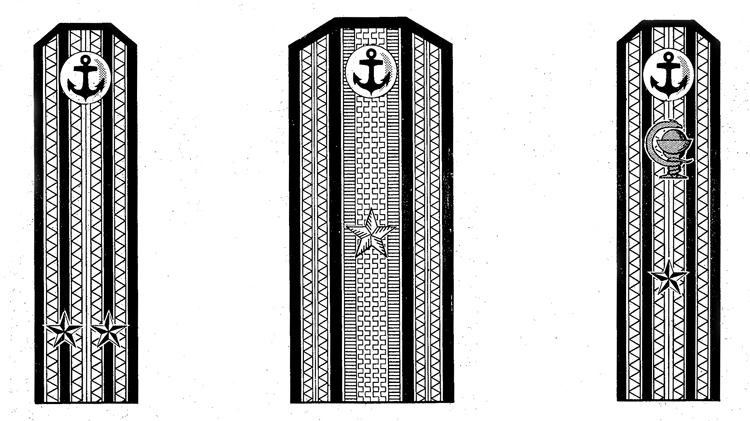
LT. COLONEL
ADMINISTRATION
CORPS
CAPTAIN
3RD RANK
(LINE)
MAJOR
MEDICAL CORPS
(WITHOUT SPECIAL
MILITARY MEDICAL
EDUCATION)
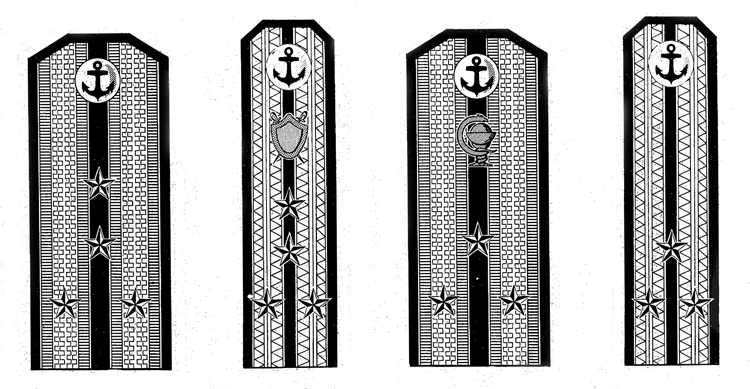
CAPTAIN
LIEUTENANT
(LINE)
CAPTAIN LEGAL CORPS
SENIOR LIEUT.
MEDICAL CORPS
(WITH SPECIAL
MILITARY MEDICAL
EDUCATION)
SENIOR LIEUT.
ADMINISTRATION
CORPS
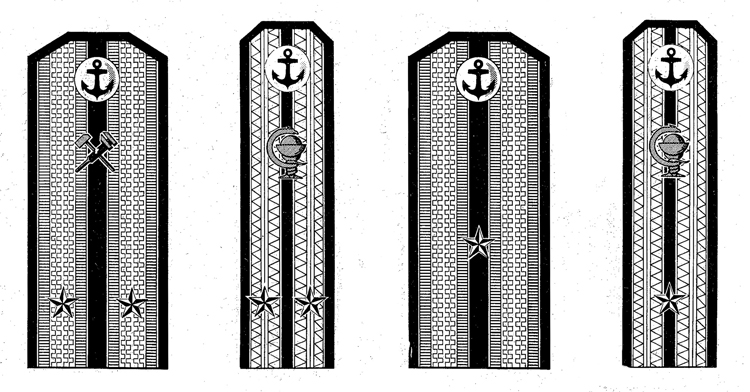
ENGINEER LIEUTENANT
LIEUTFNANT
VETERINARY
CORPS
JUNIOR
LIEUTENANT
SUPPLY CORPS
JUNIOR LIEUT. MEDICAL CORPS (WITHOUT SPECIAL MILITARY MEDICAL EDUCATION)
WARRANT OFFICERS, MIDSHIPMEN AND RATINGS

WARRANT OFFICER
MIDSHIPMAN
FORMER WARRANT OFFICER
MIDSHIPMAN FORMER
CHIEF PETTY OFFICER
MIDSHIPMAN
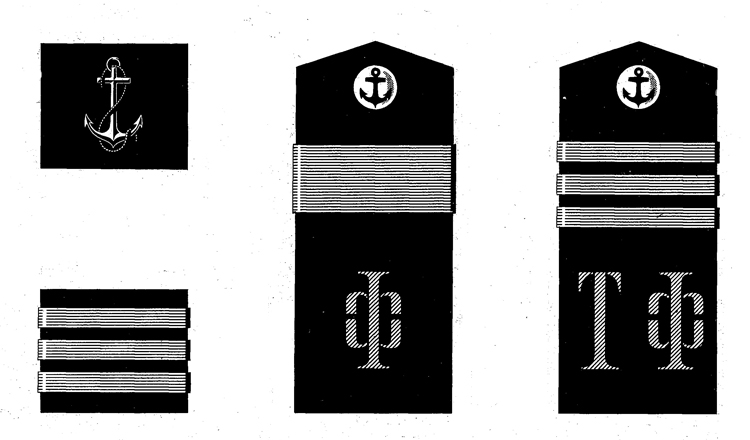
MIDSHIPMAN
PETTY OFFICER 1ST CLASS
CHIEF PETTY
OFFICER
(ATTACHED TO
NO SPECIFIC
FLEET)
PETTY OFFICER
1ST CLASS
(ATTACHED TO
FAR EASTERN
FLEET)
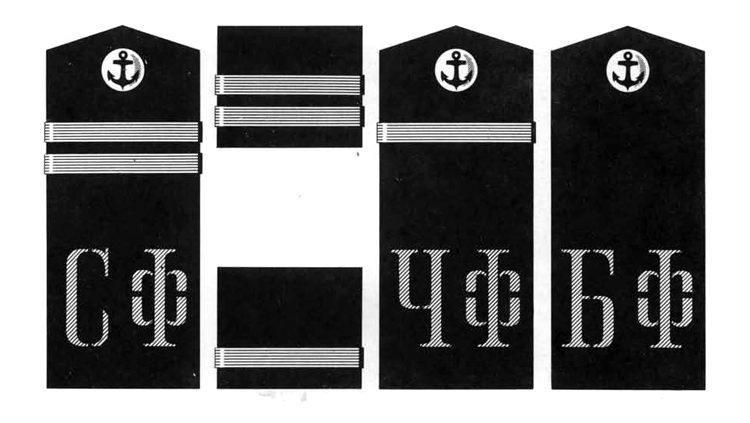
PETTY OFFICER
2ND CLASS (ATTACHED TO NORTHERN FLEET)
PETTY OFFICER
2ND CLASS
SEAMAN FIRST CLASS
SEAMAN FIRST CLASS (ATTACHED TO BLACK SEA)
SEAMAN 2ND CLASS (ATTACHED TO BALTIC FLEET)
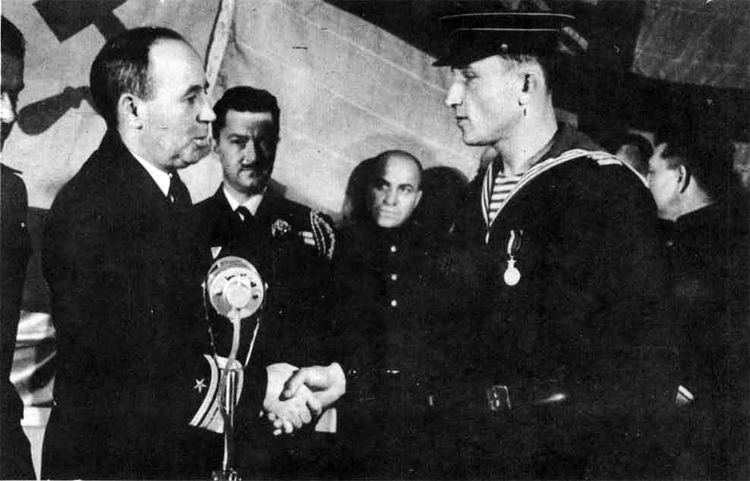
REAR ADMIRAL DUNCAN, U.S.N., U. S. NAVAL ATTACHE, MOSCOW, DECORATING A PETTY OFFICER, FIRST CLASS, WITH THE DISTINGUISHED SERVICE MEDAL
J. High Ranking Naval Officers
I. The Commissariat.
(a) Admiral H. G. Kuznetsov was appointed People's Commissar of the Navy and Chief of Naval Operations on May Day, 1939, at the early age of 37. He is an exceptionally able and ruthless administrator, and enjoys the reputation of being a most efficient organizer; in March, 1939, he was made a full member of the Central Executive Committee of the Communist Party. He was born in 1902,. and started life as an errand boy. In 1917, he served as a volunteer in the North Dvina River Flotilla. He was graduated from the Naval Academy in 1926, and was appointed to the cruiser CHERVONNAYA UKRAINA (since sunk) in the Black Sea. He served for four years as executive officer, and two years as commanding officer of Black Sea cruisers. For 17 months, prior to his appointment as commissar, he was Comman-der-in-Chief of the Pacific Fleet, with the rank of Rear Admiral. He speaks excellent Franch, and it is quite obvioua that he does not come of peasant stock.

Admiral H. G. Kuznetsov, Peoples Commissar of the Navy
(b) Admiral L. M. Galler is People's Vice Commissar of the Navy. Be is the son of an engineer officer in the Imperial Navy. He waa commissioned in th« Imperial Navy in 1905, and by 1917 was a commander and executive officer of a Baltic Fleet Battleship. He joined the Bolsheviks during the revolution and helped seize the Kronstadt Naval Base. Nearly all of his active service has been spent in the Baltic Sea, where he commanded various ships and was Chief of Staff of the Fleet prior to 1935. He has also served as Chief of th» Naval Staff. At the tim« of the purge (1937) he was already a full admiral, and was practically the only flag officer who survived this purge. He is a good typ» Tsarist officer and very highly thought of in his own service.

Admiral L. It. Galler, Vice Commissar of the Navy.
(e) Admiral I. S. Isakov is the Chief of the Naval Staff. He was born in 1898, and graduated from the Imperial Naval Academy at St. Petersburg. He is a good type Tsarist officer, although only a young lieutenant in 1917. During the Civil War, he served in the Northern Fleet and Volga River and Caspian Sea flotillas. He has never been closely associated with the Communist Party. He has spent most of his active duty in the Baltic Sea; in 1937, he was Chief of Staff of the Baltic Fleet. Prior to that time, he taught at the Soviet Naval Military Academy. In 1939, he was elected a deputy of the Supreme Council of tha D.S.S.R., and during the same year, he headed an unofficial naval mission to the U.S. for the purpose of arranging for ship construction in this country. He was appointed to his present position in 1941. For the past year, ha has been absent from his post, presumably being on active duty with the fleet.

Admiral I. S. Isakov, Chief of the Naval Staff.
(d) Vice Admiral V. I. Levchenko is a People's Vice Commissar of the Navy; he is 46 years old.
(e) Rear Admiral S. P. Ignatier is
a People's Vice Commissar of the Navy; he is a former "politico".
(f) Rear Admiral N. K. Smlrnov is a People's Vice Commissar of the Navy; he is a former "politico".
(g) Lieutenant General S. F. Zhavoronkov is Chief of Naval Aviation.
(h) Lieutenant General S. I. Vorobyav is head of the Supply Department.
(i) Lieutenant General I. S. Mushnov is head of Armaments and Munitions.
II. Baltic Fleet
(a) Admiral V. F. Tributs, Commander-in-Chief since May, 1939, was born in 1900, and originally served in the Imperial Navy as a sick bay steward, and after that as a private in the Red Army. He entered the Naval Academy in 1923 and was commissioned in 1926. He graduated from the Naval War College in 1932. He has been Executive Officer of the second line battleship MARAT, and after that Chief of Staff of the Baltic Fleet. He is a member of the Central Auditing Committee of the Bolshevik Itrty. He was promoted to the rank of admiral in June, 1943.
III. Black Sea Fleet
(a) Vice Admiral V. A. Vladimirski was appointed Commander-in-Chief in June, 194-3; he is 40 years old. He appears to be very energetic and outspoken, an able officer and well liked by his officers and men. Prior to his appointment as Commander-in-Chief I he was in command of a destroyer flotilla in the Black Sea.
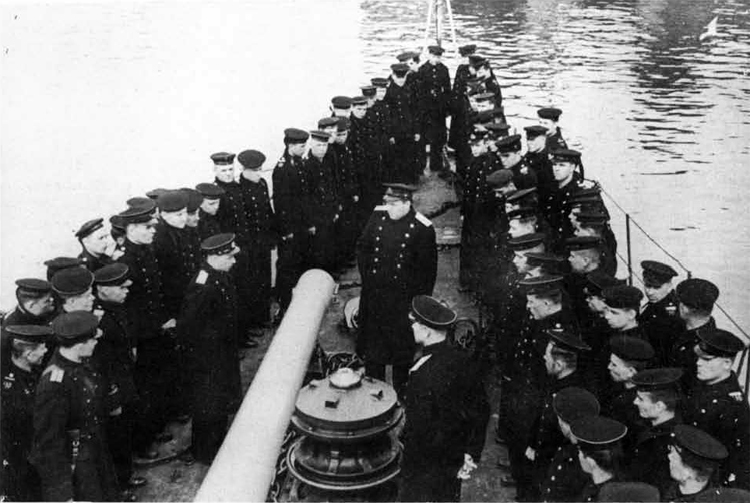
Vice Admiral Vladimirski, Commander-in-Chief of the Black Sea Fleet, inspecting the DD SOOBRAZATELNI.
(b) Vice Admiral N. E. Basisty is Commander, Cruisers,
Black Sea Fleet. He is rather older than Vice Admiral Vladimirski.
(c) Lieutenant-General Kumanin is Commander of Coast Defense of the Caucasus coast from Sukhum to Batura.
IV . Pacific Fleet
(a) Admiral I. S_. Yumashev. Commander-in-Chief, was born in 1895, the son of a railway employee. He served as a Petty Officer in the Imperial Navy. In 1918, he became a member of the Communist Party and in 1941, he was appointed a candidate member of the Central Executive Conmittee of the Bolshevik Party. He has commanded a cruiser squadron and has been Chief of Staff and Commander-in-Chief of the Black Sea Fleet. Although he possesses limited intelligence, he is extremely tough and a hard character. He was promoted to the rank of admiral in June, 1943.
(b) Rear.Admiral V. A. Alafuijov was appointed Chief of Staff in March, 194-3; be is about 45 years of age. Prior to this appointment, he was Assistant Chief of the Naval Staff at Moscow. He is considered to be keen, alert, and forceful, and one of the most capable of all Soviet Flag Officers.
V. Northern Fleet
(a) Vice. Admiral A. G. Golovko was appointed Commander-in-Chief In July, 1940 at the age of 32. He has a strong character, is keen, alert, aggressive, courteous, and willing to give assistance. He is the son of a veterinary surgeon. He has been in command of the Caspian Sea and Amur River Flotillas; during the Spanish Civil War he was Soviet Assistant Naval Attache at Madrid. He is a good administrator, but has had limited sea-going experience because of his youth.

Vice Admiral A. G. Golovko, Co Commander-in-Chief, Northern Fleet, with Rear Admiral Duncan, U.S.N., U.S. Naval Attache.
(b) Rear Admiral S. G. Kucherov was appointed Commander of the Tfhite Sea Flotilla in March, 1943. Prior to this appointment, he was Chief of Staff, Northern Fleet, and in 1942, he was Chief of Staff to Admiral Kuznetsoff.
VI. Caspian Sea Flotilla
(a) Rear Admiral F. S. Sedelnikov has been Commander of this flotilla since before 1940.
Vll. Amur River Flotilla
(a) Vice admiral F. S. Oktyabrski was appointed Commander of the Flotilla in June, 1943, a position which he held several years ago. His naval career was started as a stoker; later he became a mechanic. He was sent to the Naval Military Academy in 1925. Later he commanded a flotilla of Motor Torpedo boats in the Pacific. He is a member of the Central Auditing Committee of the Communist Party, and is said to be very popular within Party circles. In 1938, he was appointed Commander-in-Chief of the Black Sea Fleet, which position he held until June, 1943. His recent transfer is not readily understandable.
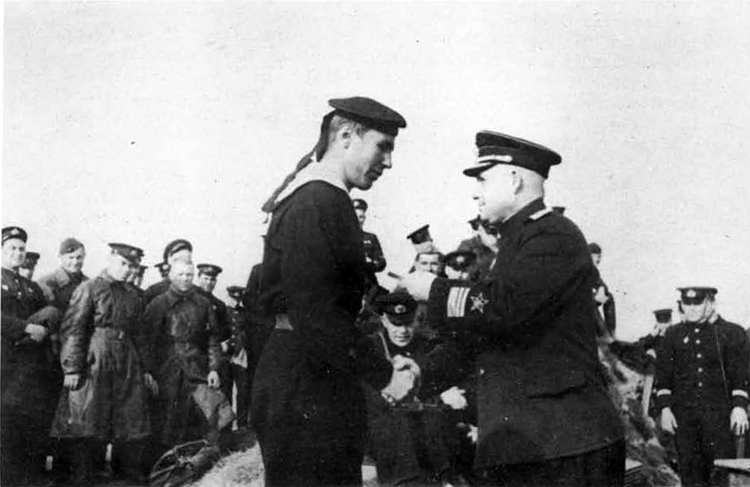
Vice Admiral Oktyabrskl, Commander-in-Chief of the Amur River Flotilla, while still Commander-in-Chief Black Sea Fleet.
CHAPTER IV. TACTICS AND OPERATIONS
A. In General
The tactical naval policy of the U.S.S.R. is dictated by the desire to employ its fleet defensively and not offensively, completely disregarding the fundamental principle for which all navies are built - to gain or dispute command of the sea. For that reason, the Russians allowed their Baltic Fleet, which at the outbreak of the war consisted roughtly of two battleships, three cruisers, twenty-six destroyers, ten torpedo boats, eighty motor torpedo boats, and one hundred submarines, to be completely bottled up within the narrow confines of Kronstadt and Leningrad by the Germans employing air power, light surface craft, and minefields.
B. Soviet Baltic Fleet
The Russian Baltic Fleet driven back into the narrow confines of Kronstadt and Leningrad is able to exert little if any pressure in the Baltic Sea proper. Apart from being icebound during the winter months, surface vessels of the Russian Fleet are only able to break out of the Gulf of Finland at considerable and probably unjustifiable risk. The German Air Force assisted by small surface craft, D/F and radiolocation stations, together with the aid of extensive minefields, completely dominates the Gulf of Finland. The Russians are even denied the opportunity, through lack of bases, of affording air cover to their submarines which might possibly attempt to run the gauntlet during the summer months. Furthermore, this German stranglehold is strengthened by the German shore batteries near Peterhof. These interfere with Soviet minesweeping efforts in the approaches to Leningrad and Kronstadt, an essential preliminary to any attempt on the part of Soviet submarines to break out into the Baltic, A grave disadvantage for the Russians is the climatic conditions which, in the summer months, allow aerial observation to be carried out practically continuously. Soviet submarines, operating in the Baltic in 1942, did little damage but the mere threat to Axis shipping of enemy submarines in the Baltic must have dislocated Axis shipping to some extent. If the U.S.S .R. were able to overcome the enemy hold on the Gulf of Finland, she would have an adequate submarine force available for service. It is estimated that the Baltic Fleet has about 36 submarines consisting of 9 large, 19 medium and 8 small craft; about 20-25 of these are ready for sea. There should be no trouble in regard to the manning position, but there may be an insufficiency of torpedoes and a lack of oil fuel and spare parts owing to the siege conditions in Leningrad.
Although there is no conclusive evidence available, it is more than probable that the greater part of the personnel of the surface ships of the Baltic Fleet are employed in other branches of the Navy Commissariat, such as Coast Defense, including anti-aircraft and in Marine brigades. Of these surface craft, it is believed that the battleship PETROPAVLOVSK lies half sunk in Kronstadt Harbor and that her sister ship the GANGUT is probably berthed alongside in the Neva River with adequate camouflage. Her armament is reported to be efficient. The two modern 8,000 ton cruisers KIROV and MAXIM GORKI now have their armament complete, although these ships had both,at one time,been extensively damaged. The original destroyer flotillas, made up of approximately 36 modern boats, have been reduced down by casualties to about onerthird of their original strength. The complements of these vessels may well have been retained on board, as these craft are exceptionally useful for bombardment of German shore positions along the southern coast of the Gulf of Finland in the ORANIENBAUM and PETERHOF sectors.
It must be a source of considerable satisfaction to the Germans that, due to a variety of causes, they are able to contain the whole Baltic Fleet by means of air power, light surface craft, and the modern devices of radio and radio-direction finders.
C. Black Sea Fleet
Although the Soviet Black Sea Fleet has been driven back to unsuitable and ill-equipped bases at Batum and Poti, it is nevertheless exercising some of the advantages of sea power. These two Georgian harbors contain not only the greater part of the Soviet Fleet but also all the remaining Black Sea Russian merchantmen and tankers. It is fortunate indeed that the German threat to the Cauqasus has been removed since this considerable amount of shipping is very much congested and insufficiently dispersed against any determined large scale bombing attack. The Soviet C-in-C must also be relieved to know that the Axis have no heavy naval forces in Black Sea waters since the repair facilities at these bases would be quite unable to cope with any large scale damage after a heavy Fleet action. In this connection?it is understood that at Batum there are no docking facilities of any description ana rather meagre limited repair shops. Poti, the manganese port some 30 miles to the northward, is better off in this respect, since it possesses two floating docks capable of taking any modern destroyer and some efficient workshops, but it seems unlikely that either of these docks can accommodate a cruiser. The modern 8,000 ton cruiser M0L0T0V has been lying disabled at this base with her stern completely blown off since September, 1942, and,so far, no repairs have been effected. On the other hand, a complete new bow has been fitted to a destroyer casualty which does prove that major repair work can be carried out on smaller craft. The Fleet is further handicapped by having no permanent ammunition stowage, victualling and supply yards. Russians, when pressed, are exceedingly capable im-provisers, and it seems as if the Fleet is now sufficiently supplied with ammunition and torpedoes. There should be no lack of submarine spare parts, since, as an emergency measure, it would be feasible to assemble spares from nine Caspian Fleet submarines. With the threat to Baku removed, t&ere is no longer any function for these boats to perform. Between these two bases, the following naval vessels are berthed:
Two modern cruisers (one, M0L0T0V - damaged); two old cruisers; one old dreadnought battleship; one Flotilla Leader; six/seven modern destroyers (two damaged), two/three old destroyers and about 40 submarines of various classes, including large 750 ton boats, medium 550 ton class and some 12/13 baby 200 tonners.
In addition to this Fleet, there are also two modern cruiser hulls (KUIBYSHEV and FRUNZE), which were successfully towed away from the MARTI yard at NIKOLAEV prior to the German occupation of this important Black Sea naval building yard on the River BUG. There is also the hull of an uncompleted Flotilla Leader ERIVAN lying in BATUM. The battleship SEVASTOPOL has performed little if any useful sea service during the war, but is probably effective as a powerful A/A battery for harbor defence. The services of the Black Sea Fleet, throughout the war, have followed the usual Russian tradition of restricted operations/confined in the main?to close support of the Red Army ashore. Its main units have unfortunately never been used for any major sea operation, and there is no doubt that great opportunities were lost in the early months of the war of attacking Axis seaborne supplies along the Rumanian and Bulgarian coasts. On the other hand, the older cruisers and small craft have performed most able
and gallant service in covering the landings in January, 1942, :wMeh. led to the re-occupation of the Crimean towns of KERCH and FEODOSIA. The cruiser KRAZNY-KAVKAS, together with destroyers, was instrumental in bringing supplies both of men and material to the beleagured fortress of SEVASTOPOL in the face of attack from German aircraft in great strength. The Fleet also suffered, from bombing before it was forced to retire eastward to the temporary base of TUAPSE. Its casualties are not accurately known, but approximately comprise one cruiser, two flotilla leaders, five modem destroyers, four old destroyers, three heavily armed gunboats, and an unknown number of submarines. In addition to the main bases at EATUM and POTt, there is also a submarine base at OCHEMCHIRI some way further north. At one time, the port of SUKHUM was used as the headquarters of the Naval Commander-in-Chief, but since January, 1943, it has been located at MAKOPSE, some 15 miles southeast of TUAPSE.
Roughly from January until June, 1943, the Black Sea Fleet was occupied with safeguarding the shipment of military reinforcements and supplies from Batura, Poti, and Sukhum to the ports of Tuapse and Gelendzhik, from which points attacks on Novorossisk were made. Since the re-occupation of Novorossisk by the Russians, it has been occupied chiefly in aiding land forces, including one or two amphibious landings. Air, submarine and surface forces are all being used of fensively against Axis shipping in the Black Sea, upon which the Germans in the CRIMEA and, to a lesser extent, in South Russia, entirely depend. In general, it can be said that although the C-in-C realizes the importance of striking at Axis shipping, his efforts on the whole have met with little success, and German convoys continue on their work without incurring any really substantial losses. But the Germans are being forced to provide better and more frequent surface escorts and close air cover. Constant minesweeping is also essential, in view of the mining efforts which the Russians are making. The Russian air forces are also carrying out high level bombing of the Axis convoys and on the assembly ports of SEVASTOPOL, YALTA, FEODOSIA and KERCH.
Since the re-occupation of the entire eastern coast of the Black Sea and most of the Sea of Azov coast, the Black Sea Fleet has been able to utilize more advanced bases in its attacks on Axis shipping. The degree to which these bases have been re-equipped is not known; however, during the Soviet advance along the northern coast of the Sea of Azov, the units which the Russians were able to assemble were very active} several amphibious landings took place. For example, the small port of Yalta, southwest of Mariupol, was captured in this manner.
D. Far Eastern Fleet and Amur River Flotilla
Because of the fact that the U.S.S.R. is still neutral in the Pacific, activity of the Far Eastern Fleet and of the Amur River Flotilla is limited to peacetime operationsj these consist, chiefly of patroling the coast from the Korean frontier to Bering Strait, as well as along the Northern Frontier of Manchukuo on the Amur River. Because the Japanese have been seizing occasional Soviet merchant ships which carry Lend-Lease supplies from the U.S. West Coast to Vladivostok and neighboring ports, Soviet destroyers have recently been convoying these ships through the First Kurile Strait.
A few units of the Far Eastern Fleet have been transferred to the Northern Fleet, since the beginning of the war; units so transferred consist of at least one 3000 ton destroyer leader, twd destroyers, and 7 or 8 submarines.
E. Northern Fleet
Formerly the most active fleet by far, the Soviet Northern Fleet is,at the present time, engaging in little#operational activity. The main function of this fleet was that of protecting Allied convoys coming to and leaving from Murmansk and Archangel* For the past several months, there have been no convoys routed to these northern ports with the resulting inactivity of this fleet. The Northern Fleet has also aided land forces in two dramatic but useless commando type landing attempts behind Axis lines.
Chapter V. STRENGTH AND DISPOSITION OF THE SOVIET NAVY
A. Baltic Fleet
2 overage Battleships (23000) tons): GANGUT - probably ready for sea. PETR0PAVL0V5K - lying half sunk in Kronstadt Harbor.
2 heavy Cruisers (8000 tons): KIROV - ready for sea if repairs have been made. MAXIM GORKI - probably ready for sea.
1-2 Destroyer Leaders (3000 tons): LENINGRAD - ready for sea. MINSK - reported as undergoing repairs; may have been sunk.
8 Destroyers (1,65O tons): DROZD - ready for sea. GROZIASHCHI - ready for sea. SILNY - ready ibr sea. SLAVNY - ready for sea. STOROZHEVOI - ready for sea. 3 others (names unknown) - probably undergoing repairs.
36 Submarines (only about 20-25 of these are ready for sea): 9 large units (900-1300 tons); 19 medium units (700 tons); 8 small units (200-300 tons)
1 Cruiser Minelayer: MARTI - ready for sea.
2 Destroyer Minelayers: RISTNA - ready for sea. URAL - probably ready for sea.
7-10 Minesweeping - patrol vessels.
50 Motor Minesweepers, trawlers, etc.(approximate)
6-9 Auxiliary Gunboats.
35 other Auxiliary vessels, (approximate)
B. Black Sea
1 overage Battleship, (23,000 tons): SEVASTOPOL
*2 modern heavy Cruisers (8,000 tons): M0L0T0V - stern blown off - awaiting repairs. VOROSHILOV
1 overage heavy Cruiser (7,000 tons): KRASNY KAVKAZ
1 overage light Cruiser (7.000 tons): KRASNI KRIM
*1 Destroyer Leader (3,000 tons): KHARKOV - Germans reported this unit sunk in October, 1943.
*7 modern Destroyers (1,650 tons): BODRY, BOIKY, BEZPOSHCHADNY, SVOBODNI, SMISHLENNI, SOOBRAZATELNI, SOVEHSHENNI
2 overage Destroyers (1,300 tons): Names unknown
2 Torpedo boats (800 tons): SHKVAL, SHTORM
41 Submarines (33 of which are ready for sea; others refitting). Six of the following have been sunk:
6 large "L" Class units (1,300 tons): L-4 L-23 L-5 L-24 L-6 L-25
4 large "D" Class units (1,000 tons): D-l D-5 D-4 D-6
4 medium "S" Class units (750 tons): S-32 S-34 S-33 S-35
14 medium "Schch" Class units (660 tons): Schch-201 Schch-208 3chch-202 Schch-209 Schch-203 Schch-210 Schch-204 3chch-212 Schch-205 Schch-213 Schch-206 Schch-214
Schch-207 Schch-215
13 small ("M" Class units (200 tons): M-31 M-51 M-32 M-52 M-33 M-54 M-34 M-55 M-35 M-56 3 others
6 average "G" Class units (650 tons): Names unknown
30 Motor Torpedo Boats (approximate)
1 overage Gunboat:
KRASNAIA ABKHAZIA or KRASNY ADZHARISTAN
6 Minesweeping Patrol Vessels (600 tons): FUGAS, KAPSUL, PAKAVAU, TCHSKA, 2 others
12 overage Minesweepers
7 Minesweeping trawlers
45 Motor Cutters (approximate)
*The hulls of the incomplete cruisers FRUNZE and KUIBYSHEV are at Poti. No work has been done on them since 1941.
The hull of an incompleted unit either the DL ERIVAN or DD OZORNI is at Poti although work is progressing on her, she has not,as yet been completed.
C. Far Eastern Fleet
1 heavy Cruiser (8,000 tons): KALININ
3 Destroyer Leaders (3,000 tons): TASHKENT, TBILISSI, TOMSK
8 modern Destroyers (1,650 tons): RASTOROPNI, RAZYASHCHI, REDKI, REKORDNI, RESHITELNI, RETIVI, REZVII, RIYANI
3 overage Destroyers (1,300 tons): STALIN, VOIKOV, YAKOB SVERDLOV
6 Torpedo Boats (800 tons): BURUN, GROM, METEL, MOLNIYA, VYUGA, ZARNITSA
57 Submarines
11 large "L" Class units (1,300 tons):
L-7, L-13, L-8, L-14, L-9, L-17, L-10, L-18, L-11, L-19, L-12
37 medium "S" Class unit (750 tons): S-137
37 medium "Schch" Class units (660 tons): Schch-101 Schch-110 Schch-119 Schch-128 Schch-102 Schch-111 Schch-120 Schch-129 Schch-103 Schch-112 Schch-121 Schch-130 Schch-104 Schch-113 Schch-122 Schch-131 Schch-105 Schch-lU Schch-123 Schch-132 Schch-106 Schch-115 Schch-124 Schch-133 Schch-107 Schch-115 Schch-125 Schch-»134 Schch-108 Schch-117 Schch-126 Schch-135 Schch-109 Schch-118 Schch-127 3chch-136
8 small "M" Class units (200 tons): M-1,
M-30,
6 others-not identified
6 Patrol Vessels (600 tons): PODSEKATEL, PROVODNIK, STRELA. TROS, 2 others
12 Patrol Vessels (400 tons)
61 Motor Torpedo Boats
2 Net Layers
1 Seaplane Tender: PARTIZAN
40 Minesweepers
99 Coastal Motorboats
D. Northern Fleet
1 Destroyer Leader (3,000 tons): BAKU
A modern Destroyers (1,650 tons): GREMYASHCHI, GROMKI, GROZNI, RAZUMNI
3 overage Destroyers (1,300 tons): KARL LISBKNECHT, KUIBYSHEV, URITSKI
3 Torpedo Boats (800 tons): GROZA, SMERCH, URAGAN
20 Submarines
3 large "K" Class units (1,500 tons): K-1, K-3, K-21
4 large "L" Class units (1.300 tons): L-15, L-21, L-20, L-22
5 medium "S" Class units (750 tons): S-54, S-101, S-55, S-102, S-56
4 medium "Schch" Class units (660 tons): Schch-402, Schch-404, Schch-403, Schch-422
A small "M" Class units (200 tons): M-121, M-172, M-171, M-174
5 Motor Torpedo Boats: Two of these are former U.S. boats.
2 Patrol Vessels (600 tons): RUBIN, SAPFIR.
3 Minelayers: MURMAN,
PROSOUZ,
YUSHAR
*30 Patrol Boats:
includes trawlers, drifters, and subchasers.
*10 U.S. 185 foot AM's and 12 U.S. 110 foot SC's are at the present time enroute to this fleet, under Lend-Lease
E. Caspian Sea Flotilla
5 overage Gunboats
3 MARKIN Class boats (Ex-Torpedo Boats, 740 tons): ALVATER, BAKINSKI RABOCHI , MARKIN
2 LENIN Class boats (640 tons): KRASNI AZERBAIDZHAN, LENIN
9 Submarines: 6 medium "S" Glass boats; 3 small "M" Class boats.
30 Motor Torpedo Boats (approximate)
2 Minelayers (approximate)
7 Minesweeping Trawlers (approximate)
Various auxiliary craft
F. Amur River Flotilla
7 Monitors
18 Gunboats
10 Minesweepers
32 Armored Motor Boats
G. Lake Ladoga Flotilla
1 Gunboat: KONSTRUKTOR (former torpedo boat reconstructed)
5 Auxiliary Gunboats
8 Motor Torpedo Boats
20 Motor Minesweepers
other small craft converted to patrol and minesweeping cutters.
H. Lake Onega Flotilla
5-6 Patrol Vessels (some of which are armored)
8 Armored Tugboats
other small craft
CHAPTER VI. ORDNANCE
A. Guns
I. In General.
Little information is available on modern Soviet naval gun construction; it probably consists in part of a 7.1" 52 to 55 caliber gun, a 5.1" 55 caliber gun, a 4-" 53 caliber dual purpose gun, a 3" 55 caliber dual purpose gun, and several anti-aircraft guns of small caliber, as well as some variations to the above mentioned guns. Added to these, are guns which were built prior to and during the first World War by the Imperial Navy. These included a 16" gun (?), a 14" 52 caliber gun, a 12" 52 caliber gun, a 5.1" 55 caliber gun, a 4«7" 50 caliber gun, a 3.9" 60 caliber gun, a 3M 50 caliber gun, and a 3" 30 caliber anti-aircraft gun. The general principle governing rifling, in guns constructed during the last war, was that the depth of grooves should be 1/2 a lini (1.27 mm.), the width 3.5 lini (8.9 mm.), and breadth of land 1.5 lini (3.81 mm.), independent of the caliber of the gun; this principle may still be in existence today.
II, Tsarist 16" gun.
Although probably none of these guns were ever completed, they were to form the main battery armament of future battleships and battle cruisers; they were to be of similar construction and material as the 14" 52 caliber gun, but were to have a length of not over 4-5 calibers. The number of lands and grooves would probably have been 96.
The weight of the gun was to be 104 l/2 tons, the weight
of the shell 2,520 lbs., and the muzzle velocity (calculated) 2,800
ft, per second.
III. Tsarist 14" 52 caliber gun.
Twelve of these guns were to form the main-batteries of the battle cruisers of the Borodino Class, which had been launched prior to the Russian Revolution but were never commissioned. These guns had a length of powder chamber from the rear end of the tube to the base of the shell when in place of 112"„ The diameter of the powder chamber was 15.96". This gun was very similar to the 12" 52 caliber gun, but was constructed of chrome nickel steel, instead of Martens steel, with an elastic limit of 4550 atmospheres. The weight of the guns was 80 »4 tons. The rifle consisted of 84 lands and grooves, angle 6°, uniform twist, one turn in 30 calibers, A Vickers breach mechanism and gas ejector were used. It is not 'known if any of these guns are still in existence; if they are, they must be used as coastal batteries, as the U.S.S.R. has employed no gun larger than 12" on her naval units.
IV. Tsarist 12" 52 caliber gun.
Twelve of these guns mounted in 4 centerline turrets still form the main battery armament of the overage battleships GANGUT, PETR0PAVL0VSK, and SEVASTOPOL, although it has been reported that the guns in #2 and #3 turrets of the SEVASTOPOL have been replaced by guns "of a higher caliber". They are built of Martens steel and weigh 50.6 tons. The weight of the shell is 810 lbs.; they have a muzzle velocity of 3-150 ft. per second. The length of the powder chamber from the rear end of the tube to Us base of the shell'when in place is 96". The diameter of the po?/der chamber is 13*68". Rifling consists of 80 lands and grooves of uniform twist, angle 6°, one turn in 30 calibers.

Russian Naval 12" 52 caliber Gun Scale 1:40
V, Modern 7.1". 52-55 caliber gun
forms the main battery armament on all Soviet heavy cruisers; it is probably the largest gun yet constructed under the Soviet regime. No information ia available on this gun.
VI. Modern 5.1" (130 mm.) 50 caliber gun
is called by the Russians the B-13-2s. It is used as main battery armament on all Soviet Destroyer Leaders and destroyers of recent construction. This gun, which fires at an elevation of from 5° to 45°, is placed in a gun shield. It is fired by means of a hydraulic trigper mechanism, which is operated by pedals and by means of percussion and electric fuses. The elevating gear is arranged in quadrants. It has one control lever on the right side. The transversing gear turns 360°, and has two control levers. It is a breech loader of Vickers type; the shells are fed pneumatically, and the charge is fed by hand. It has one right and one left sight. Its barrel is of a 19.3?- -odel. The tube and casing consist of a single riece; there is no recess in front of the casing. The rifling has 40 grooves; they are of constant steepness and run from the left upwards to the right. The length of the rifling is 25 calibers. The breech mechanism is steel, a forging of rectangular shape.
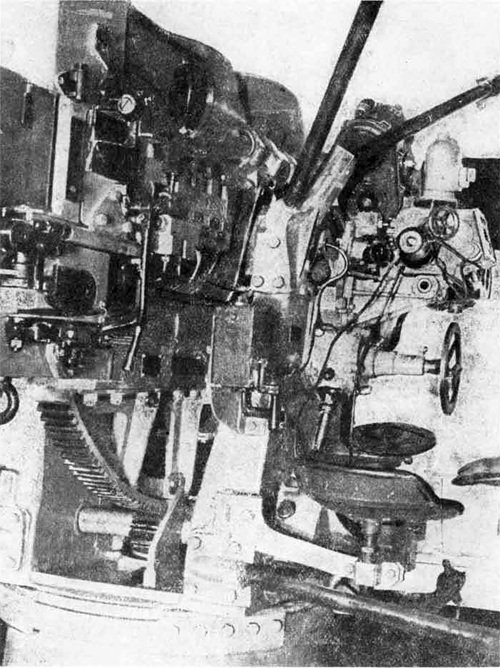
View of Modern Soviet 5.1" Gun from the right side.

Modern Soviet 5.1" Gun - general view.
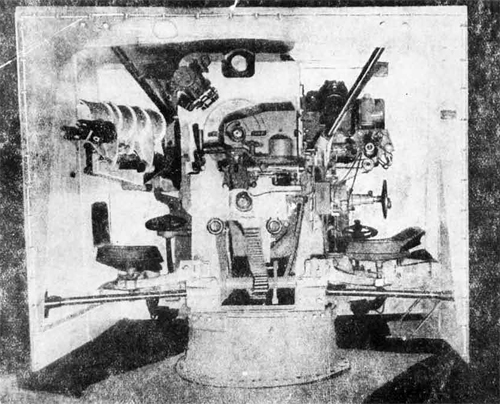
View of the Modern Soviet 5.1" Gun from the breech end.
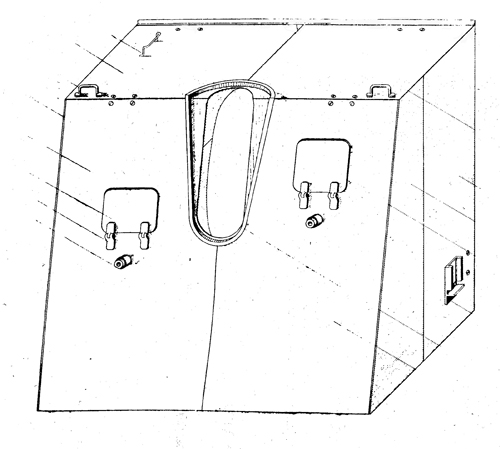
Armored shield of the Modem Soviet 5.1" Gun.

Barrel of the Modern Soviet 5.1" Gun.
VII. Tsarist 5.1" (130 mm.) 55 caliber breech loading rifle.
This gun probably forms the main battery armament for the overage light cruiser, KRASNY KRIM, and possibly is to be found on other older units^ of the Soviet Navy; it is a built-up gun of Martens steel. It consists of the tube in one length, two reinforcing bands, the rear one being of uniform thickness and extending from the breech to about the middle of the length of the tube, and the front one, tapering slowly to a muzzle, without a tulip. Outside is the jacket, extending to about 20" forward of the joint between reinforcing bands tapering over the chase.
Rifling consists of 30 lands and grooves of uniform twist, at an angle of 6°, one turn in 30 calibers. The depth of the groove is 1 millimeter, the width 9.14 millimeters, and the breadth of land 4«4-7 millimeters. It has a Vickers breech mechanism^ and a Vickers system of air-blast for clearing the bore.

Tsarist 5.1" 55 caliber Gun. Scale 1:20
a = Tube
b1b2 = Reinforcing cylinder in two parts
c = Jacket
d = Breech piece
e = Recoil band
f = Strengthening ring
g = Breech ring
VIII. Modern 4" (102 mm.) 53 caliber, dual purpose gun
is used as pain battery armament on the larger submarines and probably on some surface craft. It is of light, mono block construction, and has a maximum elevation of about 75°, but is used, against, aircraft as Well; as against surface units. The breech is of a sliding KLock type and the lands are very sharp and high, curving to the right, as in other Soviet naval guns. The sight is a waterproof combination receiver and gunsight telescope5 it is left installed when the submarine dives. The watertight gunsight housing includes a sight setting mechanism which can be.set either locally or by remote control. The train and elevation of the gun is done by hand wheels; there is practically no lost motion in the gearing. This gun trains and elevates extremely easily and fast, and has good balance. Fixed ammunition is used for this gun, weighing 16 kilograms, with the case being very short and squat, but quite large in diameter. A nose fuse is fitted to the projectile, but it is covered with a metal cap. The slide of the gun is chrome plated, the rest of the gun being made of steel.
IX. The Modern 3" (76*2 mm.) 55 caliber, dual purpose universal naval gun
is known as Mark 34-K by the Russians. This gun, the principles of which were designed in 1935, was modernized in 1939• It is placed in an armored shield. The barrel has a very heavy breech mechanism, and its center of gravity is shifted to the breech face. This makes it possible for the gun to attain a high angle of elevation, while maintaining the normal elevation of the trunnions for firing at low elevation^ the breech block is wedge-shaped. This gun is operated by two gunners by means of two foot pedals or the manual trigger; it is provided with a universal optical sight of the "MO" type, which consists of two similar mechanical optical sights, one on the right of the gun, and the other on the left. The one on the right is used for aiming at a horizontal target, while the one on the left is used for aiming at a vertical target. The wind gauge and sight are set by turning the flywheels of the mechanized gear. There is a barrel securing device for unloading the gun while underway; it is placed on the front of the armored shield.
General specifications are as follows:
Length of the barrel, 4223 millimeters.
Length of the rifled portion, 3379 millimeters.
Number of grooves, 28.
Width of the rifling, 5.25 millimeters.
Depth of the rifling, .75 millimeters.
Length of the cartridge load, 862 millimeters.
Height of the axis of the trunnions, 1504 millimeters.
Extent of horizontal firing, 360©.
Extent of vertical firing, -5°-+85°.
Speed of vertical aiming for one turn of the flywheel, 4°»
Speed of horizontal aiming for one turn of the flywheel,6°.
Muzzle velocity, 820 meters per second.
Horizontal range, 14,200 meters.
Vertical range, 9,300 meters.
Rate of fire per minute, 15 to 18 rounds.
Weight of the shell, 6.5 kilograms.
Weight of the charge, 1.88 kilograms.

General view of Modern Russian 3" Dual Purpose Gun.

General View of Modern Russian 3" Dual Purpose Gun.
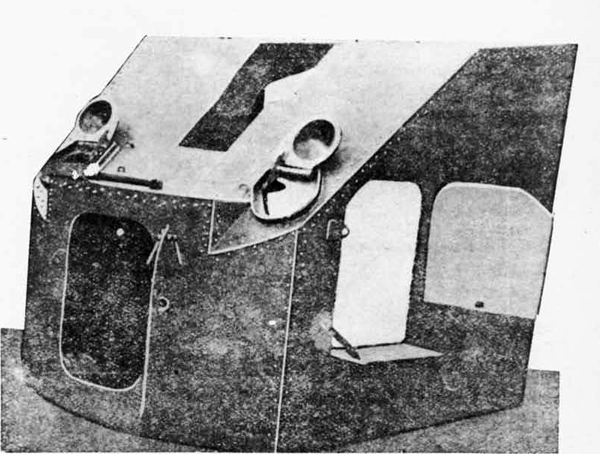
Armored shield of* i odfirn Rus3ian 3" Dual Purrose Gun.
X. 1.8" (45 mm.) 46 caliber, dual purpose universal naval gun
is used on Soviet submarines as well as on merchant vessels; it possibly forms the main armament on the small "M" Class submarines (200 tons) and secondary on larger boats, such as the "S" Class (750 tons). This gui- was modernized in 1938; changes made to it at that time in- ,. eluded the addition of semi-automatic devices, the rcanner of securing the gun to the deck, alteration of the azimuth circle, etc. Its primary use is that of a short-range anti-aircraft gun, but it can also be used against horizontal targets. The gun carriage is a trunnion mount with a Bofors-type cradle. The absorbing gear is hydraulic; the recuperator has springs. This gun is operated by one man only, although its sights can be operated by a second. The control levers have both horizontal and vertical aiming, and are on the left side of the gun. Indirect aiming is possible only within the field of vision betv/een the limit of movement of the intersections, or 19° to the right or left.
It is equipped with a Soviet ShB-1 Classified sight, having a field of vision of 38°. The breech block is wedge-shaped and vertical; it opens below and is semi-automatic.
This gun, when mounted on submarines, is hermetically plugged by means of a cork, which will keep the barrel dry down to ir:0 meters of water.
Three types of amiTiur.ition can be used in this gun; an antiaircraft percussion <;ren,ode with sensitive fuse, an srnor-pierc:i ng explosive effect shell, and an ordinary armor-jiercing shell.
General Specifications are as follows;
Diameter of the cartridge chamber, 50.2 mm. and 53.2 mm.
Length of the entire barrel, 2072.5 mm.
Length of the chamber as far as the rifling, 325 mm.
Number of grooves, 16.
Design of breech block, wedge-shaped.
Rate of firing, about 30 rounds a minute.
Type of carriage, Trunnion.
Height of line of fire, 1,215 mm.
Horizontal firing, 360°.
Maxijnum angle of elevation, 85°.
Maximum angle of depression, 10°.
Angle of elevation of the gun for one turn of the control
lever of the elevating mechanism, 4-°. Height of the axis of thg trunnions, 1,200 mm. Maximum horizontal range, 9.500 meters. Maximum vertical range, about 6,000 meters. Weight of the entire mount, 5,006 kilograms.

View of the right side of a Modern 1.8" Dual Purpose Gun.
General view of the mount of a Modern 1.8" Dual Purpose Gun.
View of the left side of
a Modern 1.8" Dual Purpose Gun.
XI. The Modern 12.7 mm. 79 caliber, dual purpose Machine gun
is called "DK (DEGTYAREV)" by the Russians. It is claijned that because of its long caliber, when this gun is fired at a target 200 meters distant at an angle of 90°, 50$ of the bullets will penetrate 20 mm. armor and 100% will penetrate 16 mm. armor. It is a gas operated weapon; its cartridge belt is made of semi-rigid metal and contains 50 bullets. The barrel of the DK is a massive tube having no special cooling device; it is cooled by means of ribbing on the barrel itself. The rifled section of the barrel contains eight grooves. To reduce its recoil force, this gun is equipped with a positive muzzle brake, which reduces this force by !£.%. The DK is placed on a naval pedestal mount. It is equipped with both universal and classified sightsj the classified sight is used when aiming at aircraft only.
General specifications of the DK gun are as follows:
Angle of elevation, 82°.
Maximum rate of fire, 240 rounds per minute.
Maximum safe rate of fire, 86 rounds per minute.
Muzzle velocity, 850-870 meters a second.
Aiming range of horizontal sight, 3,700 meters.
Aiming range of anti-aircraft sight, 2,400 meters.
Length of the machine gun, 1593.5 nun.
Length of barrel, 1,003 mm
Length of rifled part of barrel. 890 mm

View of the Modern Soviet 12.7 mm Dual Purpose Machine Gun.
B . Torpedo-Tubes.
I. In General. As far as is known, the Soviet Navy uses two sizes of torpedo tubes, an 18" and a 21". 18" torpedo tubes are to be found on battleships, torpedo boats, the smaller motor torpedo boats and 200-ton submarines; the 21" torpedo tubes have been placed on cruisers, destroyers, the larger motor torpedo boats, and large and medium-sized submarines. No information is available on the construction of the 18" tube, but it may be presumed that they are somewhat similar to the 21".
II. 21" torpedo tubes appear to be made of steel with one riveted seam;. The inside finish is rough and painted. There are four milled steel bearing surfaces fitted longitudinally 90° apart to accommodate the torpedo, raised about 1/4. of an inch from the tube surface. The exact diameter of the tube bet?»een bearing surfaces is 533 millimeters (about 20.9 inches); the length of the tube is 24»6 ft. The raised bearing surfaces of the tube provide ample room for the necessary air escape upon loading. There is no guide slot fitted, this being accomplished by two fins, fitted on opposite sides of the torpedo, taking up on the raised portion of the bearing surfaces to prevent carting. It is believed to be usual for no gyro angle setting mechanism to be fitted or to have any mechanism for correcting the course of a torpedo outside the tube. The inner door must be open to do so. Torpedo ejection is accomplished by air (300 lbs.)> the firing being either electric or manual. There is a bubble swallower, installed about one third of the way down the tube from the inner door. The release finger for starting the driving mechanism is locked on dead top center, and is released immediately upon the motion of the torpedo. The firing latch is placed well forward of the torpedo; the Russians claim that this gives them more certain action and that fewer dummy torpedoes are fired, thereby. A stop bolt similar to that found on U.S. tubes is fitted which raises automatically*upon firing. A starting lever trip is used to start the torpedo, also similar to that used in the U.S. The torpedo chamber pressure,upon torpedo discharge,is 25 atmospheres, or 370 lbs. per square inch. No lock is provided between the inner and outer doors of the tube, although a warning target sign shows when the outer door is open. No tail nut can be fitted to the inner door. A depth fitting mechanism is fitted for setting depths in the tube. Poppet valves are also fitted which operate automatically and about 6" pipes are led to the bilges from these valves. Both the inner and outer doors of the tube are opened by hand. The outer door can also be opened hydraulically by means of a lever above the tube. The inner door is of the bayonet type, similar to that used in U.S. submarines.
On triple mount torpedo tubes which are fitted on most Soviet cruisers, there are handwheels for the off-setting of the outer two tubes for spread. Telescopic sights are mounted on top of the triple tubes.
C. Torpedoes
21" torpedoes are of all steel construction. They have a diameter of 533 mm. (about 20.9 inches) and a length overall of 7,197 mm. (about 23.6 feet); this extra length appears to be in the air flask section. They have a total weight, fully equipped, of 3,538.7 pounds and a weight without air and water of 2,650.1 pounds; the differential between these two weight is aft. These torpedoes have a positive buoyancy of 259.4 pounds.
It is believed that Soviet torpedoes are driven either by steam or by electricity. The most satisfactory type are those steam
driven by a mechanism of piston-drive construction, similar to that of an ordinary steam engine. The differential on these torpedoes turns the two propeller shafts, but in different directions. Although some sources state that these torpedoes are capable of making 55-60 knots, it is thought that their top speed is actually only about 35-40 knots. They have a range at top speed of 4,000 yards, and a range of 12,000 yards at minimum speed.
Soviet 21" torpedoes are discharged from their tubes usually by 4 atmospheres of pressure, but up to nine atmospheres are available; there is a volume of air of 20-25 atmospheres. These torpedoes have two screws; one is a square blade, with a very rugged appearance, and the other has a lip extension. The first propeller gives the impression, when looking at it directly along the axis, that there would be no free space between the following edge of one blade and the leading edge of the next blade, at the point of greatest width* The drive is of Whitehead type, and is said to be very dependable. The depth rudders are about 1/4. of an inch thick and occupy about four times the area of the steering rudders. Two weights, totalling about 263 pounds, are installed in the aft reservoir and hydrostatic compartments.
The horizontal and vertical planes on the torpedo are fixed to a tail assembly enclosing and protecting the propeller and extending beyond them. It is believed that the sides, on to which the elevator is attached, are also guides which travel down th* tube track together with another set of guides which are at about the mid-section of the torpedo sides. These tail skids are about 14." long and about 7/8 of an inch wide. The vertical rods,to which the rudder is attached,carry the lever mechanism from the body of the torpedo to work the rudder and elevator.
The warhead on 21" torpedoes is 5 or 6 feet long; it weighs 880 pounds and contains 660 pounds of explosives. Two exploders are fitted to the warhead on the top c/1, one behind the other, in case the first one should fail* These exploders are about 6 inches long and five inches in diameter, with screw threads fitted for a booster* The arming device is a small three-blade propeller fitted to the exploder, itself. It is reported that the exploder is fired by contact only; some experiments have been made on magnetic heads in the U.S .S it., but they were not found to be successful. These torpedoes have the overall appearance of careful manufacture.
It is said that the Russians have no wakeless torpedoes as standard equipment but that they have some experimental models and that their laboratories are experimenting with battery operated electrical torpedoes as well, but that up to late 1942, they had been able to produce torpedoes of this type only inferior in range and speed to the gas engine type.
D. Mines
I. In General. Soviet mines are of the magnetic, accoustic and contact type and are reported to be the same as the German in principle; various types are planted by surface craft, submarines, and aircraft.
II. Mark M. 08/39
Planted by: Surface vessel.
Weight of charge: 115 kgs.
Length of anchor cable: 110 meters.
Limiting depth in which 110 meters,
may be planted:
Limiting depth at which mine may ride below surface: 4 meters
Method of activation: Galvanic and contact.
Total weight: 592 kgs.
Length: 1,240 mm.
Width: 915 mm.
Height: 1,123 mm.
III. Mark M. 26
Planted by: Surface vessel.
Weight of charge: 240 kgs.
Length of anchor cable: 132 meters.
Limiting depth in which may be planted: 132 meters,
Limiting depth at which mine may ride below surface: 6.1 meters,
Method of activation: Contact.
Total weight: 890 kgs.
Length: 1,615 mm.
Width: 895 mm.
Height: 990 mm.
MARK M. 26
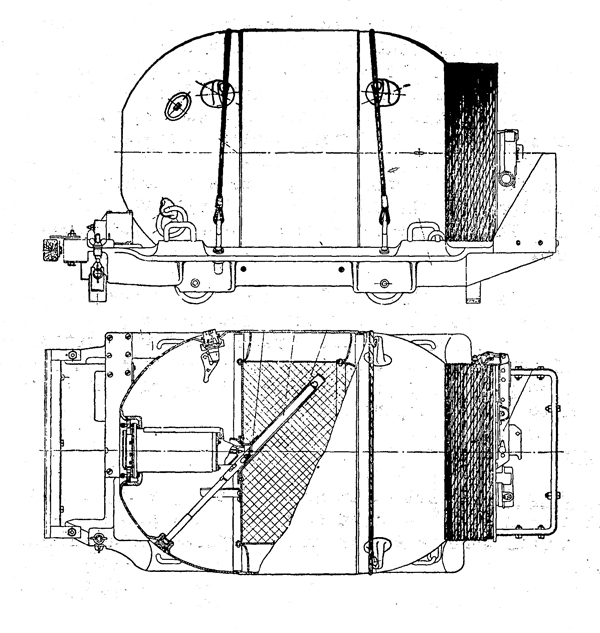
1. General view, mine on its anchor.
2. View in cross section
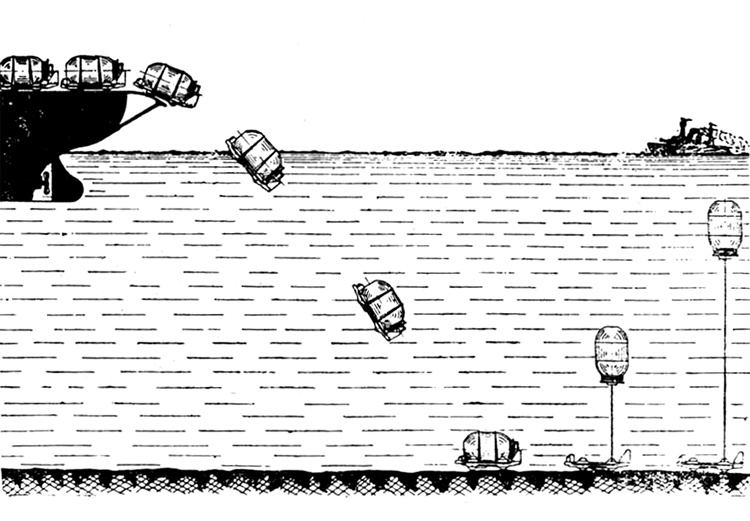
Steps in Planting Mark M. 26.
IV. Mark M. KB
Planted byi Surface vessel.
Weight of charge: 230 kgs.
Length of anchor cable: 263 meters.
Limiting depth in which may be planted: 263 meters.
Limiting depth at which mine may ride below surface: 9.0 meters.
Method of activation: Galvanic, contact.
Total weight: 1,065 kgs.
Length: 2,162 mm.
Width: 927 mm.
Height: 1,190 mm.
MARK M. KB
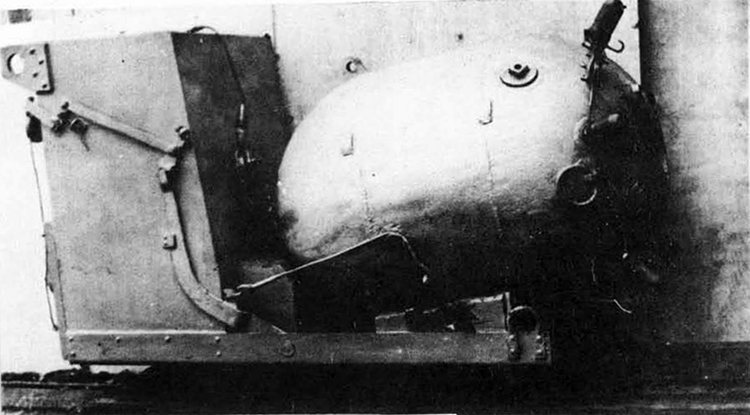
General view.
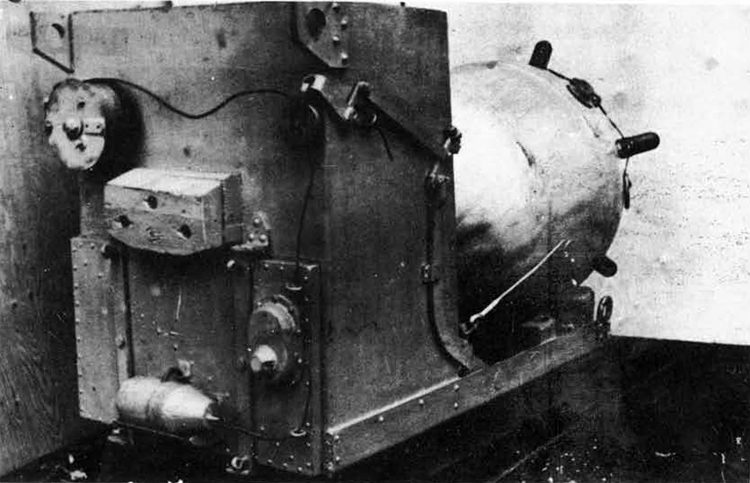
General view.

General view.
MARK M.KB
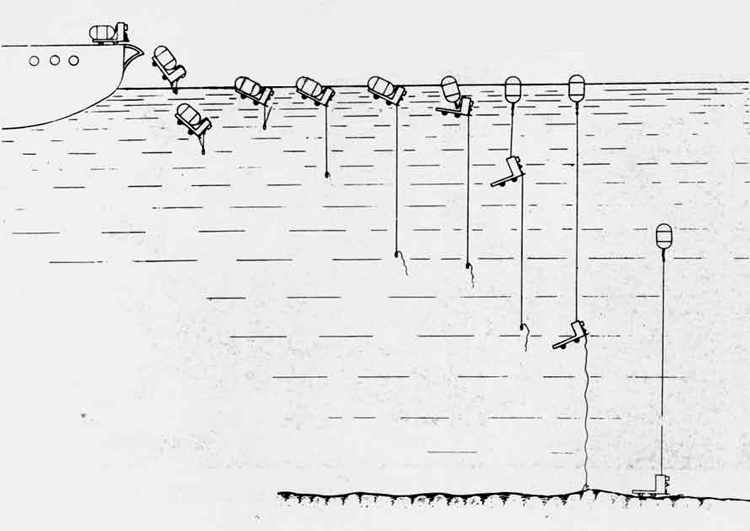
Steps in Planting.
V. Mark M. AG
Planted by: Surface vessel.
Weight of charge: 230 kgs.
Length of anchor cable: 395 meters.
Limiting depth in which 395 meters - plus
may tie planted: amount of submergence.
Limiting depth at which mine may ride below surface: 91 meters.
Method of activation: Antenna and antenna
galvanic.
Total weight! 1,120 kgs.
Length: 2,162 mm.
Widths 927 mn.
Height: 1,205 mm.
MARK M. AG
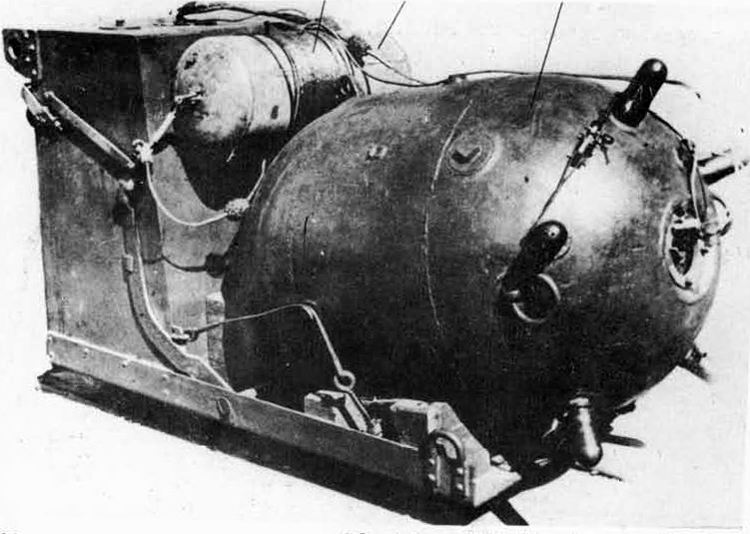
General view - mine ready for Planting with 2 antennae (lower and upper)
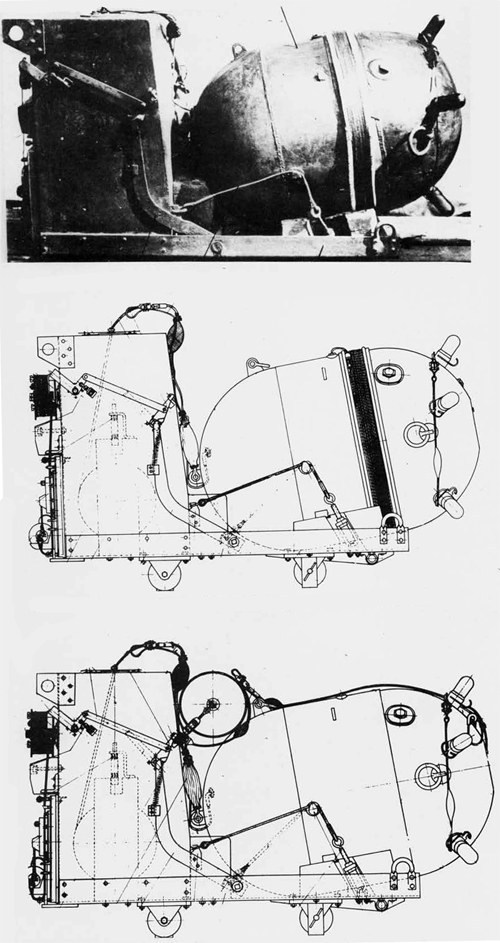
General view mine ready for Planting, with Jower antenna.
General view mine ready for Planting, with one lower antenna.
General view mine ready for Planting, with 2 antennae (lower, and upper).

Steps in planting mine AG with 2 antennae (lower and upper).
VI. Mark AMG
Planted by: Aircraft.
Weight of charge: 250 kgs.
Length of anchor cable: 150 meters.
Limiting depth in which may be planted: 100 meters,
Limiting depth at which mine may ride below surface: from 3 to 9 meters,
Method of activation: Galvanic, contact.
Total weight: 1,050 kgs.
Length: 3,600 mm.
Diameter: 950 mm.
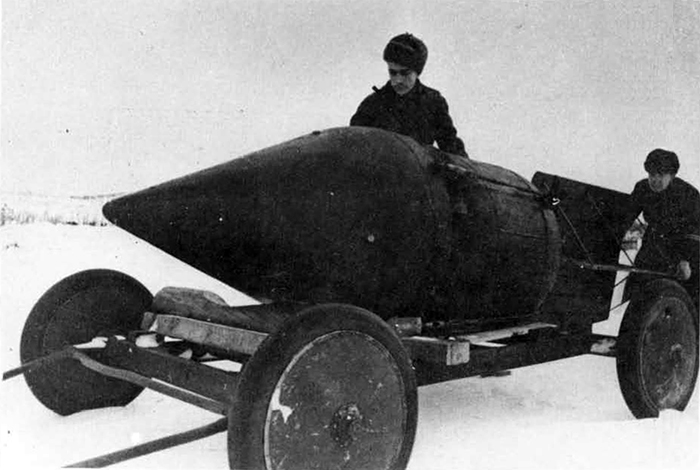
Loading a Mark M. AMG (?) mine - Naval Air Force of the Northern Fleet.
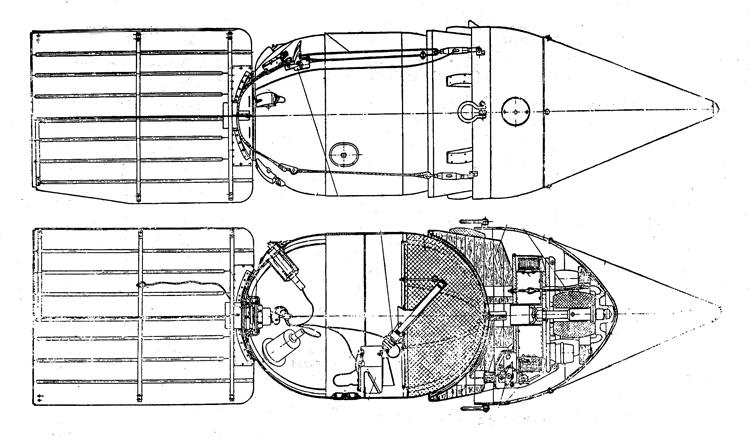
2 Sectional views.
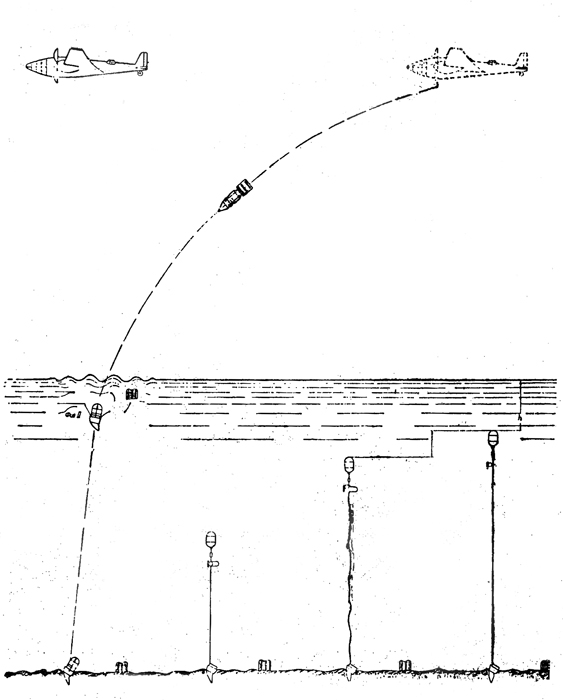
Steps in Planting,
VII, Name unknown:
Planted by: Submarine.
Means of ejection: Mine tubes.
Method of activation: Contact.
Total weight of mine and anchor: 600 kgs.(1,322.7 lbs.) .
Weight of mine: 400 kgs. (881.8 lbs.).
Weight of anchor: 200 kgs. (440.9 lbs.).
Total length of mine and anchor: 2,000 mm. (78.74 inches)
Length of mine: 1,700mm. (66.929 ")
Length of anchor: 300 mm. (18.811 inches).
Diameter: 900 mm. (35*43 inches).
Length of anchor cable: 140 meters (459 ft.).
Several types of Soviet submarines are fitted for mine-laying. For example, the "L" Class has two mine tubes aft, below the two deck torpedo tubes. Each tube can be loaded with ten mines of this type, or 14 mines of shorter length. Mines are loaded in the tubes by submerging the nose of the submarine and lifting the aft end until the tubes are clear of the water; this is done at specially constructed mine loading docks. It has been reported that certain Soviet submarines can lay cylindrical influence mines both magnetic and accoustic, as well as moored contact mines.
Mines are usually planted from "L" Class submarines at periscope depth, but they can be laid at any depth. The tubes are first flooded and then the doors are opened by means of an electric motor. Planting is accomplished by means of an electrically operated mechanism which pulls the aft mine from the tube and pushes the remaining mines aft. The mine is launched anchor first, while the submarine is travelling at slow speed.
The anchor of this type of mine has a plummet for adjusting the depth of the mine below the surface of the water. This plummet is released when the mine is ejected from the mine tube. The mine and anchor sink together until the plummet hits bottom and releases the mine from the anchor. The mine then rises to a depth below the surface equal to the length of the plummet cord.
VIII. Mark M. FLT
Planted by: Submarines.
Means of ejection: Mine tubes.
Weight of charge: 230 kgs.
Length of anchor cable: 130 meters.
Limiting depth in which may be planted: 130 meters.
Limiting depth at which mine may ride below surface: 9.0 meters.
Method of activation: Contact.
Total weight: 820 kgs.
Length: 1,770 mm.
Width: 860 mm.
Height: 795 mm.
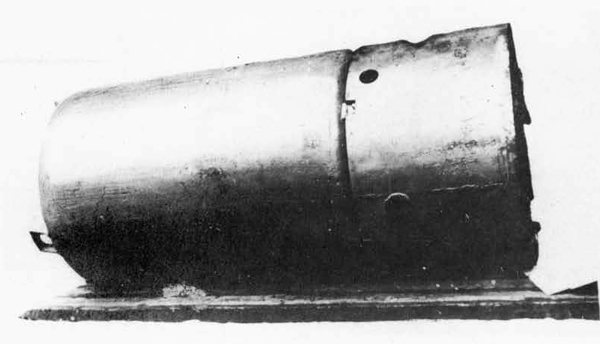
General view of mine on its anchor.
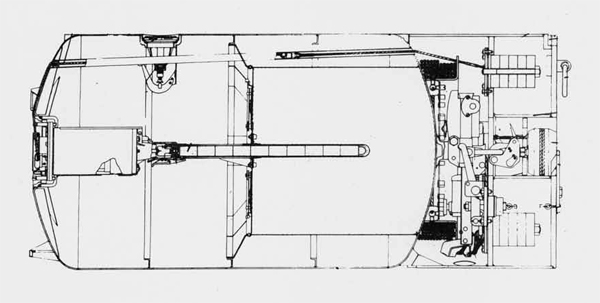
Sectional view of mine with anchor.

Steps in Planting.
IX. Mark M. PLT-3
Planted by: Submarines
Means of ejection: Torpeclo tubes.
Weight of charge: 100 kgs,
Length of anchor cable: 150 meters.
Limiting depth in which may be planted: 130 meters,
Limiting depth at which mine may ride below surface: 9 meters,
Method of activation: Galvanic, Contact
Total weight: 500 kgs.
Length: 2,355 mm.
Diameter: 533 mm.
MARK M/PLT-3

General view.
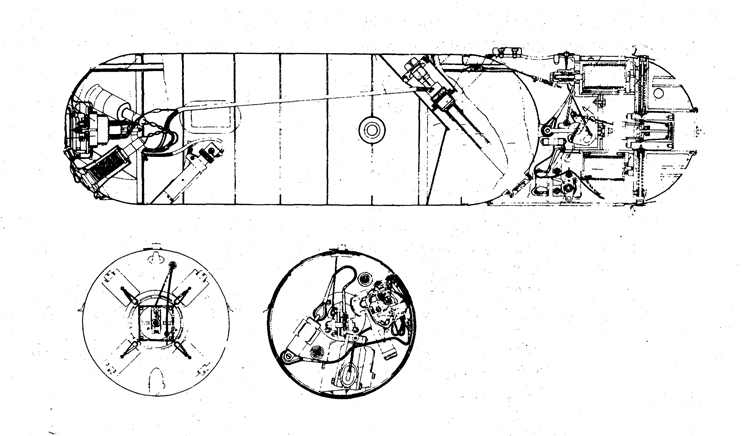
Sectional view of mine with anchor.

View of mine within a Torpedo Tube,

Steps in Planting.
X. Mark MlRAB
Planted by: Surface, river,
Weight of charge: 64 kgs.
Length of anchor cable: On bottom.
Limiting depth in which maybe planted: Calculated 5 meters from the bottom.
Limiting depth at which . mine may ride below surface;: Calculated 5 meters £rom the bottom
Method of activation: Noncontact, induction.
Total weight: 280 kgs.
Length: 1,030 mm.
Width: 688 mm.
Height: 700 mm.

General view.

Sectional view.
XI. Mark Mine Protector MZ-26.
Planted by: Surface vessel.
Weight of charge: Explosive in
1 kg. charges.
Length of anchor cable: 110 meters.
Limiting depth in which may be planted: 110 meters
Limiting depth at which mine may ride below surface; 18 meters.
Method of activation: Pressure of sweep wire.
Total weight: 413 kga.
Length: 1,240 mm
Width: 720 mm.
Height: 1,270 mm.

General view.
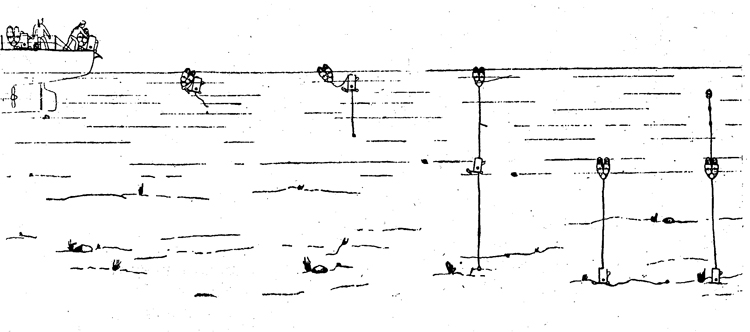
Steps in Planting.
CHAPTER VII. GENERAL SPECIFICATIONS AND DESCRIPTION OF NAVAL UNITS
A. BATTLESHIPS
1. OVERAGE BATTLESHIP SEVASTOPOL (Ex PARIZKKAIA KOIttKUKA. ISx. SEVASTOPOL)
GENERAL SPECIFICATIONS
Date laid down: 1909,
Date commissioned: 1915.
Normal displacement:. 23,000 tons.
Length 0,A.:, 594 feet.
Beam: 87 feet.
Maximum -draft: 27 feet.
Type of machinery: Parson's Turbines.
Horsepower: 42,000.
Number of Propellors: 4«
Type of boilers: Yarrow.
Number of Boilers: 25.
Full speed: IB knots.
.Cruising speed: 16 knots with a cruising radius of 4,000 miles.
Aircraft normally carried: 2.
Launching device: 1 catapult.
Fire Control: director control.
Number of searchlights: 6.
ARMOR
Belt 8 3/4 inches amidships; 5" and 2" at ends; 3" to 4" internal belt.
Turrets: 12" - 10"; 8" barbettes.
Decks: 3".
FC towers: 10" forward.
The armor belt is about 15 feet wide, five feet of it being below the water line, of uniform thickness; there is a second 3" or 4" internal belt from 11 feet inboard above the protective deck extending between it and the barbettes. The space between the main and internal belts is divided up into water tight compartments.
ARMAMENT
12 12" 52 caliber- guns in triple turrets with a maximum elevation of 25°, a muzzle velocity of 2644 feet per second,'and a maximum range of 30,000 yards.
10 4.7" 50 caliber guns in .casemates with a muzzle velocity of 2624 feet .per1 .second.
6 4.1" anti-aircraft guns.
3 3.9" anti-aircraft guns.
4 3" anti-aircraft guns.
The port plates above each gun are in the form of a hinged flap, allowing each i2" gun to elevate to 25°maximum.
Arcs of fire: end triple 12" turrets is 310°; central turrets, 130° on each beam; the after 4.7" gun, 90°; the other 4.7" guns, 85°,
Main battery guns in number 2 and number 3 turrets have been replaced by guns of a "higher caliber", reports indicate.
Number of torpedo tubes: 4 18" submerged.
GENERAL
It is not believed that the modernization of this unit included
an increased compartmentation of the Bull'as in th©' case of the other two units of this class. There is no evidence of external blisters having been fitted. The first stack was trunked aft, and a tripod foremast with a FC top, and catapult have been fitted. Otherwise, the reconstruction does not appear to have been as extensive as on her sister ships.
This unit is reported to be most unhealthy, unsanitary and badly ventilated.
The Sevastopol proceeded from the Baltic Sea to the Black Sea in 1930 in company with the overage light cruiser Profintern. Her general condition at that time,was reported to be unfit and the official explanation of her remaining in the Black Sea was that she could not face the return voyage.
DISTINGUISHING FEATURES
The main deck level center-line disposition of the four large triple turrets is unique among existing capital ships, readily distinguishable from the air.
At long range on the surface, this vessel bears a faint resemblance to the Japanese battleahip3 of the FUSO Class.
OBB SEVASTOPOL
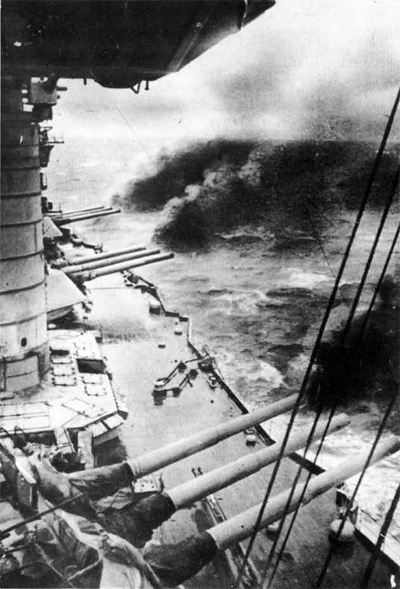
Three main battery triple turrets

OBB SEVASTOPOL

OBB SEVASTOPOL
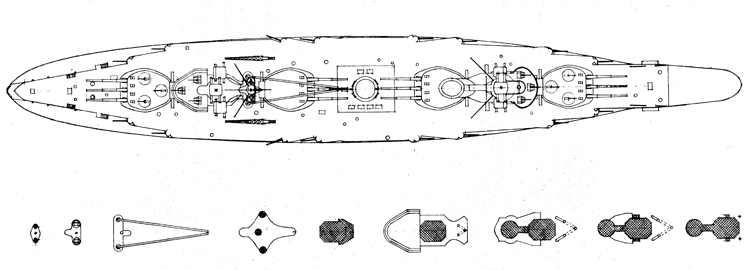
OBB SEVASTOPOL

Stern view, showing main and anti-aircraft batteries
OBB SEVASTOPOL
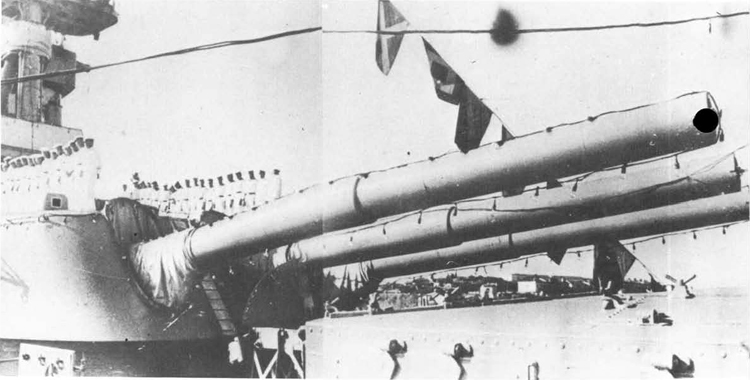
Main Battery Turret.
II. OVERAGE BATTLES!; IPS SEVASTOPOL CUSS (FETROPAVLOVSKj Ex MARAT, Ex PETROPAVLOVSK) (GANGUT, Ex OKTYABRSKAYA REVOLUTSIA. Ex GANGUT)
GENERAL.SPECIFICATIONS
Date laid down: 1909.
Date commissioned: January, 1914
Standard displacement: 23,000 tons.
Normal displacement, full load: 26,000 tons.
Length, O.A.: 619 feet.
Beam: 87 feet.
Mean draft: 27 1/2 feet.
Type of machinery: Parson's Turbines.
Horsepower: 50,000.
Number of propellors: 4
Type of boilers: Yarrow.
Number of boilers: 25.
Full speed: 23 knots with maximum radius, 990 miles.
Cruising speed: 16 knots with a cruising radius of 4>000 miles.
Aircraft normally carried: 1 on the Petropavlovsk; 2 on the Gangut.
Launching Device: 1 catapult.
Fire Control: director control.
Searchlights: 6.
ARMOR
Belt: 8 3/4" amidships; 5" to 2" ends; 4" to 3" internal belt.
Turrets 12" to 10"; 8-inch barbettes.
Decks: 3".
FG-towers: 10" forward.
Underwater protection: Additional conpartmentation of the underwater
bull upon refitting.
The belt is about 15 feet wide, 5 feet,of it below the water, of uniform thickness. There is a secondary 3" to 4" internal belt some 11 feet inboard above the protective deck, expending between- the end barbettes.
The space between the main belt and internal belt is divided up into watertight compartments. The watertight integrity has been considerably increased by the construction of a large number of watertight bulkheads, both longitudinal and athwartships, a double bottom and special torpedo bulkheads. No external anti-torpedo bulges appear to have been fitted.
ARMAMENT
12 12" 52 caliber guns with a maximum elevation of 30° to 40°, and a muzzle velocity of 3000 feet per second.
10 4.7" 50 caliber guns in casemates with a nuzzle velocity of 2600 feet per second.
,6 4»1" anti-aircraft guns.
3 3.9" anti-aircraft guns.
3 3" anti-aircraft guns with a nuzzle velocity of 2700 feet per second.
The port plates above each gun are in the form of hinged flaps, allowing each 12" gun to elevate up to 30° to 40°
maximum, arcs of fire: end triple 12" turrets-310°, central tur-rets-130° on each beam; after group of 4 4-7" guns, 90°; the other 4.7" guns, 850,
Number of Torpedo tubes:4 1$'carried below the waoerline.
GENERAL
These two units, together with the Sevastopol were laid dovm at the same time and were sister ships. The main differences between the Petropavlovsk and the Gangut were made during their refitting; the former was refilted during 1928-1931 and the latter during 1930-1933.
On the Petropavlovsk, the superstructure was developed to include a new foremast and bridge structure and added work above the after conning tower; on the Gangut, it was further developed to include fore and after fire control towers and bridge.
On the Petropavlovsk, the first funi:el was trunked aft, to help clear the bridge of fuel gasses; the forward stack of the Gangut was also trunked aft to clear the forward bridge structure of boiler gasses and a pair of heavy boat and plane handling cranes were added to the after superstructure.
As first completed, these units w=re most unhealthy and unsanitary and badly ventilated; these conditions largely remain today.
Since the outbreak of the Kusso-German war in June, 19-41, these two ships ha^-e be-n subjected to almost constant bombing by the enemy; it is probable that the Petrnpavlovsk which has been lying, in Kron3tadt harbor 3ince 1941» is, to all intents and purposes, sunk, and although it is claimed that her 12" batteries can still be used as shore installations, she has, to all intents and purposes, been sunk. The Gangut has also been extensively damaged by the most recent reports on her; in January, 194-3, it v/es stated that she was under repair in Leningrad Harbor.
OBB PETROPAVLOVSK
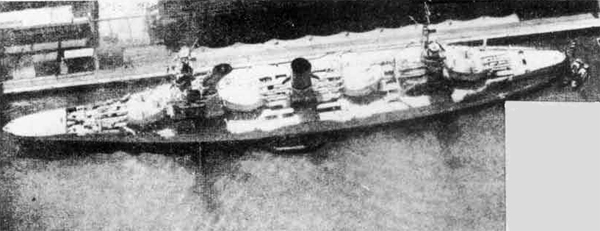
Aerial view.
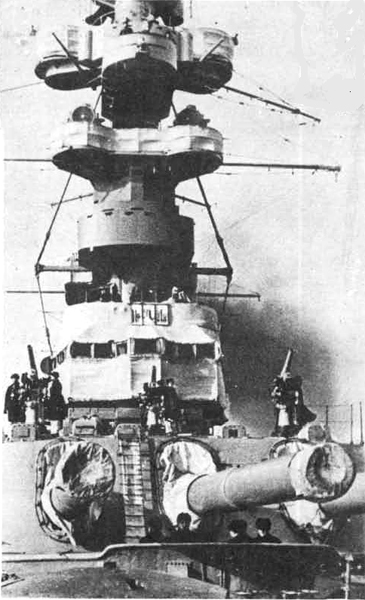
Foremast
OBB PETROPAVLOVSK

General view
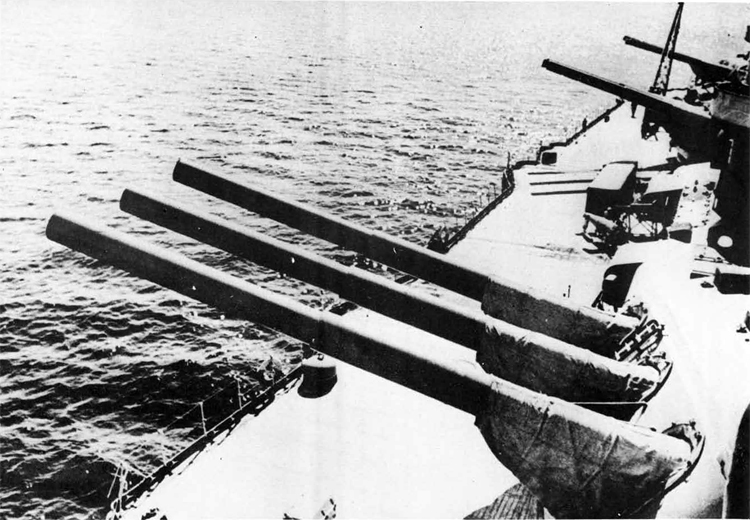
Three main battery triple turrets.
OBB GANGUT



Three main battery triple turrets.
B. CRUISERS
I. HEAVY CRUISERS (Kirov Class)
GENERAL SPECIFICATIONS
Dates laid down: 1935-1938.
Dates completed; 1937-1942.
Standard displacement: 8,000 tons.
Length: W.L. 613'6".
Beam: 57'11" .
Normal draft: 17'11"
Engines: Geared turbines.
Horsepower: 120,000.
Number of propellers: 2, three bladed.
Number of boilers: 6.
Number of fire rooms: " 2.
Maximum speed: 34 knots (designed).
Number of aircraft normally carried: 3.
Launching device: 1 catapult.
Fire control: director control.
Number of searchlights: 5, 36w in diameter. 3 forward 2 aft.
ARMOR
Turret: face about 2 3/4-"; top and sides about 1-3/4". Conning tower: 5 l/2"j four pieces of armor, formed by keys with entrance door aft.
Side: about 2 3/4n; belt about 10 feet wide, from forward side of number 1 turret to afterside of number 3 turret, riveted over shipfs skin.
Main deck: about 1/2" over engine room and boiler room areasj apparently ordinary plate,
ARMAMENT
9 7.1" 50 caliber in triple turrets, maximum range 40,000 yards. Weight of shell, 198 lbs. 6 4W anti-aircraft guns. 4 1.46n anti-aircraft guns. 9 Bofors type automatic guns. 2 Semi-automatic guns.
2 depth charge racks, one on each side of the fantail, hold an estimated total of 20 charges. They are simply inclined slots in the deck, several inches deep at the forward and about 2 feet deep at the after or dropping end, where they are rounded off. The fantail is cut square across and has a slight overhang.
The main batteries are in three triple turrets, two forward and one aft. Each turret is set in a single slide, making individual elevation of guns impossible, but plugging opening in front of turret (face plate), regardless of the angle of elevation. There is only one port opening for all three guns. The muzzles of the guns have a one inch collar screwed on the projecting end of the liner, the collar bearing against the end face of the outside tube. This is apparently to prevent the liner from backing up in the tube and to prevent closure of the plug. The entrance to the main turrets is in the back side. There are no bulkheads between the guns; the turret interior is bright and rough and uncluttered. At zero angle of elevation, gun breeches are about on a level with the deck in the after end of the turret. There is a power loading with loading gear following the guns to permit loading at any angle of elevation.
These units are fitted for minelaying; they normally carry 100 mines.
There are two depth charge rails.
The 6 4" anti-aircraft guns .are in single mountings, 3 to a side. As there is no place under cover'connected to the mine tracks, mine storage must be entirely on the tracks on deck.
There are 3 stereoscopic rangefinders in the Spotting Top, as well
as one to each High Altitude Director; each is 6 meters long.
There is a rangefinder 1 l/2 meters long to each group of 3 Bofors
guns.
6 21" torpedo tubes in triple mounts, placed between the stacks.
GENERAL
There is an after submarine lookout position built around the main
mast.
There is no actual lookout position for aircraft, but plenty of lookouts are spread around with glasses; they have no arcs from which to read off bearings and angles of sight, however. The catapult is underway between the break in the forecastle and the after deckhouse and stack.
There are no hangars for the aircraft. All three planes are very susceptible to damage from bomb fragments. One is placed on the catapult and one on each side of the forward funnel on platforms just before the catapult.
While in port, aircraft is usually not kept on board. There are no wooden decks on these units, but there is a great deal of nonrfire-propfed wood below decks and in tlie cabins. These'units are all riveted with the exception of very few plates on the deckhouse and on.the forecastle which are butt welded. Little light,metal is used in their construction with the exception of cabin doors and on some interior ladders.
They have a very roomy coni'iiELg tower,, with a number of 8 inch by 2 inch eye slits around the walls; the inside diameter of the conning tower is about 14- feet.
The officers1 country is amidships, from just abaft number 2 barbette to the break in the forecastle. The wardroom is first, extending across the ..shop and about 40 feet long. The frames for inside panelling are about 1 1/2 feet inboard from the skin of the ship. Offi- . cers! staterooms are outboard on both sides from the wardroom aft to the break in the forecastle; they are small, some single and some double. The captain's suite is on the boat deck, in a slight abaft position of the conning tower and surrounds the forward half of number one stack.
The space between the inner and outer shell of the stacks is about 10 inches, The metal of the; outer shell is exceptionally thin sheet. These cruisers are lightly built, but well laid out.
DISTINGUISHING FEATURES
2 widely separated broad raking stacks with sloping stack caps. The tower is set at the forward end of the bridge. The upright light tripod masts flank theCstacks; the main mast is heavier. The hull breaks abaft the first stack; it -has''%_ transom stern, and a
relatively long quarterdeck.
The main battery guns are mounted close together.
A French-type multiple rangefinder masthead director is mounted on
the Italian design tower.
Anti-aircraft rangefinders resemble the Kupola type rangefinder seen in large German warsnips with the exception that they have flat roofs.
The hull plating appears to follow French practices. The KIROV class heavy cruiser shows a resemblance to:
Improved Gordi (Soviet destroyer)
Emile Bertin (French light cruiser)
Le Fantasque class (French destroyer)
Narvik class (German deatroyer)
CA VOROSHILOV OR M0L0TOV - Anti-Aircraft Fire.
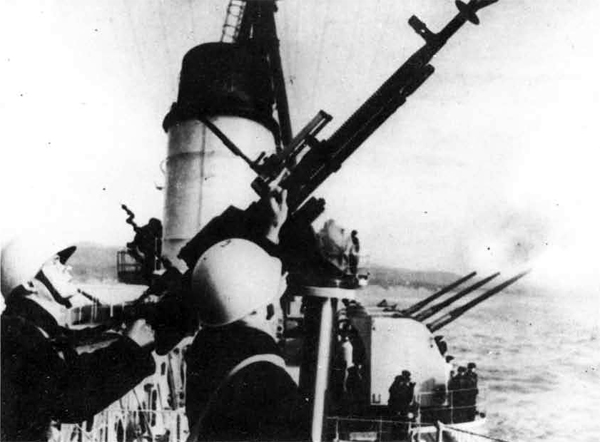
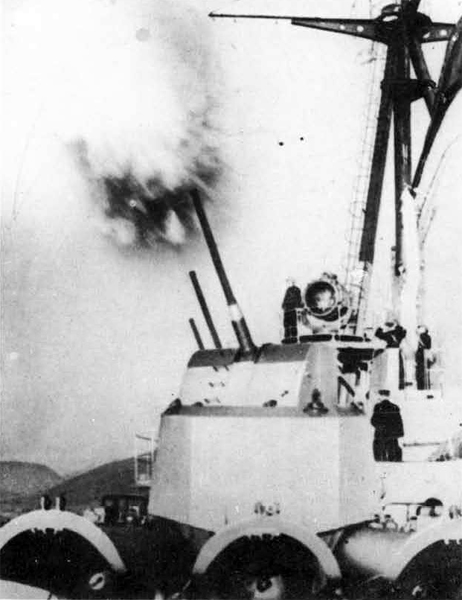
HEAVY CRUISERS (KIROV CLASS)

CA KALININ
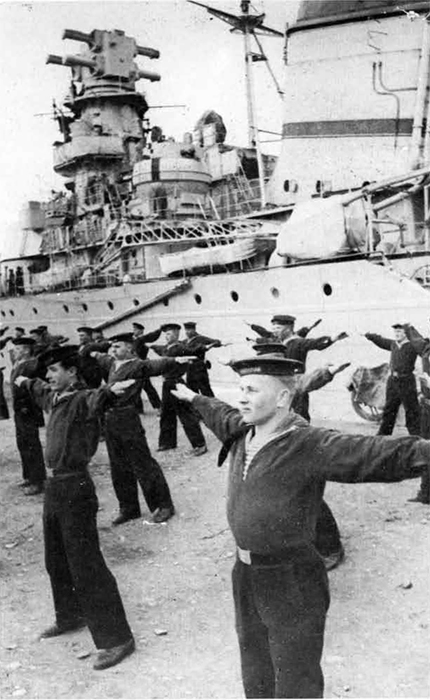
Closeup of tower on CA. M0L0T0V
HEAVY CRUISERS (KIROV CLASS)

Starboard view of CA MOLOTOV

Closeup of Main Battery AFT. of CA. KIROV
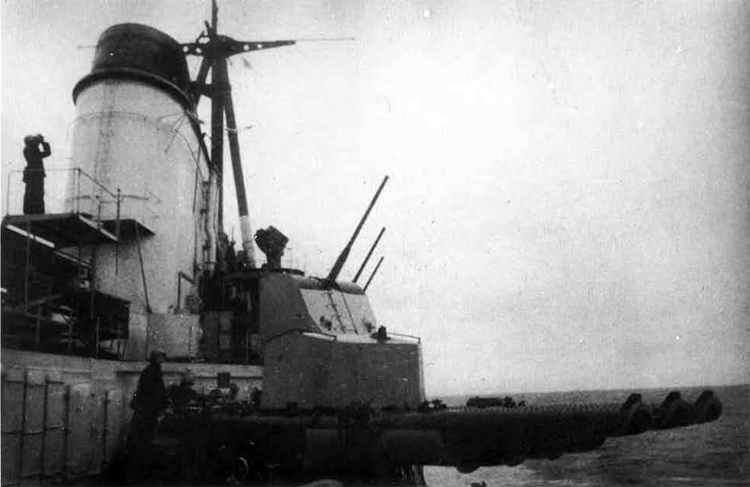
Starboard torpedo tubes of CA. VOROSHILOV or MOLOTOV

Closeup of British Vickers Machine Gun on CA. MOL0T0V
II. OCA KRASNY KAVKAZ
GENERAL SPECIFICATIONS
Date laid, down: 1914
Date commissioned: 1930.
Standard displacement; 8,000 tons.
Length, O.A.: 545 feet.
Beam: 52 feet.
Draft: 19 feet.
Type of machinery: Parson's Turbines.
Horsepower: 60,000.
Number of propellors: 4
'Type-of boilers: Yarrow.
Number of Boilers:- 13.
Full speed: 21 knots.
Cruising speed: 14 knots with a cruising radius of 3,700 miles.
Number of aircraft: 1 seaplane.
Launching Device: 1 catapult.
Number of searchlights: 5.
Fire Control: director control.
ARMOR
Waterline belt: 3"to 2".
Deck: 1".
Turret: 3".
Conning tower: 3".
The conning tower and gunhou.ses appear to have very light armor plating.
No waterline belt is visible, though the hull appears to be built of
thicker plating than'usually used in units of her type and dimensions.
ARMAMENT
4 7.1" 50 caliber guns with a maximum range of 40,000 yards, set in single
turrets.
4 3.5" anti-aircraft.guns (twins).
2 Vickers'anti-aircraft guns.
8 anti-aircraft machine guns.
12 21n torpedo tubes in triple turrets.
Fitted for minelaying normally carrying 200 mines.
Number of depth charge throwers: 4
Some doubt exists as to the effectiveness of the numerically'v/eak battery of this unit;.4 pieces seem hardly sufficient for modern sight control methods.
This unit was originally designed to mount a battery of 5^1<f guns. ^ She mounts an unusually heavy torpedo armament for a heavy cruiser.
GENERAL
The construction of this vessel was field up for many years; she was originally to have been a light cruiser of the same design as the . KRA3NY KRBI and the CHERVOMAIA UKRAJMA (since sunk).
As completed, her design was completely altered; her main battery of 4 7.1U guns places her in the category of heavy cruisers.
In 1934> she presented a considerable fire hazard because of so much wooden construction on board, such as: main deck planking, officers' country (all cabins are made of wood), sleeping accommodations for the crew which are of extremely wide-fixed bench construction all along the interior sides and in which are housed-boards, which pull out as do boards above top drawers of office desks. Both the benches and housed boards are of duckboard effect.
Men sleep athwartships.
The main radio room is on the main deck wrier the bridge; there are 3 smaller additional rooms extending to below ivaterline on the 3 decks and directly below the main radio shack.
DISTINGUISHING FEATURES
The upright thick stacks and multiple leg masks with masthead range finders.
The vertical outline of her mainmast is unique, as are the single gun turrets.
She resembles the iC-uSWY KRUi at angles off the bowj otherwise, she has a very distinctive profile.

Port View.
OCA KRASNY KAVKAZ

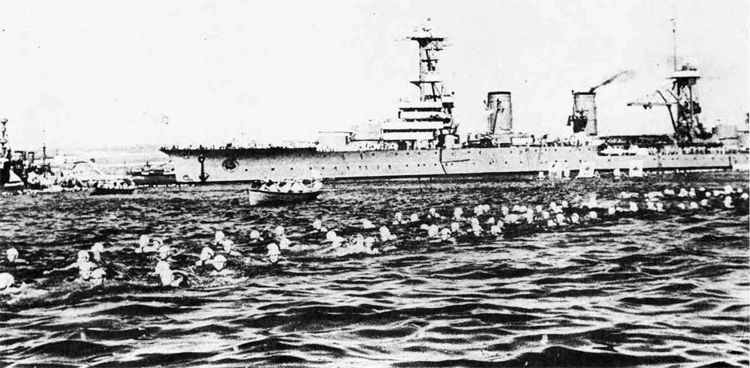
Starboard view.
Ill. OCL KRASNY KRIM (Ex PR0FINTERN)
GENERAL SPECIFICATIONS
Date laid down: 1913.
Date commissioned: January, 1925.
Standard displacement: 7,200 tons.
Normal displacement: 7,600 tons.
Length O.A.: 522 feet.
Beam: 54 feet.
Pvieah draft: 21 feet.
Type of machinery: Parson1s or Brown-Curtis Turbines.
Horsepower: 55,000.
Number of propellors: 4
Type of boilers: Yarrow.
Number of Boilers: 13.
Number of aircraft normally carried: 2 seaplanes.
Launching Device: Crane.
Fire Control: director control.
Number of searchlights: 7.
ARMOR
Waterline belt: 2".
Deck: 1 In.
Gun protection: 3"
Conning tower: 3"
This unit has been described as having-3ir armor for the full length under
the main and lower decks, but from inspection it appears that there is no
special side armor; apparently, the hull is built of thicker plating than
usually obtains in vessels of this type and dimensions.
ARMAMENT
11 5.1" 55 caliber guns in single mounts.
4 4.1" anti-aircraft guns in twin mounts.
7 3.5" anti-aircraft guns.
2 Vickers anti-aircraft guns.
6 anti-aircraft machine guns.
6 I8" torpedo tubes in triple turrets.
Fitted for minelaying, normally carrying 60 mines.
This unit may have been rearmed with 7.1" guns and new anti-aircraft
guns, but there is no confirmation of this fact.
GENERAL
This unit proceeded to the Black Sea in 1930 in company with the OBB SEVASTOPOL, staying for repairs at Brest and Naples, where it was reported that her condition'was very unsatisfactory and that only minor repairs would be undertaken.
Her present condition is-unknown, but she was refitted in 1937.
DISTINGUISHING FEATURES
She resembles the OCA KRASNY KAVKAZ; otherwise she has a very distinctive profile.
OCL KRASNY KRIM (Ex PROFINTERN)


OCL KRASNI KRIM (Ex PROFINTERN)
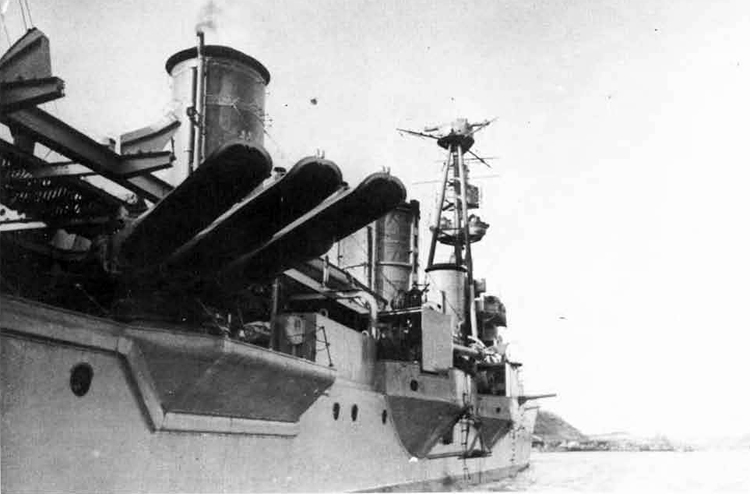
View of a torpedo tube mount.
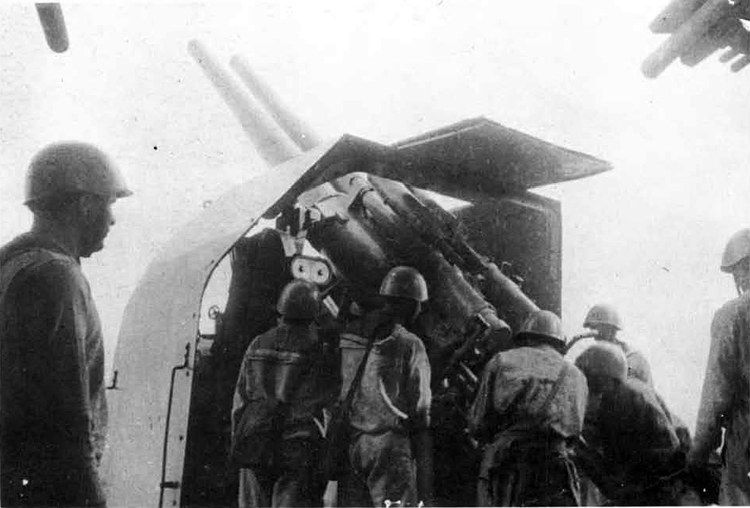
View of twin 4.1" anti-aircraft gun mount.
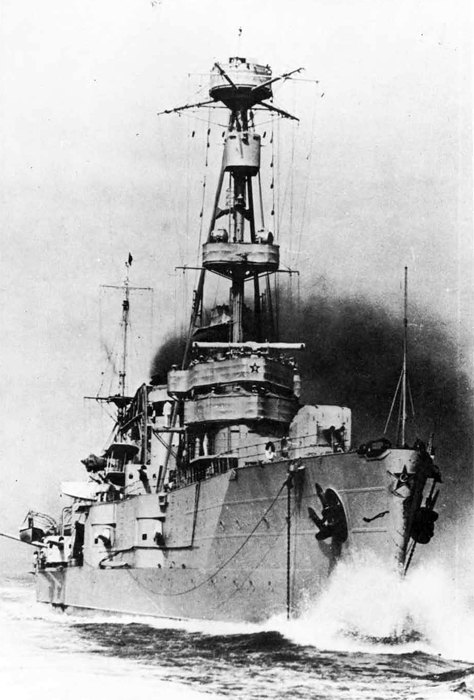
View of foremast of GHERVOMAYA UKRAINA, (KRASNY KRIM class, since sunk)
C. DESTROYERS
I. DESTROYER LEADERS (LENINGRAD CLASS)
GENERAL SPECIFICATIONS
Dates laid down: 1932-1939.
Dates completed: 1935-1942.
Standard displacement: 2,900 tons.
Length: W.L. 4001 3".
Beam: 38' 5".
Normal draft: 10' 10".
Type of machinery: Geared Turbines.
Horsepower: 6.2,000 (designed).
Type of Boilers: Water tube boilers, 3-drum type.
Pull speed: 38 knots (designed).
Fire control: director control.
ARMOR
There are weather shields attached to the guns. No side or deck armor has been reported.
ARMAMENT
5 5.1" 50 caliber guns in single shields.
2 .3" anti-aircraft guns.
2 1.46" anti-aircraft guns.
1 anti-aircraft multiple barrel machine gun.
6 21" torpedo tubes in triple mounts.
Fitted for minelaying, normally carrying 100 mines. 4 depth charge tracks, fitted with racks.
, iB 5.1" gun could have been mounted to greater advantage on the after deck house, just forward of ;jU gun.
There are super-firing single-shield mounts forward and aft with a fifth main battery gun mounted betv-.^n the bridge and forward stack. The center line triple torpedo tube mounts flank the after stack.
GENERAL
Compartmentation is believed to follow the modern practice for vessels of this type.
This class represents the first attempt of the U.S.8.R. in construction of larger warships.
They are reported to be poor seaboats—veiy top-heavy and wet forward.
DISTINGUISHING FEATURES
The design of this class reflects French influence; they resemble French contretorpilleurs of recent design.
2 separate tall raking stacks without stack caps; the first stack is broader and the second stack is slightly more raked.
There is a tall bridge and upright pole foremast stepped at the after edge of the bridge; an upright light tripod mainmast is set just forward of the after stack.
The spacing and shape of the stacks and of the bridge gives this class a very distinctive appearance.
DESTROYER LEADERS (LENINGRAD GLASS)

DL MOSKVA (since believed to have been sunk)

DI KHARKOV
DESTROYERS LEADERS (LENINGRAD CLASS)
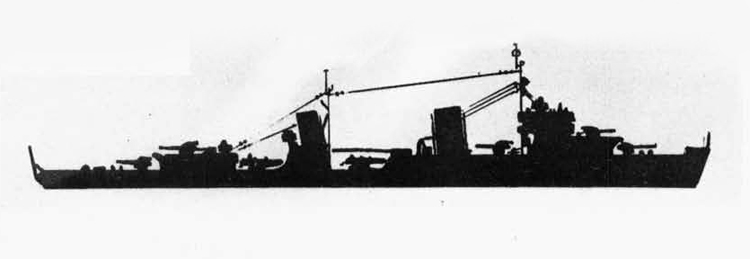
Silhouette of DL "TBILISSI".

DL MINSK (since sunk)
II. DESTROYERS (IMPROVED GORDY CLASS)
GENERAL SPECIFICATIONS
Dates completed: 1939-1941.
Standard displacement: about 1,800 tons.
Length O.A.: about 375 ftet.
Beam: about 35 feot.
Mean draft: about 12 feet.
Speed: 37 knots.
ARMAMENT
4. 5.1" guns in single shields.
2 3" anti-aircraft guns.
2 1.4.6" anti-aircraft yuns.
6 21" torpedo tubes, set in two triple mounts on the main deck.
Fitted for minelaying.
Super-firing gun positions are forward and aft.
GENERAL
Little infornation is available on this type.
They are indicative of the latest trend-in Soviet destroyer construction.
These units are of Italian design.
DISTINGUISHING FELATURES
Two separate raking, squat, flat-sided stacks with sloping stack caps.
A ranking pole mast is stepped just forward of each stack.
Super-firing gun positions are forward and aft.
There is a long bridge with a prominent director placed nenr the foremast.
Prominent deck houses are abaft the forward stack and forwai"d of the
after stack.
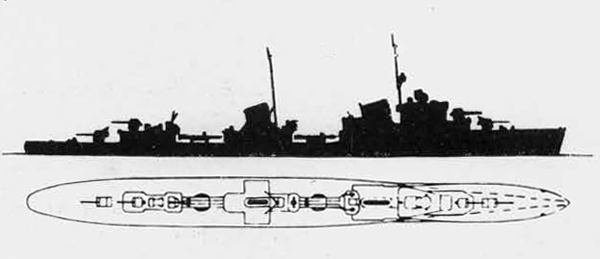
Silhouette of DD of the improved GORDY Class.

DD of the improved GORDY Class in the Black Sea.
III. DESTROYERS (MODIFICATION OF THE IMPROVED GORDY CLASS)
GENERAL
A modification of the Improved Gordi Class destroyer has been built; little or no information is available on this type.
It has been reported that only one unit of this class has been built; her location is not known.
DISTINGUISHING FEATURES
This type has only one shield gun mounted on the forecastle. The first stack is thinner than the second.

Silhouette of the modification of the DD of the improved GORDY Glass.
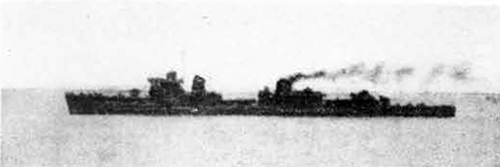
Modification of a DD of the improved GORDY Class.
IV. DESTROYERS (GORDY CLASS)
GENERAL SPECIFICATIONS
Dates laid down: 1937-1940.
Dates completed: 1938-1941.
Standard displacement: 1600 tons.
Length: O.A. 375', W.L. 364'.
Beam: 33' 6".
Normal draft: 9'7".
Type of machinery: Geared Turbines
Horserpower: 4.6,000 (designed) .
Type of boilers: 3-cirum tnie.
Number of boiler roons: 3
iJumber of firo rooms: 2.
Full speed: 37 knots.
ARMAMENT
4- 5.1" 52 caliber guns with a maximum elevation of 4-5 and a maximum
range of 26,000 yards.
2 3" anti-aircraft guns with a maximum elevation of 85° and a maximum
range of 4.500 yards.
2 1.46" anti-aircraft guns.
2 Bofors type guns.
6 21" Torpedo tubes, in two triple mounts.
These units are equipped for minelaying, usually carrying 100 mines.
Depth charges are fir^d only froir. a trap; there are no throwers. The
charges are set to "safe" until the actual subnarine report is received.
A super-firing shield runs forward and aft.
On the units observed, the armament was very well kept.
GENERAL
Air lookout is of a very high standard. Everybody on deck acts as a
lookout.
Using all the boilers, the maximum speed is 37 knots; using two, it is
about 28 knots.
One unit of this class I'q said to lave re-ached 40.2 knots on trials.
These vessels are very maneuverable anil-although the hulls are lightly
built, they stand up well to their own gunfire.
There is no splinter protection anywhere.
There are no rcidio direction finders.
These vessels are said to be much better seaboats than the LENINGRAD
class destroyer leaders; they are of Odero-Terni-Orlando (Italian)
design.
DISTINGUISHING FEATURES
A single broad raking stuck with a sloping stack cap, placed close abaft
the bridge.
2 raking pole masts.
There is a proi.inent director on the bridge.
There is a wide transom stern.
These u,iits are similar in appearance to: "0" to "T" classes (British destroyers); T-l class (German torpedo boat); Grecale class (Italian destroyer). They bear a resemblance to the Li. S. destroyer escort series.

A Gordy Class DD underway in the Black dea.

GORDY CLASS

Silhouette of DD RIYANY.
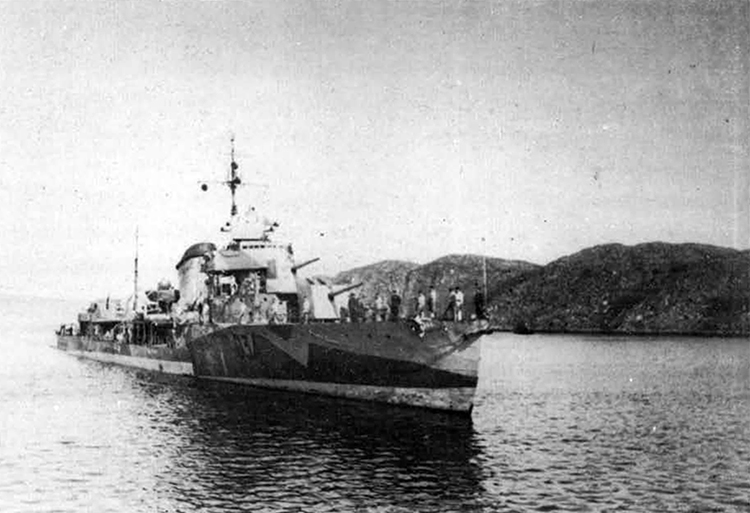
A DD of the Gordy Class, attached to the Northern Fleet.
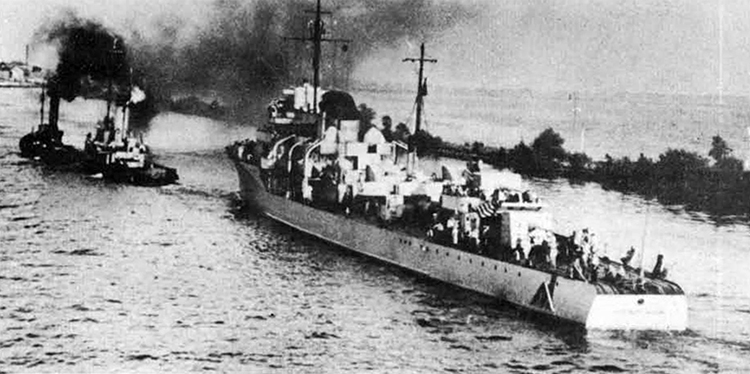
DD STREMITELNY
DESTROYERS (GORDY CLASS)

DD BESPOSHCHADNY

Forward gun mounts on the DD SOOBRAZITELNY
DESTROYERS (GORDY CLASS)

Streaming a paravane aboard the DD BOIKI

DD BOIKI
V. OVERAGE DESTROYERS (PETRQVSKI GLASS)
GENERAL SPECIFICATIONS
Date laid down: 1916.
Dates commissioneds 1917-1928.
Normal displacement: 1,300 tons.
Length O.A.: 303 feet.
Beam: 30 feet.
Mean draft: 10 feet.
Type of machinery: Parson's Turbines.
Designed horsepower: 29,000.
Number of propellors: 2.
Type of boilers: Thornycroft.
Number of boilers: 5
Pull speed: 28 knots with a maximum radius of 720 miles.
Cruising speed: 22 knots with cruising radius of 3,100 miles.
Number of searchlights: 2.
ARMAMENT
4 3.9" guns.
2 7 pounder high altitude guns.
1 1.46" anti-aircraft gun.
4 machine guns.
12 18" torpedo tubes, set in four triple cent€:rline mounts, one between
the first stack and foremast and one behind each stack.
Fitted for minelaying. '
Number of mines usually carried: 50.
One open mount gun is placed on the short forecastle; two are placed on
the quarterdeck; and the fourth is placed on the afterdeck house in a
super-firing position.
GENERAL
Although this class represents the most powerful class of destroyer built under the imperial regime, their present efficiency is doubtful.
None of these units have even approached the designed speed of 33 knots under the Soviet flag.
The "Felix Dzherzhinski"was sunk during the Russian Revolution, but was raised in 1925 and refitted in 1928-29.
DISTINGUISHING FEATURES
Three evenly spaced low raking stacks, with slanting tops.
Two raking pole masts.
Deck house between second and third stacks extends outboard flush with
ship's sides.
Triple torpedo tube centerline mounts flank the first stack.
These units have a very distinctive profile; they are very similar to
the URITSKI Class.
OVERAGE DESTROYERS (PETROVSKI CLASS)

ODD of the PETROVSKI Class.

ODD SHAUMYAN
OVERAGE DESTROYERS (PETROVSKI CLASS)
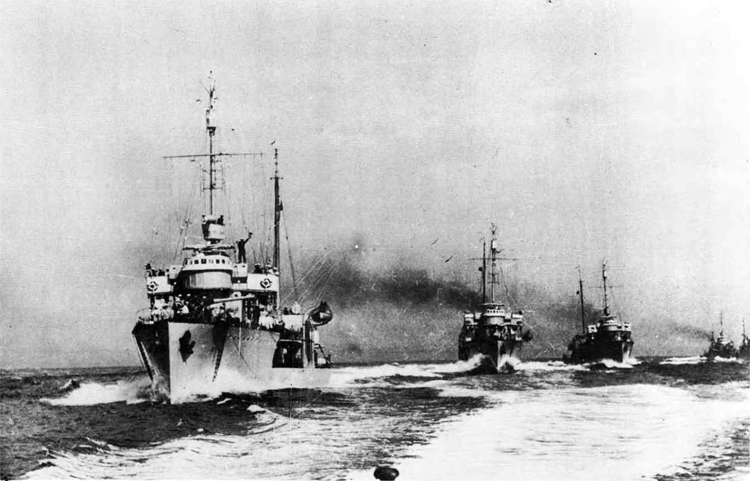
ODDs of the PETROVSKI Class underway.
VI. OVERAGE DESTROYERS (URITSKI CLASS)
GENERAL SPECIFICATIONS
Date laid down: 1913. Dates co; Dieted: 1915-1917. Normal displacements 1,280 tons. .. Length O.A.: 321 feet. ' Beam: 31 feet. Maximum draft: 10 feet. Type of machinery: AEG/Vulcan Turbines. Horsepower: 30,000 (designed).
Number of propellors: 2
Type of boilers: Thornycroft.
Number of boilers: 4. Pull speed: 28 knots.
Cruising speed: 15 knots with a cruising radius of 700 miles. Economic speed: 10 knots with a radius of 2,800 miles. Number of aircraft normally carried: 1 seaplane. Number of searchlights: 2.
ARMAMENT
4 3.9" guns with a maximum range of 16,000 yards.
2 3" 23 caliber high-altitude guns.
2 machine guns.
9 18" torpedo tubes, set in three triple centerline mounts, one behind
each stack.
Fitted for rninelaying.
Number of mines normallHy carried: 50-80.
One open gunmount is placed on the short forecastle and three aft.
Battery control is apparently local.
Torpedo control is elemental, similar to that on old U. S. Iowa's.
These units are equipped with electric heating apparatus for torpedoes,
to prevent their freezing in the water.
GENERAL
These units were designed in Germany, built in Leningrad.
The STALIN has been reconstructed and differs from the rest of this
class in appearance.
In August, 1943, the U. S. Naval Attache, Moscow, visited one of these
units which was attached to the Northern Fleet; he found her to be in
good condition and clean, especially as regards to essentials such as
care in painting around moving parts.
DISTINGUISHING FEATURES
The spacing of the 3 stacks and the superstructure give this class a
distinctive appearance.
The stacks are spaced unevenly and are low' raking with slanting tops.
There are two raking pole masts.
The deck house between the second and third stacks extends outboard
flush with ship's sides.
These units differ chiefly from the PETROVSKI Class in that they lack a
torpedo tube mount between the first stack and foremast and lack a
super-firing gun aft.
OVERAGE DESTROYERS (URITSKI CLASS)

Silhouette of ODD STALIN.
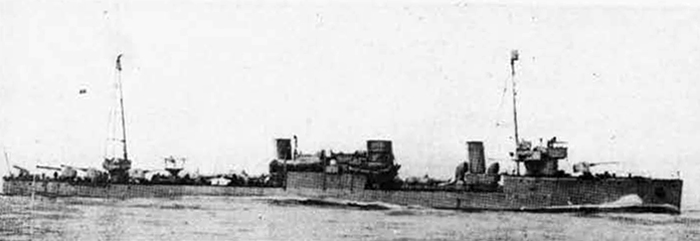
ODD Ex RYKOV

ODD ENGELS
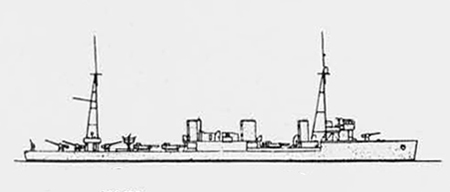
Silhouette of ODD KARL LIBKNECHT.
VII.OVERAGE DESTROYERS (YAKOV SVERDLOV)
GENERAL SPECIFICATIONS
Date completed: 1915.
Standard displacement: 1,200 tons.
Normal displacement: 1,320 tons.
Length 0.A.: 336 feet.
Beam: 31 feet.
Maximum draft: 10 feet.
Type of machinery: Vulcan Turbines (AEG type)
Horsepower: 33,000 (designed).
Number of propellors: 3.
Type of boilers: Vulcan.
Number of boilers: 6.
Full speed: 28 knots.
Cruising speed: 21 knots with a cruising radius of 2,000 miles.
Number of searchlights: 2.
ARMAMENT
4 3.9" guns with a maximum range of 16,000 yards. 1 3".23. caliber high-altitude gun.
1 1.4-6" anti-aircraft gun.
2 machine guns.
Fitted for minelaying.
9 18" torpedo tubes, set in three triple centerline mounts. Number of mines normally carried: 80.
GENERAL
In 1915 on trials she made 35.7 knots.
She ms built for and served in the former Imperial Russian Navy as the NOVIK.
Her design and original propelling plant was furnished by the Vulcan Yard, Stettin, Germany. Funds for her construction were raised by popular subscription; she was known as the best destroyer of her day. She was rebuilt and rearmed in 1931. Recent alterations include enlarged bridge, tripod foremast, extended forecastle and alteration in the position of the after superstructure and the mainmast. She is reported as being employed on cruiser duties.
DISTINGUISHING FEATURES
She has 4 stacks.
There is an absence of the amidships deckhouse.
Except for the above differences, she is similar to the PETROVSKI
and URITSKI Classes.
OVERAGE DESTROYER {YAKOB SVERDLOV)
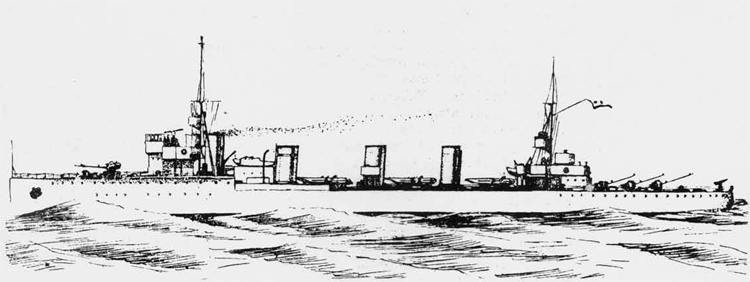
OVERAGE DESTROYS YAKOB SVERDLOV
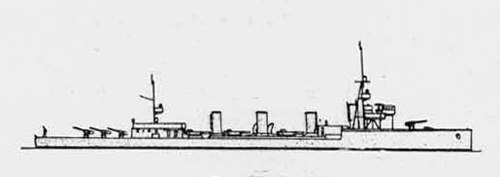
Silhouette of Overage Destroyer YAKOB SVERDLOV

Overage Destroyer YAKOB SVERDLOV
D. ESCORT VESSELS AND TORPEDO BOATS
I. ESCORT VESSELS (ALBATROSS CLASS)
GENERAL SPECIFICATIONS
Length: About 275 feet.
Beam: About 25 feet.
Displacement, full load: About 800 tons.
Number of boilers: 2.
Steam pressure: About 25 atmospheres.
Type of engines: Turbines, main propulsion.
Speed: About 26 knots.
Machinery arrangement: Boiler-engineroom-boiler.
AMOR
Hull plating 4 mm. (unconfirmed).
ARMAMENT
No information available; at least one gun on forecastle.
GENERAL
Little information is available on this class. Two units are under construction at Komsomolsk, having been laid down there in 1940; one is 35% complete, the other about 50$ complete. They may be an improved design of the Shtorm Class torpedo boats (see next page). There is no light metal; or galvanizing.
These units are all riveted; there is no welding except on a few interior non-strength bulkheads.
Rubber and cotton covered electric cable is used inside, reportedly due to a lack of armored or lead covered cable.
DISTINGUISHING FEATURES
In appearance and eventual employment, this class is very similar
to new U.S. destroyer escorts.
They have a flush deck.
They have two strongly raked stacks with the deckhouse abaft number
2 stack.
II. TORPEDO BOATS (SHTORM CLASS)
GENERAL SPECIFICATIONS
Dates completed: 1932-1939.
Normal displacement: 800 tons.
Length O.A.: 251 feet.
Beam: 24 feet.
Liaximum draft: 10 feet.
Type of machinery: Geared Turbines.
Horsepower: 13>2OO.
Number of propellers: 2.
Full speed: 25 knots (designed).
Minimum speed on trial: 21 knots.
ijumber of searchlights: 2.
ARMAMENT
2 4" 53 caliber guns.
3 3" 55 caliber high altitude guna with a maximum range of 27,000 yards.
These boats are excessively armed for their size; a U.S. iJaval officer
describes them as being "but floating turrets".
3 18" torpedo tubes, centerlined in a triple mount.
4 depth charge tracks.
GENERAL
They are reported as being poorly constructed and to roll heavily, owing to'excessive top hampers.
They represent the first attempt of the U.S.S.R. at surface craft construction.
DISTINGUISHING FEATURES
There are 2 separate low stacks; the forward stack is higher and placed
near the break in the forecastle deck.
There are 2 raking pole masts; the main mast is stepped on the small
deck house abaft the second stack.
These boats have a distinctive profile.

Torpedo Boat of the Shtorm Class.
TORPEDO BOATS (SKTOHM CLASS)

Silhouette of the TB VIYUGA.
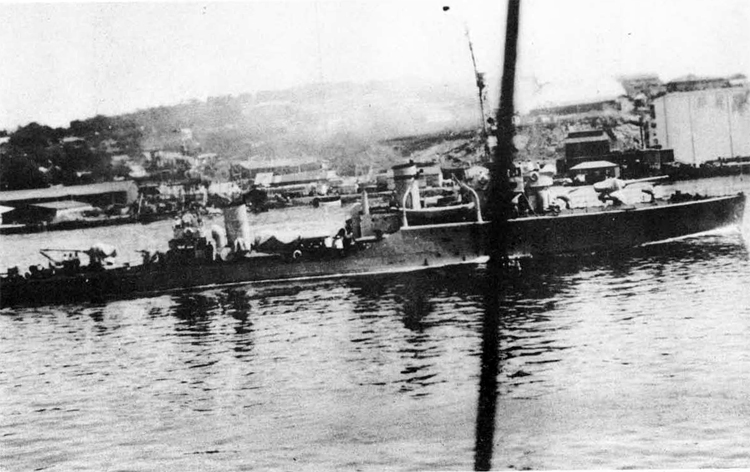
TB of the SHTORM Class in VLADIVOSTOK Harbor in 1938.
III. TORPEDO B0ATS (MATROS CLASS)
GENERAL SPECIFICATIONS
Dates completed: 1938-1939.
Normal displacement: 570 tons.
Length O.A.s 236 feet.
Beam: 23' 6".
Maximum draft! S1.
Horsepower: 6,500,
Full speed: .25 knots (designed).
Cruising speed: 15,.knots with a cru-ising radius of 500 miles.
Economic speed: 10 knots with a radius of 1,980 miles.
ARMAMENT
2 A" guns.
1 1 pounder gun.
I machine guns.
1 13" Torpedo Tube.
Fitted for minelaying, normally carrying 25 mines.
GENERAL
These units are actually small torpedo boats, but are used variously as patrol, escort vessels, minelayers, and minesweepers0 There are believed to be several variations of this class.
DISTINGUISHING FEATURES
They have one low raking stack amidships and 2 raking pole masts (the rig varies in individual units). They have a short forecastle. A A long low main deck. An overhanging squared off stern.
They have a very distinctive profile, presenting a very low silhouette with a notable absence of top hamper.

Patrol vessel of MATROS class
TORPEDO BOATS (MATROS CLASS)

Silhouette of Patrol Vessel STRELA

Patrol Vessels, - PROVODNIK in the foreground and STRELA in the background.
IV. MOTOR TORPEDO BOAT
The bulk of the earlier models of Soviet motor torpedo boats appear to be a modification of since discarded Thornycroft designs. Torpedoes are launched through a trough in the stern. Their standard displacement ranges from 6 to 35 tons; they have a length overall of from 25 to 45 feet, and a beam of from 8 to 12 feet. They cany 1 to 3 13" torpedo tubes and 1 or 2 machine guns.
The U.S.S.R. is beginning to acquire a considerable number of U.S. motor torpedo boats under Lend-Lease; so far, they have received some Higgins and Vosper boats.
The general description of one of the more modern Soviet type PT's is as follows:
This class is a V-bottom Sharpy type. The propellers have open strut mountings. The length of the boat is 68 feet, beam 12 feet, draft 3 feet. Displacement is 33.6 tons, while the dead weight of hull and machinery is 30.8 tons. 3 engines are normally installed on this class. Their speed at 2,000 r.p.m. is about 45 miles an hour. A fourth motor is being supplied by the Packard Motor Company and other U.S. manufacturers under Lend-Lease.
MOTOR TORPEDO BOATS
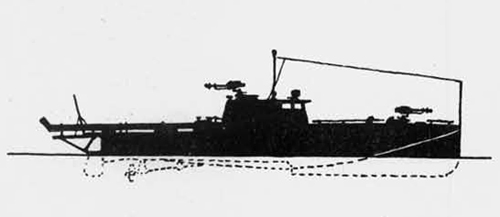
G-5 Type (Pacific Fleet)

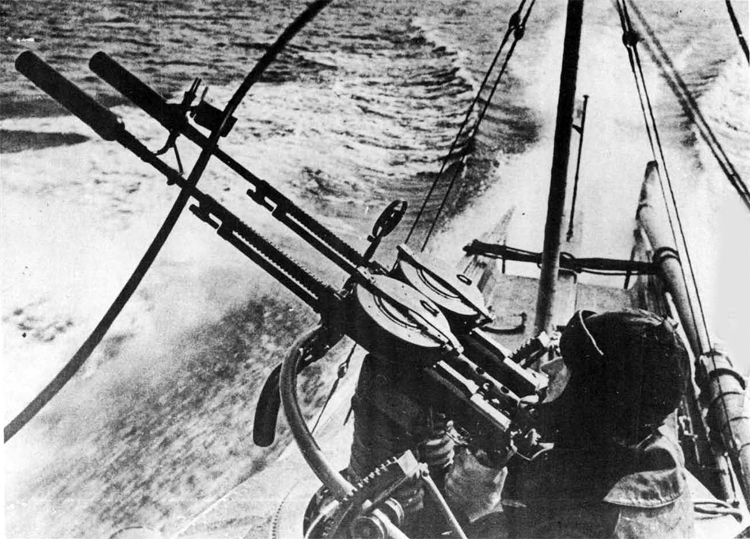
Anti-Aircraft Gun on a Motor Torpedo Boat.
E. SUBMARINES
Although the USSR has built 7-8 distinct classes of submarines, they are not easily distinguishable, h.s it has been a practice ±n Soviet submarine construction to vary these classes to such a degree that often one class, even upon close observation, can easily be mistaken for another, and, in fact, one may be almost identical to another.
I. SUBMARINES ("K". IMPROVED PRAVDA CLASS and "P". PRAVDA CLASS)
GENERAL SPECIFICATIONS
Date commissioned: 1935-1941.
Standard surface displacement: 1,500 tons.
Normal submerged displacement: 1,600 tons.
Length, W.L.: 282 feet 2 inches.
Beam: 22 feet 2 inches.
Normal surface draft: 11 feet 11 inches.
Full surface speed: 18 knoLa.
Full submerged speed: 8.5 knots.
Cruising surface speed: 9 knots with a cruising radius of 7000miles.
Cruising submerged speed: 5 knots, t/ith a cruising radius of 125 miles.
Horsepower: 4,200 (designed).
ARMAMENT
2 4.1" guns with a maximum range of 18,000 yards.
2 1.46" anti-aircraft guns.
2 machine guns. (?)
8 or 10 21" torpedo tubes.
Fitted for minelaying.
Number of mines normally carried: 18.(?)
GENERAL
They are the largest submarines yet designed and constructed under the
Soviet regime.
From exterior appearances and design, they show Italian influence.
The chief difference between the K and P classes is in the shape of the
conning tower; there are possibly other variations in dimensions and
armament. The tonnage of the K class may be slightly higher than that
of the P class.
They are said to be quite a successful tvpe of boat, capable of rapid
diving.
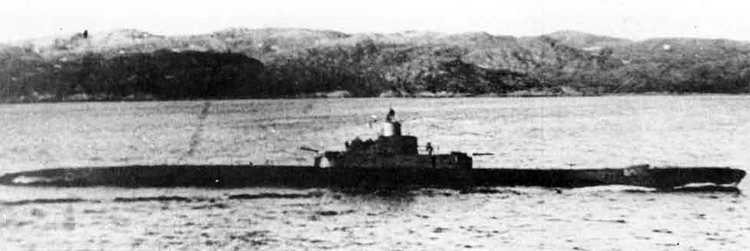
"K" Class submarine.
SUBMARINES ("K", IMPROVED PRAVDA CLASS and "P", FKAVDA CLASS)

"P" Class submarine

"K" Class submarine (?) attached to the Northern Fleet.
SUBMARINES "K" CLASS
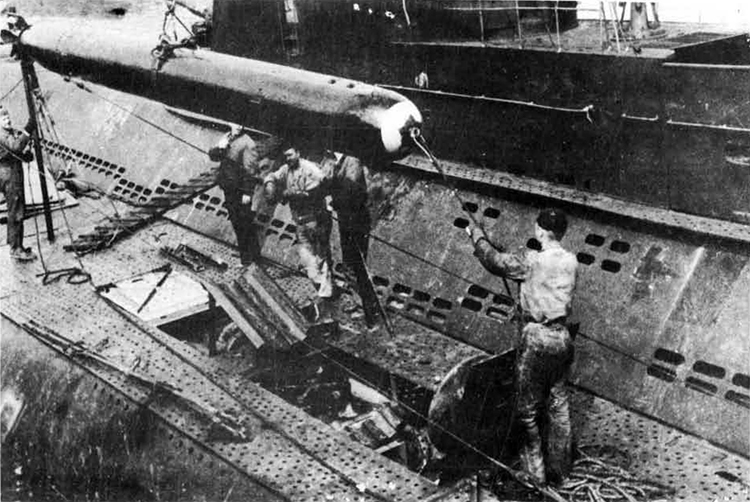
Loading a torpedo on a K (?) Class submarine.
II. SUBMARINES ("L". LINEINAYA LODKA CLAS3)
GENERAL SPECIFICATIONS
Dates commissioned: 1932-1941.
Normal surface displacement: 1,300 tons.
Normal submerged displacement: 1,500 tons.
Length O.A.: 266 feet.
Beam: 24 feet.
Normal surface draft: 13 feet 9 inches.
Type of engines: similar to liAN.
Number of engines: 2.
Type of motors: double armature.
Number of motors: 2.
Type of storage batteries: Triton.
Full surface speed: 15 knots.
Full submerged speed: 8 knots.
Cruising surface speed: 10 knots, with a cruising radius of about
5,500 miles.
Economic surface speed: 8.9 knots.
Economic submerged speed: 5 knots, with a cruising radius of about
110 miles.
Minimum tijne to submerge from normal cruising: 35-45 seconds.
They are of double hull construction.
ARMAMENT
1 4" 53 caliber gun, placed forward of conning tower.
1 50 caliber gun, placed on deck forward.
1 1.46" anti-aircraft gun placed on conning tower superstructure, aft.
8 21" torpedo tubes, six in the bow and two in the stern.
20 torpedoes are normally carried: the spares are stored forward.
Fitted for nn.nelaying, having two stern nine tubes; nine large mifles
or 14. small ones can be carried in each tube.
The U " gun is of light construction, with a sliding breach plug made
watertight by fit of plug; it trains 360° and is very smooth and rapid
in train and elevation.
GENERAL
The sanitary conditions are usually poor.
The general arrangement of this class forward to aft is as follows:
Torpedo tube room.
Torpedo storage and bunk room.
Wardroom and battery room.
Control room.
After battery and bunk room.
Engine room.
Motor room.
SUBMARINES "L" CLASS
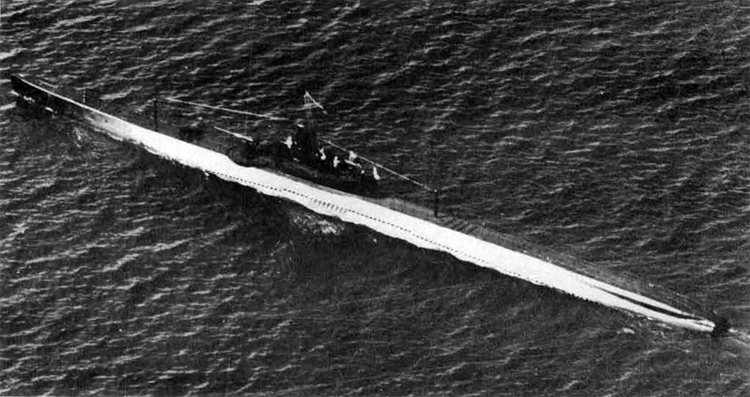
"L" Class.
SUBMARINES »L« CLASS
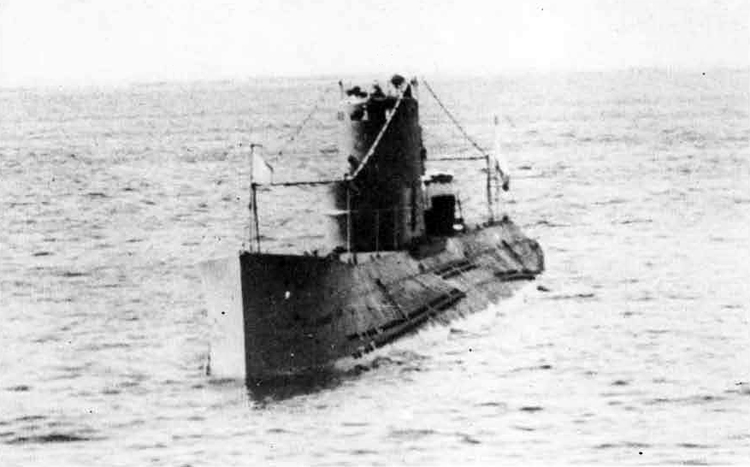
"L-II" Glass
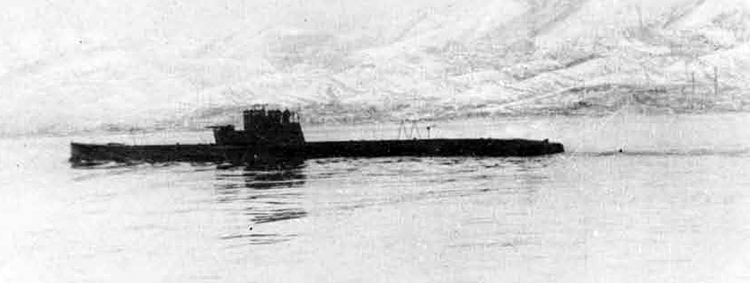
"L-II" Class.
SUBMARINES "L" Class

L-8" Class.
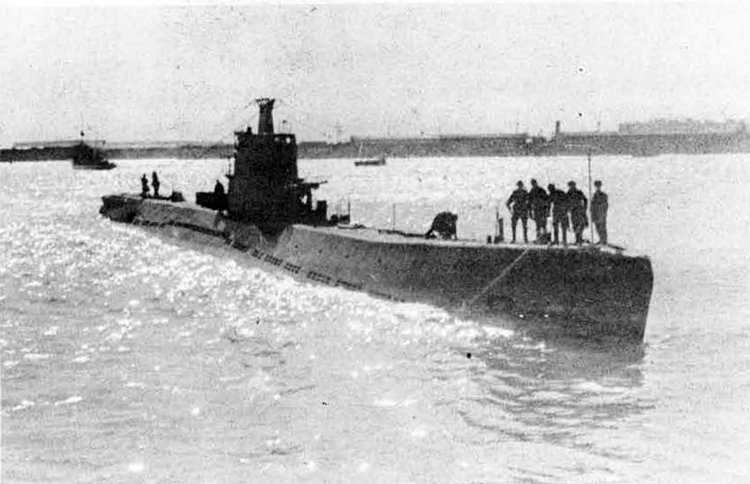
"L-XIII" Class.

"L-14" Class.
SUBMARINES "L» CLASS
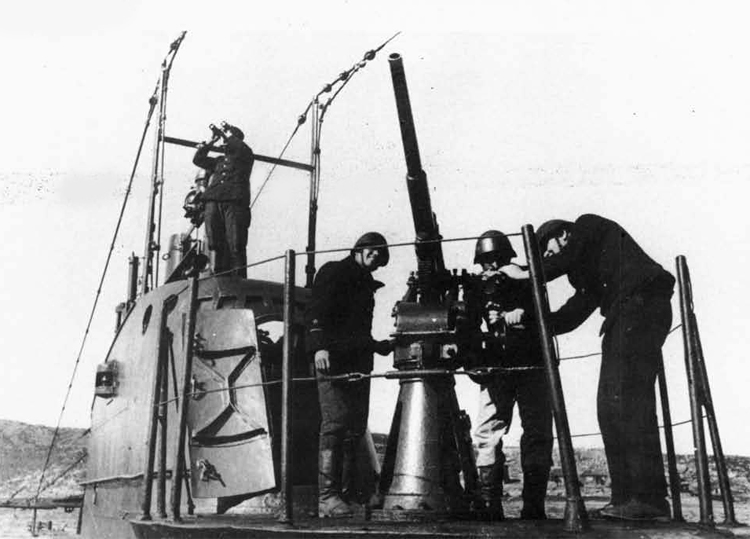
Conning tower of a "L" (?) Glass submarine.
III. SUBMARINES ("D". DEKABRIST CLASS)
GENERAL SPECIFICATIONS
Dates commissioned: 1927-1934-
Normal surface displacement: 920 tons.
Normal submerged displacement: 1,150 tons.
Length O.A.: 241 feet 2 inches.
Beam: 24 feet.
Normal surface draft: 14 feet 1 inch.
Type of engines: Kolomna 6 cylinder, 4 stroke.
Horsepower; about 2,650.
Number of storage batteries: 4 with 56 cells each.
Full surface speed: 15 knots.
Full submerged speed: 8 knots.
Cruising surface speed: 12 knots.
liconomic surface speed; 8 knots (1 engine), with a cruising radiua of
about 5000 miles.
Economic submerged speed: 5 knots with a cruising radius of LID miles.
Number of periscopes: 2.
They are of double hull construction.
ARMAMENT
1 4" gun, placed ibrward of the conning tower on a level with the upper deck, but with a shield built around it.
1 1.46" anti-aircraft gun, placed on the after end of the bridge. 8 21" torpedo tubes, 6 in the bow and 2 in the stern.
10 torpedoes are normally carried there are no reloads for tho MM stern tubee. Torpedoes are usually fired In salvos of three.
GENERAL
Only a very small amount of fuel oil is carried, 30 tons under the batteries; about 100 tons additional can be carried in two external M.B. tanks.
These boats are under batteried; they have insufficient HP air compressor power. All in all, they are not a very popular type of boat.
SUBMARINES ("D", DEKABRIST CLASS)


SUBMARINES ("D», DEKABRIST GLASS)

IV. SUBMARINES ("S" 5TALINET5 CLASS)
GENERAL SPECIFICATIONS
Dates conpleted: 1940-1941
Normal surface displacement: 750 tons.
Normal submerged displacement: 1,000 tons.
Length, O.A.: 255', W.L.248'10".
Beam: 15' inside, 181 outside.
Normal surface draft: 12'6".
Normal submerged draft with periscope showing: 48'6".
Type of engines: Diesel Kolomna.
number of engines: 2.
Number of storage batteries: A3.
Full surface speed: 22 knots.
Full submerged speed: 9 knots, with a radius of 108 milts.
Cruising surface speed: 16 knots, with a cruising range of 16,000 miles.
Economic surface speed: 11 1/2 knots, with a radius of 9,000 miles.
Economic submerged speed: 3-4 knots.
Number of periscopes: 2 - the periscope is 36' above the deck when
extended. They are about 20" long, and have a diameter of 0".
Type of radio transmitters: Master Oscillator, Intermediate Amplifier,
and Power Amplifier type.
Engine speed:. 300-550 R.P.li.
Shortest time to submerge from normal cruising: 40-50 second.
The test depth is about 300 feet, although guage shows 480 feet.
No hydraulic systems are fitted.
ARMAMENT
1 4" 53 cal. gun forward of the conning tower on deck; it has a maximum elevation of 75°. 1 4-5 mm. High Altitude gun located on the cigarette deck.
6 21" torpedo tubes, 4 in the bow and 2 in the stern; a total of 6
spare torpedoes are noii/iflK^^pr ed aft and forward.
Torpedo tubes appear to be mads if ,steel, with one riveted seam;
the inside finish is rough and painted. ,
Torpedoes have a maximum speed of 36 knots.
These boats are not equipped to lay mines.
GENERAL
They have simple, easily understood operational characteristics— are fully capable of keeping the sea and fighting well. The ventilation below decks is very poor; there is no air conditioning. The general arrangement forward to aft is as follows:
Torpedo tube and bunk room. Galley.
Battery room and officers1 quarters. Engine Room.
Control Room. Motor Room.
Officers quarters and wardroom. Torpedo tube and bunk room.
DISTIHGU1SHIMG FEATURES
These boats are dark green in color.
The bridge and conning tower are very small, and the decks have
freedom from obstruction.
The overall silhouette is considered excellent.
SUBMARINES ("S" CLASS)

"S" Class.

"S" Class.
SUBMARINES ("S" CLASS)
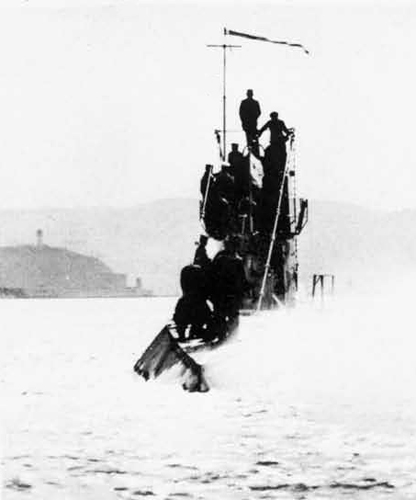
"S" Class (Stern View).
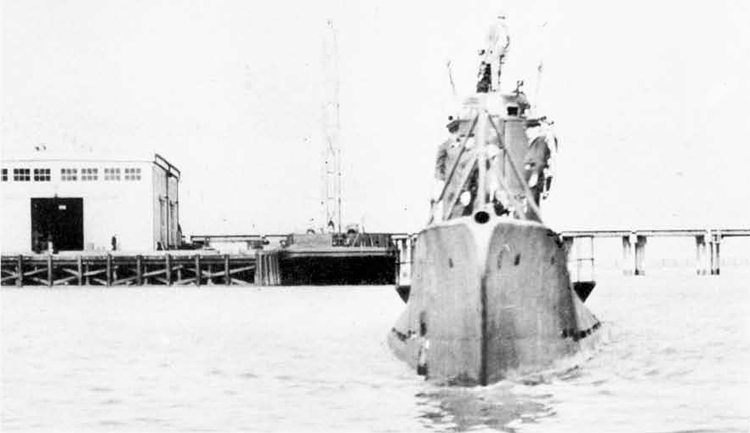
"S" Class (Bow View).
V. SUBMARHiES ("SCHCH" SCHCHUKA GLASS)
GENERAL SPECIFICATIONS
Dates completed: 1934-1937.
Normal surface displacement: 660 tons.
Normal submerged displacement: 820 tons.
Length O.A.: 200 to 225'.
Normal surface draft: 12'10".
Type of enginesi Diesel, Kolomna.
Full surface speed: 14 knots.
Full submerged speed: 8 l/2 (designed).
Cruising surface speed: 10 knots with an approximate cruising radius
of 5,000 miles.
Economic surface speed: 8 knots with one engine.
Economic submerged speed: 5 knots with a cruising radius of 80 miles.
Minimum time to submerge from normal cruising: 55 seconds to 1 minute.
ARMAMENT
2 4.5 mm. guns, one raised forward of the conning tower, and the other
on casing abaft the conning tower.
6 21" torpedo tubes, 4 in the bow and 2 in the stern.
A total of 10 torpedoes are usually carded, including 4 spares.
Bow torpedoes can be only fired two at a time (#1 and HU, or #2 and #3)
GENERAL
These boats are generally popular—are easily handled even in rough seas, but are apt to be a little lively on the surface.
SUBMARINES "SGHCH" CLASS
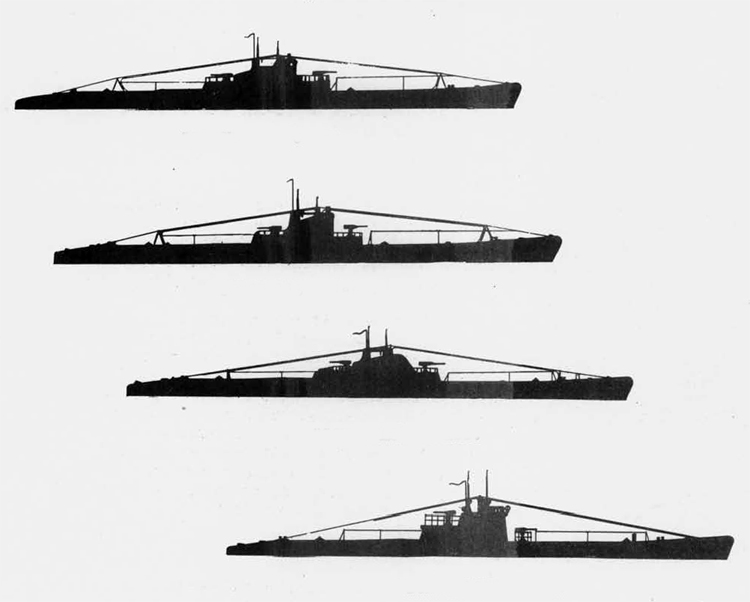
SCHCH-101" Class. "SCHCH-113" Class. "SCHCH-126" Class. "SCHCH-137" Class.

"SCHCH" Class.
VI. SUBMARINES ("M" MALUTKA CLASS)
GENERAL SPECIFICATIONS
Dates completed: 1933-1940.
Normal surface displacement: 204 tons.
Normal submerged displacement: 256 tons.
Length O.A.: 144'4'', W.L. 142'9''
Beam: 10'10"
Engines-revolutions: 600 at 14 knots.
Motors-revolutions: 400 at 5 knots, 200 at 4 knots, 180 at 3 knots.
Full surface speed: 14 knots.
Full submerged speed: 7 knots.
Cruising surface speed: 10 1/2 knots with an approximate cruising
radius of 500 miles.
Economic submerged speed: 5 knots with a cruising radius of 40
miles.
Minimum time to submerge from normal cruising: 40 seconds to 1 minute.
Number of periscopes: 1.
Periscope: H.P. 6, L.P. 1 l/2; (earlier models may have had 4 and
2) frames are placed 1'8" apart.
ARMAMENT
1 1.46" gun.
2 18" Torpedo tubes; no spare torpedoes can be carried.
There is no torpedo hatch; torpedoes must be loaded and unloaded through bow caps with the submarine trimmed up.
GENERAL
In constructing these units, the U.S.S.R. has copied the Scandinavian countries and Germany in building up a force of small, tactically handy submarines for operations in restricted waters. These boats are equipped with good air purification systems and air conditioning, and the air is excellent, even after haying been submerged for 16 hours.
The battery has a capacity of 3,000 a.h. at 6 hours rate. There are 5 m.b. tanks, 3 trinning tanks, and 1 quick diving tank. There are 6 compartments; the motor room and after ends are one compartment.
Many various types of this class have been built (see photographs on the page following). One of the smallest types of this class has a surface displacement of only 160 tons, a full surface speed of 10 knots, and full submerged speed of 5 knots, with a maximum range submerged of one hour at 5 knots. These boats have only four compartments, a torpedo room, control room, engine room, and motor room, the batteries being under the control room deck.
DISTINGUISHING FEATURES
These boats present a rather odd and distinctive silhouette with a disproportionately large conning tower taking up about l/5th of the entire visible length of the hull.

"M-I" Class.
SUBMARINES "M" CLASS.

"M-30" Class.
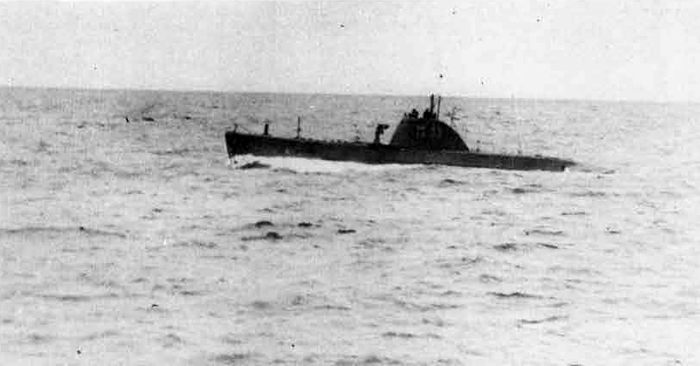
"M-VI" Glass.
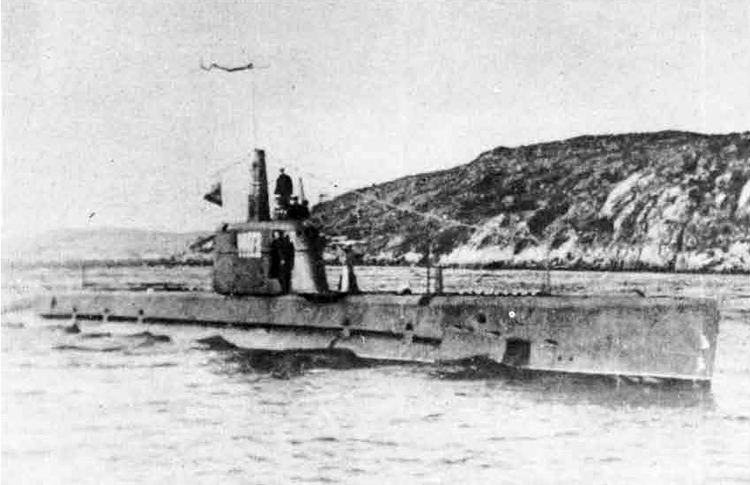
"M-XII" Class
SUBMARINES "M" CLASS

"M-XII BIS" Class.
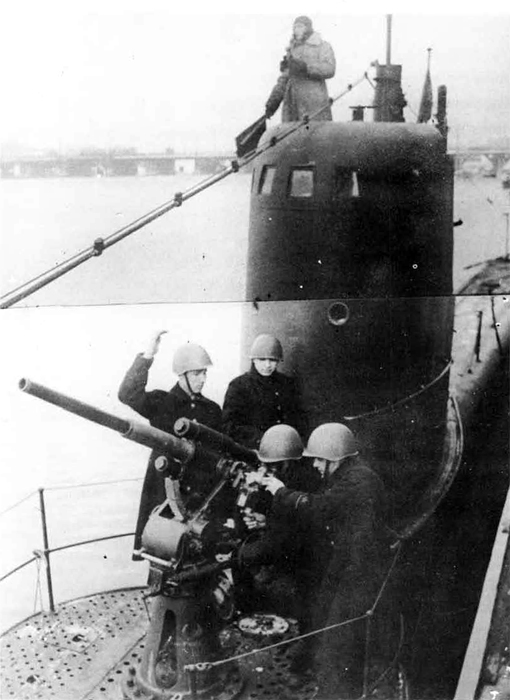
Closeup of Conning Tower and Forward Gun on a M-XII Bis (?)
Submarine in tie Baltic Sea.
VII. OVERAGE SUBMARINES ("B* BOLSHEVIK CLASS)
GENERAL SPECIFICATIONS
Date commissioned: 1916-1917.
Standard surface displacement: 650 tons.
Normal submerged displacement: 780 tons.
Length O.A.: 223 feet.
Beam: 13 feet.
Normal surface draft: 15 feet.
Horsepower of engines: 2,600.
Horsepower of motors: 900.
Full surface speed: 16 knots.
Full submerged speed: 9 knots with a radius of 25 miles.
Economic surface speed: 6 knots with a radius of 3,000 miles.
Number of propellers: 2.
ARMAMENT
2 3" or 6 pounder guns.
1 one pounder anti-aircraft gun.
It has been reported that 1 1.46" anti-aircraft gun has been added
to all boats of this class.
Some boats mount only 1 3" gun.
4 18" torpedo tubes, all placed in the bow.
Fitted for minelaying, normally carrying B mines.
GENERAL
These units were known as the Bubnov Class in the Imperial Navy. At present, they are used primarily for training purposes, but are also employed operationally, when necessity dictates. Two of these boats were reconstructed in 1937; two others were paid off for scrapping in 1938; and still two more were lost by colliabn. Except for the 6 boats now in the Black Sea, it is not known how many are left.
Overage Submarine of the "B" Class

VIII. SUBMARINE RESCUE GEAR IN THE SOVIET NAVY
For rescuing crews of sunken submarines the USSR Navy uses individual rescuing apparati equipped with oxygen, designed to isolate the wearer, which are given to every member of the crew. A rubber suit is given to every man in addition %o the rescuing apparatus, which protects the body from the influence of low temperature of water and air.
The exit of the crew from a sunken submarine in such equipment takes place in the compartments where there are escape hatches.
In the compartments used for rescuing of the crew, there are small
buoys with buoyant ropes, 100 meters long with knots every two meters
checking on the depth of the survivor so that he may take steps to
prevent the bends in accordance with the rules of safe ascent from
great depths. These rules are placed in every compartment with in
structions on how to rise from depths of 100 meters. The rules permit the men to determine at what depth 1D use oxygen and where and
how long to stop,
The.escape hatches, which are used for rescuing the crews have lengthened lower eoaming to which thick canvas jackets, reinforced with metal ribs, are attached, which can be lowered down almost to the floor plates inside the submarine. In addition to the escape hatches for rescuing the crews and conning tower of the submarine and the torpedo tubes can be used as airlocks.
For raising submarines with a rescuing ship or cranes, on the outer hull, in the bow and stern of the submarine; there are special fittings for fastening cables and special ring bolts attached to the pressure hull. For getting air into the submarine from the rescuing ship, the submarine has special valves and tubes in its deck, which lead to the compartments. Through these air and liquid food can be delivered to the crew.
Recent inspection of two Soviet submarines in Komsomolsk, on the Amur River in Eastern Siberia (at approximately 50030* North, l37°East) by a U.S. Naval Officer, corroborates the above information.
F. Minor Naval Craft and Auxiliaries
Except in a very few cases, minor craft and auxiliaries of the Soviet Navy consist of the remnants of the old Imperial llavy, which have little or no operational value today, and ships taken over from the merchant marines; very few naval auxiliaries have been constructed under the Soviet Regime.
I. GUHBOATS

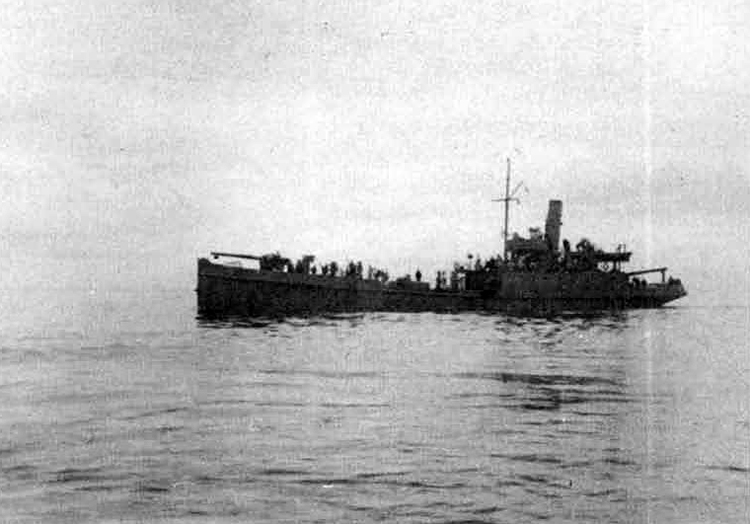
KRASKAYA ABKHAZIA Class Amphibious Gunboats (Black Sea) - are among the first gunboats (built 1909) designed for landing operations. They have a draft of 3.3' forward and 10' aft, a length of 198'.

VOROVSKY, Ex-Yacht (Arctic Ocean)

ZKELEZNIAKOV, Ex-Destroyer (Baltic Sea)

KONSTRUCTOR, Ex-Torpedo Boat (Lake Ladoga)

MARKIN Class, Ex-Torpedo Boats (Caspian Sea)
GUNBOATS (Cont.)
II. Minelayers

KRAS1JI AZSRBAIDZKAN Class (Caspian Sea)

ZEYA Class ( Far East)
II. MINELAYERS (Cont.)
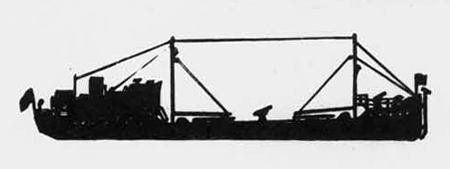
AYAN Class (Far East)
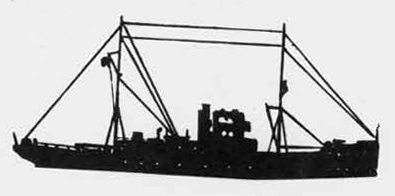
VOROSHILOVSK Class (Far East)
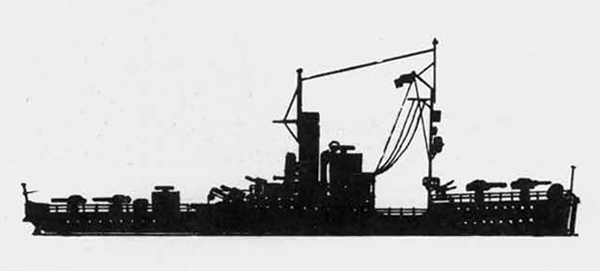
ARGUN Class ( Far East )
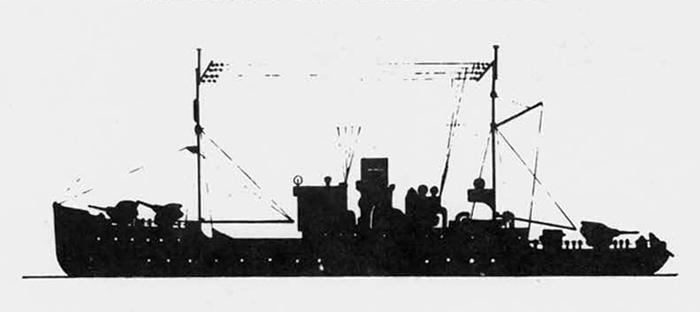
OKEAN Class (Far East)
ABGUN and OKEAN Classes are believed to be former surveying vessels; all other, minelayers shown appear to have been taken over from the Merchant Marine.
III. MINESWEEPERS

PLASTOON Class (Far East)
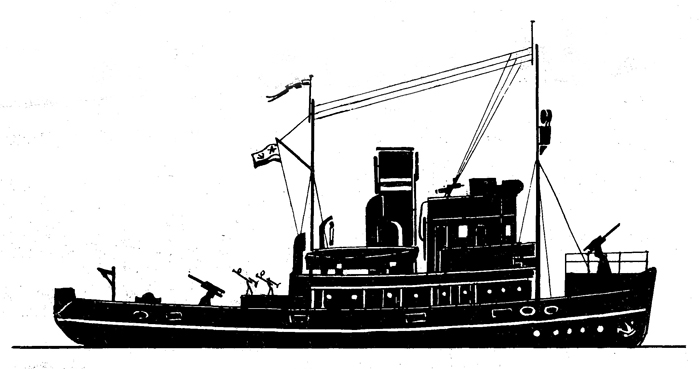
BUKSIR Class (Far East)
IV. MOTOR MINESWEEPERS

RIBNY RAZVEDCHIK Class (Far East)
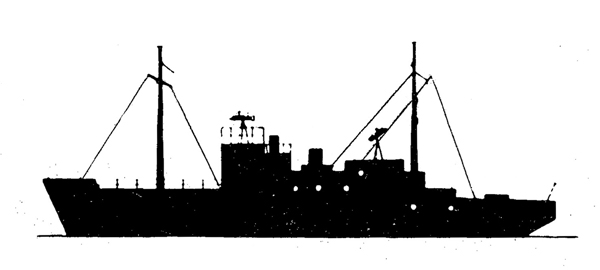
SATURN Glass (Far East)

DRIFTER Class (Far East)
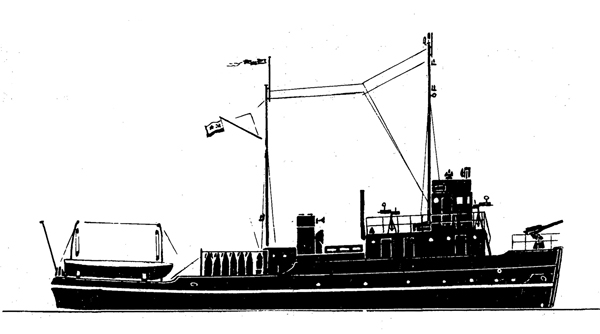
BOLSHOI SEINER Class (Far East)
Most minesweepers and motor minesweepers have been taken over from the Merchant Marine and differ considerably in appearance.
The Soviet Northern Fleet has been receiving additional minesweep-ing units from abroad. Even at the beginning of the war, it did not possess a sufficient number of this type of craft, and, due to serious losses, this inadequacy has become worse. At the present time, the 185 foot U.S. minesweepers are being acquired under Lend-Lease for this fleet. Prior to that time, eight former Norweigan whalers, converted to minesweepers (116 feet long), were transferred to it by the British Government. In addition, three British minesweepers, 119 feet long, have been loaned to the Northern Fleet.

Gunnery Training Ship AURORA - former light cruiser (Baltic Sea)
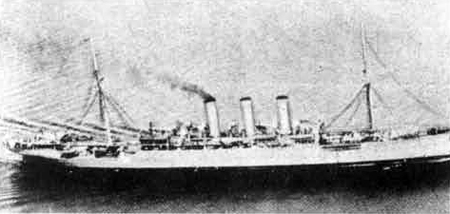
Engineering Training Ship KOMSOMOLETS-former passenger liner (Baltic Sea)
VI. TENDERS
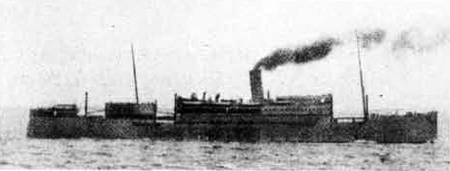
Cadet Training 3hip SVIR-former Dutch passenger liner (Baltic Sea)
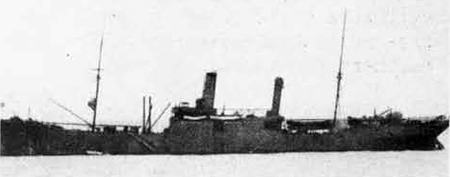
Destroyer Tender SERP-I-MOLOT (Baltic Sea)
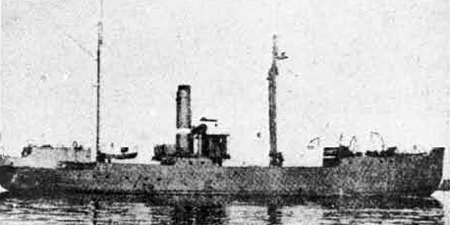
Destroyer Tender KRASNY GORN (Arctic Ocean)
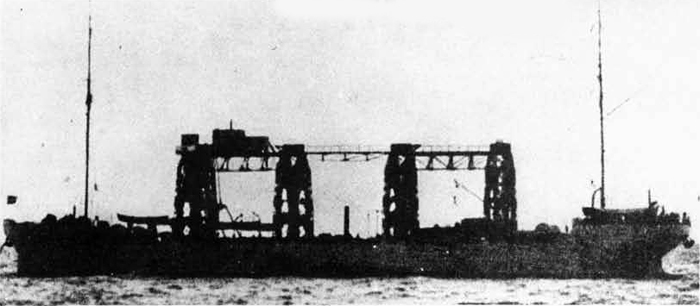
Submarine Salvage and Repair Ship KOMMUNA (Baltic Sea)
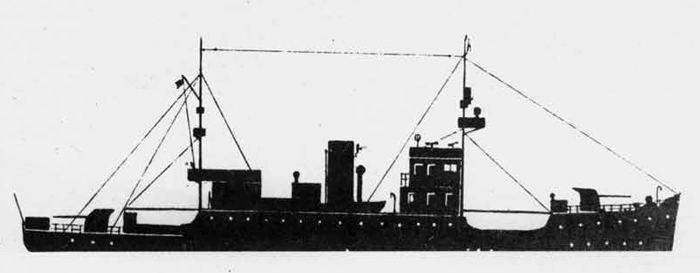
Seaplane Tender PARTISAN Class (Pacific Ocean)

Seaplane Tender 18 MARTA - former Imperial lacht SHTANDART (Baltic Sea)
VII. SUBCHASERS
The MO-IV Class, shown on the next page, appears to be tne prevailing PC design in the Soviet Navy; it is about 30 tons displacement, and has a speed of 25 knots. The silhouette is of a unit in the Far East and the photograph of one in the Arctic.

MO-IV Claaa (Arctic Ocean)

KAVASAKI Class (Pacific Ocean)
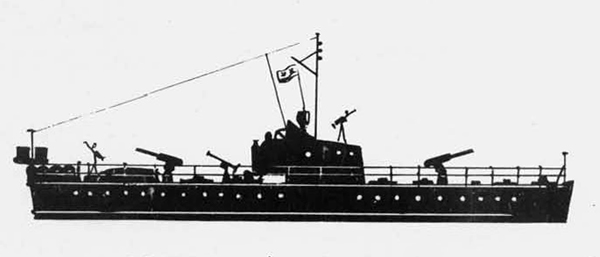
MO-IV Class (Pacific Ocean)
At the present time, the Soviet Northern Fleet is receiving twelve U.S. 110 foot SC's under Lend-Lease; they are all either en route, or will sail very shortly.
VIII. RIVER GUNBOATS
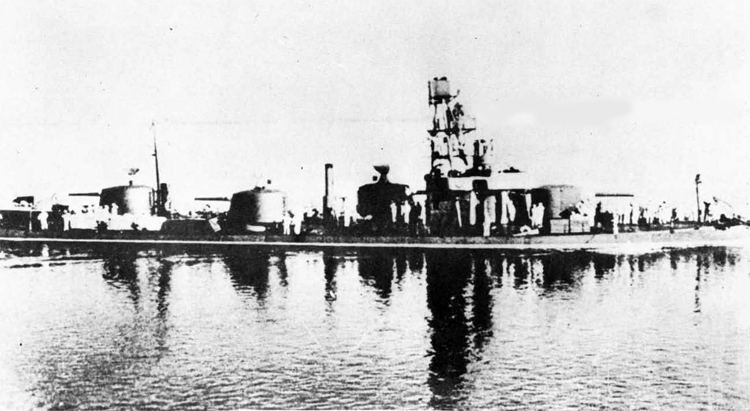
KRASNI VOSTOK Class (Amur River)
IX. ICEBREAKERS
The U.S.S.R. possesses the largest fleet of icebreakers in the world; the Russians consider them as naval auxiliaries.
(a)STALIN CLASS
Especially worthy of note, is this class, composed of three units, which constitute the most powerful icebreakers in the world.
GENERAL SPECIFICATIONS
Dates completed: 1938-1941.
Standard displacement: 11,000 tons.
Length O.A.: 348'.
Beam: 70'
Maximum draft: 32'.
Type of machinery: 3 reciprocating engines.
Horsepower: 10,000.
No. of propellers: 3.
Fuel consumed: Goal.
Full speed: 15 knots.
Cruising speed: 10 knots with a cruising radius of 3,000 miles.
Aircraft normally carried: 3 seaplanes launched by 2 catapults.
ARMAMENT
4 4" guns - 2 forward and 2 aft.
8 Oerlikon guns.
6 12.7 mm. machine guns.
GENERAL
These units can break ice over 6 1/2 ft. thick at an average speed of 1 knot.
In order to break thick ice, the prow of the vessel is run up onto the
ice.
Simultaneously, 1,800 tons of water are pumped into specially constructed
tanks in the prow from the stern—the weight of which presses down and
breaks the ice.
These ships are said to be easily maneuverable, and can turn about in
little more than their own length.
They experience great difficulty in high seas, however; during stormy
weather, a roll of 4-5° is common.
The seaplanes carried are reported to be specially constructed 4-passenger
type for use in the Arctic.
DISTINGUISHING FEATURES
Their construction is unusual; they have a pronounced bridge at the water line and a rounded bottom.
The bow slopes away to almost nothing; this contributes to their unseaworthiness. The STALIN and KAGANOVICH were completed in 1938; the MIKOIAN in 1941.

Ice Breaker MIKOYAN

Icebreaker STALIN
1. Heavy Plane. 2. Light Planes. (1&2 replaced by armament) 3. Crew Quarters. 4- Lifeboat. 5. Ballast. 6. Cargo hold or Coal Bunk. 7. Bridge. 8. After-Peak/Ballast of Fresh water. 9. Cargo hold. 10. Machine Storeroom. 11. Machine Compartment. 12. fresh water. 14&15. After-Boiler Compartments. 16&17. Forward Boiler Compartments. 18. Refrigerating Unit. 19. Commanding Officers1 cabins. 20. Pantry & produce. 21. Ship's supplies. 22. Chain case. 23,24,25. Differential Cistern. 26. Ammonal Storage. 27. Listing Cistern. 28. Shaft. 29. After Peak. 30. Ice.

Stern View of Icebreaker - MIKOYAN
(b) Ex NORTWIND
GENERAL SPECIFICATIONS
Date completed: 1943
Normal displacement: 5425.3 tons.
Length: B.P. 250', O.A. 269'.
Beam: 63'6".
Normal draft: 25' 10 1/4".
Number of engines: 6.
Type of machinery: Diesel, 2 cycle opposite Piston Fairbanks Morse.
Horsepower: 4 hour rate 2,000, continuous 1750 per engine.
Fuel: oil fuel and Diesel.
Aircraft normally carried: none installed as yet.
Launching device: one catapult,
ARMAMENT
None installed as yet.
GENERAL
This American icebreaker, which is being fitted out in the U.S. at the present time, will be turned over to the Soviet Navy when completed, under Lend-Lease.
(c) ICEBREAKER KRASSIN
GENERAL SPECIFICATIONS
Date completed: 1917.
Normal displacement: 10,000 tons.
Length O.A.i 323 feet.
Beam: 72 feet.
Normal draft: 25 feet.
Horsepower: 10,000.
Full speed: 14 knots.
Cruising speed: 10 knots.
ARMAMENT
2 3" U.S. guns.
3 .50 cal. colt machine guns.
4 .30 cal. Browning machine guns.
GENERAL
This unit wi3 built for Russia by Great Britain.
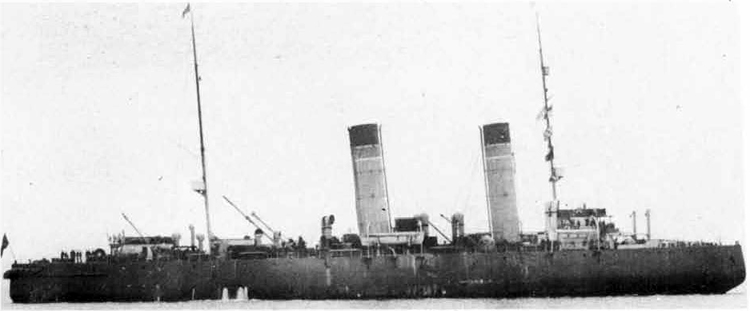
Icebreaker KRASSIN

Icebreaker KRASSIN
(d) ICEBREAKER LENIN
GENERAL SPECIFICATIONS
Date commissioned: 1917.
Displacement: 5,600 tons.
Length O.A.: 264. feet.
Beam: 64. feet.
Maximum draft: 21 feet.
Type of machinery: triple expansion.
Horsepower: 7,500.
Number of propellors: 3.
Number of boilers: 8,
Fuel consumed: coal.
Full speed: 14. knots.
ARMAMENT
1 1.8" gun.
6 anti-aircraft machine guns.
GENERAL
This unit, which was built in England in 1917, is of the type which operates well in broken ice.
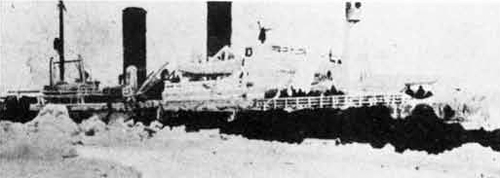
Icebreaker LENIN
(e) OTHER ICEBREAKERS
The following are photographs of some of the more important units of the Soviet Icebreaking Fleet.
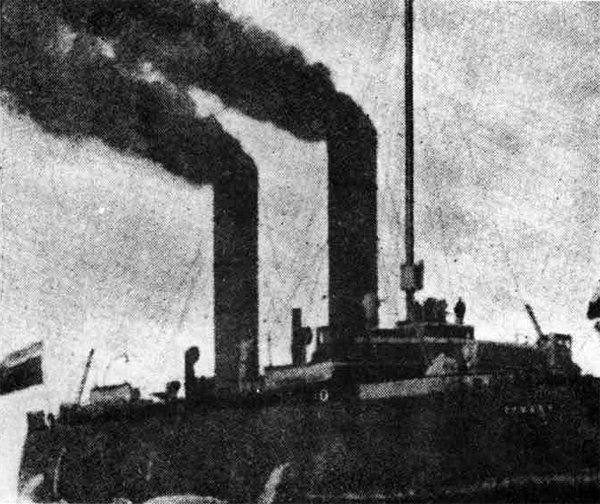
Icebreaker YERMAK
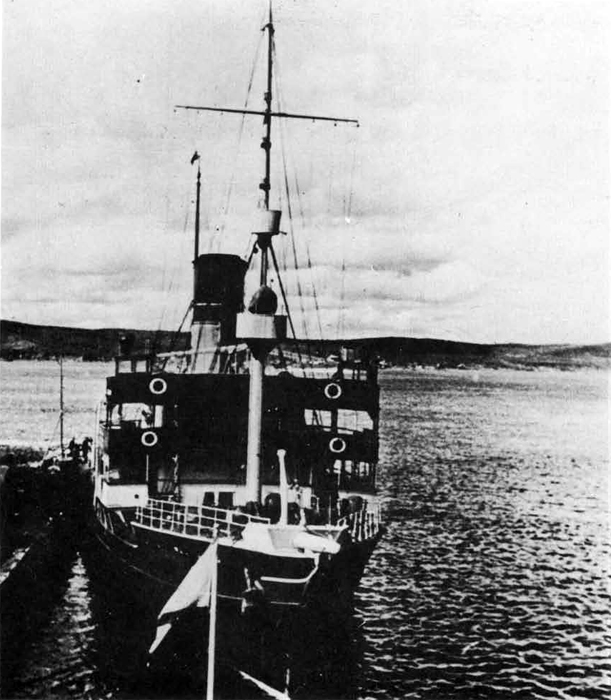
Icebreaker LITKE (Ex Yacht Earl Grey)
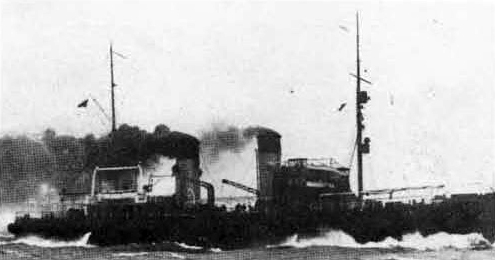
Icebreaker STEPAN MAKAROV

Icebreaker TAIMIR
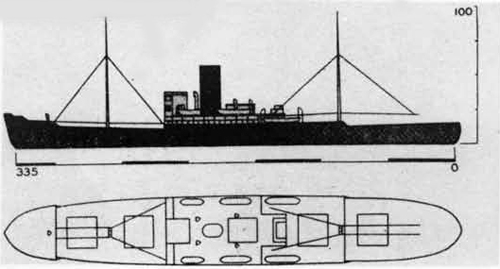
Icebreaker DEZHNEV
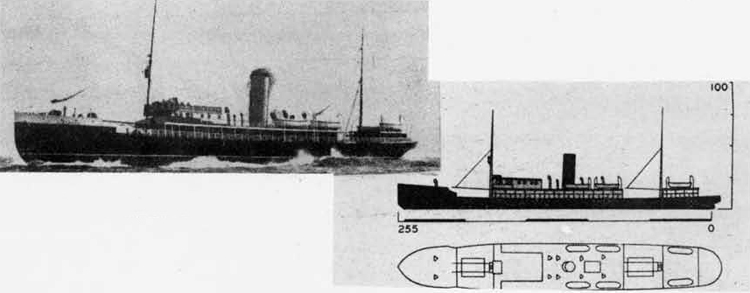
Icebreaker SADKO

Icebreaker KAZAK KHABAROV

Icebreaker DOBRINYA NIKITICH

Icebreaker DAVIDOV
CHAPTER VIII. NAVAL BASES AND YARDS
A. BALTIC SEA
For over two years, the chief naval base of the entire U.S.S.R., located at Leningrad and vicinity, has been subjected to almost constant bombing as well as to attacks made on it, from time to time, by land and sea forces.
The position of Leningrad on a number of islands makes its communications system particularly vulnerable5 bridges over the numerous waterways are strikingly few. Connecting the important Vasilievski Island with the rest of Leningrad, for example, there are only five bridges; this island commands the most important point of the entire city.
Probably only the most essential industry is still operating at Leningrad; all the rest has been transported farther to the east. By the summer of 1942, most of the unessential population had been evacuated as well.
Nothing is known of the present-day condition of Leningrad; it is reasonably certain, however, that it is impossible to undertake any degree of shipbuilding here, although occasional reports have stated that the overage battleship GANGUT, as well as various other units of the Baltic Fleet, have been under repair. It is believed that the heavy cruiser MAXIM GORKI was repaired and made fit for action after having been seriously damaged by bombs.
Leningrad was and still is the chief base for the Soviet Baltic
Fleet, which, up to the time of the German attack, was by far the most
important Russian fleet.
The Leningrad Naval Base may be roughly divided as follows:
(a) The city of Leningrad, including nearby islands—the location of
most of the ship building and ship repair facilities of the Baltic
Sea, as well as that of a naval base,
(b) Kronstadt, on Kotlina Island—the chief naval base and naval operating base for the Soviet Baltic Fleet. A few ship building and
ship repair facilities were located here. Kronstadt, together
with smaller nearby islands, contained most of the coastal defense batteries of Leningrad.
(c) Oranienbaum—a subsidiary naval operating base.
(d) Peterhoff—a small naval harbor.
(e) Schlusselburg—the base of the Lake Ladoga Flotilla for the protection of Leningrad from the east and north. A seaplane station
was located here as well as a shipyard capable of carrying out repairs to the local flotilla. No information is available on the
condition of this base since its evacuation by the Germans several
months ago.
Prior to the outbreak of the war, Leningrad possessed the following ship building and ship repair yards
(1) Imeni S. Ordzhonikidze Shipbuilding Yards (at Kronstadt and Leningrad)
This yard was reconstructed between 1936-1939. There was a 6000-ton floating drydock and a graving dock at the Kronstadt section of the yard. The large west slip could build ships which would be up to 820 feet
long and 100 ft. beam; the large east slip could build ships 820 ft. long and 230-260 ft. beam. There were 3 small concrete slips 330 ft. long and 4. wooden slips for building submarines. This yard could construct 2 large vessels and as many as ,12 submarines or 15 small vessels simultaneously. There was a large section for the production of engines and boilers of all types and the yard was important as being the only one in the north which could make round hulls for submarines.
(2) Imeni A. Marti Shipbuilding Works. Number 194. (at Leningrad).
This yard was located on Galerni Island. It was capable of building 2 up-to-date capital ships and about 8 smaller vessels or submarines -simultaneously. The north and south concrete slips could build ships 770 ft. by 105 ft.; it could be converted into 2 tracks for building 4 ships 3^0 ft. by 55 ft.; there were in addition 15 wooden slips. Associated engineering- works constructed engines, boilers, and auxiliary machinery for all tjrpes of smaller vessels. There were two graving docks and on« floating drydock of 4000-ton capacity,
(3) Sodomekh Shipbuilding Works. Number 196 (at Leningrad)
Prior to the outbreak of the war, this yard was reconstructed and fitted but for building submarines. There were two enclosed slips 360 ft. long and 65 ft. wid«, 2 open slips 520 ft. long and 90 ft. wide, as well as a. certain number of wooden slips.
(4.) Imeni A. Zhdanov Shipbuilding Yard. Number 190 (at Leningrad).
This was formerly Putilov Works;, it was capable of building 2 3000-ton destroyers and about 5 small vessels (or of assembling 5 submarines) simultaneously. It could not build submarines complete but assembled them from parts supplied by th« Ordzhonikidze Yards. Associated engineering works constructed engines, boilers, and auxiliary machinery for all types of smaller vessels. There were 9 concrete slips to take-ships from 330 ft to 550 ft. long and a wooden slip for the simultaneous construction of 28 trawlers. The latter occupied an area of 690 by 350 ft. There was 1 6000-ton floating drydock.
(5) Izhbrski State Works (at Kolpino, southeast of Leningrad)
This yard was located at Kolpino on the Izhora River. It was capable of building 4- destroyers and of assembling 4- submarines simultaneously. This yard specialized in the production of armor plating.
(6) Admiralty Dock Yard (at Kronstadt)
Up to the time of the war, this yard undertook no construction but only repaired submarines and was the location for the "Kirov" Submarine School. There were 2 small floating docks of 2000-ton and 700-ton lifting capacity, respectively, 2 graving docks and several cranes; the salvage ship "Kommuna11 was normally stationed here.
(7) Okhtenski Shipbuilding Yard (at Leningrad).
At one time, this yard constructed destroyers and assembled submarines, but at the time of the outbreak of the war, built only minesweepers, small river steamers, and lighters.
(8) Imeni Lepse Shipbuilding Works. Number 5 (at Leningrad).
If planned reconstruction was completed at this yard, it was capable of building small destroyers and assembling submarines; there
was, however, nothing to indicate that submarine construction was carried on. There were 4 slips from 60 to 400 ft. in length.
(9) Pebrovski Shipbuilding lard (at Leningrad).
This was a newly-built yard and constructed and made repairs to motor torpedo boats and glisseurs.
(10) Schlusselburg Shipbuilding Ya.rd (at Scnlusselburg)
This yard was capable of carrying out necessary repairs to units of the Lake Ladoga Flotilla.
(11) Imeni Karakozova Shipbuilding Yard (at Leningrad).
This yard built wooden launches and boats.

Defenses:
No Information is available on defenses of Leningrad and its environs.
LENINGRAD
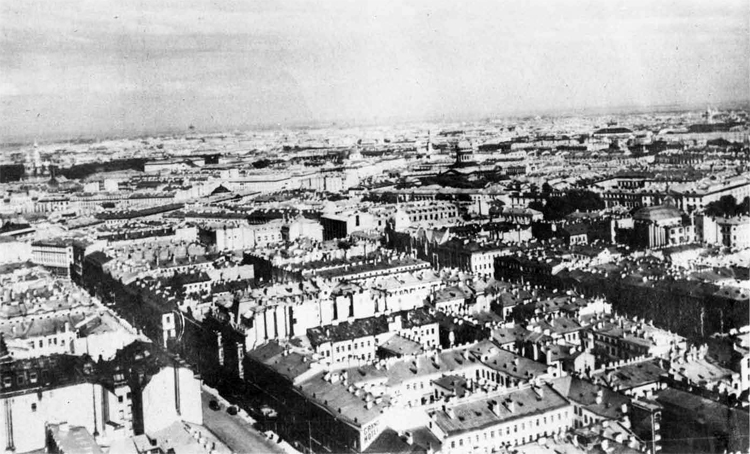
City of Leningrad.
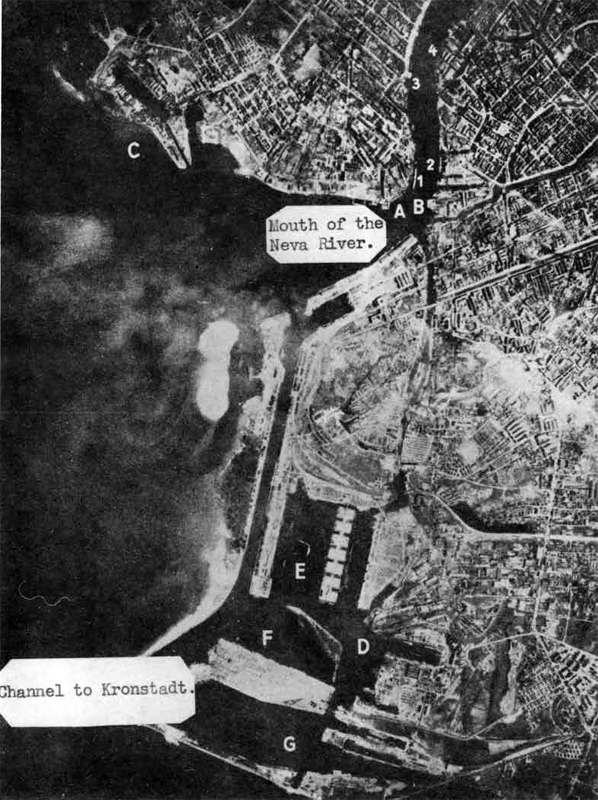
LENINGRAD (photograph taken August, 1941)
A = Baltic shipyards with ons battleship, one heavy cruiser, and
several destroyers under construction.
B = Marti Shipyards.
C = Wharves.
D = Zhdanov Shipyards with several destroyers under construction.
E = Anchorage with 9 freighters, totalling 20,000 tons.
F = Grain mole with several destroyers and one heavy cruiser under
construction of 4,500 tons.
G = Coal harbor with one dismantled battleship, and several destroyers.
1 = CA PETROPAVLOVSK (Ex German LUETZOW, Hipper Class) under construction,
2 = CA of the KIROV Class under construction.
3 = Floating drydock. 4 = Icebreaker
LENINGRAD

KRONSTADT (59°59'N., 29°46'E.)
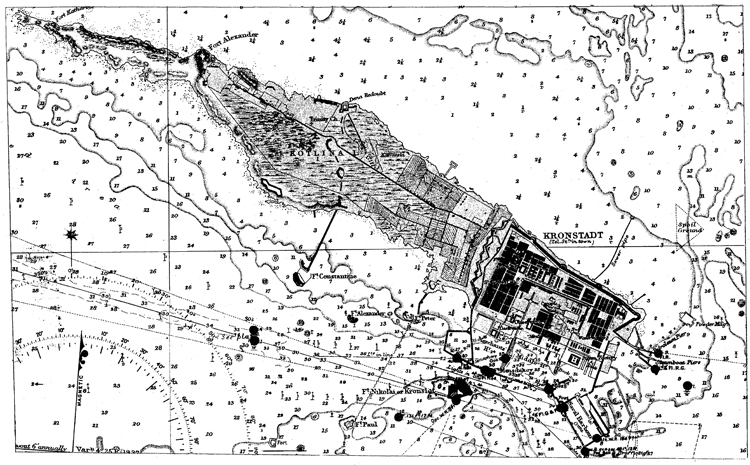

PETERHOFT
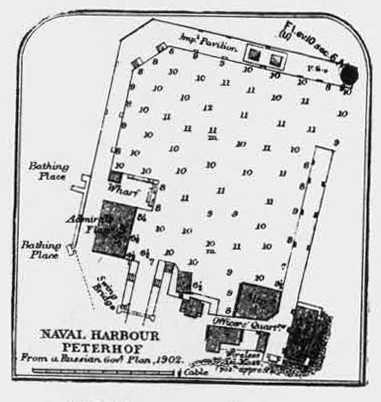
(59°53'N.( 29°55'E.)
KRDNSTADT
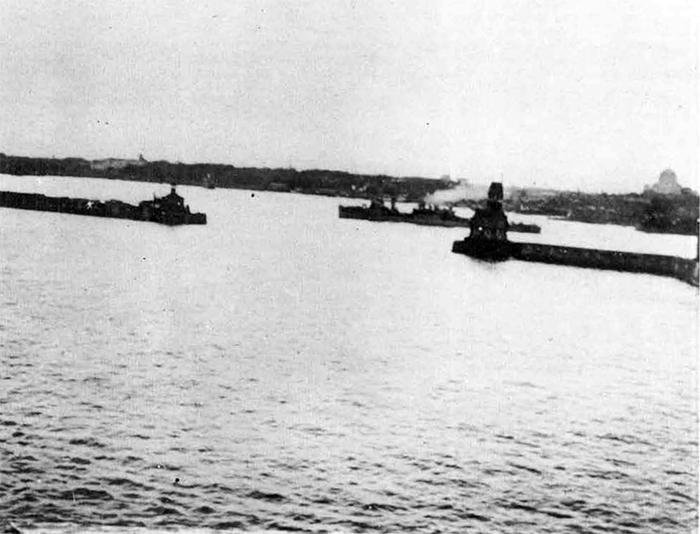

KHONSTADT Photograph taken July, 1941
A. = Naval Base.
B = 4 drydocks
C - Arsenal.
D - Shipyard.
E = Coastal batteries.
1 = OBB GANGUT
2 = OBB PETROPAVLOVSK
3 = Damaged heavy cruiser
of the Kirov class.
4 = Tiro destroyers.
5 = Merchant ressel.
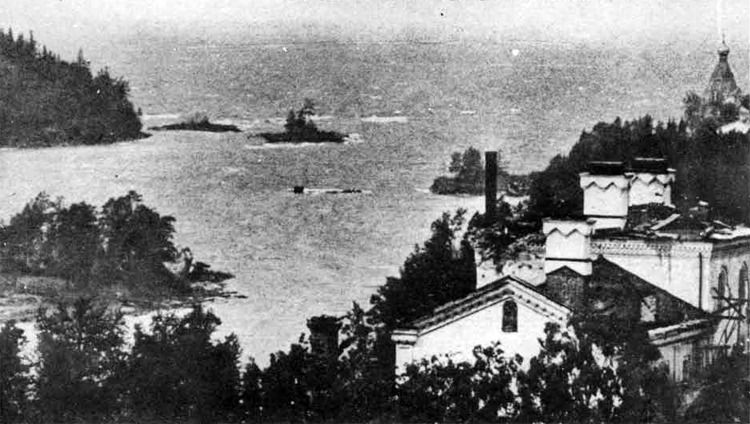
Shore of Lake Ladoga.
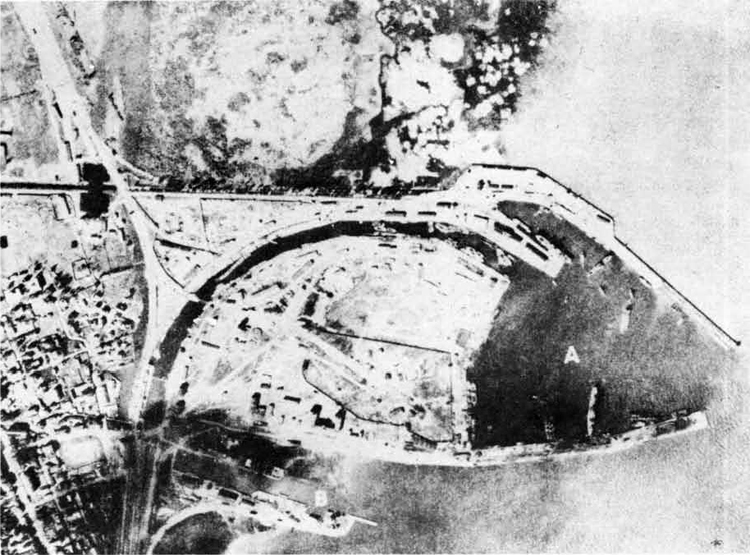
0RANIENBAUM (59°53'N., 29°51'E.)
Photograph taken August, 1941.
A = Harbor with the OCL AURORA, ons deatroyer, on« patrol vessel, 3 minesweepers, 2 submarines of the SCHCHUKA class, one freighter, and various coastal vessels.
B = Small boats harbor
B. BLACK-SEA
I. In General
ALTHOUGH the Germans
have been completely expelled from the
Caucasus, it is probable that the Russians are still compelled to use
the unsutable and ill-equipped bases of Poti and Batum. Before the
Germans evacuated the once important base of Novorossisk, they probably destroyed as many of the installations as they could; therefore,
it should be considered as impotent for some time to come. Despite
these facts, the Soviet Black Sea Fleet is exercising some of the advantages of sea power. Poti and Batum contain not only the greater
part of the Soviet Fleet but also all the remaining Black Sea Russian
merchantmen and tankers* It is fortunate indeed that the German threat
to the Caucasus lias been removed since this considerable amount of
shipping is very much congested and insufficiently dispersed against
any determined large scale bombing attack. The Soviet commander-in-chief must also be relieved to know that the Axis have no heavy naval
forces in Black Sea waters*since the dockyard facilities at his new
bases would be quite unable to cope with any large-scale damage after
a heavy Fleet action. In this connection, it is understood that at Batum
there are no docking facilities of any description and rather meagre
limited repair shops Poti, the manganese port some 30 miles to the
northward, is better off in this respect since it possesses two floating docks capable of taking any modern destroyer and some efficient
workshops, but it seems unlikely that either of these docks can accommodate a cruiser. A third floating dock was still beached at Sukhum
in July, 194-3• The modern 8,000-ton cruiser M0L0T0V has been lying disabled at Poti with her stern completely blown off since September, 194-2,
and so far no repairs have been effected. On the other hand, a complete
new bow has been fitted to a destroyer casualty which does prove that
major repair work can be carried out on smaller craft. The Fleet is
further handicapped by having no permanent ariffiiunition stowage, food
and supply yards. Russians, when pressed, are exceedingly capable improvisers,and it seems as if the Fleet is now sufficiently supplied
with ammunition and torpedoes. Hiere should be no lack of submarine
spare parts since, as an emergency measure, -it-would be feasible to
assemble spares from the nine Caspian Fleet submarines. With the threat
to Baku removed, there is no longer any function for these boats to perform. Between these two bases, the follov/ing naval vessels were berthed
in July, 1943.
Two modern cruisers (one damaged); two old cruisers; one old dreadnought battleship; one Flotilla Leader; six/seven modern destroyers (two damaged), two/three old destroyers and about 40 submarines of various classes, including large 750-ton boats, medium 550-ton class and some 12/13 baby 200 tonners.
In addition to this Fleet, there are also two modern cruiser hulls (KUIBYSHEV and FRUNZE) which were successfully towed away from the MARTI yard at NIKOLAEV prior to the German, occupation of that important Black Sea naval shipbuilding yard on the River BUG. There is also the hull of an uncompleted Flotilla Leader, ERIVAN, lying in BATUM
II. Batum (41°39'N., 41°38'E.)
Before the outbreak of the Soviet-German Jar, Batum was of strategic importance as a secondary base to Novorossisk for submarines and surface craft operating in the eastern part of the Black Sea. Batum anchorage is important as being easily the best in the southeastern portion of the Black Sea, but the great depths in the bay make it inconvenient; ships usually anchor close inshore y/ith their sterns secured to
bollards on shore. The prevailing wind is ^quthv/est,-and the port is ice-free all the year around. Batum Road affords shelter from all winds from east to northwest; the only winds to be feared are gales from the north which are rare. It is very seldom that vessels with their sterns moored to the shore have to haul off.
There is a current of from 1 to 1 1/2 knots for about 4 miles off-shore; this is caused by the out-flow of the Chorokh River.
The poart of Batum consists of three harbors: the Nyeft or Oil Harbor, the Kabotazh or Coastal Harbor, and the Harbor on the western side of Batum Bay. The whole of the western shore of the Bay consists of a natural quay or esplanade, alongside which there are depths of 23 l/2 ft. Oil Harbor lies in the southwestern corner of the Bay; in 1940> there were depths of 32 ft. at the Petroleum berths and 26 ft. in the other berths at this .harbor. Kabotazh Harbor lies southward of a mole which extends about 1 1/2 cables east northeastward from the elbow of Nyeft mole. This harbor has silted up ano^ in 1940,was too shallow to be of use.
At the commercial port there are five berths with a depth alongside of 32 feet, six berths with a depth alongside of 25 feet, two berths with a depth alongside of 23 feet, as well as eight wooden piers for small coastal craft, two of which serve as stations for NKVD coastal patrol boats and launches.
At Batum, there are berths for one or possibly two large cruisers, as well as for two destroyer or submarine flotillas.
At the naval base, there are buoys and a small slip for light craft just south of Cape Burun Tabie but no facilities for larger ships. This slip is complete with ship repairing workshops and a drydock, 100 feet long, 20 foot beam, and 12 foot depth.
Defenses
Little recent information is available on the defense system of Batum, During 1942 balloons were observed around the harbor and along the coast in the vicinity of the harbor. Only about twelve guns , were seen in action during enemy reconnaissance sorties; at that time, anti-aircraft guns were apparently of small calibre.
Work on the airport was in progress. Two asphalt runaways, northwest-southeast and northeast-southwest, were completed. The airport is "considerably longer than 900 yards" according to the same source, who saw biplane fighters on it.
During the flatter part of 1942, it was reported that a marine brigade was stationed at Batum.
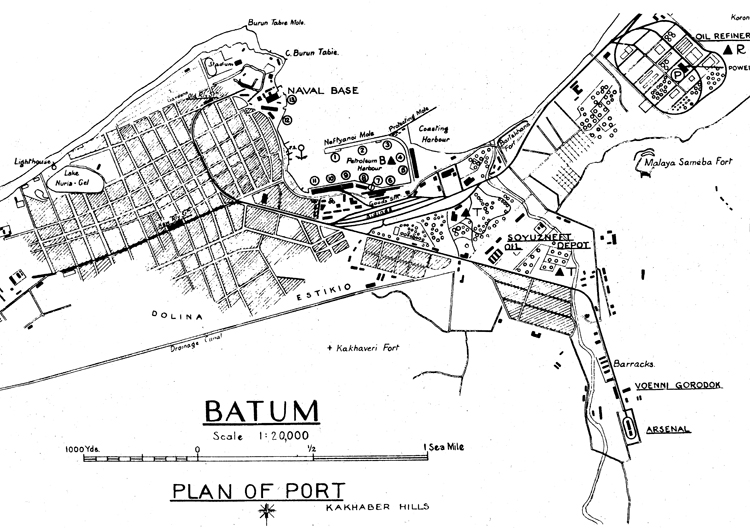
BATUM
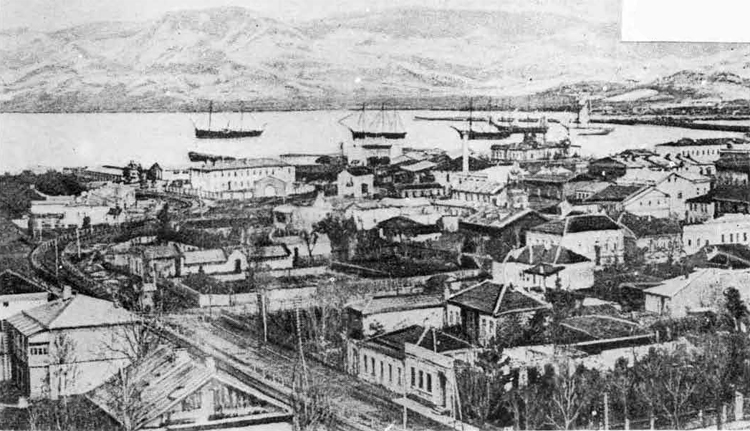
BATUM

BATUM
Photographs taken April, 1942
A =» Petroleum harbor.
B = Arsenal.
1 = Heavy cruiser of the Kirov class
2 = Tralning ship KOMINTERN.
3 = A destroyer leader.
A = Three incomplete destroyers.
III. POTI
Prior to the outbreak of the war, the importance of Poti lay in the export of manganese ore, of which there are large deposits of very good quality in this area.
Poti Harbor is entered between 2 moles of which the southern forms an extension of the northern bank of the northern branch of the Rion River for about 2 3/4 cables in a westerly direction and thence for about 6 1/2 cables in a northerly direction. In 1938, there were depths of from 26 to 28 ft, inside the harbor. Northwesterly gales occasionally caused silting in the entrance and basins, decreasing the depths by as much as 1 l/2 ft. It is necessary to employ dredges constantly to remove this silt. The harbor is accessible throughout the year except during winds from the west or northwest when the backwash from the shore raises a heavy sea off the head of the southern mole. The harbor entrance is kept dredged to 29 ft., and vessels of 10,000 tons can be berthed alongside the quays. There were 3 wharves with a depth alongside of 25 ft., 6 with a depth alongside of 23 ft., 5 with a depth alongside of 20 ft., and 1 with a depth alongside of 16 ft.
Little information is available on repair facilities at Poti. It is known that two floating drydocks are available here and that each can accommodate two destroyers or submarines-simultaneously. In addition, small repairs can be carried-out at the port workshops and there is a small slip with a lifting capacity of 500 tons,
Poti can accommodate one or two cruisers and two destroyer or submarine flotillas. In July, 1943 > the following units were at this base: the overage battleship SEVASTOPOL, the badly damaged heavy cruiser M0L0T0V, which was still waiting for suitable docking facilities for repair to her stern', the hulls of the two incomplete cruisers, FRUNZE and KUIBYSHEV, were lying in the outer harbor and no progress on either vessel had been made, the overage heavy cruiser KRA3NY KAVKAZ, two destroyers in one floating drydock and two submarines in the other, the submarine tender VOLGA, with an undetermined number of submarines, (in October, 194-2, three divisions of submarines, consisting of 8-9 boats each were stationed here), various motor torpedo boats, coastal motor boats, minesweepers, harbor craft, etc.
Poti also serves as headquarters for the commander, submarines Black Sea, Rear Admiral Bultonov and his staff and as the headquarters for the commander, cruisers, Black Sea, Vice-Admiral Basisty and his staff. Admiral Basisty uses the OBB SEVASTOPOL as his headquarters and from there commands the cruisers and the destroyer leader KHARKOV (in October, 194-3, the Germans reported flat this last mentioned unit had been sunk). Poti also serves as headquarters for the naval Lieutenant General Kumanin, in command of all coastal defense from Sukhum to Batum.
Defenses
Between October, 1942, and July, 1943, improvements were made in the defenses of the harbor. The breakwater in the outer harbor was extended and a boom of Anti-Torpedo nets was laid across the entrance to this part of the harbor. A similar boom is still in use across the entrance to the inner harbor. The OBB SEVASTOPOL was lying alongside a jetty port side-to, in July, 194-3, and had torpedo nets along her starboard side which was open to the entrance. The old cruiser KOMINTERN no longer exists and the hull now forms part of the extensions to the outer breakwater.
There is a seaplane base on Lake Poleoston with an airfield for land aircraft alongside, with hangar repair workshops and fuel stores. The surface is fairly good, but unserviceable in winter and in bad weather.
It was reported in 1942 that M.B.R. 5's carry out continuous coastal patrols from this seaplane base go .ing as far north as 'Tuapse and as far south as Batum, and that they carry neither bombs nor depth charges, but upon sighting enemy submarine, do signal the coastal defense batteries which open fire according to these signals.
At the mouth of Khopi River, located about 15 miles north of Poti, a small naval base has been built. Little is known about this base, but there is a jetty on the southern shore of the river at which a destroyer can lie. In July, 1943, dredging appeared to be continuously in progress at the mouth of,the river. There is a bar at this point, which is liable to shift. The current in the river attains a rate of as much as 6 knots at times, making the bar dangerous and causing heavy breakers with any onshore sea or swell. In general, the river can only be entered when there is no swell. The area off the northern side of the moutti is very shallow; beyond the bar, the depths are "considerable" for several miles upstream.
POTI HARBOUR
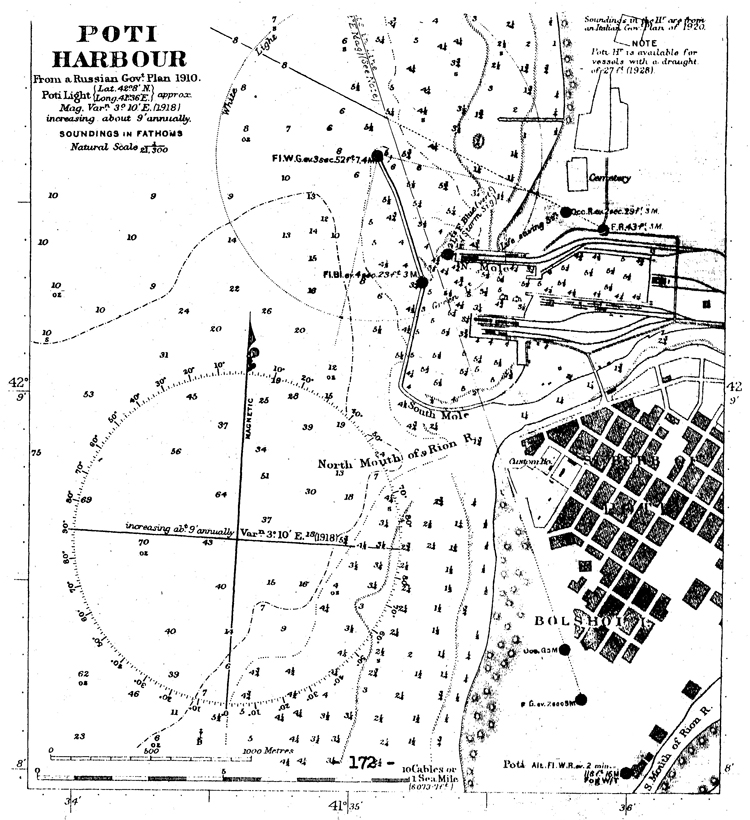
PLAN OF POTI.

POTI

Photograph taken April, 1942
A = Naval Base.
B = Yard installations.
C = Floating drydock with OCA KRASNY KAVKAZ
D = Floating dryttock with one destroyer and one submarine.
E - Anti-submarine net.
1 = Heavy cruiser of the Kirov Class.
IV. Novorossisk (44°40'N., 37°49'E.)
No information is available on the condition of the naval base of Novorossisk since its recapture by the Russians in September, 1943. However, after the evacuation of Sevastopol by the Soviet Black Sea Fleet in the spring of 1942 until it was captured by the Germans in September, 1942, it was the main base for the larger units of the fleet; prior to the outbreak of the war, it was employed as a subsidiary base to Sevastopol and ordinarily accommodated submarines and light surface craft,
Novorossisk is a good, entirely sheltered harbor large enough to accommodate the entire fleet. The entrance to the bay is between Sudzhuk Point and Doob Point, about 4 3/4 miles apart. The bay is 3 1/2 miles long. The anchorage, at the head of the bay eastward of the town is considered dangerous during the autumn and winter months because of the prevailing northeasterly winds; these winds often increase to gales and even to hurricane strength during this period of the year. Novorossisk harbor never freezes.
Prior to the outbreak of the war, this harbor was the best-equipped port on the entire Caucasian coast. Small castings and repairs to machinery could be carried out. More extensive repairs could be effected at a motor works. There was a patent slip for small craft.
Before the Germans evacuated Novorossisk,they doubtless destroyed all defense equipment as well as port installations. However, prior to the outbreak of the war, the commercial port of Novorossisk possessed 10 wharves with a depth alongside of 30 ft., L, wharves with a depth alongside of 29 ft., 5 wharves with a depth alongside of 28 ft., 2 wharves with a depth alongside of 25 ft., 5 wharves with a depth alongside of 2U ft., 2 wharves with a depth alongside of 23 ft., 2 wharves with a depth alongside of 20 ft., and 1 v/harf with a depth alongside of 17 ft.
There were three large floating drydocks at Novorossisk prior to its occupation by the Germans; two of these drydocks are now at Poti, and the third is beached at Sukhum.
Defenses
It was observed that during their occupation, the Germans did not try to use the harbor of Novorossisk, as Soviet naval coast batteries shelled German positions very successfully. Coastal defenses between Novorossisk and Tuapse were very strong and well camouflaged in 1942. Exposed portions of the beach were protected by single fences of double-apron barbed wire. Defensive works were constructed principally of wood, stone, and earth, little concrete being used. There were many small machine gun positions and small excavations where individual riflemen could take cover, and, at the same time, procure a field of fire. No anti-tank blocks were seen on the beaches, although roads were often trenched and planked over in defiles and placed where diversion from the road would be difficult.

NOVOROSSISK
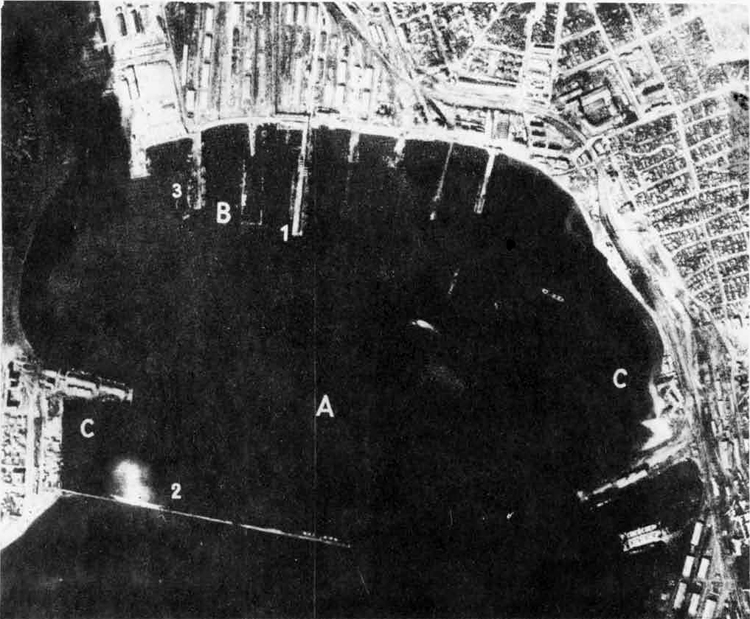
NOVOROSSISK
Photograph taken October, 1941.
A = Commercial Port.
B = Wharf installation under construction.
C = Two ahip repair shops.
1 = A heavy cruiser of the KIROV Class.
2 =» A cruiser hull.
3 = An icebreaker.

Port of Novorossisk.
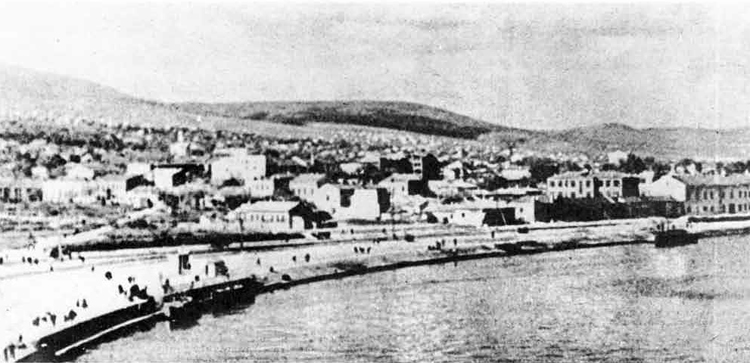
Port of Novorossisk.
V. Tuapse (44°40'N., 37°49'E.)
In peacetime, Tuapse was not intended to be a naval base, and is not suitable as one, but was almost entirely used as a petroleum port depot for the Maikop oil fields. However, when the Soviet Black Sea Fleet was compelled to evacuate its base on Sevastopol in the spring of 1942, the headquarters of the Gommander-in-Chief, together with some units, came here. Repair facilities are not extensive; minor repairs can, however, be carried out, and warships can self-refit. In August, 1942, there was a small floating drydock, with a capacity of probably not more than 4^00 tons, and a factory, where mechanical repairs could be carried out. These installations have undoubtedly suffered from aerial bombardment, but the machine factory is believed to be still intact. Naval stores are kept on the wide mole. These facilities, which are ordinarily engaged mainly in making repairs to tankers, could carry out repairs to hulls and machinery.
The greater part of the Black Sea Fleet could*by carerul berthing, be accommodated here, but^because of the narrow harbor entrance, movements in and out of it would be a slow and difficult process. The harbor is well-sheltered and practically free from swell; the coastal current, setting northwestward, is much felt in the vicinity of Gape Kodosh at the entrance to the bay.
The port of Tuapse consists of 2 harbors: Old Harbor, v/hich is known as Government Port, in the western part of the bay, and New Harbor, also known as Rail Harbor, in its eastern part; these two harbors are separated by Shiroki Mole. This mole,over 1000 ft. long;,had a depth alongside in, 1938 of 18 ft. to 30 ft. A quay,which extends northwestward from the root of Shiroki Mole, has depths of 18ft. alongside. The Petroleum pier, which lies parallel to and about 1 l/2 cables within the innershore part of the southern mole, had depths in 1938 of 32 ft. alongside. In 1938, alongside the berths on the ?/estern side of the broad part of the southern mole, there were depths of 30 ft.
Defenses
In 1942, the town of Tuapse was heavily defended by antiaircraft batteries which fired at sight and searchlights which seemed to work efficiently*but independently of the guns. Standard recognition signaling appeared to be in operation between light fighters and ground defenses.
In July and August, 1942, defenses in the wooded valley of the Tuapse River consisted of numerous machine gun posts at all strategic points; in certain positions, trenches were constructed between the strong points.
In October, 1942, the front came so close to Tuapse that the headquarters of the fleet were moved to Sukhunw In January, 1943, when the Germans had retired to Novorossisk, they were again moved northward to Makopse, about 10 miles southeast of Tuapse.
TUAPSE

SKETCH PLAN OF OF TUAPSE
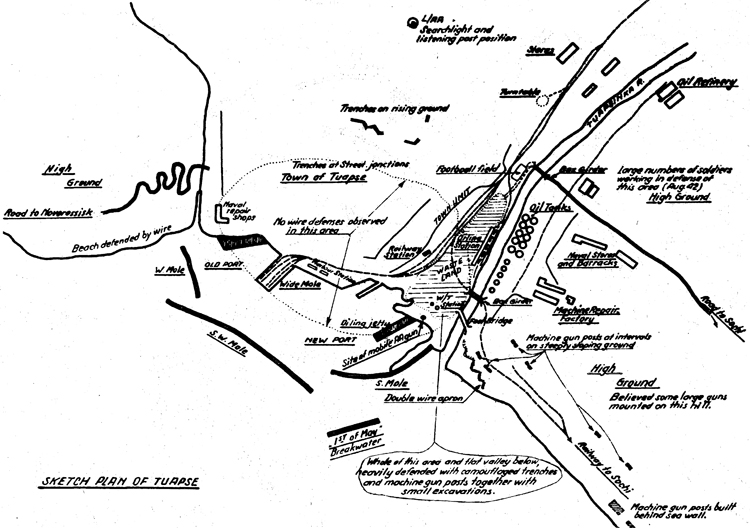
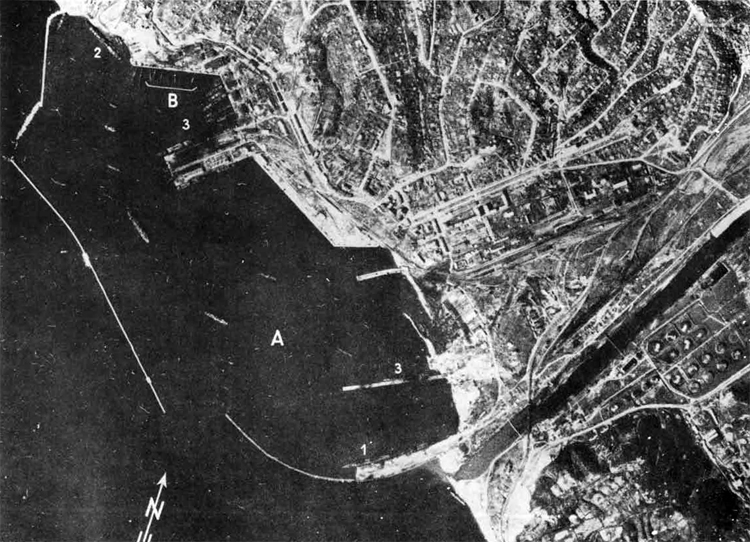
TUAPSE
Riotograph taken March, 1942.
A = Commercial port.
B = Naval araenal and navy yard
with 8 submarines tied up alongside.
1 = A heavy cruiser of the Kirov Class.
2 = A heavy cruiser of the Kirov Class
fitting out.
3 = Three destroyers.
VI. SUKHUM (42°59'N., 40°59'E.)
From October, 1942, until January, 1943, until it was moved to Tuapse for the second time, Sukhum, formerly a seaside resort, served as headquarters for the High Command of the Soviet Black Sea Fleet. It was housed in the."Second Hotel" (see chart).
Port facilities consist of a large open roadstead which provides difficult anchorage in rough weather, three piers, at least one of which has been damaged by bombing, and including one small fishing pier, and some warehouses.
The entrance to Sukhum Bay is about 9 l/2 miles wide. Safe anchorage can be obtained in the bay in depths of from 18 to 20 fathoms, on the line of the light structures of the old fortress. The depths increase very rapidly a short distance south of this line so that care should be taken not to anchor south of it/ Small craft can obtain anchorage near the town.
There are three piers abreast of the town: the first of these, the most westerly, is 973 ft. long. There are depths on its western side of 30 ft. near its head, 23 ft. near its center, and 19 ft. near its inner end, and on its eastern side depths in the same positions are 30 ft., 23 ft., and 16 ft«, respectively. The other two piers have depths of 12 3/4 and 8 ft. respectively at their outer heads.
One of the three large floating drydocks, which were evacuated from Novorossisk, was beached at Sukhum in July, 194-35 whether it is in a usable state; at the present time, is not known.
Defenses
Little information is available on the defenses of Sukhum. During July and August, 1942, it was observed that anti-aircraft defenses were inadequate, but that they were later strengthened by mobile anti-aircraft guns which were placed in the valley around the town; by December, 1942, this same observer stated that Sukhum was reasonably well defended by anti-aircraft positions.
In 1942* it was observed that southeast of Sukhuin, where the road and railroad cross a river, on the southern bank of the river and on both sides of the railroad, there was a very large dump of war materials consisting of much inflammable stuff; it was not camouflaged or dispersed. Near the dump*there was a well camouflaged bomb dump.
There were reported to be, in 1942, one aerodrome and three landing fields in the vicinity of Sukhum. The aerodrome was located northwest of the town and was reportedly used by four-engine bombers. There was a,landing field near the town. About 10 miles southeast of the town, there was a landing field which was used extensively by transport planes; about 12 miles southeast of Sukhum, the re was an operational bomber and fighter landing field.

Sukhum Bay
SUKHUMI,
BLACK SEA
(SHOWING PORT AREA)

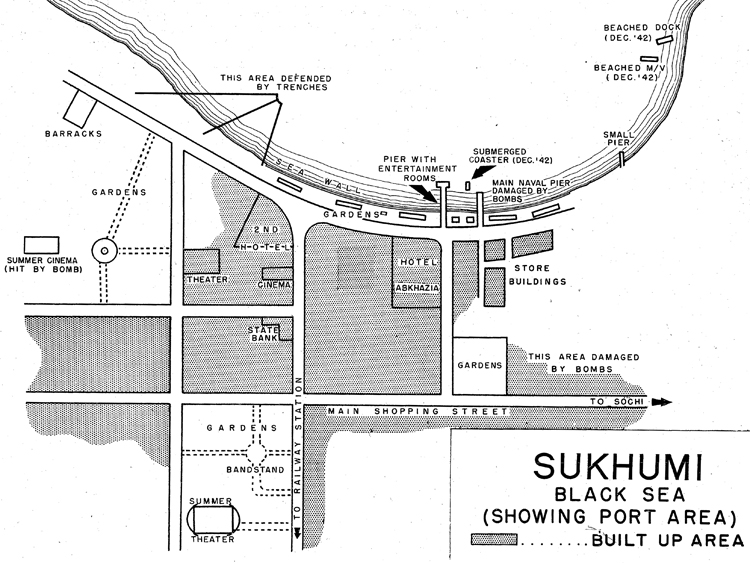

Sukhum - view of pier.
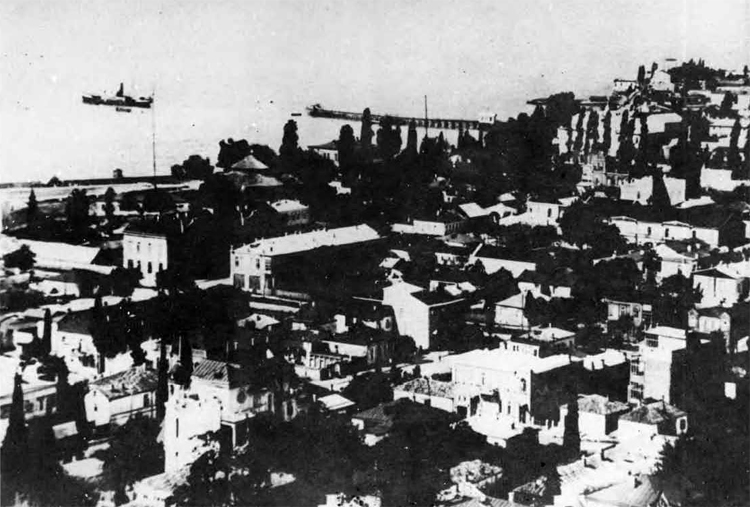
Sukhum - view of pier
1 VII. Ochemchir (42°44'N., 41°25'E.)
Ochemchiri is a very small port; it has a pier 160 feet long, with 13 feet of water at its seaward end. Both northward and southward of this pier, coastal flats are said to be forming due to deposits brought down by the river. There is a small breakwater at either side of the entrance to the harbor, and a boom of anti-torpedo nets has been placed between them. Apparently, there are few warehouses near the port, although it was observed in Octobar, 1942, that some wooden buildings were under construction. There are no drydock facilities, but there is a small boat slip, capable of taking motor torpedo boats; . there are few, if any, repair facilities. In 1938, the entrance channel had a depth of 21 feet.
The anchorage is located about 2 1/2 miles southeast of the harbor; it is an open roadstead, exposed to southerly and westerly winds, and ia dangerous during the winter months.
Ochemchiri is used as a base for one division of submarines; in July, 19-13, it was observed that 6 tlalodka (200 tons) class submarines and one overage Bolshevik class submarine were in port, together with the submarine tender Elbruz and a small coastal steamer, which serves as an overflow ship for submarine crews.
There is a landing field and a seaplane station located here. In 1942, there were numerous shore batteries between Ochemchiri and Sukhum, which were observed firing at night.
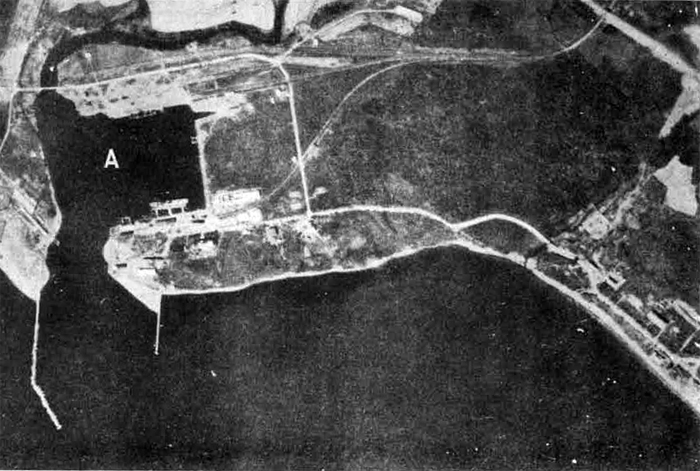
OCHEMCHIRI
Photograph taken April,1942.
A = The harbor.
VIII. Gelendzhik (44°33'N., 38°04'E.)
Gelendzhik may no longer be used as a naval base, nor that Axis forces have been expelled from the Caucasus. In December, 1942, it was observed that it was the most advanced unloading base for supplies with which to attack Novorossisk$ it was also used as a base for motor torpedo boats, motor minesweepers, coastal pat-rol vessels, and seaplanes. It was also observed at that time that there was no boom defense ab the entrance to the harbor. Because of almost constant bombing by the Germans during the siege of Novorossisk, it is impossible to estimate existing port facilities or coastal defense emplacements.
The town is situated on a round bay, with a fairly wide entrance. This entrance is about 1 mile in width. Anchorage can be , ' ' obtained in a depth of 5 1/4 fathoms in the southeastern corner of the bay. The bay is exposed to winds from the southwest and northeast, and winds from seaward send in a heavy sea. In normal summer weather or during southerly winds, a fairly strong current sets northeastward across the entrance to the bay.
There were several piers at Gelendzhik but none of them had sufficient depths alongside to be of naval use. Near the lighthouse., however, there were the foundations of a pier, unfinished in 1938, consisting of 3 large dolphins. The outermost of these dolphins lies about 1 cable off-shore with a depth of 3 1/2 fathoms alongside and had a mooring bollard on it. There was a small jetty in the northern corner of the bay.
C. NAVAL BASES IN THE FAR EAST
I. Vladivostok (43°05'N., 131°51'E.)
Vladivostok is the mostfc important city and port of the entire
Soviet Far East as well as having been and perhaps still being the chief naval base and shipbuilding yard. Because of the fact that in case of war with Japan, Vladivostok would doubtless become completely cut off, if not actually occupied by Japanese forces, the Soviet authorities have been developing the naval installations at Petropavlovsk with a view to making it supplant Vladivostok altogether. It is not known whether Petropavlovsk has?, as yet, supplanted Vladivostok as the primary Soviet naval base in the Far East, although construction started at Petropavlovsk as early as 1940. It is known, however, that the headquarters for the Soviet Pacific Fleet are still at Vladivostok.
Vladivostok has a fine natural harbor, and although this area is covered by ice for about 2 months a year, a channel is kept open at least as far as the commercial harbor by port ice breakers. The inner part of Golden Horn Bay is frozen on an average of 86 days a year, starting toward the end of December. The maximum tidal range at Vladivostok is.2-1/2 ft., and the bottom is mud, giving good holding ground. The harbor is completely protected in bad weather, but during the summer months, the approach is complicated by fogs which are particularly prevalent during June, July, and August, and which average 51 1/2$ foggy days. During the 9 months of open navigation,this average figure is 21%.
Vladivostok is a highly developed shipbuilding and ship repair yard as well as being a naval operating base and strongly fortified zone. The shipbuilding and ship repair facilities are mostly located in Vladivostok Harbor itselfj in the eastern reaches of Golden Horn Bay; naval operating bases are scattered throughout the various bays and inlets in the vicinity*
Commercially, Vladivostok is the most important port in the Soviet Far East. In 1943, the Russians officially stated that this port could accommodate 35 ships simultaneously and that depths alongside the wharves ranged from 25 ft. to 30 ft.; they added that* together with neighboring ports, 200,000 tons of freight could be handled monthly here.
It has become a fairly well-established fact that the entire Soviet Pacific Coast is tinder the control of the navy; this indicates a very great departure from the usual Russian custom of placing the navy in a very subservient position to that of the army. In 1941 > it was seen that the navy had its own telephone and power lines; sailors were observed doing all manner of work, such as working on the beach, on overhead power lines, in manholes on the telephone lines, etc. Due to the shortage of automobiles, the navy used many horses and carts for transportation at Vladivostok, and sailors were seen taking care of their own horses and stables. The navy had its own dance hall, restaurants, movie houses, and swimming beach. In October, 1943, it was stated that naval headquarters were located in the extreme northwestern corner of Golden Horn Bay. There is a naval academy for the purpose of training officers for the Far iikstern Fleet; it is located near the mouth of First River (North of Vladivostok). There are also two naval training schools for specialists1 ratings; one of these is located in the northeastern corner of Golden Horn Bay,
according to a report of April 1943. According a report of October 1943, the naval receiving station in the barracks are located in this same area.
Vladivostok is a heavily fortified zone. Information concerning its defenses is necessarily incomplete and of old date. Fortifications observed in 1941 have doubtless been enlarged and many others have been constructed; therefore, no attempt is made in the following paragraphs to estimate the strength and size of these fortifications. Since the beginning of the war, stone and wood fortifications, as well as other types of defenses, have been continuously under construction. These fortifications are believed to be of considerable size.
In 1941, three anti-submarine nets were observed guarding the entrances to Vladivostok Harbor. The first of these was stretched from Zhitkov Peninsula (Russki Island) to Cape Basargin (Muraviev Promontory) It ran from the shoals of Zhitkov Peninsula approximately northeastward to the shoals off the northwesterly end of Skriplev Island; from here, it ran in a northerly direction to the westerly end of Gape Basargin. The gate/which was located at approximately 43°02f 30lftand 131° 57%was marked on the south side by a red buoy and on the north side by a green buoy. The second net was stretched between Cape Novosilski (Russki Island) and Cape Nazimov (Muraviev Promontory); the gat£ was located at Cape Ndvosilski. The third net was stretched between Cape Bezimyanrii (Russki Island) and Cape Tokarevski (Shkota Peninsula); the gate to this net Was located at the northern end. It may have been that the first and second nets mentioned never operated at the same time, but that when one was working, the other was inoperative.
The area around Vladivostok is hilly and rugged, and a great portion of it is covered by a forest. Coastal defense batteries and antiaircraft emplacements are to be found on most of the numerous hills, and smaller mobile batteries have been placed in the forests. In 1941, on the southern portion of Shkota Peninsula, coastal artillery and anti-aircraft batteries had been constructed on the slopes of the four hills, the most northerly of these being Mt. Krestovaya. Farther to the north, at Mb. Tigrovaya, large caliber long-range guns were located; in June, 1941, three heavy high-altitude guns were seen at this point. On the western shore of Shkota Peninsula, anti-aircraft batteries were . seen near Cooper Point; a minimum of eight batteries were' also seen in the immediate vicinity of Coastal Trade Harbor. North of Vladivostok city, heavy coastal artillery guns as well as anti-aircraft batteries were seen from a distance on Mt. Klichkova and on Mt. Visokaya in June, 1941. Along the southern shore of Golden Horn Bay, many anti-aircraft batteries were observed, notably to the east of Point Klet.
In the eastern half of Golden Horn Bay, which area is reserved exclusively for naval use, there are a minimum of three graving docks and one and possibly more floating drydocks. The two graving:docks known as Eastern Drydocks,. located in the northeastern comer of the bay, . have a length overall of 635 1/2 ft., a length of blocks of 618 1/2 ft., and a breadth of entrance of sill at water level of 90 ft,, and a depth of sill at H.M.W.S. of 34. 1/2 ft. Farther to the west, it was reported in October, 1943, that Old.Drydock had been restored to use and is in good working order. This dock has a length overall of 573 ft., a length of blocks of 512 ft., a breadth of entrance of sill at water level of 90'ft., and a depth of sill at H.M.W.S. of 30 ft. There may be two additional graving docks, one in the commercial port and the other near Old Drydocks, but there is no confirmation of this fact. The chief floating drydock was reliably reported in 1940 as being able to accommodate a 10,000-ton cruiser; it is possible, however, that this dock has been transferred to Petropavlovsk.
In October, 1943, it was reported that there was a military post on the northcentral shore of Golden Horn Bay. Within this post are an arsenal and Old Drydock. East of this post and extending to and including Eastern Diydocks^ are the Vbroshilov Shipbuilding Yards. Within this enclosure are located four submarine ways, as well as ways capable of constructing destroyer leaders of the Leningrad Class (2900 tons); in March, 1941 > two such units were observed under construction. In September, 1941, it was observed that,on the southeastern shore of Golden Horn Ba.y, a large community with many new installations had sprung up5 it was believed to be purely naval. It was reported in April, 194-3, that submarines are shipped to Vladivostok in parts and are assembled there.
In October, 194-3, it was reported that,at Point Egersheld, there was a fuel oil bunkering depot for both naval and commercial craft, equipped with oil tanks; oil is loaded on board by means of lines which are extended from the shore on partly submerged barges. The same informant stated that a large naval fueling station was located on the southwestern shore of Transit Harbor, He added that in the nameless bay between Point Klet and Cape Goldobin there was a fueling station to which many submarines had been observed approaching the shore; many pipes were seen here. This source stated that there were twelve large oil tanks located at the mouth of First River (North of Vladivostok).
In addition to the above mentioned installations, the Assistant Naval Attache at Vladivostok stated in July, 194-3, that there were five . regiments of NKVD (secret police) troops stationed here. Two of these, the 70th and 117th, are railway troops. Two more, the 189th and 198th, are communications or signal corps troops. The fifth regiment, the 241st, serves as guards for political prisoners. He added that there were one coast guard unit, one salvage unit of the EPRON, and a munitions works (number 92) for the manufacture of army field pieces.
In October,194-3, it was reported that a railroad has been constructed from the center of Vladivostok, extending along the entire
coast as teas Patroclus Bay, serving Diomedes Bay, Ulysses Bay, and
Patroclus Bay.
Diomedes Bay was formerly a fishing port, but it has been converted for naval and military use and the trawlers and seiners stationed here were taken over by the navy. In 1941, guns were visible on the immediate banks of Cape Goldobin and Abrosimov Point which command the entrance to Diomedes Bay.
Ulysses Bay was always used as a naval operating base for submarines and, to a lesser degree, for small surface craft. In 1941, it was observed that a new naval base was under construction, and that there were oil tanks on the southern and eastern shores; several destroyers and eleven submarines were seen in the bay at that time. In 1941, permanent anti-aircraft batteries were seen at Ostri Point, and many mobile batteries were observed among the trees farther inland.
Patroclus Bay is a former fishing port and was converted for military and naval use in 1941 according to a report of September, 1943, and trawlers, and seiners stationed here were taken over by the navy. In 1941, a modern seaplane base was observed here with anchors on the neck of land at the western end of the bay.
Kozakevich (Rasski)Island is located due south of Vladivostok and is a restricted zone; no unauthorized persons are allowed to go
there. In October, 194-3, it was reported that extensive fortifications had recently been built here and that "twelve small masts, presumably radio antenna, were visible. The same informant stated that a submarine and torpedo boat base is located in Novik Bay and that the entire bay is used for the shelter of naval units. In April, 19-4-31 it was reported that a torpedo station and training base was located at Doronin Point in Novik Bay. This informant added that the old fortress on Russki Mountain had been abandoned and that it was being used as a decoy.
In March, 1941, anti-aircraft batteries were seen on the hill due east of the Torpedo Boat Canal, north of Novik Bay. In November, 19-40, other anti-aircraft emplacements were observed from Babkin Hill on the northwestern corner of the island.
It was estimated in August, 194-3, that the following fixed coastal defenses were in existence in the area between Posiette Bay and America 'Bay: 15 heavy artillery 2-gun batteries, 30 152 mm. 4-gun batteries, and 30 76 and 85 mm. 4-gun anti-aircraft batteries; this would indicate that a total of 11,250 officers and men ware employed on fixed coast defenses of this area.
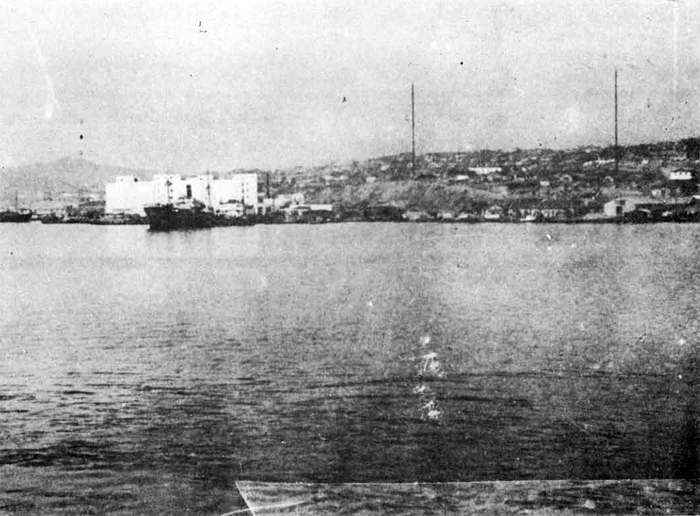
Vladivostok - Churkin Point near entrance to Golden Horn Bay.

Vladivostok - Coastal Trade Harbor in Amur Bay.
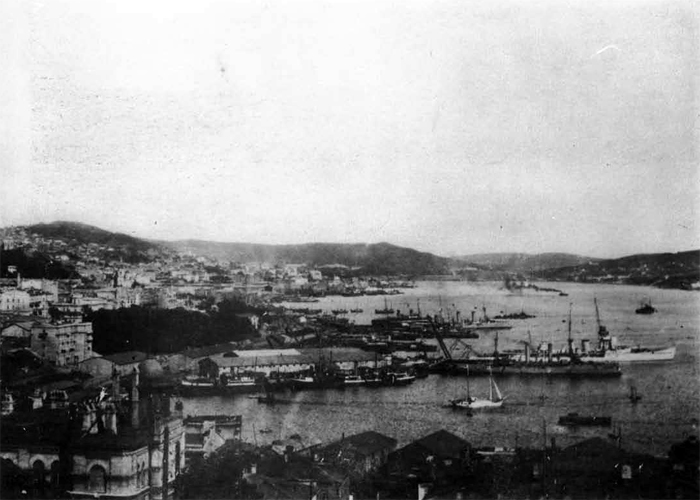
Vladivostok - Naval Base in Golden Horn Bay.

CHART OF VLADIVOSTOK
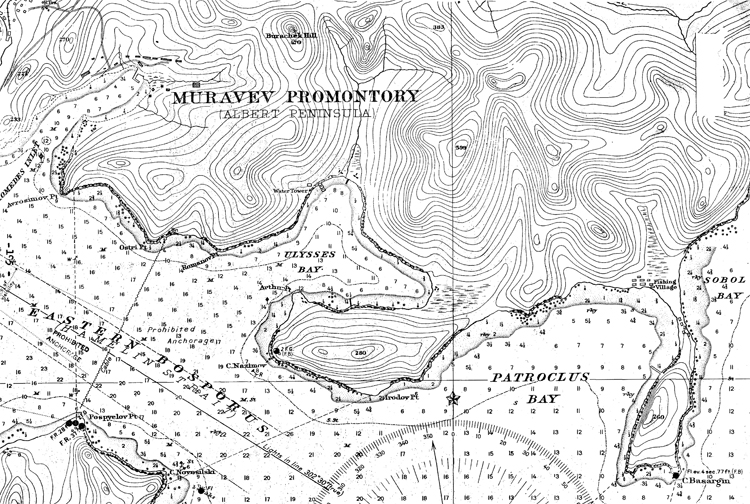
VLADIVOSTOK AREA

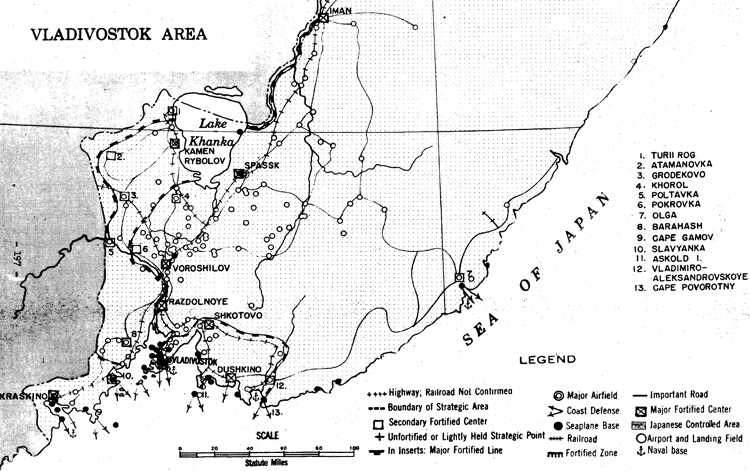
II. Petropavlovsk (53°00'N., 158°38'E)
Petropavlovsk is the second most Important, if not the most important, Soviut naval base in'tHe^eirttrs^Far East; it is the center and headquarters for the defense of all northeastern Siberia. As early ns 1940, it was reliably reported that construction on a lu.i\;e naval base was well on its way, with naval quays having been built on the eastern shore of Petropavlovsk Inner Harbor and that the naval port (on the southern shore of Rakovaya Bay) had already been equipped with a small repair yard, electrical workshops, and laboratories and a telegra; h station. YJhether Petropavlovsk is ca-able of accommodating the entire Soviet Far Eastern fleet, at the present time, is not known, as the Soviet authorities have consistently refused to allow our attaches accredited to the U.S.S.R. to inspect naval bases, or, for that matter, to even visit any portion of the Kamchatka Peninsula.
Although there is no confirmation of the fact, the chief naval base is probably located at Tarya (Tarinski) Bay, or more exactly, in Yagodnaya Bay (Wie easternmost extremity of Tarya Bay) . This is the only place in Avacha Bay which has a combination of a sufficiently large area, sufficient water, and which is adequately isolated from the corjnereial port. In September, 1941) it was reported that there was a submarine base on the northwestern shore of Yagodnaya Bay, equipped with five finger piers. It is believed that a breakwater has been built across the entrance to this large, well-sheltered harbor to further protect it from swells and to insure a quiet and secure anchorage.
Ice conditions in Tarya day are exceptionally favorable. ,Vhen the other bays within Avacha Bay are icebound, Tarya Bay is usually open because of the warm water rivers and lakes which surround it.
At I'arya Bay, the chief seaplane bases of the Soviet Kar i&stern fleet are located (in Seldevaya Bay and Yagodnaya Bay).
It is possible that one of the floating drydocks reported to be in iiakovaya Bay is in Tarya Bay. Three shipways have been reported here, with large machine shops and ship chandlery establishments at each.
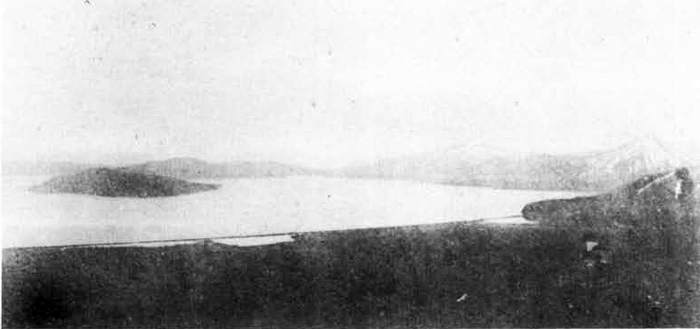
General view of Tarya Bay and Island Khlebalkin. Looking east.


Northwest coast of Tarya Bay and Kozak Cape.

Lower left—eastern part of L. Blizhneye. On the right parts of Tarya Bay and Avacha Bay. In the background, the spurs of Klkhchik Mountains.
Hakovaya Bay contains the major shipbuilding and repair facilities of the port. The Kamchatka Shipbuilding and Ship Repair Yard is located on the northeast side of the Bay. The repair section with the usual shops was completed in 1937, but the shipbuilding section was still under construction in 1941, and its completion has not been determined. At that time, a ship repairing slip with lifting apparatus and three building slips were given as part of the facilities.
Of the three floating drydocks which scanty information indicates may be at Petropavlovsk, it is likely that the largest is installed at Rakovaya. A minimum of one is known to be in operation, large enough to accommodate at least a vessel of 3.211 tons light, and of 442 feet in length. This is probably the welded dock which was built by the Marty Shipyard at Nikolaev (on the Black Sea) and towed from that port to Petropavlovek in 1938. Specifications published at that time were:
Capacity 5,000 tons; Length 420 feet; Beam 100 feet;
Upon its arrival at Petropavlovsk, the official Soviet press announced that it had been placed under the administration of the People's Commissariat of Food Industry.
Another floating dock of 5,000-ton capacity and a third of 1,000 tons, transferred from Vladivostok, have been reported here.
It has been reported that the seaplane base of the Kamchatka Naval Frontier Guard is located at the northeastern end of the Inner Harbor of Petropavlovsk port, with hangars, oil, and other stores, repair shops, and even with facilities for assembling aircraft and that naval quays line the eastern side of Inner Harbor; due to the obvious congestion of th« port, it seems hardly likely that these installations still exist at that location.

Petropavlovsk Harbor and City

Petropavlovsk. Petrovakaya Mt. on the background, Signalnaya Mt. on the left.
One source, in September, 1943, stated that a submarine base is located in the area between the mouth of the Avacha River and the village of Mokhovaya in the northern reaches of Avacha Bay; this is the first indication of a submarine base in this area.
Several sources report the existence of a boom defence barrier at the entrance to Rakovaya Bay; a similar barrier may have been placed at the entrance to Tarya Bay. The entrance to Avacha Bay has been mined.
The primary military base on Kamchatka is located in the area of Petropavlovsk. It is estimated that at this base there are five heavy artillery (2-gun battery) installations, twelve 152 mm. (4-gun battery) installations, and six 76 and 85 mm. anti-aircraft (4-gun battery) installations. This would mean that 3,4-50 officers and men were employed in coast artillery emplacements at Petropavlovsk.
It has been definitely confirmed, that coastal artillery positions are located at the following places: Cape Sarannyi, Starichkov Island, Cape Bezymyanyi, Cape Srednyi, Stanitskii Point, Cape Uglovoi, Izmennyi Bay, Cape Vertikalnyi, and two emplacements north and south of Cape Pervyi. There are probable coast artillery positions in the following areas, although their existence has not been confirmed: Cape Opasnyi, in the fortified zone north northwest to south southeast on the hills east of Petropavlovsk, and at Cape Nalacha.
As far as is known, there are no installations, as yet, on Cape Mayachny (the northern entrance point to Avacha Bay). It was seen, however, that on May 28, 1943 some construction work was underway. Three large trenches had recently been builtj their positions command a view to the southeast. The exact functions of these trenches could not be determined, but it may be that the Soviet authorities are intending to emplace additional coast artillery turrets in them. They are connected with the beach and village northwest of Cape Mayachny by a newly made, low standard, unsurfaced road; there may be another road to Rakovaya Bay, although the terrain through which it would have to pass is prohibitive.
In addition, the entire area of the coast line from Bechevinskaya
Bay northeast of Petropavlovsk to Cape Krutoi to the south is a fortified area. Petropavlovsk is the base for the 101st Infantry Division,
the 1st Independent Kamchatka Coast Artillery Brigade, the 60th Frontier
Guard District Headquarters (of Battalion strength), a Frontier Guard
Regional Headquarters (of Company strength), as well as being the most
important naval base on Kamchatka and a frontier guard patrol base.
In the area of Petropavlovsk there are two airdomes and three sea
plane bases.

III. Komsomolsk (54°34'N., 137°00'E)
a. In General* Although Komsomolsk is probably used to a certain degree by the Amur River Flotilla, its chief importance as a naval base is that of a shipbuilding and ship repair yard; units up to 8,000-ton heavy cruisers are built here.
Construction first began on Komsomolsk in 1932 at the site of the old village of Permskoye, about 230 miles down the Amur River from Khabarovsk; at the present time it has a population of about 110,000. Komsomolsk was built because,in case of war with Japan, the chief Soviet shipbuilding yard in the Far East at Vladivostok could quite easily be entirely cut off, if not actually captured. In addition, this city was founded to tap the rich natural resources of the surrounding area of gold, coal, iron, timber, fishing and furs. It was also the plan of the Soviet authorities to develop,in this area,a self-sufficiency for the Soviet Far Eastern forces. The most important industry here is the iron and steel mill known as Amurstal. The construction of this mill, about 5 miles from the city, began in 1935 and the plant has a planned capacity of 400,000 tons of pig iron annually. Other industries,, reportedly here, are several machine building plants, a cement works, paper and cellulose factories, a railway car repair shop, 2 brick factories, etc.
b. The shipbuilding yard was commenced about six years ago and has had greater emphasis placed on it since the outbreak of war, due to the exposed positions of the shipbuilding facilities in western Russia.
As might be expeeted, the city and the shipbuilding yard with all its adjuncts have been thrown up in a gimcrack fashion even for the USSR, due to the lack of materials and the urgent need for haste. Conditions for the workers are most primitive and would be considered little less than savage by American standards. For Russian workmen, they are bearable, there being no alternative, and work goes on, although at a much less efficient pace than would be the case in a similar American establishment.
The buildings of the shipyard are of locally made brick, plastered and painted white outside. The buildings are well spread about, two to three hundred yards apart»in some cases. Roads are dirt or cobblestone. Railway spurs run into or alongside all the large shops* A great quantity of material, evacuated from the western areas,is lying about in large piles, much of it junk and*little of it usable in a shipyard. The manager remarked that the selection of material for evacuation was made amid bursting bombs and in face of imminent capture by the Germans. It was very much like the frantic householder, rescuing his belongings from his burning house, throwing the chamber pots out the window and carrying the pillows downstairs in his arms.
Windows of all buildings, after the Russian custom, are double, to keep out the 40-50 degree winter cold. Buildings ways are covered so that work may continue 12 months a year. They are steam heated, from a central plant.
It is probable that no ship launching could be made between the end of December and the 1st of March, due to the freezing of the basin and the Amur River. Freezing of the river at Nikolaevsk (the mouth) commences on the 1st of November and ice breaks up about the 15th of May.
The manager of the yard said they receive steel plate and similar material from sources outside Komsomolsk. In September, 1943, there was a rather considerable supply of plating, flat sheets 30 x 81, thicknesses 4 to 10 mm, stacked outside the rolling mill* There is a railway spur near the yard, along which were about five hundred or more six foot plugs of slag, several feet thick, apparently off the top of a ladle of hot metal, in September, 1943, probably a product of the Amurstal steel works.
In one of the machine shops, a small number of lathes and shapers were in use for other than shipbuilding work. Several hundred cases for 100 lb. bombs were being turned from steel castings, made in the foundry. A small amount of chain for harvesting combines was being made. They accepted such small orders in view of the lack of enough materials to keep the plant fully employed on shipbuilding and also in the interests of efficiency in supplying local demands for small articles in small quantities. This may indicate a lack of other machine shop facilities in Komsomolsk.
Personnel at the yard numbers 5,000, 50% of which are women; about 10% of the men are 16 to 20 year-old boys. Those departments requiring heavy labor, such as foundry, plate mill and work on board the vessels building are staffed largely by men. Operators of small machine tools, office employees, and others engaged in light labor, are principally women or boys. Workers live in houses and "apartments" (little more than barracks) which are not more than a kilometer from the yard; Many have small vegetable gardens in which they grow a scrubby variety of cabbage, potatoes or tomatoes during the short summer, to augment their poor rations Recreation facilities are meagre. There is a small park with a rattletrap dance pavilion and a movie theatre.
There are two shifts of twelve hours each in those few plants which work 24 hours a day. During the middle of each shift, 1 1/2 hours are taken out for rest and eatingj the plant is idle during this period* About 30% of the plant works two shifts (24 hours daily); the rest of the plants have one 12 hour shift daily* Lack of material and labor is probably the reason for lack of full time operation.
As a whole, the labor may be classed as inefficient and unintelligent. Judging from the amount of activity in the various shops and the number of idle machines, it is estimated that the entire yard is working at not more than 20% of the capacity it would be capable of with efficient planning, good workmen and ample material* Three destroyers (40$ complete) and two escort vessels (50$ complete), have been on the ways over three years, one light cruiser (75$ complete) about 5 years. In addition to these, a small number of very small vessels have been completed or are building. For a yard employing 5,000 workmen, this is not an outstanding record, and as the shops are well equipped with a wide variety of British and American machinery, it is indicated that labor and planning are chiefly at fault.
c. Shipbuilding ways: there is a total of six, all enclosed in two brick buildings with very large glass skylights and windows. There is very little shop equipment in these buildings other than cranes and portable gear for fitting out ships. In one building, there are two ways, one approximately 650 ft. x 80 ft. and the other approximately 450 ft. x 80 ft. The heavy cruiser KAGANOVICH is in the larger of these and six steel antisubmarine vessels, about 210' x 17' each,
are in the smaller one. The secona building contains four ways, one 250' x 501 and three each 350f x 801. The smallest of these is empty; one of the larger ways contains the escort vessel, ALBATROSS, another contains one destroyer, and the last one contains two destroyers. All of the ways are made of concrete, with ends closed by a steel gate. Launching is done by flooding the ways.
No railway cranes were noted inside the covered ways, and it is believed that all handling is don© by overhead cranes; there is one of these over, each way.
d. Fitting out basin; It is probable that ships are almost entirely completed while in the ways, as the fitting out basin has no facilities other than a fifty ton floating crane. There is not even a suitable pier. Due to the fluctuations in river level, ships are tied up to pontoons.
e, Shops:
1. Mould loft; About 700 by 80 ft., without any pillars or such obstructions. It is very well lighted by large glass double windows and by electricity. There is an elaborate heating installation. No project was in evidence in September, 1943, but a number of battens were lying around.
2. Sheet mill: There are six radial drills here for boring rivet holes in plates and two very large sets of rolls for shaping and curving plates, about twenty-five feet long; there are two smaller such rolls. There is a lathe for turning propeller shafts. One of the two shafts, for the cruiser KAGANOVICH, was in this lathe, but no work was being done on it; its length is about 150 feet; estimated diameter is about one foot. Two 3 bladed bronze one piece propellers for the KAGANOVICH were being machined. The manager of the plant said they had been cast elsewhere. Destroyer propellers were the largest one-piece propellers that could be castad-here. All heavy machinery in this shop is British made. About 50 four to six foot lathes, shapers, and screw cutters were in the same shop; they were practically all American made. There was little activity in this shop, with the exception of several special jobs being done on the smaller lathes, and several plates being bored for riveting.
3. Galvanizing shop; It is connected to the above shop, and is fitted to electroplate pieces up to 30 x 31 x 21. It is said very little galvanized material is used in any part of the ship. No galvanized parts on any of the ships tuilding were observed in September, 1943.
4. Foundry; About ten gas furnaces of small capacity, possibly 1,000 pounds, were being,used in September, 1943, for casting large bearings, bomb cases and ship fittings; there was one electric furnace of several ton capacity, but it was not being used. There was sand in moulds tamped with an electric tamper; this sand is locally obtained and appears to be of exceedingly poor quality. There is a mixer and grinder for renewing and reworking old sand and for conditioning new sand, as well as about six steam hammers, operated by women with the work being handled by men. There is one fifty-ton hydraulic press.
5. Machine shops; They are contained in two buildings, about
400 fx 175!, floor space being filled with lathes, milling machines, and similar small machine tools. A separate room, attached to one of these building, contained about six large grinding machines, the only ones seen in the yard in September, 1943.
About fifty percent of this machinery is operated by women. Seventy five percent of the machines were idle. Practically all of the
machinery was American.
6. Carpenter shop; It is engaged mostly in manufacturing a small
amount of wooden furniture and wooden cabinets, apparently for use
in the ships. One not particularly well built 18' cutter had just
been completed; the shop was almost entirely idle.
7. Stock rooms; They are contained in a very large building, about
250f square. They are filled with ship fittings, valves, pumps,
linoleum, wire, cable, boatswain's stores, machine fittings, sheet
metal, pipe/ small electric motors, condenser tubing, fans, boiler
spares, diesel generators and spare parts. The manager of the
plant complained of a lack of small fittings, such as valves,
screws, bolts and electrical fittings. The problem caused by a
lack of standardization due to the influx of foreign equipment was
a very troublesome one.
f. Shipbuilding; The hulls, decks and superstructure of all ships,
including the cruiser, antisub, destroyers, submarines, and subchasers are all riveted. No welding could be seen topside other
than several deck seams on the forecastle of the KAGANOVICH and
the very seams on the KAGANOVICH and destroyer deckhouses. On the deck of the KAGANOVICH,there were about fifteen welding machines, with wires being led below decks, indicating that the interior construction includes a considerable amount of welding. Even the small topside fittings like ladders, stanchions and deck fittings were made of castings and were riveted in place. In most new construction, the bare metal remained, without any protecting coat of red lead or otter preservative; consequently, there was a considerable amount of superficial rust of all metal surfaces, except on the guns, as a result.
g. Prefabrication; The KAGANOVICH1 s after deckhouse was being as
sembled on the main deck aft abaft number three turret in September,
1943, and was to be lifted into position by the overhead crane when
ready for installation.
h. Protection of the Yard; The yard is fenced with barbed wire and passages through the gates are guarded by civil employees. There are no troops stationed in the compound except a small detachment of 50 sailors manning multiple machine gun anti-aircraft installations. The total guns seen in September, 1943, were about six quadruple 30 cal. (approximately) Maxims. One quadruple mount was carried on a truck. Some of these sailors were working in an excavation near one of the covered ways and may have been preparing a position for a larger gun. There is no blackout at Komsomolsk and no provisions for it yet installed in the buildings. There is no camouflage except the painting of some of the buildings white to blend in with the winter snow.
It seems strange that there is not more adequate protection for Komsomolsk, which is, of course, within easy bombing range of Manchuria. Any knowledge of Soviet facilities or shipbuilding would be of considerable interest to the Japanese, or to any other potential enemy. This, coupled with the Soviet fetish for secrecy,
has closed the majority of the Far Eastern Territories to foreigners
for some years.
i. Policy; It appears from the lack of material furnished this plant that maximum effort is being lavished on the equipping of the army, allowing construction in the fleet to languish. This is reasonable, in view of the preponderance of allied surface sea power and the small difference the addition of a half dozen small ships would make in the balance of world sea power, particularly in the Far East.
The yard will be available for ship construction on a moderate scale when materials are obtainable, but certainly will not be as overall a desirable location as some of the western shipbuilding areas. Raw materials must be carried from a great distance• Labor will remain a problem due to the small local production of consumers1 goods and food. The limiting depth of the Amur River to Komsomolsk will adversely affect both inbound shipping and the launching and sending to sea of large units in the completed state. As a supplement to the western building yards, Komsomolsk may eventually be useful in producing small ships such as tugs, fishing boats, river vessels, barges and gunboats for use in the Pacific.

KOMSOMOLSK SHIPBUILDING YARD
IV. Nagaevo (59°31'N., 150°35'E.)
Nagaevo, the only navnl base of any consequence in the Sea of Okhotsk, is classed o.s an MiirT anchorage. It is easy of access, and fog, which is often dense at the mouth of Tauisk Bay, is usually light and thin in the harbor. Although the presence of ice ^enernlly closes Nagaevo to navigation from December until April or May, it is possible that it could be kept open most of the year by the use of ice breakers. The depth of water at the entrance of the harbor is 18 fathoms. This depth decreases to 10 fathoms at the head of the bay, the shores of which are steep-to. There is a tidal ran^e of 10 to 16 ft.; a small tidal current runs west to east.
Soviet authorities stated in 1943 that commercially, iJa;:aevo could handle 75,000 tons of ftvight a month between raid May and mid December. The chief commercial importance of ilapaevo lies in its being an oil storage port and the port serving the extensive gold fields of the Kolyma Valley.
Machine shops and a small drydock are available at Nagaevo. There is also a small shipbuilding yard, reportedly capable of constructing motor launches and tugs and equipped with 3 slips, 2 160 ft. long and 1 65 ft. long. Little information is available on the naval base at Nagaevo, although it is believed that this port is used as the chief base for the Sea of Okhotsk Flotilla, as well as for an operational base of the Far Eastern fleet proper. In 1941, the naval base existed along the southern shore of Nagaevo Bay; as many as 2 or 3 destroyers and half a dozen submarines were seen there at that time. Reports indicated in the past that the Russians were going to move the naval base to Gertnera Bay on the other side of Staritski Peninsula, thereby insuring complete secrecy of the movement of naval units; this seems hardly feasible, however, because there are shoals approaching the entire coast of Gertnera Bay. Nagaevo is also a Frontier Guard patrol base.
It is estimated that Nagaevo is defended by two heavy artillery (2-gun battery) emplacements, four 152 mm. (4--gun battery) emplacements, and four 76 and 85 mm- anti-aircraft (4-gun Battery) emplacements. Nagaevo is within a fortified area; this area extends from about Ostrovnoi Point in the west to Kharbi2 Point in the east. Military strength in the area consists probably of one composite brigade, which operates along the highway which extends northward to the Kolyma River; it also operates at Ola, as well as at Magadan. In addition to the brigade, there are two Frontier Guard detachments, one of battalion and one of company strength, two aerodromes, and one seaplane base. Two coast artillery battalions are probably stationed here. There is one Frontier Guard detachment of company strength at Ola and another (5-40 men strong) on the northern coast of Adyan Bay, southeast of 0la.
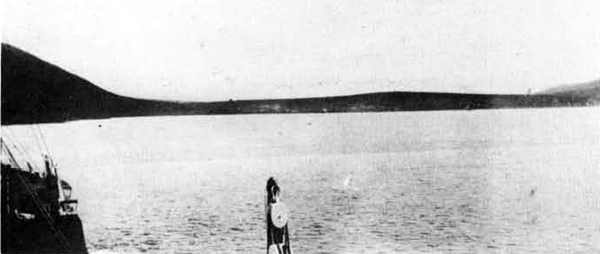
Nagaevo Bay
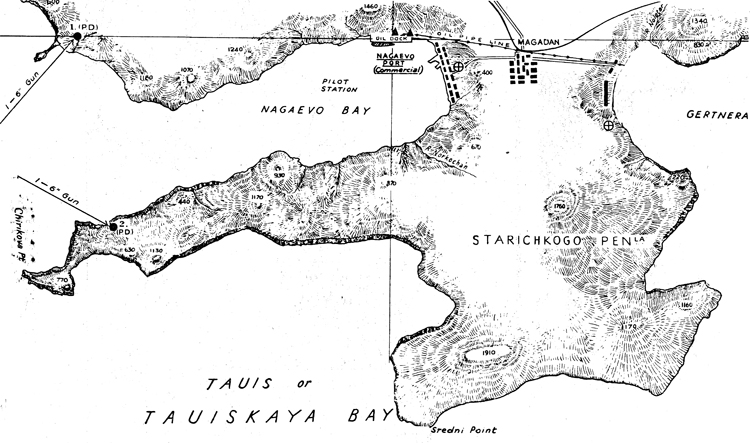
Nagaevo

Nagaevo - Commercial port {east of oil port).
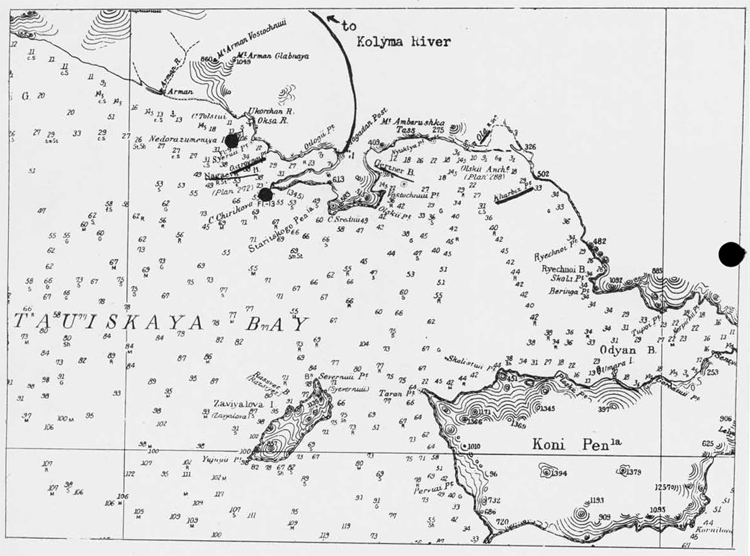
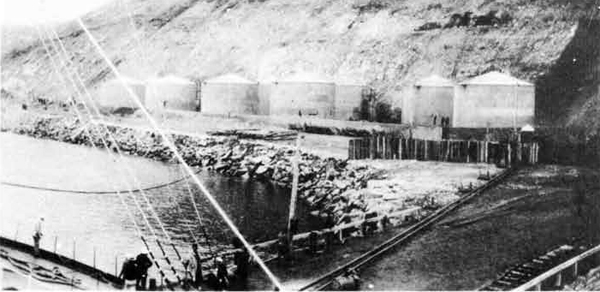
Nagaevo - Western Portion of Oil Port.
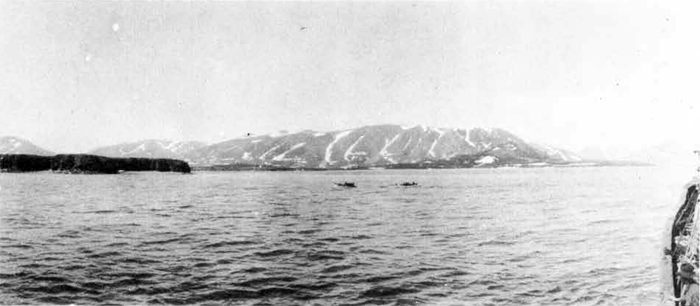
Tauisk Bay.
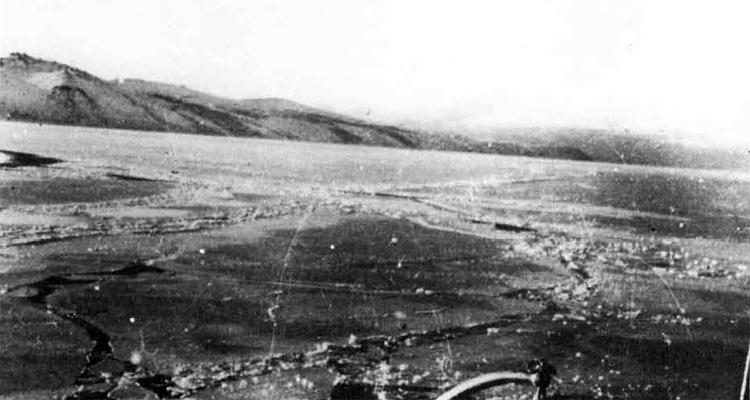
Nagaevo Bay - Ice forming in November.

Nagaevo - Kolyma River Highway.
7. Naval Bases of Secondary Importance in Maritime Province.
(a) Posiette Bay is located about 60 miles southwest of Vladivostok, not far from the Korean frontier. It is the only bay of consequence on the Soviet Far Eastern coast, which is open to navigation all the year round. It is about fifteen miles wide in an east and west direction, from which lin« it extends northwestward for about eighteen miles. Fogs are more frequent in spring and summer, June and July-being the worst months. There are two naval bases in this bay, on* in Novgorod Bay, in the western part, and the other in Trinity Bay, in the eastern part.
1. Novgorod Bay is about 6 1/2 miles long. The naval base, which is used operationally by submarines and motor torpedo boats, and perhaps by larger units, is believed to be located in Postova Bay near the entrance to Novgorod Bay on its northern short. There is a depth of five fathoms in the entrance and 3 1/2 fathoms farther in; its western half is occupied by a shoal bank, iteports indicate that it is equipped with quays, repair shops, a power station, a W/T station, and the buildings of the headquarters of the base. This naval base is connected with Krasklno, a major fortified center, off the northern coast of Expedition Bay, by a motor road; Kraskino has railway connection with the main Trans-Siberian system.
There are a naval seaplane and a commercial seaplane port in Postova Bay, the former being northeast and the latter southeast of the naval base. There are many land based air bases and landing fields here, the most important one being at Kraskino.
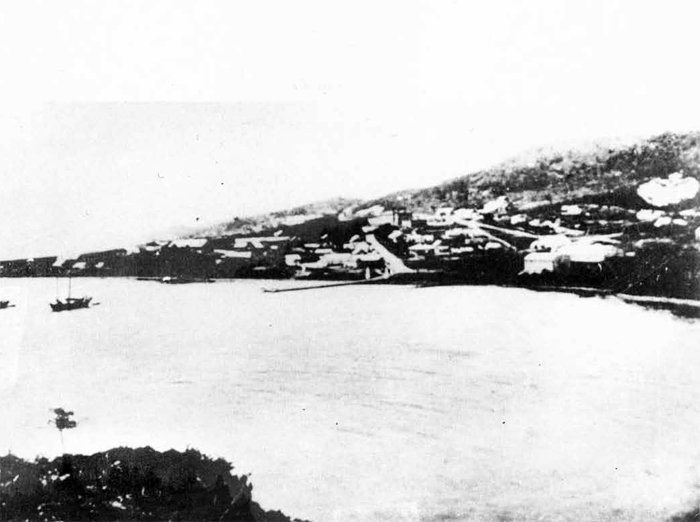
Expedition Bay, just southeast of KPASKINO


Probable position of Naval Base at Postova Bay
2. Trinity Bay, whose entrance is nearly 1,800 yards wide, recedes about three miles to the northward. It serves as an anchorage for submarines and coast patrol craft. It is believed to possess strong defenses and to be equipped with anti-aircraft ins (.allatioi^ as well as to have three searchlights placed on the cape at its head.
(b) Usauri Bay is a large bay located due east of Vladivostok, where there are tiro minor naval operating bases; one of these is located in Mnravinaya Bay, in the northern reaches of Ussuri Bay, and the other in Sukhodol Bay, on the eastern shore of Ussuri Bay.
1. MuraTinaym Bay is a minor submarine and motor torpedo toat operating base equipped with some repair facilities; its defenses probably Include coast artillery and anti-aircraft batteries, but their location and extent are not known. The center of a major fortified area is located at Shkotovo, on the northeastern shore of this bay.
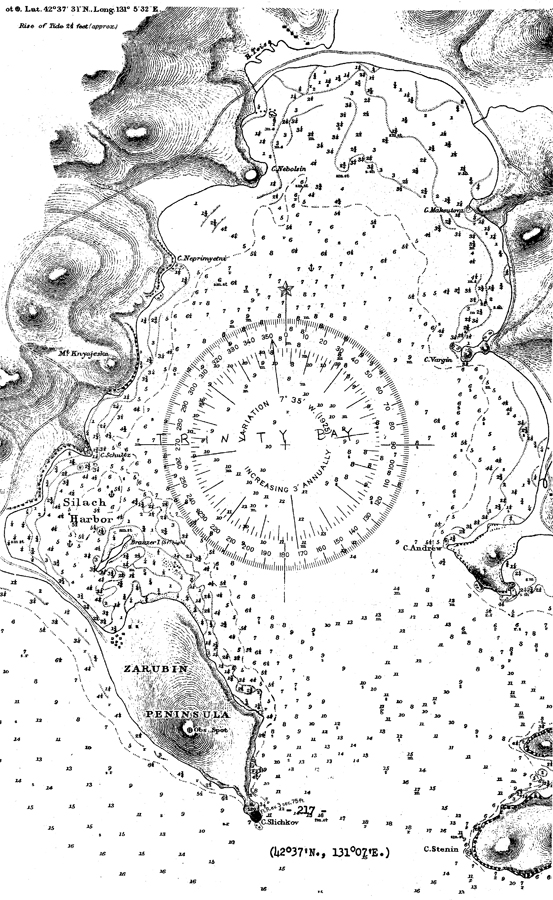
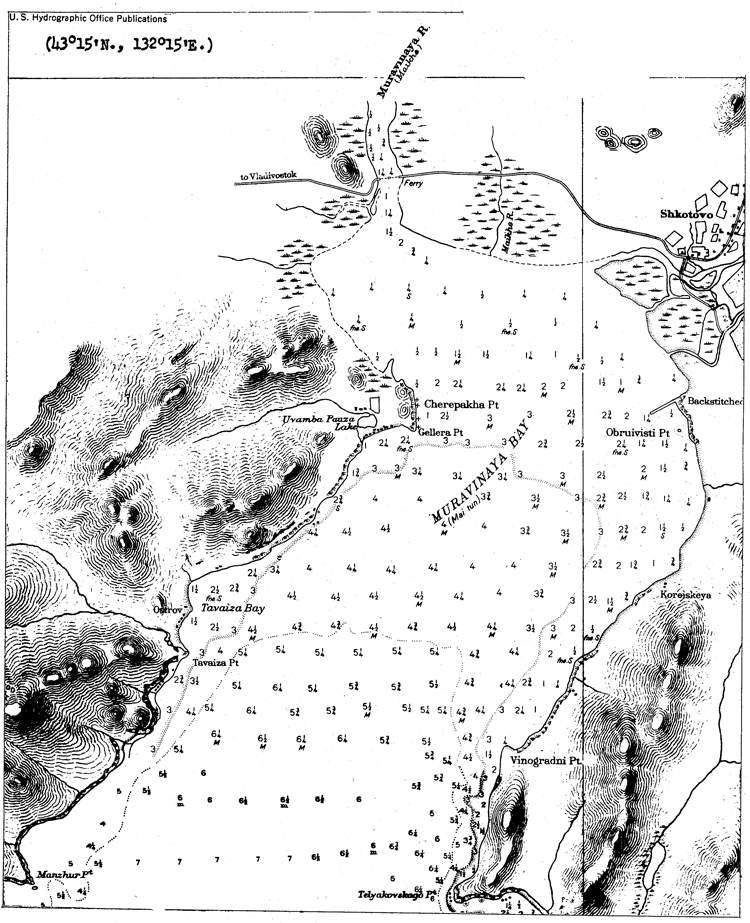
2. Sukhodol Bay is a minor operating base for submarines and motor torpedo boats, located abont 25 miles northeast of Vladivostok^ it can probably undertake minor repairs only. Its defenses possibly include coast artillery and anti-aircraft emplacements, but their location and extent are not known.
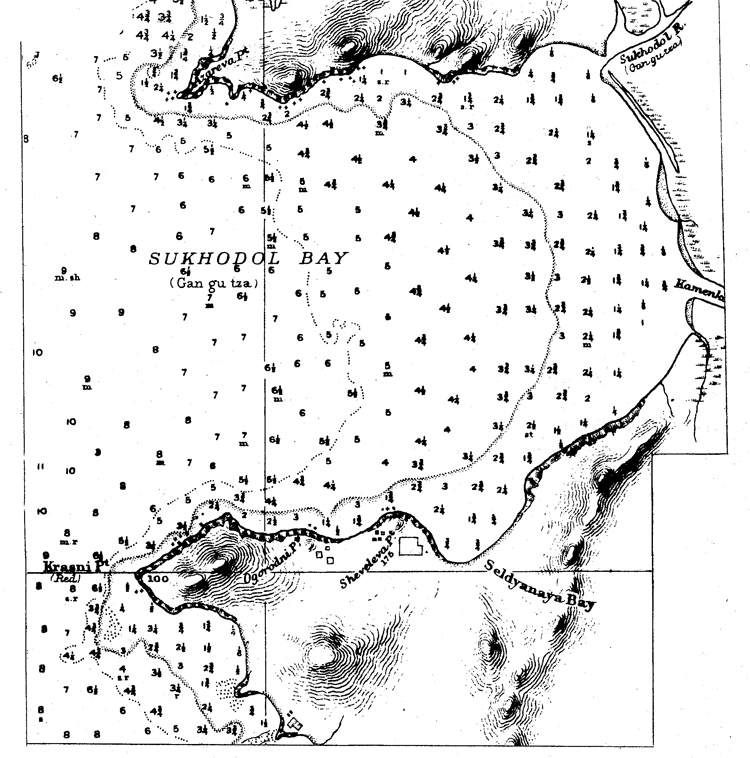
(c) Strelok Bay is located due east of Ussuri Bay; it is about 6 1/2
miles Hong. Fogs are frequent at the entrance to the bay but seldom
ex-bend to its northern reaches. Strelok Bay only freezes at its northern end, and then, for only about 2-3 weeks a year during the most intense cold. In March, 1941 it was observed that this bay was apparently being used as a destroyer operating base; at the same time, much
activity was seen on Askold Island south of Strelok Bay and that there
was a destroyer operating base or dock in Nayezhdik Bay on its southern shore. Askold Island is believed to be heavily fortified with coast
artillery emplacements.
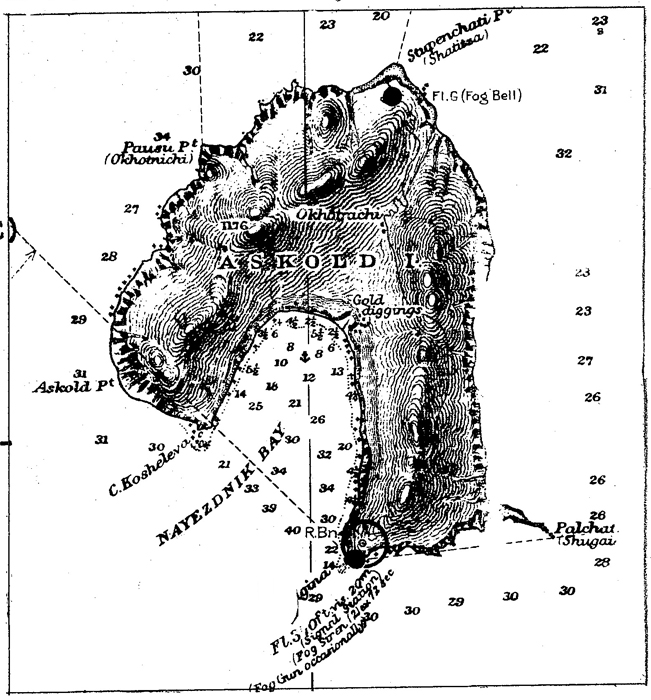
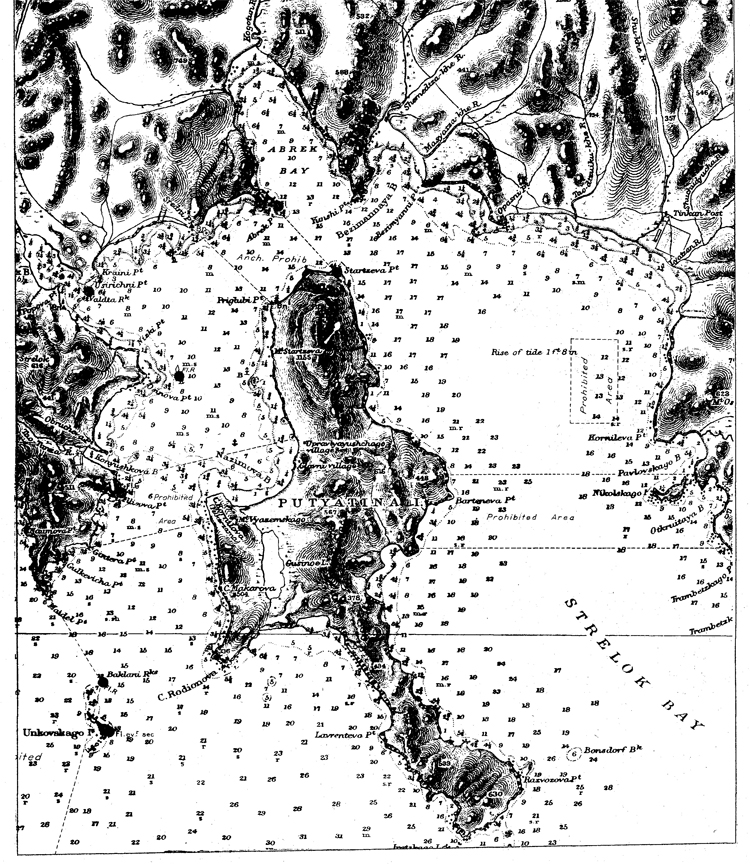
(d) Vostok Bay is located about 7 1/2 miles east of Strelok Bay, and is 3-4 miles wide. It has a depth of 11 to 15 fathoms of water at its entrance and 5 to 6 fathoms near its head; it is completely open to southerly winds. In Karch, 1941, it was observed as being used as a destroyer operating base.
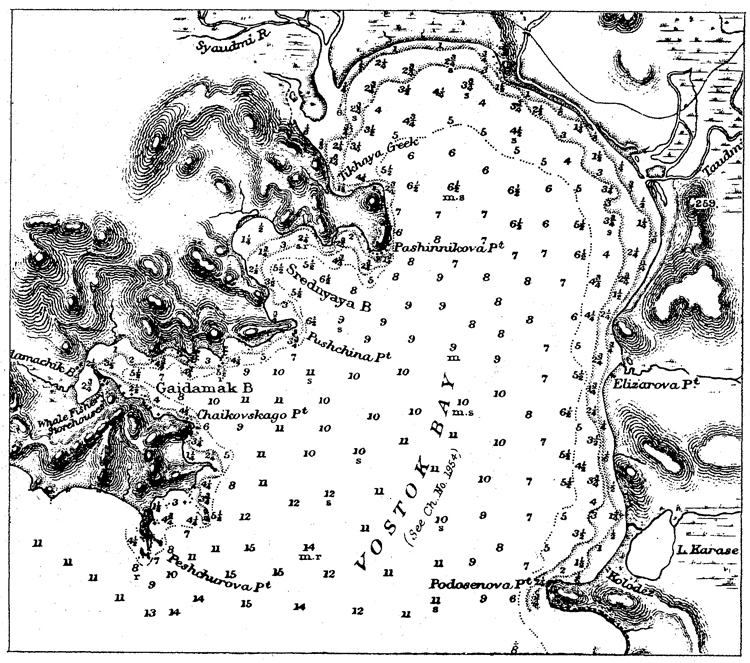
(e) America Bay, which is located about 5 miles east of Strelok Bay, is 6 to 7 miles wide. It is open to southerly winds in summer, which throw in a considerable swell. There is a tidal variation of about 2 ft. Nakhodka Bay is located in the 'northwestern portion of America Bay; it is about 2 l/2 miles long. It is a narrow inlet, surrounded by hills, and is generally frozen over from December until March, but is almost entirely free from fog, however. There is good anchorage here at all times; it has depths of 3 1/4 to 4 3/4 fathoms of water.
Commercially, Nakhodka Bay is important as a subsidiary port of Vladivostok, landing Lend-Lease supplies destined for the Russo-Ger-man front. It has recently been connected by rail with the Trans-Siberian system.
Nakhodka Bay is a submarine and torpedo boat operating base. In 1941, it was reported that America Bay was apparently being used as a destroyer operating base; it was also believed that it was protected by an anti-submarine net. Eeavy fortifications exist at Povorotni Point, probably at Kruilov Point, and in the Arsenya Mountains northeast of America Bay.
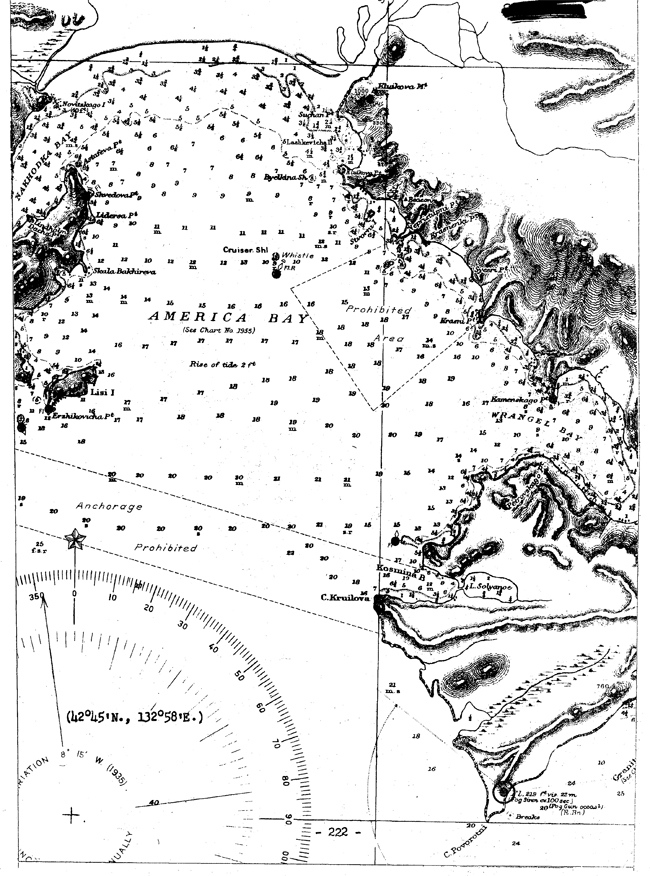
There is a seaplane base on the southeastern shore of America Bay with an alighting area of 2400 yards by 1200 yards, equipped with hangars, workshops, barracks, and stores. There is a landing field in the northwestern corner of America Bay.

(f) Olga Bay is located about 120 miles northeast of America Bay. It is classed as a "C" anchorage, with 11 fathoms of water over mud bottom. Fogs are prevalent here from March until the middle of July, particularly at night, but the area is frequently clear during the daytime. The Inner Harbor (Tikhaya Pristan) has a narrow entrance only 1/2 cable in width and with a depth of 5 fathoms of water; it can accommodate about 8 800-ton ships. Olga Bay is frozen over for an average of 160 days a year, from mid November to mid April, but the entrance keeps ice-free all the year round; there is an anchorage in 4 to 6 fathoms of water in Inner Harbor.
In October, 1943, it was reported that there is a submarine base at Olga Bay; it is also believed to be a minor operating base for surface craft. It is reported, that there is a permanent anchorage here for launches of the NKVD Naval Frontier Guard, and also that there is a military station with barracks, a garrison, a small pier and signal station at the northern end of Inner Harbor,
There is a seaplane base at Olga Bay. It was built between 1932 and 1935 and has hangars, workshops, fuel and equipment stores. Its. dimensions are 3600 x 1500 yards. There are two landing fields in the vicinity.
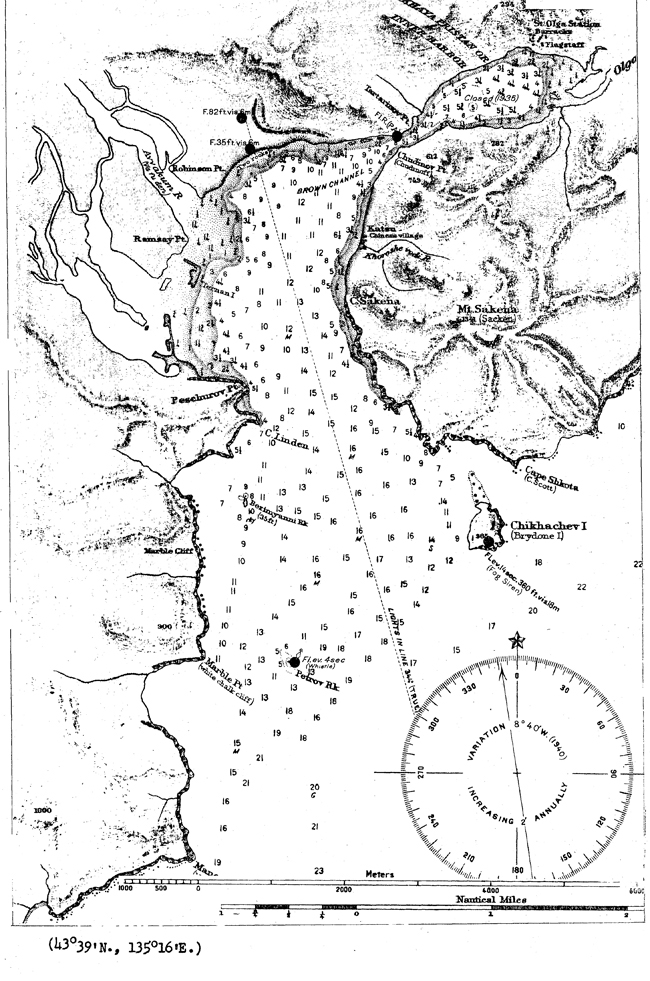
OLGA BAY
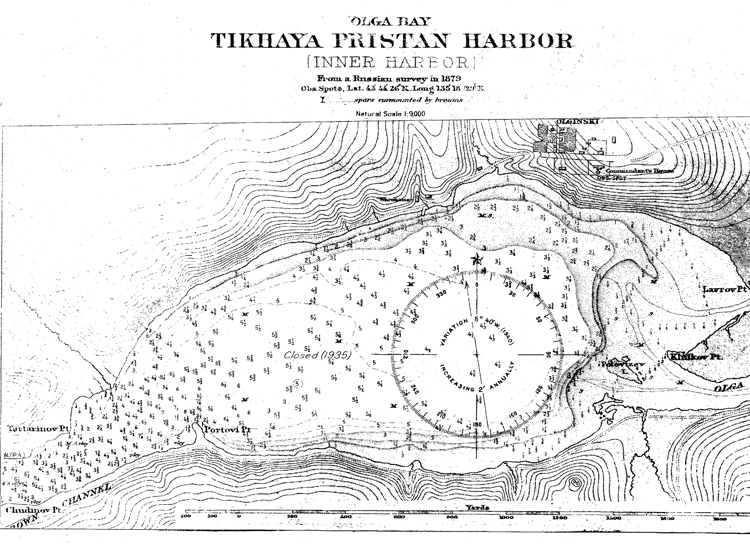
TIKHAYA PRISTAN HARBOR

Olga Bay.

Olga Bay.
(g) Tetyukhe (Tyutikhe) Bay is about 50 miles northeast of. Olga Bay.
The anchorage here is a poor one and is open to eastward, affording no
protection between April and October, when northeasterly and south
easterly winds prevail, and even during the winter, when offshore winds
might be expected; the bay is ordinarily frozen from December until
February. .
The chiei importance of Tetyukhe are the zinc, copper, and lead mines located about 26 miles from the bay. Tetyukhe is connected to these mines by a railroad. There is a pier on the northern shore of the bay, but depths alongside it are only 5 to 6 ft.; therefore all ships must load by means of lighters.
A report in October, 1943> stated that there was a submarine and military base here with considerable army personnel; this seems hardly likely, in view of the lack of a good harbor.
Along the coast between Vladimir Bay, south of Tetyukhe Bay, and Plastun Bay, north of it, it.is estimated that there are 3 152 mm. Z.-gun batteries and 3 76 and 85 mm. 4-gun anti-aircraft batteries.


Entrance to the Tetyukhe Harbor.
(h) Plan bun Bay. A renort dated October, 1943, static that there is a submarine base in rtuinda Gulf, about 30 miles nor*h of Tetyukhe; this ip the first indication of any naval installations at this point.
In Ruinda Gulf there fire two bays, Plastun on the western coyst and Dzhigit Bay in the northfirn reaches. Although eithier could be used as a submarine operating base during the summer months, it appears that Plastun Bay would be preferable. Here there is an anchorage, sheltered from westerly and southerly winds, in depths of from 6 to 15 fathoms over a rocky bottom, which is thickly covered with seaweed. KLastun bay has a diameter of about 1 1/2 miles.

(i) Grossevich Bay is located about 550 miles northeast of Vladivostok; it is sheltered by Krestovozdvizhenski Point, and provides good anchorage with a sandy bottom. Large vessels anchor in 7 fathoms of water at about 1 mile off the mouth of the Botchi River, or closer in about l/2 mile east northeastward of Krestovozdvizhenski Point; smaller vessels anchor in 3 3/4 to 4 1/2 fathoms of water, about 700 yards from th® river mouth. This bay is open to north and southeast winds, which are very strong in autumn and winter.
Although there is no confirmation of the fact, it is believed that Grossevich Bay is used as a base for motor launches of the NKVD, which patrol the coast in this area, and also as a summer operating base for submarines and motor torpedo boats. There is also thought to be a small anchorage for units of the fleet equipped with piers, protective moles, barracks, living quarters, warehouses for equipment and fuel, ammunitions duifrps, and small workshops for repairs to submarines and motor torpedo boats.
It is estimated that Grossevich Bay is defended by 2 152 mnu 4-gun batteries and 2 76 and 85 mm. 4-gun anti-aircraft oatteries; these batteries are probably located in the vicinity of Krestovozdvizhenski Point.
It. has been reported that a seaplane base is located about 2 miles northeast of Grossevich Bay hear the mouth of the Ribnaya River at l&° 00f N and 139° 30' E, and that it includes hangars, workshops, equipment and fuel stores, and has the necessary facilities for one squadron. It is reported that in 1937 this base was enlarged, 2 new hangars and increased store accommodation being added. The scale of reconstruction suggests that an air brigade will be stationed here. It was reported that by the end of 1937, 20 seaplanes of the NKVD were stationed here, one-half of which were long distance reconnaissance bombers. This seaplane base is probably intended to be a subsidiary base to Soviet Harbor base for coastal defense. There is also believed to be an airfield here, but no details are available.
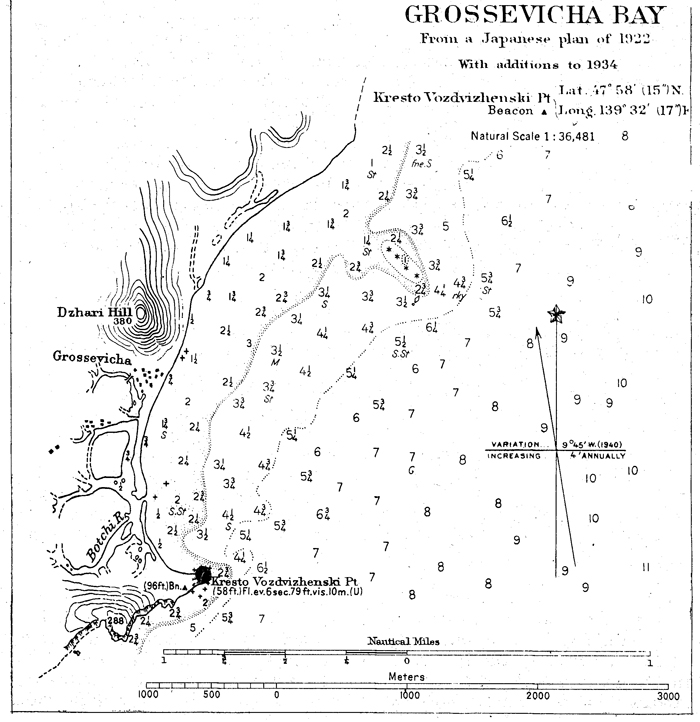
(j) Soviet Harbor (Sovietskaya Gavan) is the most important naval base and shipbuilding yard on the coast of Maritime Province north of Vladivostok. It is classed as a B anchorage, and is one of the best ports in the entire Soviet Far East. There is good anchorage in all three arms of the harbor in from 5 to 12 fathoms of water, mud bottom. Soviet Harbor is frozen over from November until April, although it may be possible to keep it open all the year round by the use of ice breakers. During May, June, and July, thick fogs are almost continuous.
Commercially, Soviet Harbor is important as an export port for timber and fish; rich coal fields are also said to be present in the neighborhood. There is a backwater for small fishing craft on the east side of Zapadnaya Bay. It is supposed that a naval operating base for both underseas and surface craft has been built, probably in the southwestern arm of Okocha Bay. Facilities here probably include bases for seaplanes, submarines, motor torpedo boats, and moles for berthing larger ships, barracks, and equipment, fuel, and war materiel.
It is not believed that Soviet Harbor has any overland means of communication with the interior.
Soviet Harbor can accommodate a fleet of any size. Large numbers of naval personnel are said to be stationed here.
In October, 1943, it was reported that the main use of Soviet Harbor is that of a fitting out basin for ships constructed at
Komsomolsk, and that a large drydock had been transferred from Odessa, in 1936, for this purpose. There is no confirmation of this fact, but the limiting depth of water between Komsomolsk and the open sea would probably make it necessary for the larger units constructed there to be completed elsewhere. in addition, no fitting-out dock was observed by U. S. Naval Attache, Moscow, when he visited Komsomolsk in September, 1943. There is no information indicating the location of this yard, but it may be either in the southeastern arm of Okocha Bay or in Yaponskaya Bay, at the mouth of the Chabakai River. As early, as the spring of 1939 it was reported that it was to begin assembling tugs and other auxiliary craft for the port of Soviet Harbor. This same report states that, by the end of 1939, it was to be capable of assembling engines, diesels, electric turbines, auxiliary parts, steel boilers, machinery, etc.
Soviet Harbor is a prohibited zone. In 1936, a prohibited water zone marked by buoys was established, running from a point 984 yards south of Cape Olginski to a point on the shore, about 1 1/4 miles west of Cape Mariiski. It is estimated that defenses of Soviet Harbor include 4 heavy artillery 2-gun batteries, 6 152 mm. 4-gun batteries, and 6 76 and 85 mm. 4-gun anti-aircraft batteries 1 this vrould mean that a total of 2,400 officers and men would be detailed on defense duties. The exact location of these batteries is not known, but in 1940 it was believed that there were 12 coast artillery emplacements, and that anti-aircraft batteries were placed on the heights surrounding Yaponskaya Bay and on the heights north of Zapadnaya (see chart on following page) Bay.
There may be a large naval seaplane base at Soviet Harbor, probably in the southwestern arm of Okocha Bay. It has been reported that there is an airfield with one hangar situated close to Zapadnaya River at 49° 08' N and 140° 14' E. This same report indicated that work was in progress for the extension of this airfield, and construction will include additional hangars, workshops, and buildings for personnel.

SOVIETSKAYA GAVAN
(k) Castries (De Kastri) Bay is located at the southern end of the Straits of Tartary. Its entrance is about 3 l/2 miles wide; the bay recedes for about 4- miles. There are depths of 6 to 9 fathoms in the outer part of the bay and 3 to 5 fathoms in the inner part. It is open to navigation Srom the beginning of fey to the middle of November, and often longer. Anchorage is difficult, and during easterly winds, there is little shelter to be found except for small vessels. Depths close to the shore are shallow.
Castries Bay is probably used as a submarine and motor torpedo boat operating base; however, due to the shallow water close to the shore, it must be of comparatively minor importance. The port is said to be located on the north shore of Somonsk Bay, and to be equipped with concrete berths and repair workshops, including torpedo, mine, and artillery workshops. The commercial port is east of this point in the area of Alexandrovski Road. The berths of the fleet are located south of the naval port. A submarine base is possibly located east of the fleet berths. There are said to be shipyards for ordinary repairs, a small dock, and naval storehouses at this base, as well as repair shops, barracks, an accumulator-charging station, and fuel and lubricant stores. It has been reported that U or 5 700-ton submarines are stationed here.
To the east of the submarine base,there is a seaplane base with 2 large hangars capable of accommodating 50 to 60 machines, barracks, workshops, and stores for fuel and equipment. One squadron of short-range reconnaissance machines and one squadron of fighters are said to be based here. On the western shore of Tigil Bay, there is said to be an anchorage for NKVD seaplanes, equipped with two large hangars and small workshops, serving 8 to 10 short-range reconnaissance machines. There is an airdrome in the vicinity.
The entrance to Castries Bay is said to be mined. It is estimated that this base is defended by 2 heavy artillery 2-gun batteries, 4 152 mm. 4-gun batteries, and 4 76 and 85 mm 4-gun anti-aircraft batteries. The exact location of these emplacements is not known. It is probable that 2 battalions of coast artillery troops are stationed here to command the guns.

CASTRlES BAY
(DE CASTRIES BAY)
VI. Naval Bases on Sakhalin Island
(a) General. According to a report dated 193&* the Island of
Sakhalin was declared a prohibited zone in 1932$ a fortified zone
12 miles deep along the Japanese frontier was also established; in
this area, it is estimated that there are 4 to 6 frontier guard detachments, composed of 5 to 40 men each. There are no good harbors
on the island, but some of the more important anchorages serve as
naval operating bases for underseas and surface craft, which patrol
the coast during the summertime. Most of the waters in the area of
Sakhalin Island are ice-bound from the first of November until the
first of June.
(b) Alexandrovsk is the administrative center of the Soviet portion of Sakhalin Island, as well as being the chief port for the
export of coal mined in the vicinity; it has a population of 18,000
people. The town is located about 1 l/2 miles up the Alexandrovka
River.
Approach to the port presents no difficulty in clear weather; dense fogs are prevalent, however. The water begins to freeze during the last part of November at this port. Although it breaks up during the first part of May, there have been many instances where piled-up drift ice has lasted as long as th« latter part of June. The wind is4 strongest in October, and weakest in February. A south-southeast wind prevails throughout the year, and rainfall is comparatively great during July, August, and October. The great amount of rainfall comes in August, when it averages about 175 mm. There is a good anchorage in 6 fathoms of water, mud bottom, 6 cables from , the end of the pier. This anchorage is good during the summer, protected from southern and southeastern winds, as well as those from seaward; however, from September on, it is exposed to the wind and sea, and great care must be taken. In order to develop the local coal-mining industry, construction of a new port on the site of the existing one was begun in 1936. It probably was never completed, and reports indicate that no work is being done on it at the present time.
Alexandrovsk acts as a naval operating base for submarines and surface craft, which patrol the coast during the summer months; no information is available on installations there.
There are both an airdrome and a seaplane base at Alexandrovsk. The seaplane base is located at the mouth of the Alexandrovka River, and is equipped with a small temporary hangar for 2 or 3 seaplanes and gasolin stores in metal drums. The airdrome, which is in the vicinity of the seaplane base, is reported to have hangar accommodations for 50 machines and to have large stores for fuel and bombs.
The entire coast, from Arkova in the north to Due in the south, (a distance of about B miles) is a heavily fortified area. Alexandrovsk is the headquarters of the 79th Infantry Division which operates as far south as Onor and as, far north as Viyakhtu on the west coast and Niuvo on the east coast; it is also the headquarters of the 52nd Frontier Guard Battalion, and probably of two coast artillery battalions. In this area, it is estimated that there are 2 heavy artillery 2-gun batteries, 4 152 mm. 4-gun batteries, and 4 76 and 85 mm. 4-gun anti-aircraft batteries.
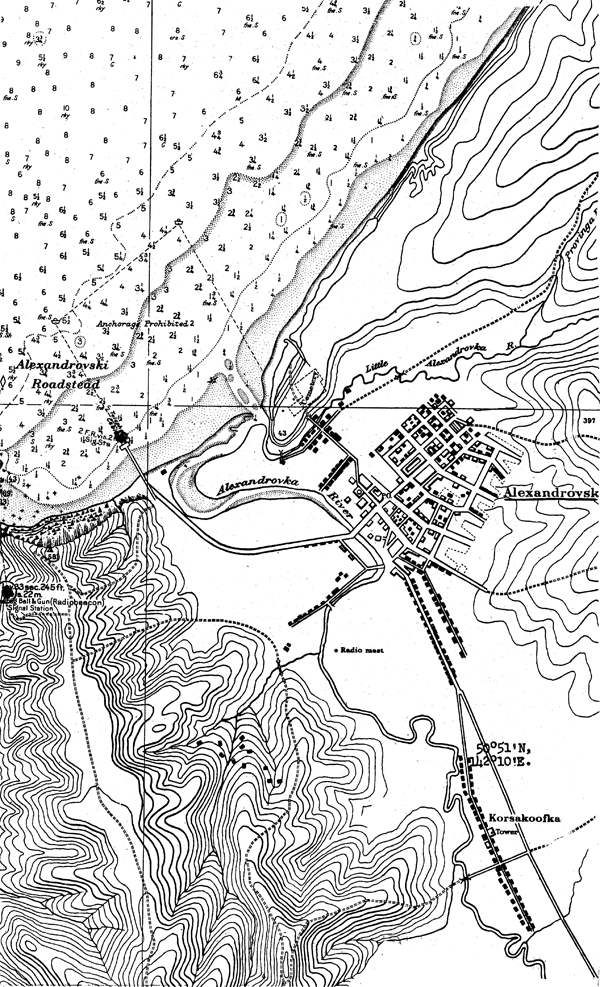
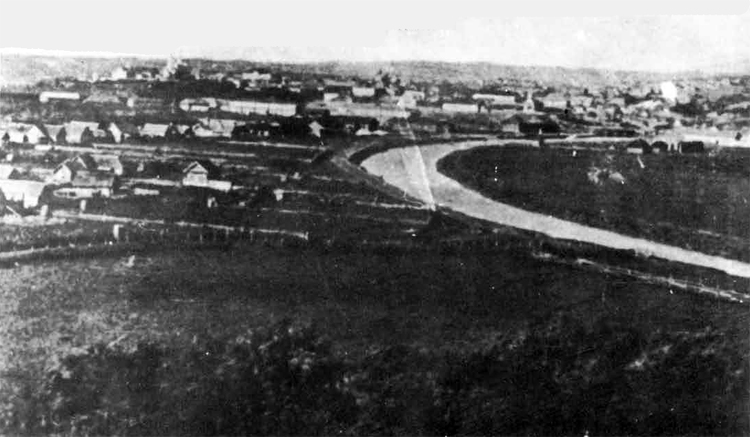
Alexandrovsk - Town.
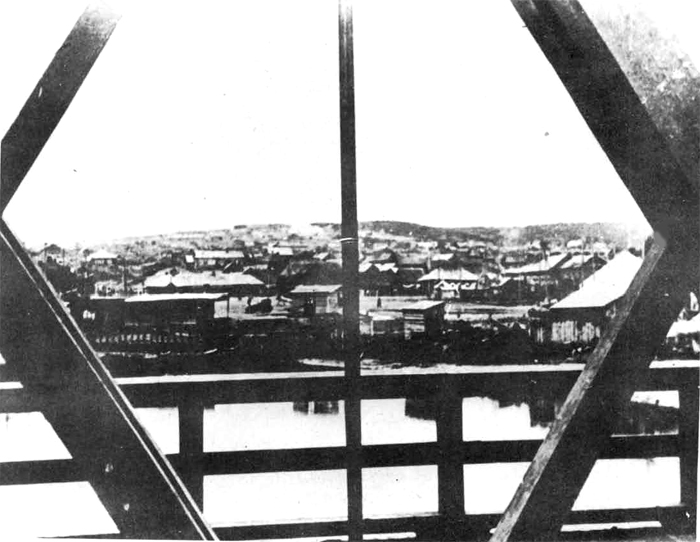
Alexandrovsk - Port.
(o) Viakhtu is located at the south of the Viakhtu River and is used as an operating base for motor torpedo boats; "because of the shallow water at this point, it cannot be used by any larger units. The bay even dries at low water except in its three narrow channels. It is reported, that, at the naval bass, 8 to 10 motor torpedo boats of 16 to 18 tons each can be accommodated; this base is said to be equipped. with workshops and stores.
There is a seaplan base at Viakhtu which, it is reported, was enlarged in 1937 with workshops, hangars, and fuel stores; it has accommodation for 30 seaplanes. Five or six high-speed motor boat launches are attached to this station. There is reported to be an airfield in the vicinity, but there is no confirmation of this fact.
It is estimated that in the area between Viakhtu and Pogibi (to the north of Viakhtu on Tartary Strait) there are 2 152 mm. 4-gun batteries and 2 76 and 85 mm. 4-gun anti-aircraft batteries. The coast on either shore of Tartary Strait is heavily fortified, and it is believed that a coast artillery battalion is stationed there,
(d) Moskalvo-Okha-Urkt Area is located in the narrowest portion of Sakhalin Island near its northern end. In this position, the rich Soviet oil fields are situated. Moskalvo is the oil port on the western coast of the island; it is connected with the oil fields at Okha by rail. Moskalvo is a new port, built in about 1932. Entrance to the bay is made by a natural channel, which has a minimum depth of 25 ft., there are 30 ft. of water alongside the wharf. There is a tidal range here of about 6 ft.
There are no naval bases in this area, but there are a seaplane base and airdrome at Moskalvo, a second seaplane base at Urkt, and a second airdrome at Okha. The seaplane base at Moskalvo is located on Baikal Bay 5 or 6 miles south of the port. It can accommodate about 40 seaplanes; it has two hangars, repair shops, fuel supplies, radio, and probably telegraph. The seaplane, base at Okha is on Urkt Bay, several miles from the town. Depths at this base are 8 to 11 ft.; it is protected by a sand neck. It has one large hangar, repair facilities, fuel supplies, radio, and probably telegraph. Small tenders are attached to this base. The airdrome at Moskalvo is located two miles northeast of the town on Baikal Bay. It has hangar accommodations for 15 planes, repair facilities, fuel supplies, and a radio beacon. The one at Okha has little or no facilities. This entire area is heavily fortified, and defense installations are strong. It was estimated in July, 1943, that it is defended by 4- heavy artillery 2-gun batteries, 6 152 mm. 4-gun batteries, and 6 76 and #5 mm 4-gun anti-aircraft batteries. In addition, 2 coast artillery battalions are stationed at Moskalvo, and 2 at Urkt. One source believes that there is a guard force of 3,000 men in the vicinity of Okha.

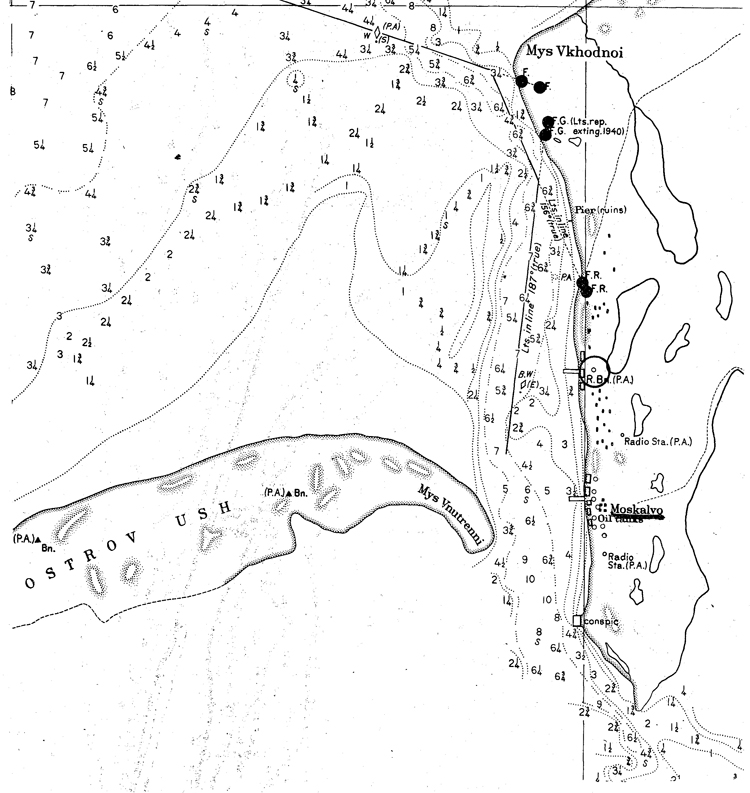
(e) NYyivo-(Hivo) is located on the eastern shore of Sakhalin Island, on Plastun Peninsula. It is not a naval base, but a military base. The 79th Infantry Division operates in the area of Nyivo, which is a fortified zone. It is estimated that this strategic area is defended by two 152 nun. 4-gun batteries, and two 76 and 85 mm. 4-gun antiaircraft batteries. One frontier guard detachment of 5 to 40 men, and perhaps one coast artillery battalion, are also stationed here.

VII. Naval Bases of Secondary Importance in the Sea of Okhotsk
Although Nagaevo is believed to be the only naval base of any importance in the Sea of Okhotsk, the following are worthy of note:
(a) Okhotsk is located on the western shore of the Sea of Okhotsk. An entirely unprotected anchorage may be had at Okhotsk Road in 5 fathoms of water 1 1/4 to 1 1/2 miles offshore. There is a tidal range of 3 meters; a strong tidal current sets east and west and becomes exceptionally strong before aid after change.
It is believed that Okhotsk is being used as a subsidiary naval operating bas« for submarines and surface craft, which patrol the coast during the ice-free season; there are probably little or no facilities here.
There is a seaplane base and an important aerodrome at Okhotsk. Frontier Guard Headquarters with two companies of troops are believed to be stationed here.
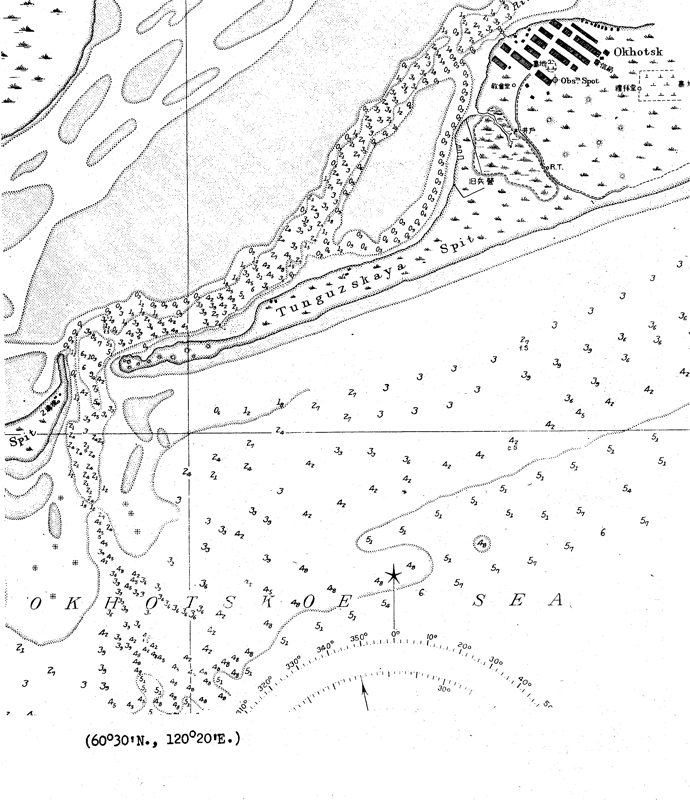
OKHOTSK ROAD
(b) Ayan is located southwest of Okhotsk. There is a naval base, and a seaplane base here; it is classeed as a forbidden area. On company of troops is stationed at Ayan.

(c) West Coast of Kamchatka. There are probably no naval bases on the west coast of Kamchatka, because, the coast being very little indented, there are no anchorages worthy of the name. In 1941 it was reported that a naval base was located at Ust-Bolsheretsk; this seems hardly possible, because there are no sheltered anchorages in the area, and because the water is very shoal near the coast. There may be a small Frontier Guard patrol base here, however. Reports also indicate the existence of a similar base at the mouth of the Ozernaya River, south of tlst-Bblsneretsk. Small boats, drawing up to 3 ft. of water, can cross the bar of this river.
Ust-Bolsheretsk is a fortified area. A Frontier Guard detachment of one company in strength is stationed here. The 101st Infantry Division, which maintains headquarters at Petropavlovsk operates in the fortified zone of Ust-Bolsheretsk. There are a seaplane base and a landing field at Ust-Bolsheretsk. A seaplane anchorage is located at Bolsheretsk, up the Bolshaya River.

VIII. Naval Bases of Secondary Importance on the Bering Sea Coast
(a) Kommandorski Islands. Reports from various sources indicate that there is an advanced submarine base on these islands. Although its exact location is not known, the two most likely positions for such a base would be at Nikolskoe (on Bering Island) or at Preobrazhenskaya Bay (on Medny Island). In May, 1943, there was no evidence of any naval activities at either of these ports, but inasmuch as Soviet subsidiary operating bases ordinarily are kept open during the summer months only, this fact is not conclusive evidence that no naval base exists in the Kommandorski Islands.
In order to establish a permanent naval base at Nikolskoe, it would be necessary to construct a breakwater and to dredge out a basin, as a heavy swell enters the roadstead during all winds from the third and fourth quadrants.


Nikolskoe Village.

Vkhodny Point, southwest of Nikolskoa Village.
Preobrazhenskaya Bay is a small bight about 300 yards wide at its entrance and about 4-00 yards long. Submarines can anchor here in three fathons of water, in its entrance. A good scope of cr.ble is required during northerly winds, as the outlying rocks do not completely protect the bay.

OSTROV MEDNY, GAVAN PREOBRAZHENSKAYA
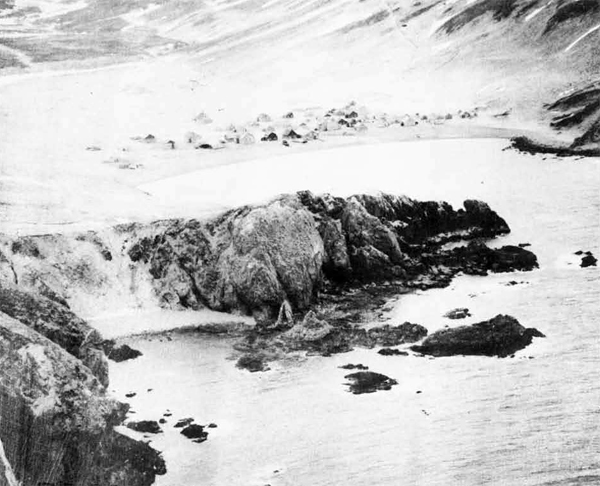

Preobrazhenskaya Bay.

A large seaplane base has been reported on Saranno Lake, northeast of Nikolakoe. The shores of tMs lake arc precipitous except in its southeastern portion. It is reasonably certain, therefore, that the portion of the lake, shown in the nrxt photograph, is that used as a seaplane base, if reports claiming its existence are correct.
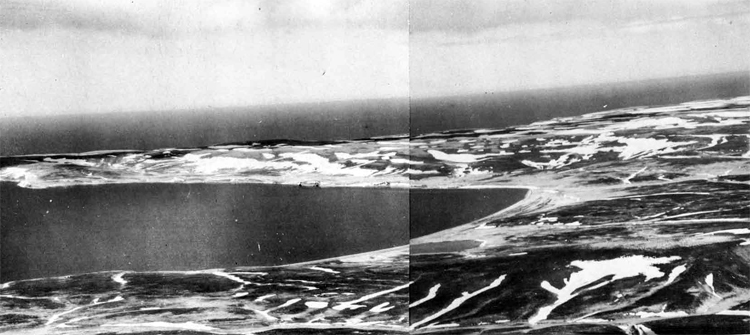
Southeastern shore of Lake Sarannoe, with the Boring Sea In th« background.
Bering Island is a fortified area. It is estimated that Nikolskoe is defended by two 152, 4-gun batteries and two 76 and S5 mm. 4-gun anti-aircraft batteries. A frontier Guard detachment, one company in strength, is stationed here; one coast artillery battalion is also probably on Bering Island. Medny Island is a forbidden area; it is probable that a Frontier Guard detachment, one conpany in strength, is stationed here.
(b) Ust-Kamchatsk is located at the mouth of the hanchatka River. In 1941, it v:as reported that a small naval station existed here; this hardly appears feasible, because of the complete lack of anchorages in the area. Ust-Kanchatsk, however, is a fortified zone. A Frontier Guard detachment, one company in strength, is stationed here. The 101st Infantry Division, with headquarters at Petropavlovsk, operates at Ust-Kamchatsk and at Klyuchi (up the Kamchatka River). There are a seaplane base and a landing field at Ust-Kamchatek. There are also a seaplane landing and a second landing field at Klyuchi.
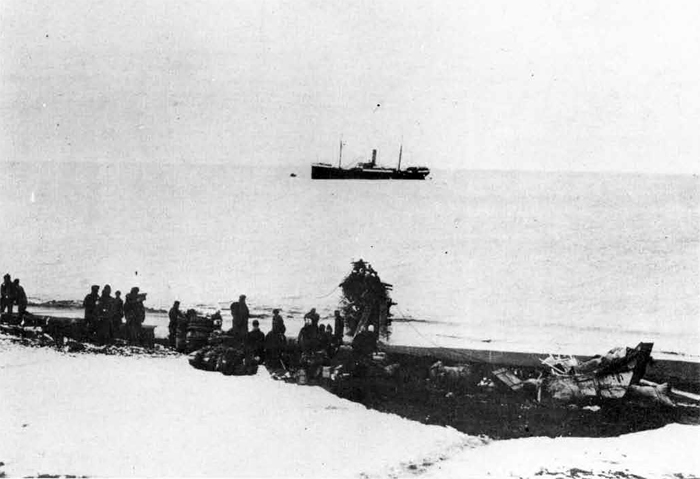
Bering Sea Coast at Ust-Kamchatsk.

The mouth of Kamchatka River
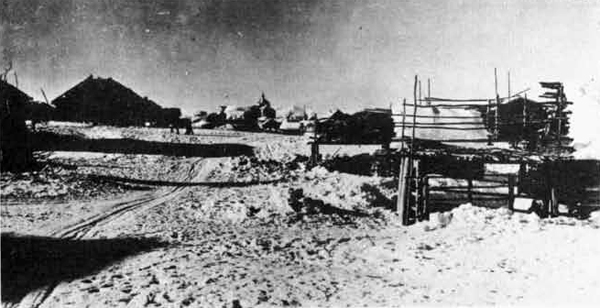
Klyuchi.

Klyuchi.
(c) Karaga Harbor is located across Litke dtrait from Karaginski
Island. An excellent naval summer operating base for submarines and
light surface craft could be built here, because, due to the proximity of Karaginski Island, it is well protected from winds. Jt the
village, on the northwestern coast of the bay, the water is as much
as 16 feet deep.
Karaga Bay is a restricted area; a Frontier Guard detachment, one company strong, is stationed here.
(d) Karaginski Island. A submarine patrol base has been reported
on this island; if existent, this base is probably located in
Lozhnikh Vestei Bay on the weati-rn const, because this bay constitutes the only sheltered anchorage on the island. There is a land
ing field near Loshnikh Vrstei Bay; a frontier Guard detachment,
one company in strength, is stationed here.

(e) Korff Bay is probably a stumer naval operating base for submarines and surface craft. This bay is 38 miles wide at its entrance and recedes north-northeastward for about 45 miles. It narrows gradually to its head, where the width is about six miles. Depths in the bay decrease gradually from about 4-0-50 fathoms of water at the entrance to about 15 fathoms, about 8 miles from the head. The best anchorage for vessels drawing not more than five fathoms is to be found in Skoboleva Harbor, This harbor, which is the largest inlet in Korff Bay, is exposed to north and northeast winds, which create high waves, but they have little effect on larger vessels that take anchorage east of the spit, where good ho]ding ground of rud and sand is to be found. It has been stated that Skoboleva Harbor can accommodate about 50 ships. Korff Bay does not froze during the winter, but, depending on the currents and wind, is periodically packed with draft icej sometimes it is completely clear of ice, however. Vessels with strong hulls and powerful engines are able to navigate in the bay throughout the entire year.
Korff Bay is a highly fortified area; it is estimated that its defenses consist of two 152 nun. 4-gun batteries and two 76 and 85 mm. 4-gun anti-aircraft batteries. One company of Frontier Guard troops are stationed at Tilichiki, on the northwestern shore of Korff Bay, as well as probably one coast artillery battalion.

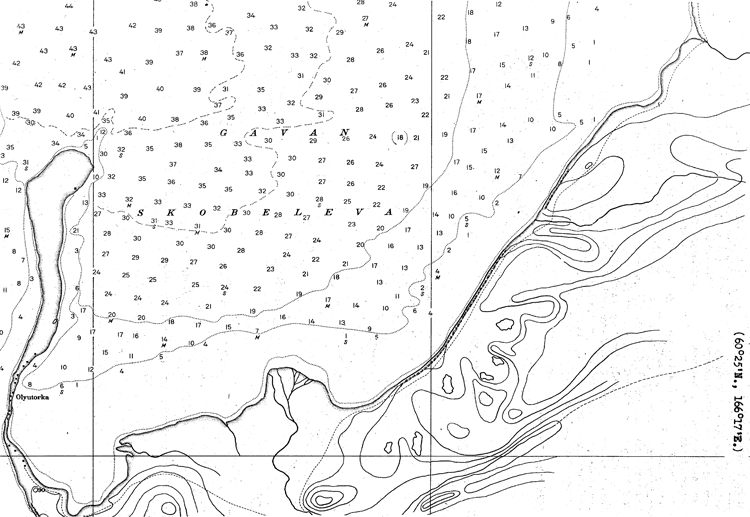
(f) Anadyr Bay. Various reports indicate that Anadyr Bay has been developed into a seaplane station, as. well as into a summer naval operating base for submarines and surface craft, which patrol the north Siberian coast during the ice-free season; this base is probably located at Klinkowstroero Bay in the northeastern reaches of Anadyr Bay. Seaplanes can land at Anadyr, itself.
The village of Anadyr (Novo Mariinski) is not far from the mouth of the .Anadyr River; it is the administrative center of the Chukhotsk National District; anchorage can be had at this point 300 to 400 feet offshore.
There is an air base at Anadyr. The conditions of the field are poor, as it was reported in August, 1943, that although C-47's could be landed without difficulty, A-20's cannot always land; the location of this airfield is stated to be excellent. At Markovo, about 200 miles up the Anadyr River, which can be reached by river craft drawing 4 to 4 1/2 ft. of v/ater, there is an important air base. The field here is unsurfaced and very rough but with good approaches; the runway is 3,775-ft, long and 200 ft. wide, with a 315-foot-parking strip.
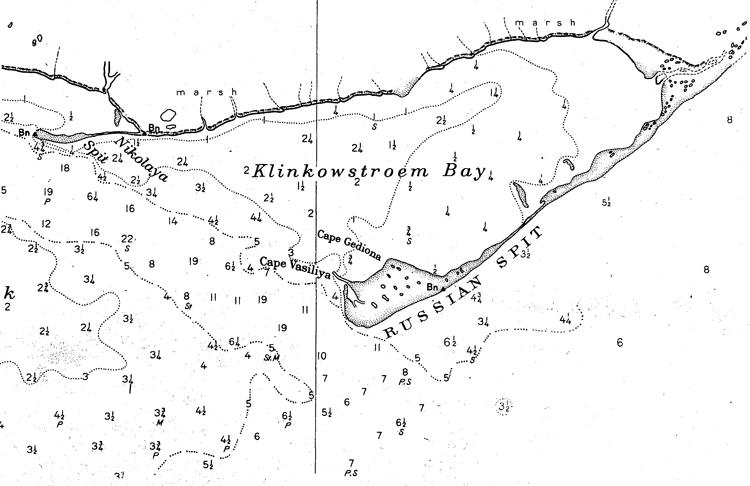

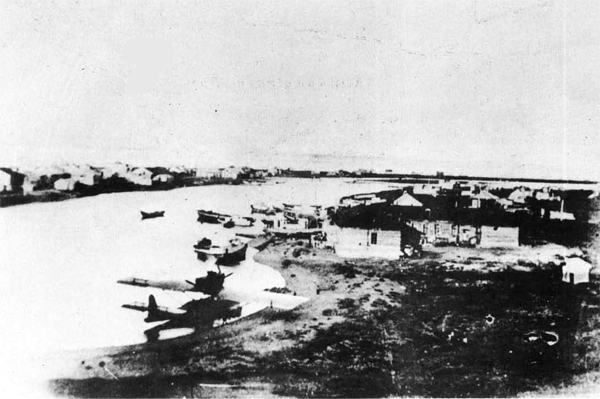
Village of Anadyr.
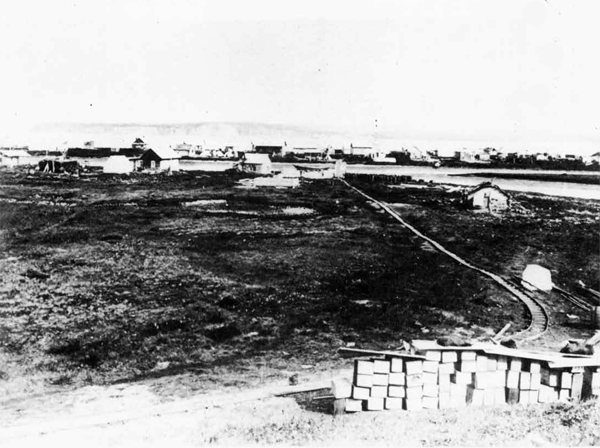
Village of Anidyr.
(g) Providence Bay is situated on the southern shore of the Chukhotski Peninsula, south of Boring Strait, and opens into the Gulf of Anadyr. It is a fjord-like bay with mountainous sides; it is 18 miles long and avarages about two miles in width. Plover Hay, a small bs.y on its southeastern side, just within the entrance to Providence Bay, is 16 to 20 fathoms deep, while Emma Bay, farther to the north, has a depth of 16 to 18 fathoms at its entrance, decreasing to b fathoms in parts of the boy. Providence Hay :is frozen over for nearly 8 months a year, generally from October to May, although the navigation season way be slightly prolonged by the use of icn breakers.
Commercially, Providence Bay is important as the starting point for convoys which, during the summertime, go through Berlng Strait and along the Northern Sea Route.
For come years, reports have stated that a "naval base" has been built at Providence Bay. This bay probably consists of an anchorage, used by submarines and surface craft, which patrol the coast during the four ice-free months every year; there are probably other "bases" of this type along the coast.
It is estimatod that at Providence Bay there are two 152 mm. 4-gun batteries and two 76 and 35 mm. 4-gun anti-aircraft batteries. Providence Bay is classed as a major fortified center.
There is a seaplane anchorage at providence bay located at 64°
20' N, 173° 19' W; this anchorage is used during the summer months. There may be a landing field in the vicinity.
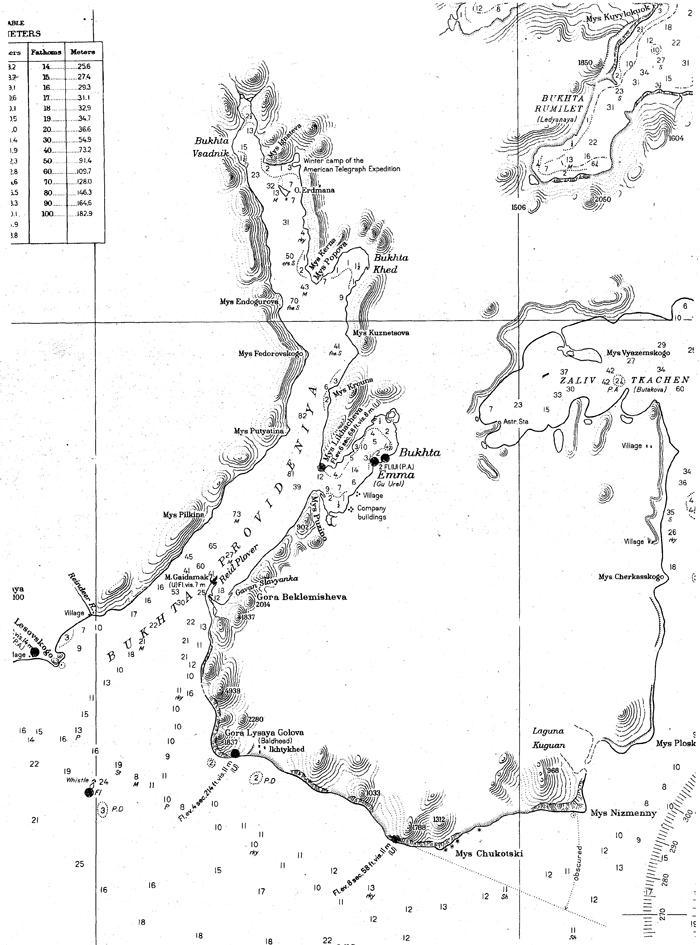
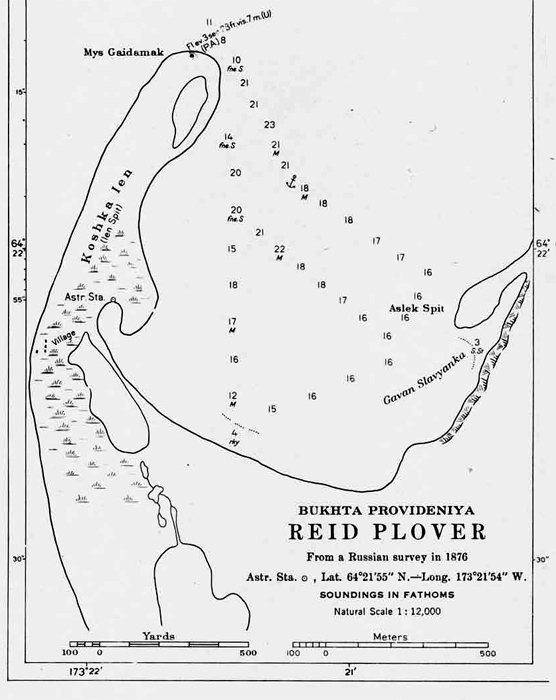
Providence Bay
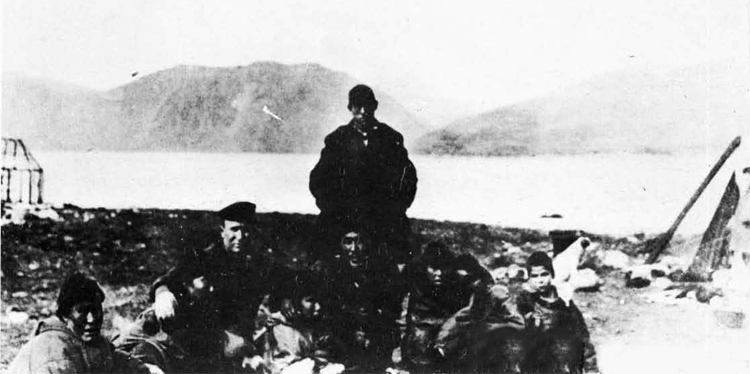
Providence Bay - Photograph taken from a sand spit at the southern entrance to Emma Bay.

Village at East Cape - most easterly point of the U.S.S.R.

Village of Uellen, northeast of Providence Bay.
IX. Military and Air Strength in the Far East.
It is believed that all military strength, including Army, Navy, and Air Force, is under the command of the Navy, with headquarters at Vladivostok. Army forces in southeastern Siberia are roughly divided between the First and Second Red Banner Armies. The First Red Banner Army commands all forces south of the 46th Parallel, while the Second Red Banner Army commands forces north of that point, including the Amur River Basin, Khabarovsk Province,- and Northern Sakhalin; it also commands forces in the Amur Military District, In addition, one composite brigade is stationed at the Kolyma River, and one Infantry Division (the 101st), with headquarters at Petropavlovsk, is responsible for the defense of Northeastern Siberia.
Army ground forces in Eastern Siberia number approximately 250,000 men, divided as follows:
| Region | Units | Men |
| 1st I.R.B. Army | 7 Inf. Div. (15,000) | 135,600 |
| 3 Inf. Brig. (5,000) | ||
| 1 Mtzd.Brig. (3,000) | ||
| 3 Tank Brig. (2,000) | ||
| 1 Cav. Div. (6,000) | ||
| Khabarovsk Krai | 5 Inf. Div. (15,000) | 85,600 |
| 2nd I.R.B. Army | 2 Tank Brig. (2000) | |
| 1 Cav. Div. (6,600) | ||
| North Sakhalin | 1 Inf. Div. | 10,000 |
| 2nd I.R.B. Army | (10,000) | |
| Kolyma | 1 Composite Brig. (5,000) | (5,000) |
| N.E. Siberia | 1 Mt. Inf. Div. (10,000) | 10,000 |
| Total 246,200 |
The Soviet Air Force in Eastern Siberia consists of approximately 1,175 planes and 58,000 officers and men; it is divided approximately as follows:

D. Naval Bases in the Arctlc.
The Soviet Arctic Fleet is principally based on Polyarnoe, it serves as the administrative center and headquarters of the Commander- in-Chief , Vice-Admiral Golovko, as well as the submarine base. Surface craft is usually based at various other points in Kola Inlet, such as Vaenga Bay, the shipyard at Rosta and at the Government Salvage Agency (E.P.R.Q.N.). There is a ininesweeping and anti-submarine base on Iokanga, on the Murman Coast.
The White Sea Flotilla, which comes under the jurisdiction of the Commander-in-Chief, Northern Fleet, is based on Archangel and to a small degree, Molotovsk. Various reports indicate that.construction is underway at the port of Belomorsk, on the southwestern coast of the White Sea; when completed, it will probably be employed partially for naval purposes.
I. Kola Inlet in General
Kola Inlet is the largest and most important gulf on the Murman coast, extending 32 miles southward from the sea to the junction of the Tuloma and Kola Rivers. The rise of Nazi Germany to a commanding naval position in the Baltic and the possibility of transferring men of war up to 3Qp£)^ton destroyers through the Baltic-White Sea Canal have all enhanced the value of Kola Inlet as a naval base of the U.S.S.R. The Soviet government visualizes Kola Inlet as the naval base of the north from which naval forces in the Far, East may be reinforced when needed via the Northern Sea Route. Until the beginning of the present war, extensive work was proceeding in the Kola Inlet and principally at Murmansk, with the object of building it up to the standards of a first-class naval dockyard and repair base; in addition, all the commercial facilities of the port were being improved.
The favorable ice conditions, coupled with the comparative inaccessibility of the area from the southward, makes Kola Inlet suitable for use as an advanced base at all times of the year. As the main Soviet northern base, however, geographical factors and exposed lines of communication make it very vulnerable to attack from combined sea and air forces.
The northerly part of Kola Inlet as far as Salni Island,very seldom freezes but from November to May land ice forms off the shores and, from time to time breaks up and is borne away to sea on the ebbtide. Only above Abram Pakhta has any ice been observed to form during the 2 winters of 1941-1942 and 1942-1943, and, owing to strong tides, it usually lasts only 2 or 3 days.
There is a naval teleprinter service between Murmansk, Polyarnoe/ Archangel, and Moscow, but it cannot handle the Roman Alphabet.
Naval hospitals are located at Vaenga Bay and Tuva Bay; the
civilian hospital is at Murmansk.
Anti-submarine and torpedo booms are laid across the northwestern and eastern entrances to Polyarnoe harbor.
Ships can enter and leave Polyarnoe Harbor only by the northwestern entrance and at least one hour's notice should be given for
opening the boom.
Anti-submarine nets are Sm in the Kola Inlet in the
following positions:
(a) From position 69°15'40" North, 33°29'10" East, in a direction 086° for 1500 yards.
(b) From position 69°14'33" North, 33°27'30" East, in a direction 115° for 1640 yards.
(c) Between positions 69°08'55" North, 33°27'25" East and
69°08'05" North, 33°28'10" East.
(d) Between lines drawn 117° from positions 69°07'30" North,
33°26'38" East and 69°07'13"North, 33°26'20" East and
the shore.
Obstructions consist of light single nets with explosive charges and are suspended five metres below the surface. The limits of the nets are not indicated by markers or buoys.
II. Polyarnoe (69°12'N.. 33°28'E.)
Polyarnoe is located at Longitude 33-28-00 East and Latitude 69-11-06 North. It was formerly known as PORT ALEXANDROVSK and was declared a prohibited zone in 1934.
The area around Polyarnoe is comprised, for the most part, of low hills made up of faulty granite and gneiss. The vegetation consists almost entirely of scrubby brush and moss with a few small birch trees and, as a result of the very short warm period, combined with the poor quality of the soil, no attempt has been made to cultivate this area, the hollows between the hills retain the melted snow so that, during the summer months, the terrain is reduced to a bog-like surface with occasional boulders. .
The harbor is small, being about two miles in length and varying from 100 to 600 yards in width, well protected by steep hills on all sides. Depths vary from 7 to 20 fathoms. The holding ground is considered poor and ships sometimes drag in the violent northwest winds which occasionally occur during the autumn and winter. The tidal range is from four to twelve feet. The harbor is generally entirely free from ice, and when the latter does form it is not thick enough to impede steam driven vessels. There is one large wharf about 600 feet long and ships up to 350 feet can lie alongside, the depth varying from 30 feet at the western end to 21 feet at the eastern end. In addition to this wharf, there are three jetties,alongside ' of which submarines moor,and on which are two motor driven travelling cranes on rails capable of lifting three tons. The harbor has two entrances between the mainland and EKATERINSKI ISLAND, the smaller entrance opening out directly to the eastward into KOLA INLET and the wider one to the northwest of the island. Both of these entrances are protected by submarine nets and torpedo booms.
The buildings housing the administrative offices and the barracks at the submarine base,are large brick structures, which, although constructed during the past ten years, are already in a bad state of deterioration. The CinC and his staff have auxiliary offices and living quarters in a bomb shelter blasted out in the rock directly below their building. Personnel attached to the station have flats in large brick buildings or live in typical log houses. Radio stations are likewise housed in log structures as are the warehouses and some of the workshops. Of late, considerable blasting has been in evidence, with a view to providing underground stowage for explosives, oil, and
valuable supplies.
A small hospital of 100 beds is considwered unsatisfactory and is used mainly for transient patients, the main hospital being located scross the Kola Inlet in TUVA BAY.
There was formerly a cable to Great Britain, but it no longer exists. Telephonic communication withMurmansk and the few neighboring cities is rather poor; it is understood that a direct line does exist with Moscow, since the Commander-in-Chief has several times stated that he has had telephonic conversations. For the most part, communication is effected by voice radio and regular wireless.
There is NO road or railroad connection with Polyarnoe, although some maps and charts erroneously show their existence.
The main center for recreation is the RED NAVY CLUB, a large structure housing a theatre, reading rooms, swimming pool, enlisted men's club and officer's club. During the winter, there are facilities for skiing and skating. In the spring and summer, football and volleyball are played. The station has a permanent theatrical company, a musical ensemble, and shows both Russian and foreign movies.
Shipyards and Repair facilities
(a) Floating workshop - a steel hulk, length 75 feet, containing two benches, three lathes about 8", 2 medium drilling
machines, 1 light drilling machine, 1 simple milling machine, 1 coppersmith forge. Can only do light work.
(b) Small workshop ashore - not yet fully equipped.
(c) Repair ship KRASNI GORN - 1982 tons, at present moored
in PALA BAY. It has power operated derricks and cable-
laying gallows in the bow which can be used for lifting
the sterns of large motor boats to shift propellers—
capacity 70 tons. Two diesel engines supply power to
workshops containing the following equipment:
8 lathes (6" and 8")
2 lathes 14"
1 planing machine
2 medium sized drilling machines
1 small marking off table
1 large horizontal boring machine
2 small vertical boring machines
2 horizontal grinding machines
1 milling machine, 1 metal cutting saw, 1 band saw
Foundry for brass and cast iron handling up to 100 lbs. Boiler and smith's shop with medium sized plane table. Small electric workshop capable of winding small armatures
and small repairs to wireless and echo sounding gear. Its shops do not include a periscope shop or torpedo shop,
and all the work beyond its capacity is sent to the yards
at Rosta.
(d) Periscope repairs - are carried out -in a shop ashore capable of handling periscopes up to 25 feet. Rangefinder repairs, etc., are also effected at this shop.
(e) Materials and Workmanship - Brass castings appear to be of
good quality, although the supply of this metal is very low.
Turning work is good. Welding is sometimes quite careless and not entirely reliable. Small bearings have been re-metaled and machined satisfactorily. Boiler-making work is good,
(f) Welding - Portable electric and oxi-acetylene sets are
available on the jetties. Oxygen and acetylene are available at the Submarine Base.
(g) Refrigerating Plant — not available and no C02 gas on hand
(h) High Pressure Air - up to 3000 lbs. per square inch available on the jetties.
(i) ELectricity Supply - 220 volts A/C and D/C is available at points along the jetties. The supply is 2400 amps at 220 volts to 2100 amps at 310 volts.
Supplies -
(a) Water - Boiler and drinking water connections are on all jetties, but from British analysis, the former is so unsatis
factory as not to be used on their ships and the latter must
be boiled and filtered.
(b) Fuel oil - Storage for 2000 tons and additional fuel can be
obtained from two Soviet tankera total carrying capacity
about 1700 tons.
(c) Diesel fuel - available at the submarine base and is supplied by gravity at the rate of ten tons per hour.
(d) Goal - Only a limited stock sufficient for domestic purposes.
(e) Distilled water - Available in rubber jars about 6 gallon
capacity.
(f) Provisions and ship chandler supplies - None available.
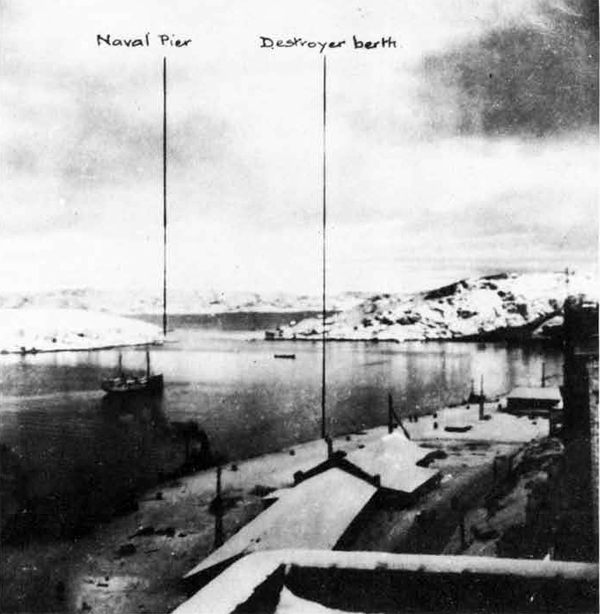
Polyarnoe Photograph taken September-October, 1941
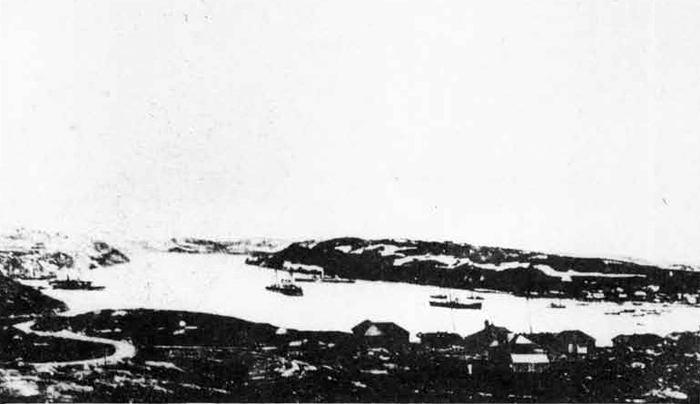
Polyamoe Harbor.

Approaches to Polyarnoe
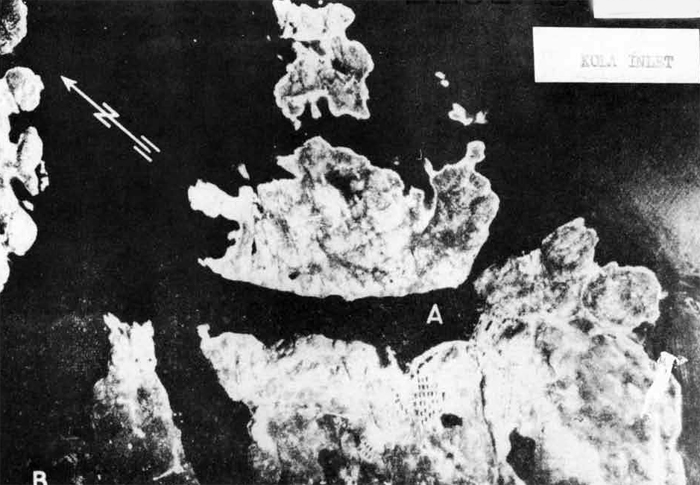
Polyarnoe
Photograph taken August, 1941.
A = Naval Base.
B = Seaplane Base.
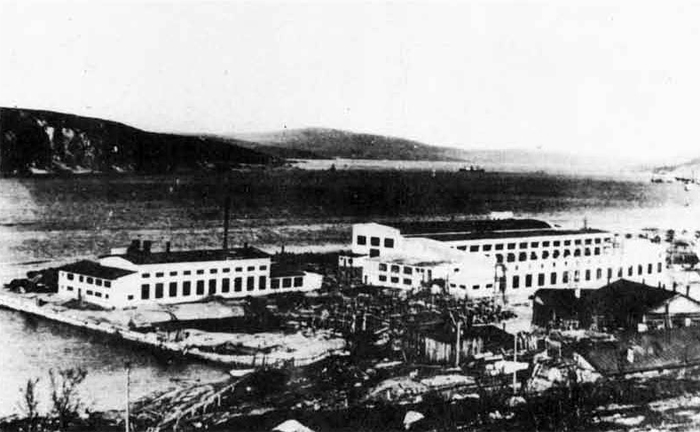
Polyarnoe Harbor.
III. Murmansk (68°58'N., 33°04'E.)
There are no permanent battery installations in the port area, but «taing the times when ships are alongside a formidable array ofmobile Bofors type AA guns and Oerlikons are brought in, also railroad cars, mounted with AA guns ass placed at various points in the port area.
AA guns of caliber up to 4.7" are spaced on the ridge of the hills which lie just east of the town, in addition to those located directly across the Inlet. The number of guns varies considerably, but it is estimated that during the winter of 1943 between 75 and 100 guns of 311 caliber or greater were disposed about the city. The barrage which these guns put up is well laid and, although few high altitude planes are brought down, the only low-flying planes which succeed in reaching the port area have been hedge-hopping Messerschmidt fighter-bombers. Russian fighting planes, for the most part Hurricanes, P 39 fs and P 40's, maintain a continuous patrol, and as soon as enemy planes are reported over Russian territory, additional fighters take off from the airdromes at Murmashei and Vaenga. This system is not entirely effective, since the interval of time between the alert and the arrival of enemy bombers is in the neighborhood of 7 to 10 minutes, which does not permit the fighters to reach the altitude required to intercept the enemy bombers before reaching their target. The great weakness in the AA defenses is in warding off night attacks- Despite claims that Russian night fighters are used, it is not believed that any Russian planes operate over Murmansk at night, and, as a result, during the long winter nights there have been continuous raids from dark until dawn for three and four nights in succession, during periods of moonlight. There are about 70 barrage balloons in the vicinity of Murmansk, but they are very seldom used. The Soviets state that sudden changes of wind may be expected, and the risk of losing the balloons is too great. Apparently, the fact that their presence is known to the enemy lias helped to the extent that the night attacks are now made from an altitude which is considerably greater than was employed before these balloons were brought in.
Until March, 1942, Murmansk had no bomb shelters as such. Cellars were reinforced and some caves dug in the sides of the surrounding hills. Since that time, 2 surface shelters have been constructed, roofed over by 17 feet of reinforced concrete, topped by gravel and sand. These are used by the naval, military, and civil authorities in running the business of the town during air raids. The designing architect claims that they will withstand a ton bomb, although he admits the people inside might feel indisposed. A really effective bomb shelter is a large one built into a rocky hill. Its main halls are 70 feet below the crest of the hill; it can accommodate 2,000 people, has a movie theatre, children1s creche, is gas proof, and has its own lighting, heat, and ventilation system. Although this shelter was blasted out of solid rock, it was built in less than 9 months, and work is now progressing on an extension to be fully as large. Along the road between Murmansk and. Rosta, excavations are being made into the rocky area along the shore, with the view towards underground bomb-proof storage for port supplies and possibly ammunition and fuel oil.

Murmansk Photograph taken August, 1941.
A = Port installations.
B = Khaldeev Point Shipyard with a floating dock 279 ft. long.
C = Rosta Shipyard with two drydocks.
D = Murman-Riba Trawler Base.
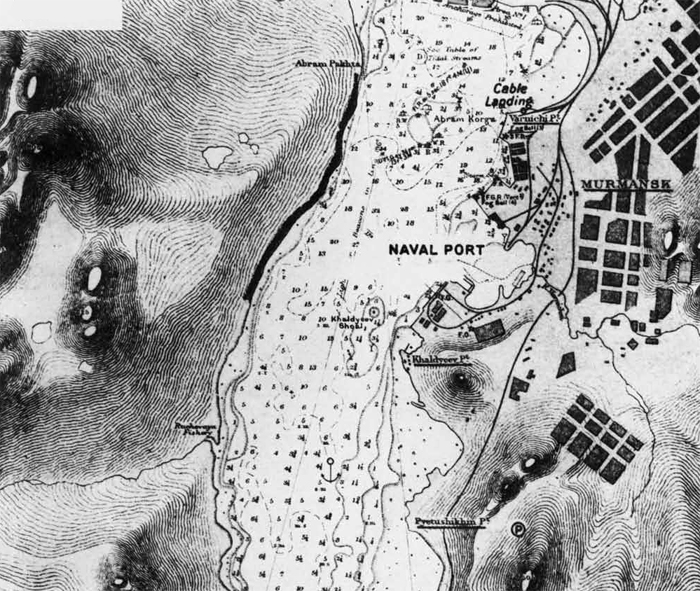
I7- Vaenga (69°10'N., 33°25'E.)
Vaenga is not in itself a town, but is the name given to the airfield and small naval base located about H. miles to the north of Murmansk. The number of planes operating from this airfield varies directly vd-th the number of German planes observed by reconnaissance flights over Finland and Norway, but it has handled up to 170 planes. There are no regular runways, the surface is dirt and gravel, and its best operating period is during the winter. Few shops and storehouses are located in the vicinity of the field, the vrork being don* and the personnel quartered in wooden buildings located about 1/2 mile from the airfield. Fuel dumps, ammunition dumps and storage dumps are scattered in the scrubby hills. The ready planes are kept in revettements around the edges of the field, the reserve planes and planes undergoing repairs being concealed in the brush. Work is progressing on underground storage for ammunition, fuel and supplies and on bomb shelters for the personnel.

Due west from the airfield on the Kola Inlet lies a small
auxiliary naval base known as the Vaenga Naval Base. This is the
terminus of the railroad,and here are located about 8 large brick
buildings which contain a hospital, barracks, the British Naval Hospital, an optical shop, gyro v/orkshop, small electric workshops, and
quarters for personnel. An L-shapeo1 pier extends into Vaonga Bay,
length about 250 feet, depth alongside 18 feet, suitable for berthing
destroyers. Inboard of the base of the L,may be based trawlers and
tugs. This pier has been used as a discharge point for our A-20
bombers, which are taken down from Murmansk on a small lighter. Vaenga
Bay itself is normally used as an anchorage for Soviet men-of-war,
but during periods of convoys it is reserved for the escort vessels.
It is also used as a drill ground for training torpedo bomber crews,
during which period all ships are removed from the vicinity. From Vaenga to Polyarnoe,is a distance of 9 miles,and ,the quickest way to Polyarnoe from LluttnansI; is by road to Vaenga, thetice by motorboat to
Polyarnoe.
V. Rosta "(69°02'N., 33°03'E)
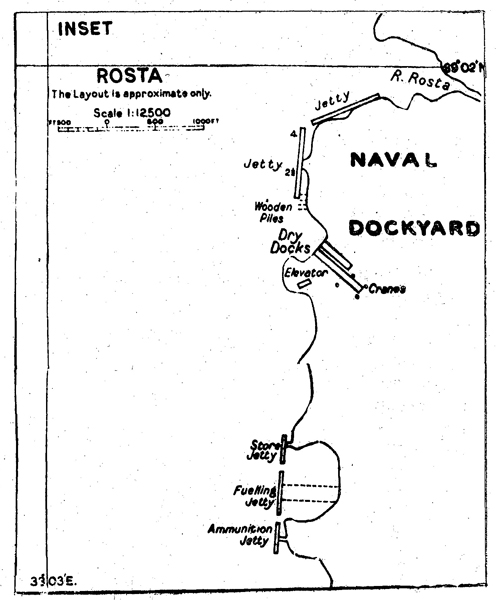
Rosta is a growing settlement 3 miles north of Murmansk, created for the purpose of housing the workers wnployed in the Rosta dockyards, fueling wharf and coaling wharf. It is connected by road and railroad to Murmansk. Owing to the proximity of the town to the dockyards, it has been damaged to the extent of about 25% by enemy air action, but most of its large new buildings are intact; no perma-ment damage has been suffered by the yards, however.
The only yard capable of undertaking major repairs to large vessels is located at Rosta. Two graving docks are located here; their dimensions are as follows:
No. 1 Length 350 ft. Breadth 85 ft. Depth over sill 35 ft.
at high water. No. 2 Length 650 ft. Breadth 85"ft. Depth over sill 35.ft.
at high water.
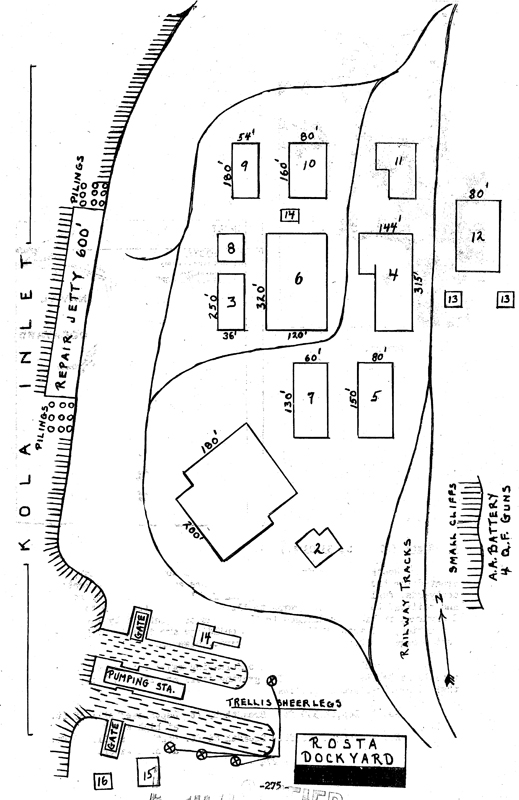
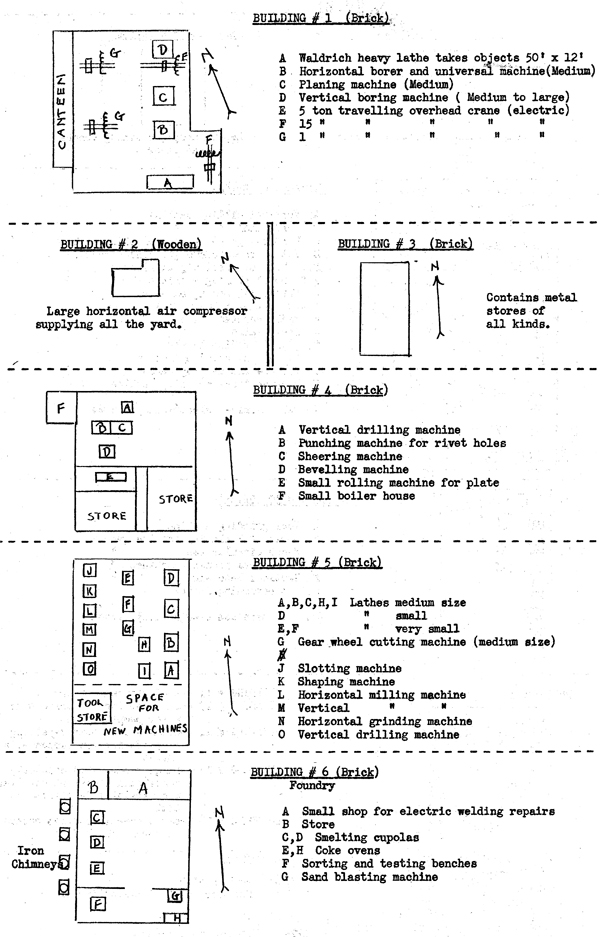

VI. Graznaya (69°04'N., 33°15'E)
Graznaya is the main seaplane base of the Soviet Northern Fleet. It is located about 8 miles north of' Murmansk and is connected by land to the latter and to Vaenga. Here are located hangars, small workshops, storehouses and barracks. Observed operating from this base and undergoing repairs were 7 MBR 2's. There is ample room in the vicinity for considerable enlargement of this base and some little work , seems to be .in progress, mainly blasting operations in the surrounding hills to provide underground storage of ammunition and fuel. Ammunition and fuel at the present time is scattered over the neighboring tundra.
VII. Epron (Government Salvage Agency) 68°54'N., 33°01'E
This yard is located on the western side of the Inlet just north of Yelovi Point. No opportunity was afforded to survey this establishment, but judging from the fact that large- submarines and destroyers undergo repairs at this base and from it's; appearance as seen from the Inlet, it can probably handle anything short of major repairs
VIII. Kunnan-Riba Trawler Base (68°58'N.« 33°04'E)
This base, located just south of Murmansk, contains a slip which can handle vessels up to 700 tons and small shops can cater to the maintenance of a fleet of 200 fishing trawlers, most of which are now engaged in minesweeping and patrol duties.
IX. Khaldeev Point (68°57'N., 33°04'E.)
This area is strictly guarded but as seen from the Inlet and surrounding hills, it gives the impression of being a naval dockyard under construction with many shops and foundries already completed. A 1200-ton destroyer, a trawler, and a medium-sized submarine were observed drawn up on the ways, all undergoing repairs. It is quite likely that this will eventually be the main naval building and repair yard in Kola Inlet$ a 279! floating drydock was reported here in August, 1941.
X. Abram Point (68°58'N., 33°02'E.)
There is a small boat building yard and a boat repair shop here.
XI. Iokanga (68°05'N., 39°30'E)
Iokanga, located on the northeastern shore of Kola Peninsula, is a restricted areaj permission to enter it must be granted by the Soviet authorities.

IOKANSKIE ISLANDS
Xll. White Sea
(a) In General - The 'Jhite Sea Flotilla consists mostly of
trawlers; from time to time a few submarines are attached to it.
This flotilla is based chiefly on Solombala, across the Kuznechikha River from Archangel; a few units are occasionally based on
Molotovsk.
(b) Molotovsk - The naval base at Iviolotovsk is located, to
the east of the commercial port, has been designated "restricted
area", and has been kept very closely guarded. Small submarines
are being constructed east of No. 3 pier (see chart) and are
launched broadside-to, from especially constructed railroad flat cars. In December, 194-2, there were 2 hulls, but on which work
had been very slow and at that time apparently stepped altogether.
Construction of roads, buildings, and improvements within this area is still going forward. One steel and brick building is large enough to be capable of housing 2 10,000-ton vessels, and at one end a launching basin appears to be under construction; however, no foreigners have ever seen anything under construction .within, this building nor observed anything in the basin.
It is reported that a huge graving dock is under construction across tha river from this restricted area, but this remains unconfirmed. The United States Assistant Naval Attache, Murmansk, believes that the construction of such a drydock would be impossible because of foundation difficulties,. This opinion is based upon the fact that construction of a rail and traffic bridge from Archangel Citjr toSolombala was started 2 years ago but was stopped because the foundation proved unsafe. Difficulties of the same sort were encountered in the I.Iolotovsk area, which is built entirely on a swamp and on reclaimed land. This restricted area is used as a base for ice breakers; yet all the major repairs rust be done in shipyards of allied countries, as Holotovsk does not have the facilities.
If the present plans for the port and restricted area are carried out, laolotovsk vrill undoubtedly be made into a fine port with an ample repair yard; yet all the construction labor used is convict labor, with the resultant poor construction, and, at the present rate of building, will take another 5-year plan to put the place in first-class shape.
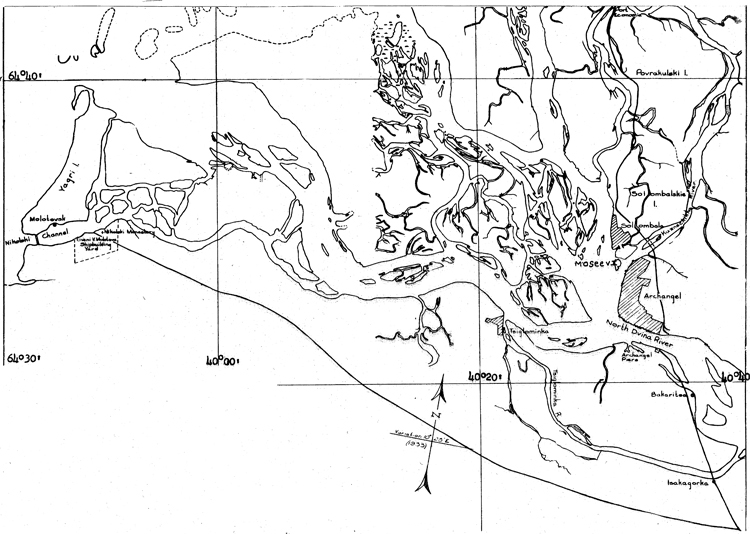
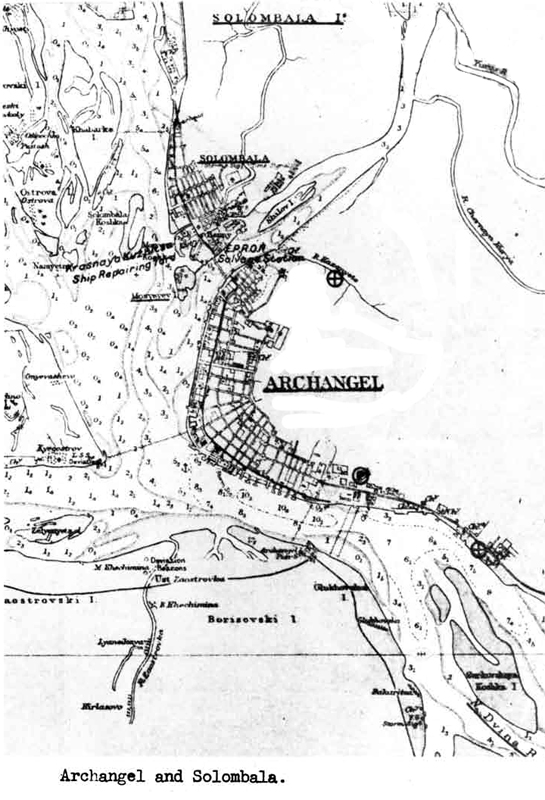
Archangel and Solombala.
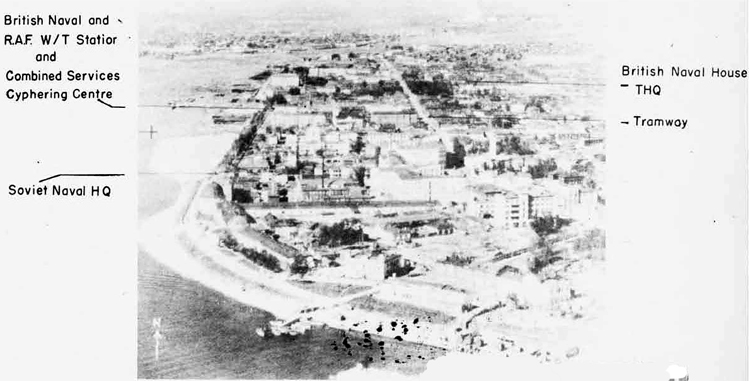
Archangel.

Archangel
Photograph taken July, 1941.
A = Ship repair yard.
B = Port installations.

MOLOTOVSK
Not to Scale
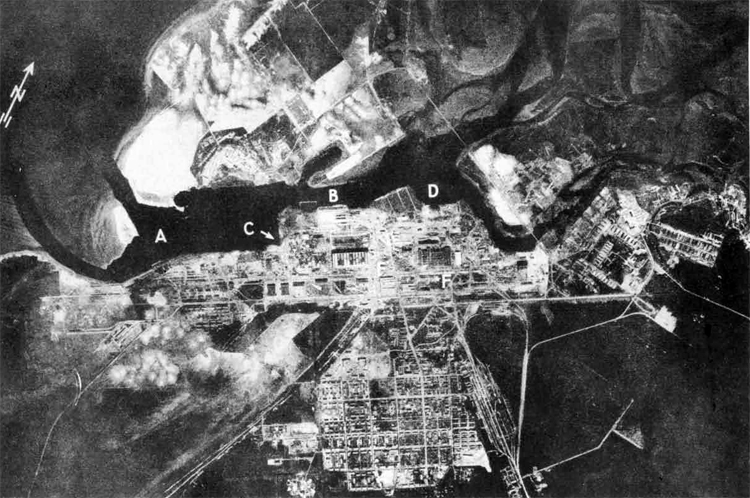
Molotovsk Photograph taken July, 1941
A = Naval Base.
B = Slips.
C = Fitting out basin with locks under
construction.
D = Wharves.
E = Shipbuilding Shop.
F = Metalworks.

Archangel in the foreground - Solombala in the background.
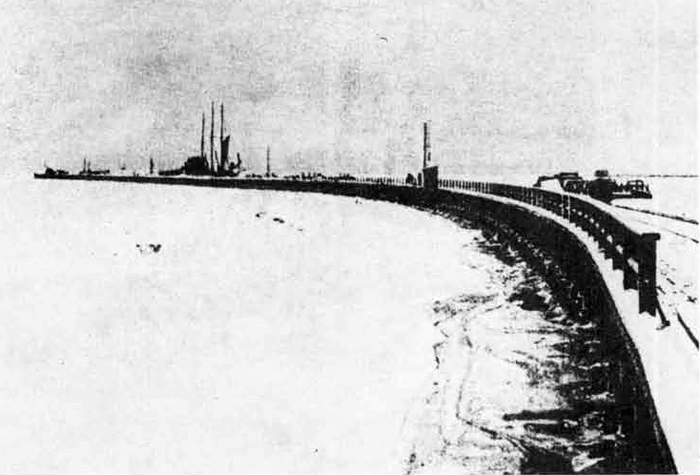
Belomorsk.

Kandalaksha
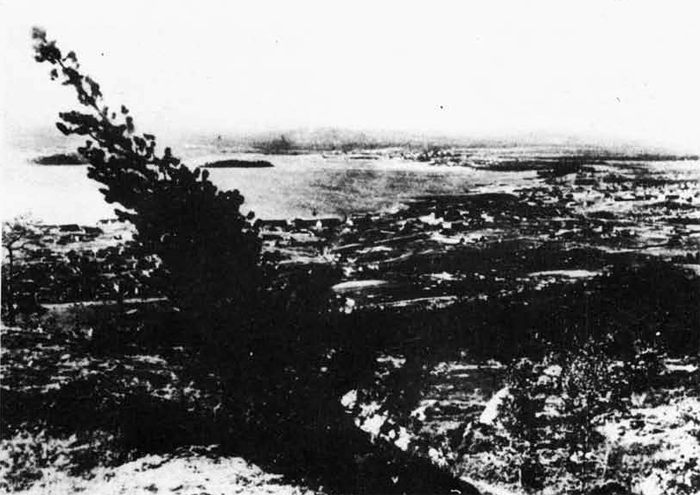
Kandalaksha. General view.

Kandalaksha
Photograph taken July, 1941
A = Harbor.
B = Mouth of the Niva River.
E. Naval Bases on the Amur River
I. In General. The Soviet Amur River Flotilla is responsible for the patrolling of the entire Amur Basin. This basin, including the Shilka and Argun Rivers, as well as the Amur. River, is navigable for 22,000 miles, although only 12,000-16,000 of it are now being used.
The Amur River, which is 1,800 miles long, is navigable at
Blagoveschensk for 160 days a year (.11 May to 20 October), at Khabarovsk for 190 days (2 May until 1 November), and at Nikolaevsk for
165 days (19 May to 30 November). At low water, from its mouth to
Komsomolsk, it has a least depth of 16 feet, which is maintained over
the bars by means of dredging. From Kotnsomolsk to Khabarovsk, it has
a least depth of nine feet, and from Khabarovsk to Pokrovka (the confluence of the Shilka River), five feet.
There are no buoys on the river. Navigation is by shore ranges, or by pilots with the aid of compass and bearings. Where the Amur River forms the frontier between the U.S.S«R. and Manchukuo, the middle of the navigational channel serves as the boundary. If the channel should change, which it often does, a border commission decides on the position of the new channel; the majority of the islands/ over which there could be disputes because of the shifting channel, are considered as neutral territory and are, in many cases, uninhabited, as they are low and swampy, and subject to complete flooding.
II. Nikolaevsk. a restricted defense area and naval base, is situated near the mouth of the Amur River. This port was officially opened in I9I6 for the purpose of relieving pressure on the railway to Vladivostok by transporting goods up the Amur River. Owing to ice packing in the Straits of Tartary, it is usually possible to enter the Amur River earlier from the Sea of Okhotsk than from the Sea of Japan.
In view of the shallowness of the water at the port, sea-going vessels anchor in the roadstead opposite Nikolaevsk, where they unload onto barges. To enable these vessels to approach the roadstead, marine canals have been cut in the direction of the Sea of Okhotsk and Gulf of Tartary. The canal in the former direction has a depth of 20 ft.; in the latter, a minimum depth of 16 ft. The minimum depth from the mouth of,the Amur to the roadsteads at Nikolaevsk is 36 ft. It may be that dredging has been accomplished which permits sea-going vessels to anchor at the new berths at Nikolaevsk, which have been reported to be under construction.
It is thought that Nikolaevsk, in case of war with Japan, would
be a naval operating and repair base for a detachment of the Pacific
Fleet, as well as an operations base for the naval air force, A wintering base for the Amur Flotilla is located in the Palvinski Channel,
24 miles above the town.
There are apparently ship-repairing shops of the Lower Mur River State Steamship Company at Nikolaevsk. In the spring of 1938, construction may have been begun on repair workshops for sea-going vessels.
There is a seaplane base at 53° 19' N, 140° 40' E, with a slipway and fuel stores, as well as an airdrome 1,100 yards square, 4. miles from the town.
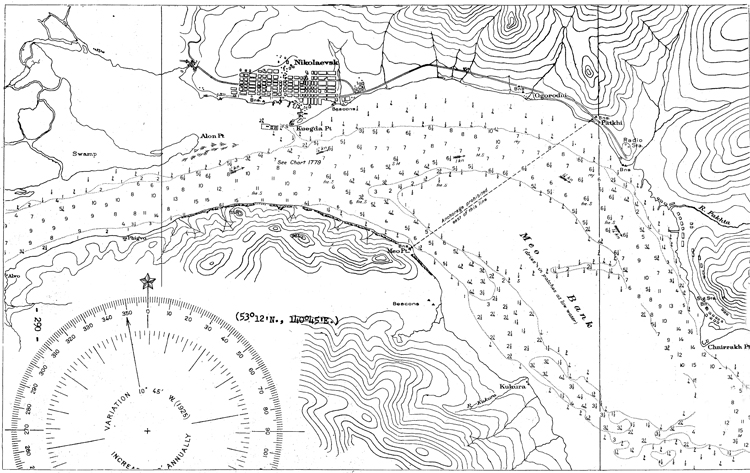
III. Komsomolsk. Although the primary naval importance of Konsomolsk i3 its shipbuilding yard, it is also probably used partially by the Amur Flotilla.
IV. Mariinsk. At Mariinsk, there is a seaplane base and airplane landing.
V. Khabarovsk is located at the confluence of the Amur and Ussuri riivers, and is of great military importance to the U.S.S.R. in the Far East as a focal point in the defense system of the Amur fiivor. Vessels drawing 12 ft. of water can reach this point from the mouth of the river, but only during the flood seasons of April to July.
The base of the Amur Flotilla is at Osipovka, 5 1/2 miles down river from Khabarovsk. There is a nell-equipped shipbuilding and ship repair yard here, and it has been reported that this yard has assembled one or two submarines, which were probably towed round for completion to Vladivostok. Khabarovsk is the river base for units of the Frontier Guard of the MVD.
There is a large and well-equipped airfield with underground hangars northeast of the town; its dimensions are 800 by 600 yards. There is also reported to be a military aviation school, as well as a seaplane base at Payenda, in the vicinity.
Khabarovsk is a highly fortified zone, but the degree and extent of its fortifications and defenses are not known, although it may be that the main fortified line is located about 2 miles from the east bank of the Ussuri River.
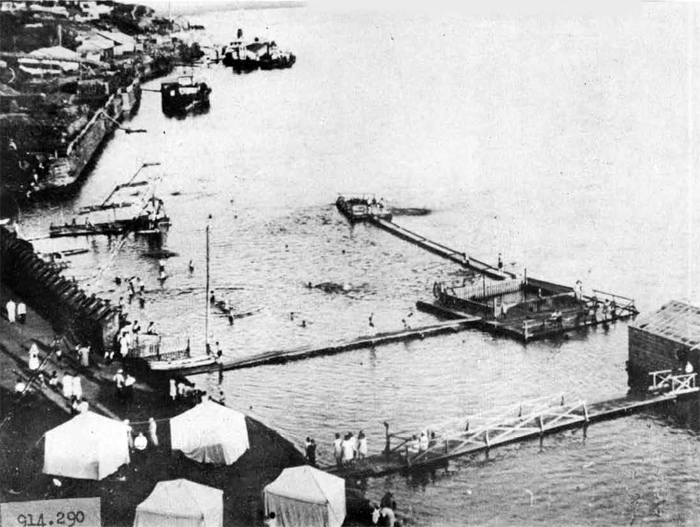
Khabarovsk - The Port.

Khabarovsk - Portion of the city.
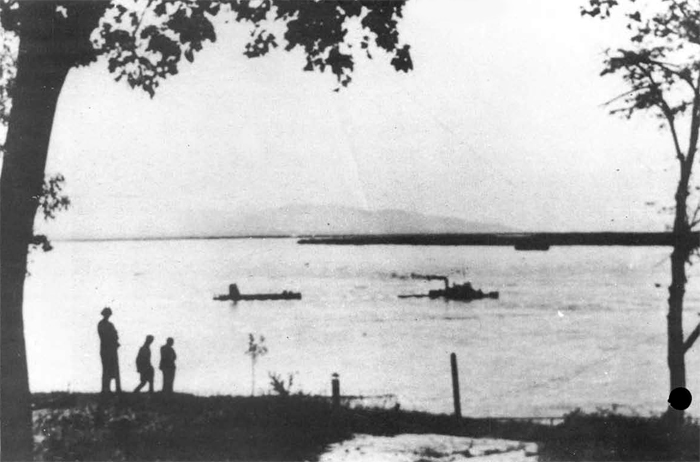
The Amur River near Khabarovsk.
VI. Mlkhailo-Semenovskaya. At this point, there is reported to be winter quarters for units of the Amur Flotilla.
VII. At Blagoveshchensk there is rer-orted to be two shipyards and a well -equipped naval detiot for the Amur Flotilla.
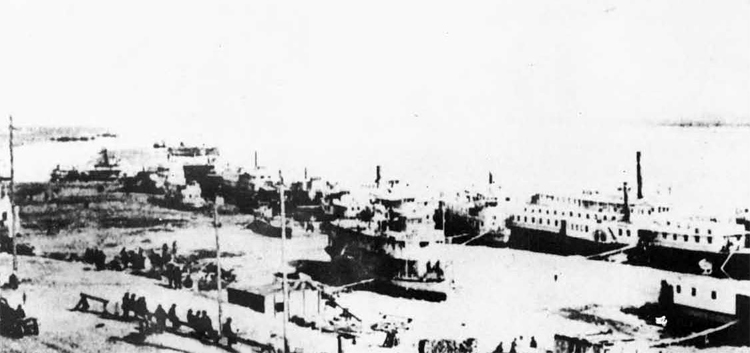
Blagoveschensk - the port.
F. Naval Bases in the Caspian Sea

I. Baku, the principal tovjn and port on the Caspian Sea, as well as the export center of the rich Caucasus oil fields, is also the chief base of the naval flotilla and site of the naval academy, which was formerly located at Leningrad. Baku roadstead proper is tho portion of the bay contiguous to the town. .Anchorag* here is sheltered from all winds, but with a southeasterly wind blowing in the bay; there is a considerable swell, which may be felt even in the roadstead. An unconfirmed report states that a new channel is boing dredged, which will shorten the approach to Baku by 22 or 23 miles. Baku Bay is accessible to all ships. Depths alongside the newer wharves are thought to be sufficient for ships of 23 ft. draft, but at the older wharves, they are less. Wharves line the entire coast of Baku Day for a distance of about eight miles, there being about 3,720 yards of wharves for tankers and about 2,800 yards for general cargo vessels.
The navy yard is located in the western portion of Baku Bay at Bailov Point; it is protected from cast and west by a mole. It contains workshops equipped for carrying out current repairs and complete overhaul of units of the flotilla, as well as mechanical works and barracks for the Caspian Flotilla Naval Depot; perhaps it contains facilities for assembling and fitting out submarines, which are reportedly floated dorm the Volga Kiver from Gorki. It can easily serve all requirements of the flotilla. There are three ship repairing yards, two ship repairing workshops (one naval and one commercial), and one engineering workshop. Two of the ship repairing yards have complete shops for hull and boilers, copper tubing, painting, tackle welding engineering, forging, etc. Here, the chief drydock in the Caspian Sea is located, which can accommodate ships at least as large as 6,600 gross tons; there is also one small floating drydock. In April, 194-3, there was considerable shipbuilding activity going on at Baku; small naval craft were building and under repair, and at least two merchant ships were on the ways, nearing completion.
Baku appears to be under strict military control; foreigners are discouraged in remaining there any longer than is absolutely necessary. During the latter part of 1942, Baku was partially blacked out. Balloons close-hauled wore noted in a number of places in the town; they usually floated at a few hundred feet at night. In April, 1942, and again in December, a large floating contraption, resembling * large lift mounting several small anti-aircraft guns, was seen in "Baku Bay, about 1 1/2 miles offshore.
There are three airfields and perhaps two seaplane bases in the vicinity of Baku.
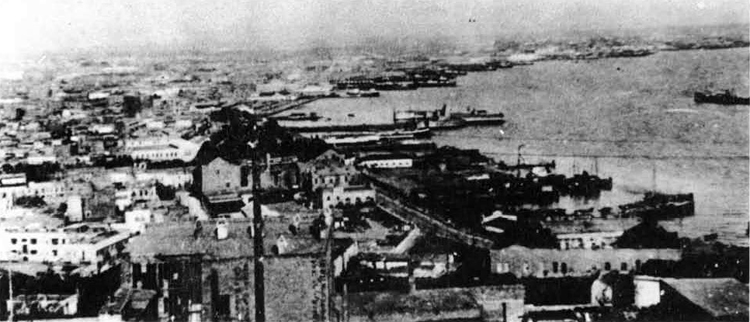
Baku - Commercial port - east of Naval Base.

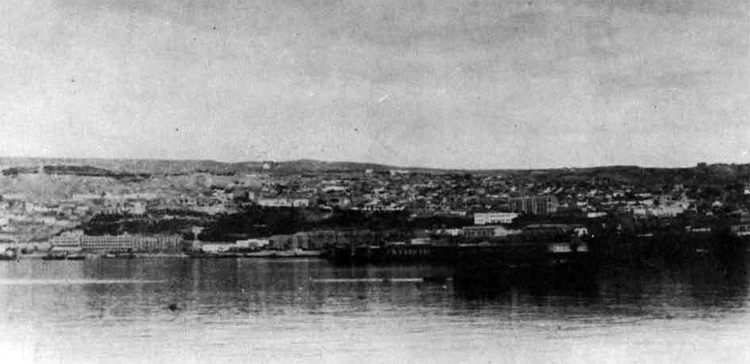
Baku - Port and City.

Baku - Naval Base.
II. Makhach Kala is a secondary base to Baku for the Caspian Sea Flotilla, and possesses shipbuilding and ship repair yards of minor importance; it is located on the western shore of the Caspian Sea, about 235 miles north of Baku. Commercially, it is important as a petroleum and grain port, and between Ofttober and April, when the mouth of the Volga River is frozen over, it replaces Astrakhan for shipment of goods to Krasnovodsk and Iranian ports.
Ships drawing up to 22 feet are believed able to reach the channel to the port, but dredging in the harbor is thought to maintain a depth not exceeding 16 feet. A shipbuilding yard was reported to have been under construction in 1941, and may have been since completed; there is one floating drydock, which can accommodate medium-sized ships.

III. Krasnovodsk. the terminus of the Trans-Caspian Railroad, on the eastern coast of the Caspian Sea, is said to be a secondary base for the Soviet Flotilla, stationed on Baku. The port, which is sometimes frozen over for short periods during the winter, consists of two harbors. 'Western Harbor, ;vhich is located at the town, is approached by a channel two miles long; in this channel, there is a mean depth of IS feet. The second harbor, called Ufra Harbor, is the petroleum port, and is located on the eastern shore of Muraviev Bay; its approach channel, which is about three miles long, has a depth in its center of about 16 feet. Krasnovodsk has ship repair workshops, of not very great capacity.

IV. Hasan Kuli is located on the small bar of the same name on the at the southeastern shore of the Caspian sea, at the Iranian frontier. In July 1942, it was reported that a new naval base had been equipped here. No further information is known regarding it. It cannot be of very great importance, however, as vessels drawing 11 feet of water cannot approach any closer than 3 1/2 miles from the port.
V. Minor naval operating bases. It is reported that in addition to the above mentioned bases, the ports of Astara, Aie..androvsk, Lenkoran, Guriev, and others are being employed as wartime naval bases; they possess little or no installations.
G. Shipbuilding Yards on the Volga River.
I. Gorki. Various reports indicate the construction of submarines at this point; no information is available on it, however.
II. Zelenoldolsk is located about 40 miles west of Kazan. The shipyard is located 1 1/2 miles from the town and extends approximately 1 1/2 miles along the river; it employs about 5,000 workmen.
The extent of activity is not known prior to USSR's entrance into the war, but it is known that considerable equipment was moved in and new shops built in the last 2 years.
In addition to the machine shops, wood working shops and electrical shops devoted to ship construction, an unknown number of shops are manufacturing various size and types of shells, repairing guns, and manufacturing valves.
All the shops and buildings are one story woodon structures. The lighting, both natural and artificial, is very bad. Due to this poor lighting,it is assumed that many accidents occur, as very little in the way of safety measures are evident. The personnel in the various shops is about 75$ female. The equipment is largely British and American make.
At the present time 8 - 210' steel subchasers, with 17'6" beam are under construction. Six hulls will have 3 - 1,200 HP General Motors Diesel engines each. 2 - 1,600 HP General Motors Diesel engines will be installed in the remaining 2 hulls. The construction throughout these vessels is of light weight steel. The thickness of hull plating is 5/32", keel 1 1/8" x 5 1/2" and reinforcing through-ait bilges with 5/32" plating and l/4w angle irons. Watertight doors are not used; entrance to compartments is through water tight hatches. Engine room ventilation is very poor. In aft engine room,a double bottom tank eight feet long is used for storing lubricating oil. The main fuel tanks are three separate double bottom tanks with small capacity. The electrical supply is furnished by 2 -25 KW General Motors Diesel engine generators. All wiring is lead covered. 2 l/2n spun glass is inserted or wrapped in tinfoil for insulation along the skin of the ship. 3/4" cork insulation is used throughout bulkheads and rooms.
In addition to the six subchasers, PT boats using Hall Scott and Packard engines, both Lend-Lease furnished, are being built. It has been impossible for technicians to see these boats to obtain additional information. 2 ice breaker type tugs and 3 oil barges are also under construction, but little progress is being made. At the present time 2 - 1,600 HP engines and 16 - 1200 HP engines with all accessory equipment are in storage. It is estimated by the U.S. Navy technicians that 2 years will be required to complete the 8 hulls now in the water.
"The yard equipment, such as shore handling apparatus overhead and traveling cranes is limited to two locomotive type crane of 10 ton capacity mounted on narrow guage railroad. The unloading and installation of the G.M.C. Diesel engines presented a problem, as the yard does hot have building ways and it was necessary to roll the engines onto the ship and then lower them into the hull with the use of chain falls and cribbing.
This yard is principally used for new construction, and, as far
as is known, no repair, conversion, or battle damage work is done
here.
The yard is not an efficient, well-operated yard where equipment is installed promptly. It is evident that a definite building schedule does not exist and it appears to be the Soviet policy of getting as much Lend-Lease equipment as possible at the various yards and place it in storage for future building.
Exclusive of the various shops unskilled workers form the large percentage of employees,and the technicians have noticed that there is a tremendous amount of supervision, but in spite of this supervision, the work on ship #337 is not done in an efficient manner. After working an hour or two in the engine room, all hands will go topsid© to smoke and talk and even the appearance of the director on board does not interfere with their many rest periods.
Prefabrication arrangements, such as practiced in U.S. Yards, do not exist. It has been impossible to see the ship drawings to determine the degree of complication or detail. Relationship between designers and shipbuilders is not known.
The yard is without fire-fighting equipment.
Large quantities of scrap iron, steel, bronze, etc., is being piled up here, although the yard does not have a foundry. It is understood that the scrap is being shipped here from Stalingrad.
III. Kazan. Another shipyard is located at Kazan, but no information is available concerning it, except that some 500 HP General Motors Diesel engines, which have been furnished by the U.S. Navy under the Lend-Lease Act are being installed.

